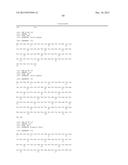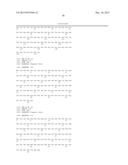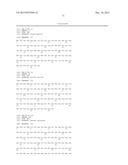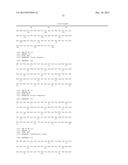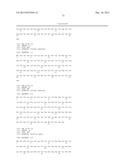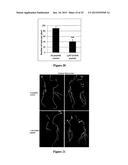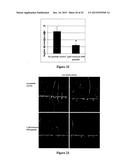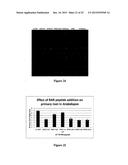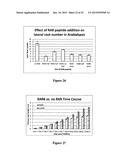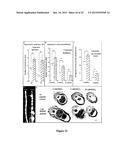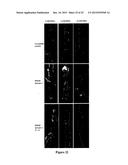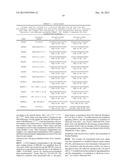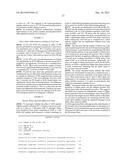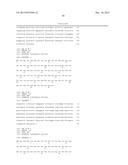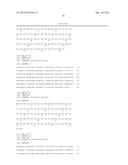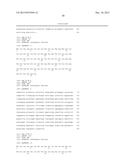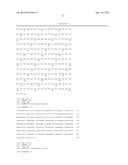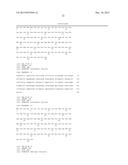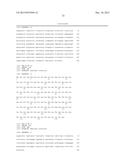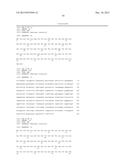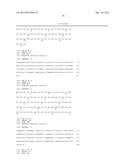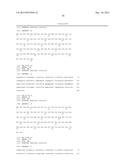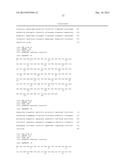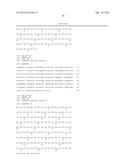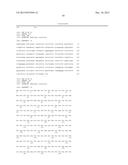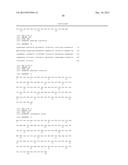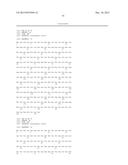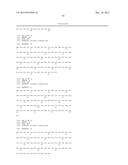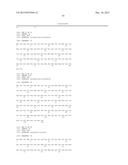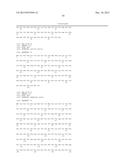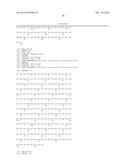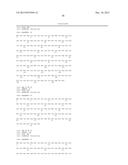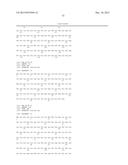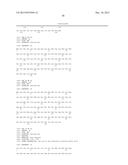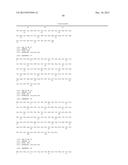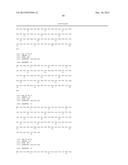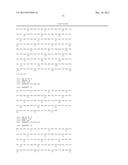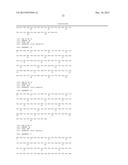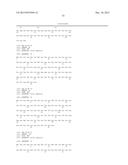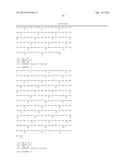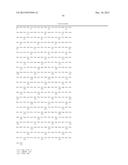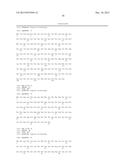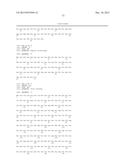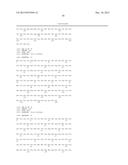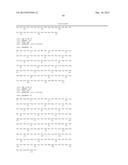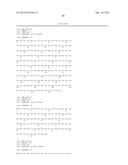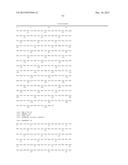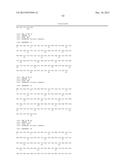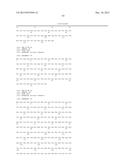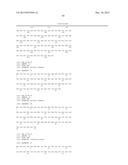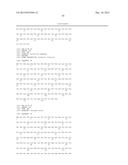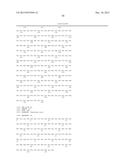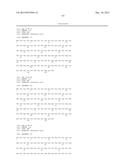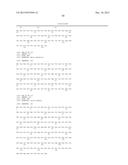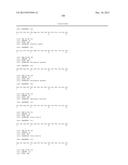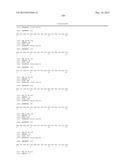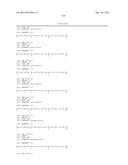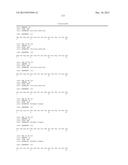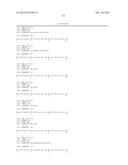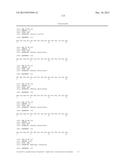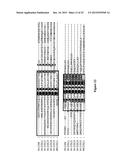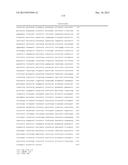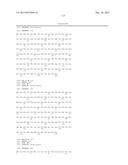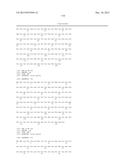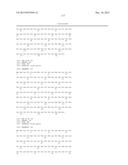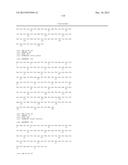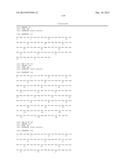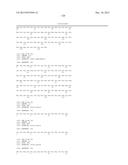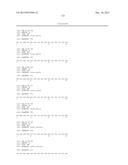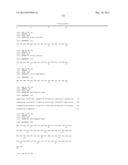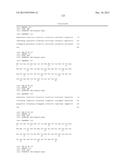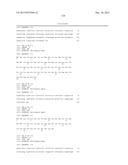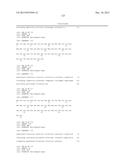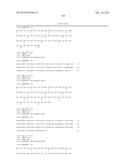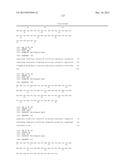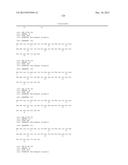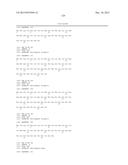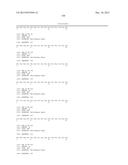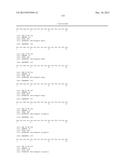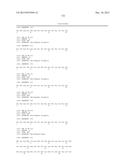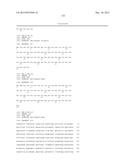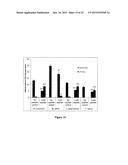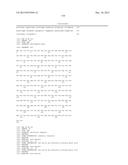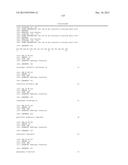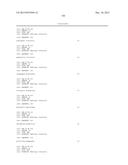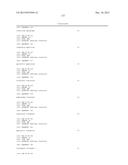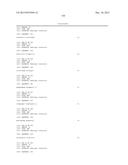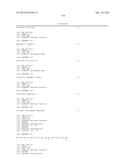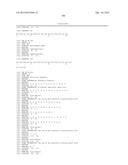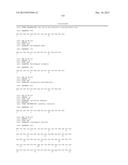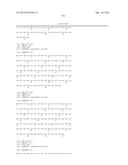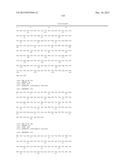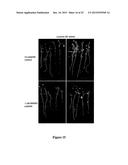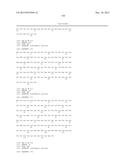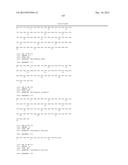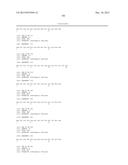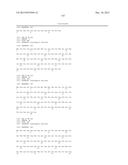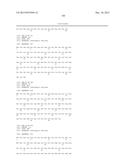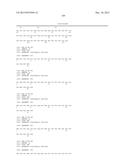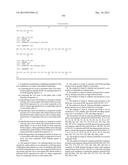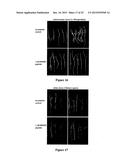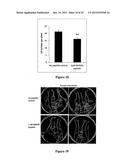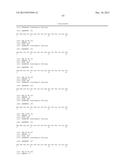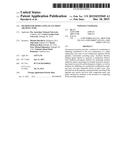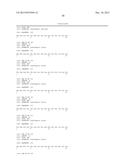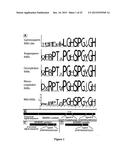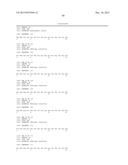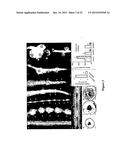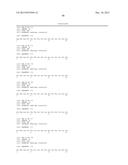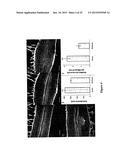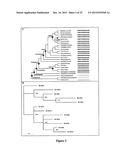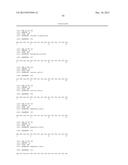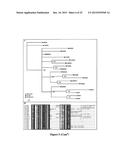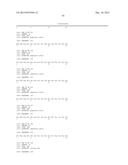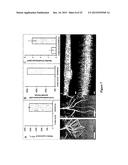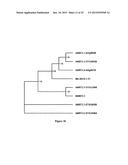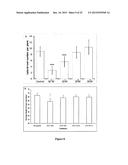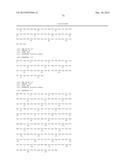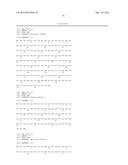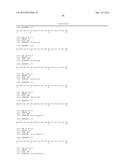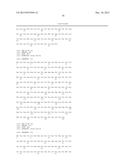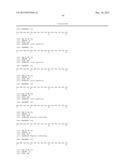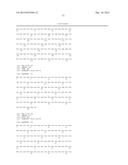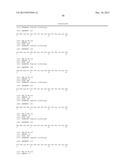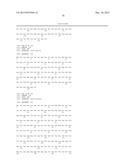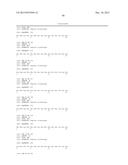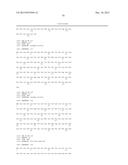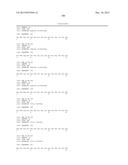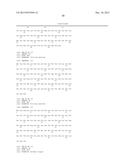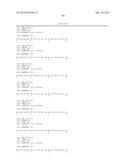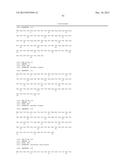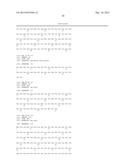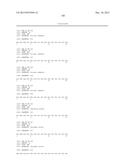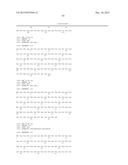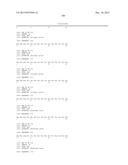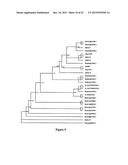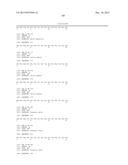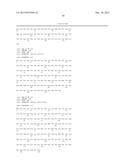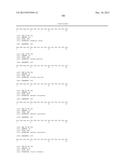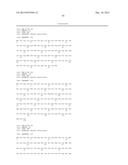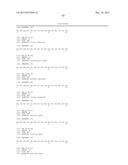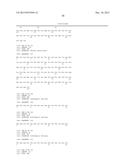Patent application title: METHOD FOR MODULATING PLANT ROOT ARCHITECTURE
Inventors:
Michael Djordjevic (Kingston, AU)
Nijat Imin (Kaleen, AU)
David Mckenzie Bird (Raleigh, NC, US)
Peter Michael Digennaro (Raleigh, NC, US)
Nadiatul Akmal Mohd Radzman (Canberra, AU)
IPC8 Class: AC12N1582FI
USPC Class:
800287
Class name: Multicellular living organisms and unmodified parts thereof and related processes method of introducing a polynucleotide molecule into or rearrangement of genetic material within a plant or plant part the polynucleotide contains a tissue, organ, or cell specific promoter
Publication date: 2015-12-10
Patent application number: 20150353949
Abstract:
The present invention provides a method for modulating or inhibiting
modulation of the root architecture of a plant employing a new class of
root architecture regulator (RAR) peptides, nucleotides encoding same,
receptors therefor, binding agents thereof or agonists or antagonists
thereof. Such methods encompass methods for increasing nutrient uptake by
plants, increasing root nodule formation, promoting lateral root growth
and development of plants, as well as methods for inhibiting root
architecture modification resulting from root knot nematode action on
plant roots. Also provided are RAR peptides, polynucleotides encoding RAR
peptides and vectors and host cells comprising same, and plants obtained
by methods of the invention or comprising RAR-encoding transgenes.Claims:
1. A method for modulating or inhibiting modulation of the root
architecture of a plant, said method comprising: (a) contacting the root
zone of said plant with a root architecture regulator peptide (RAR), an
analogue thereof or an RAR signaling agonist; or (b) contacting the root
zone of said plant with a RAR signaling antagonist; or (c) introducing at
least one mutation or exogenous nucleic acid into one or more plant cells
which results in modulated RAR expression by a root knot nematode or by
cells of a plant regenerated from or comprising said one or more plant
cells; or (d) introducing at least one mutation or exogenous nucleic acid
into one or more plant cells which results in modulated RAR receptor
expression by cells of a plant regenerated from or comprising said one or
more plant cells; or (e) introducing at least one mutation or exogenous
nucleic acid into one or more plant cells which results in modulated
affinity of one or more RARs for their respective RAR receptors, which
modulated affinity arises through modifications in the RAR(s), RAR
receptor(s) or in both expressed RAR(s) and RAR receptor(s); or (f)
introducing at least one exogenous nucleic acid into one or more plant
cells which results in expression of one or more root knot nematode RAR
binding agents or antagonists.
2. The method of claim 1, for reducing lateral root development by a plant relative to an untreated or wild-type plant, comprising contacting the root zone of said plant with at least one RAR or introducing at least one exogenous RAR-encoding nucleic acid into one or more plant cells which results in increased RAR expression by cells of a plant regenerated from or comprising said one or more plant cells.
3. The method of claim 2, wherein said RAR-encoding nucleic acid is operably linked to a promoter.
4. The method of claim 3, wherein said promoter is constitutive or inducible by nutrient status.
5. The method of claim 4, wherein said promoter is inducible by nitrogen starvation or high carbon dioxide.
6. The method of claim 3, wherein said promoter is root-specific.
7. The method of claim 3, wherein said promoter is the Medicago truncatula RAR1 promoter (SEQ ID NO: 337)
8. The method of claim 2, wherein said plant comprises a greater density of root hairs at periodic root bumps.
9. The method of claim 2, wherein said RAR is not an Arabidopsis CEP1 peptide and said RAR-encoding nucleic acid is not a Arabidopsis CEP1-encoding sequence.
10. The method of claim 2, wherein said RAR comprises an amino acid sequence selected from SEQ ID NOs: 4, 6, 8, 10, 12, 14, 16, 18, 20, 22, 24, 26, 28, 30, 32, 34, 36 to 147, 338-350, 365, 367, 369, 371, 373, 375, 377, 379, 381, 383, 385, 387-395 or comprises an RAR domain having an amino acid sequence selected from SEQ ID Nos: 148-336, 351-363 or 396-415, or wherein said RAR-encoding nucleic acid comprises a nucleotide sequence selected from SEQ ID NOs 3, 5, 7, 9, 11, 13, 15, 17, 19, 21, 23, 25, 27, 29, 31, 33, 35, 364, 366, 368, 370, 372, 374, 376, 378, 380, 382, 384 or 386.
11. The method of claim 2, wherein said RAR is a root knot nematode RAR.
12. The method of claim 11, wherein said RAR comprises an amino acid sequence selected from SEQ ID NOs 365, 367, 369, 371, 373, 375, 377, 379, 381, 383, 385, 387-395 or comprises an RAR domain having an amino acid sequence selected from SEQ ID Nos: 396-415 or said RAR-encoding nucleic acid comprises a nucleotide sequence selected from SEQ ID NOs: 364, 366, 368, 370, 372, 374, 376, 378, 380, 382, 384 or 386.
13. The method of claim 2, wherein said plant is selected from members of the angiosperm families Aceraceae, Anacardiaceae, Apiaceae, Asteraceae, Betulaceae, Brassicaceae, Buxaceae, Chenopodiaceae/Amaranthaceae, Compositae, Cucurbitaceae, Fabaceae, Fagaceae, Gramineae, Juglandaceae, Lamiaceae, Lauraceae, Leguininosae, Moraceae, Myrtaceae, Oleaceae, Platanaceae, Poaceae, Polygonaceae, Rosaceae, Rutaceae, Salicaceae, Solanaceae, Ulmaceae or Vitaceae or gymnosperm families Cuppressaceae, Pinaceae, Taxaceae or Taxodiaceae.
14. The method of claim 2 which results in, or results in an increase in symbiotic nitrogen-fixing nodule numbers on the root(s) of said plant.
15. The method of claim 14, wherein said plant is a member of the Fabaceae or the Leguminoseae.
16. The method of claim 1, for modulating lateral root growth of a plant relative to an untreated or wild-type plant, comprising contacting the root zone of said plant with a RAR antagonist or introducing at least one mutation or at least one exogenous nucleic acid into one or more plant cells which at least one mutation or nucleic acid results in: (i) decreased expression of one or more RARs, decreased expression of one or more RAR receptors, or decreased expression of one or more RARs and one or more RAR receptors by cells of a plant regenerated from or comprising said one or more plant cells, wherein said decreased expression of said RAR(s) or RAR receptor(s) occurs under conditions which would otherwise promote expression of said RAR(s) or RAR receptor(s); or (ii) reduced affinity of one or more RARs for their respective RAR receptors, which reduced affinity arises through modifications in the RAR(s), RAR receptor(s) or in both expressed RAR(s) and RAR receptor(s) expressed by cells of a plant regenerated from or comprising said one or more plant cells.
17. The method of claim 16, which comprises introducing into said one or more plant cells exogenous nucleic acid which suppresses, or the product of which suppresses expression of at least one endogenous RAR-encoding nucleic acid.
18. The method of claim 17, wherein said exogenous nucleic acid comprises a nucleic acid sequence homologous to, or complementary to at least a portion of the endogenous RAR-encoding nucleic acid.
19. The method of claim 17, wherein said exogenous nucleic acid is, or encodes a microRNA or siRNA.
20. The method of claim 16 wherein said plant is selected from members of the angiosperm families Aceraceae, Anacardiaceae, Apiaceae, Asteraceae, Betulaceae, Brassicaceae, Buxaceae, Chenopodiaceae/Amaranthaceae, Compositae, Cucurbitaceae, Fabaceae, Fagaceae, Gramineae, Juglandaceae, Lamiaceae, Lauraceae, Leguminosae, Moraceae, Myrtaceae, Oleaceae, Platanaceae, Poaceae, Polygonaceae, Rosaceae, Rutaceae, Salicaceae, Solanaceae, Ulmaceae or Vitaceae or gymnosperm families Cuppressaceae, Pinaceae, Taxaceae or Taxodiaceae.
21. The method of claim 1 for inhibiting modulation of the root architecture of a plant by the action of a root knot nematode.
22. The method of claim 21, which comprises contacting the root zone of said plant with a root knot nematode RAR antagonist or binding agent.
23. The method of claim 21, wherein said root knot nematode antagonist comprises a root knot nematode RAR binding agent.
24. The method of claim 21, which comprises introducing into said one or more plant cells at least one exogenous nucleic acid which suppresses, or the product of which suppresses expression of a root knot nematode RAR-encoding nucleic acid.
25. The method of claim 24, wherein said exogenous nucleic acid comprises or encodes a nucleic acid sequence homologous to, or complementary to at least a portion of a root knot nematode RAR-encoding nucleic acid.
26. The method of claim 25, wherein said root knot nematode RAR-encoding nucleic acid comprises a nucleotide sequence selected from SEQ ID NOs: 364, 366, 368, 370, 372, 374, 376, 378, 380, 382, 384 or 386, or encodes a peptide comprising an amino acid sequence selected from SEQ ID NOs: 365, 367, 369, 371, 373, 375, 377, 379, 381, 383, 385, 387-415.
27. The method of claim 25, wherein said exogenous nucleic acid is, or encodes a microRNA or siRNA.
28. The method of claim 21, which comprises introducing into said one or more plant cells one or more exogenous nucleic acids which code for a root knot nematode RAR binding agent or antagonist and secretion thereof.
29. The method of claim 28, wherein said binding agent is an antibody.
30. The method of claim 28, wherein said root knot nematode RAR comprises an amino acid sequence selected from SEQ ID NOs: 365, 367, 369, 371, 373, 375, 377, 379, 381, 383, 385, 387-395 or comprises, an RAR domain having an amino acid sequence selected from SEQ ID Nos: 396-415.
31. The method of claim 21, wherein said plant is selected from members of the angiosperm families Aceraceae, Anacardiaceae, Apiaceae, Asteraceae, Betulaceae, Brassicaceae, Buxaceae, Chenopodiaceae/Amaranthaceae, Compositae, Cucurbitaceae, Fabaceae, Fagaceae, Gramineae, Juglandaceae, Lamiaceae, Lauraceae, Leguminosae, Moraceae, Myrtaceae, Oleaceae, Platanaceae, Poaceae, Polygonaceae, Rosaceae, Rutaceae, Salicaceae, Solanaceae, Ulmaceae or Vitaceae or gymnosperm families Cuppressaceae, Pinaceae, Taxaceae or Taxodiaceae.
32. A plant with modulated root architecture relative to an untreated or wild-type plant, obtained by the method of claim 1, or a part thereof.
33. A plant with reduced lateral root development relative to an untreated or wild-type plant, obtained by the method of claim 2.
34. A plant with increased lateral root development relative to an untreated or wild-type plant, obtained by the method of claim 15.
35. A plant with increased resistance to root architecture modulation by root knot nematodes relative to an untreated or wild-type plant, obtained by the method of claim 22.
36. The plant of any one of claims 32 to 35, wherein said plant is selected from members of the angiosperm families Aceraceae, Anacardiaceae, Apiaceae, Asteraceae, Betulaceae, Brassicaceae, Buxaceae, Chenopodiaceae/Amaranthaceae, Compositae, Cucurbitaceae, Fabaceae, Fagaceae, Gramineae, Juglandaceae, Lamiaceae, Lauraceae, Leguminosae, Moraceae, Myrtaceae, Oleaceae, Platanaceae, Poaceae, Polygonaceae, Rosaceae, Rutaceae, Salicaceae, Solanaceae, Ulmaceae or Vitaceae or gymnosperm families Cuppressaceae, Pinaceae, Taxaceae or Taxodiaceae.
37. An isolated root architecture regulator peptide (RAR) or an analogue thereof, with the proviso that said RAR is not an Arabidopsis CEP1 peptide and said RAR-encoding nucleic acid is not a Arabidopsis CEP1-encoding sequence.
38. The peptide of claim 37, wherein said RAR comprises an amino acid sequence selected from SEQ ID NOs 4, 6, 8, 10, 12, 14, 16, 18, 20, 22, 24, 26, 28, 30, 32, 34, 36 to 147, 338-350, 365, 367, 369, 371, 373, 375, 377, 379, 381, 383, 385, 387-395 or comprises an RAR domain having an amino acid sequence selected from SEQ ID Nos: 148-336, 351-363 or 396-415, or is encoded by a nucleic acid comprising a nucleotide sequence selected from SEQ ID NOs 3, 5, 7, 9, 11, 13, 15, 17, 19, 21, 23, 25, 27, 29, 31, 33, 35, 364, 366, 368, 370, 372, 374, 376, 378, 380, 382, 384 or 386.
39. The peptide of claim 37, wherein said RAR is a root knot nematode RAR.
40. The peptide of claim 39, wherein said RAR comprises an amino acid sequence selected from SEQ ID NOs 365, 367, 369, 371, 373, 375, 377, 379, 381, 383, 385, 387-395 or comprises an RAR domain having an amino acid sequence selected from SEQ ID Nos: 396-415 or is encoded by a nucleic acid comprising a nucleotide sequence selected from SEQ ID NOs 364, 366, 368, 370, 372, 374, 376, 378, 380, 382, 384 or 386.
41. An isolated polynucleotide comprising a nucleotide sequence coding for a RAR, with the proviso that said polynucleotide is not the Arabidopsis CEP1-encoding sequence.
42. The polynucleotide of claim 41, which also comprises a secretion signal peptide encoding sequence.
43. The polynucleotide of claim 41 which encodes a RAR comprising an amino acid sequence selected from SEQ ID NOs 4, 6, 8, 10, 12, 14, 16, 18, 20, 22, 24, 26, 28, 30, 32, 34, 36 to 147, 338-350, 365, 367, 369, 371, 373, 375, 377, 379, 381, 383, 385, 387-395 or comprises an RAR domain having an amino acid sequence selected from SEQ ID Nos: 148-336, 351-363 or 396-415, or which comprises a nucleotide sequence selected from SEQ ID NOs 3, 5, 7, 9, 11, 13, 15, 17, 19, 21, 23, 25, 27, 29, 31, 33, 35, 364, 366, 368, 370, 372, 374, 376, 378, 380, 382, 384 or 386.
44. The polynucleotide of claim 41, which encodes a root knot nematode RAR.
45. The polynucleotide of claim 43, wherein said RAR comprises an amino acid sequence selected from SEQ ID NOs 365, 367, 369, 371, 373, 375, 377, 379, 381, 383, 385, 387-395 or comprises an RAR domain having an amino acid sequence selected from SEQ ID Nos: 396-415 or is encoded by a nucleic acid comprising a nucleotide sequence selected from SEQ ID NOs 364, 366, 368, 370, 372, 374, 376, 378, 380, 382, 384 or 386.
46. A recombinant vector comprising the polynucleotide of claim 41.
47. A recombinant vector comprising the polynucleotide of claim 44.
48. A transgenic host cell comprising the polynucleotide of claim 41.
49. A transgenic host cell comprising the polynucleotide of claim 44.
50. The transgenic cell of claim 48 which is a plant cell.
51. The transgenic cell of claim 49 which is a plant cell.
52. A transgenic plant comprising the polynucleotide of claim 41.
53. A transgenic plant comprising the polynucleotide of claim 44.
54. A method for inhibiting modulation of the root architecture of a plant by the action of a root knot nematode, said method comprising: (a) contacting the root zone of said plant with a root knot nematode RGF signaling antagonist; (b) introducing at least one exogenous nucleic acid into one or more plant cells which results in suppression of expression of a root knot nematode RGF; (c) introducing at least one mutation or exogenous nucleic acid into one or more plant cells which results in modulated affinity of one or more root knot nematode RGFs for plant RGF receptor(s), which modulated affinity arises through modifications in the plant RGF receptor(s); or (d) introducing at least one exogenous nucleic acid into one or more plant cells which results in expression by said cell(s) of one or more root knot nematode RGF binding agents or antagonists.
55. The method of claim 54, which comprises contacting the root zone of said plant with a root knot nematode RGF antagonist or binding agent.
56. The method of claim 54, wherein said root knot nematode antagonist comprises a root knot nematode RGF binding agent.
57. The method of claim 54, which comprises introducing into said one or more plant cells at least one exogenous nucleic acid which suppresses, or the product of which suppresses expression of a root knot nematode RGF-encoding nucleic acid.
58. The method of claim 57, wherein said exogenous nucleic acid comprises or encodes a nucleic acid sequence homologous to, or complementary to at least a portion of a root knot nematode RGF-encoding nucleic acid.
59. The method of claim 58, wherein said root knot nematode RAR encodes a peptide comprising an amino acid sequence selected from SEQ ID NOs: 416 or 417 or comprises an RGF domain having an amino acid sequence selected from SEQ ID Nos: 460 or 461.
60. The method of claim 58, wherein said exogenous nucleic acid is, or encodes a microRNA or siRNA.
61. The method of claim 54, which comprises introducing into said one or more plant cells one or more exogenous nucleic acids which code for a root knot nematode RGF binding agent or antagonist.
62. The method of claim 61, wherein said binding agent is an antibody.
63. The method of claim 61, wherein said root knot nematode RAR comprises an amino acid sequence selected from SEQ ID NOs: 416 or 417 or comprises an RGF domain having an amino acid sequence selected from SEQ ID Nos: 460 or 461.
64. The method of claim 54, wherein said plant is selected from members of the angiosperm families Aceraceae, Anacardiaceae, Apiaceae, Asteraceae, Betulaceae, Brassicaceae, Buxaceae, Chenopodiaceae/Amaranthaceae, Compositae, Cucurbitaceae, Fabaceae, Fagaceae, Gramineae, Juglandaceae, Lamiaceae, Lauraceae, Leguminosae, Moraceae, Myrtaceae, Oleaceae, Platanaceae, Poaceae, Polygonaceae, Rosaceae, Rutaceae, Salicaceae, Solanaceae, Ulmaceae or Vitaceae or gymnosperm families Cuppressaceae, Pinaceae, Taxaceae or Taxodiaceae.
65. A plant with increased resistance to modulation of root architecture by the action of a root knot nematode, relative to an untreated or wild-type plant, obtained by the method of claim 54, or a part thereof.
66. An isolated polynucleotide comprising a nucleotide sequence coding for a root knot nematode RGF, or a portion thereof.
67. The polynucleotide of claim 66 which encodes a root knot nematode RGF comprising an amino acid sequence as shown in SEQ ID NO. 416 or 417 or comprises an RGF domain having an amino acid sequence selected from SEQ ID Nos: 460 or 461.
68. A recombinant vector comprising the polynucleotide of claim 66 or claim 67.
69. A transgenic host cell comprising the polynucleotide of claim 66 or claim 67.
70. The transgenic cell of claim 69 which is a plant cell.
71. A transgenic plant comprising the polynucleotide of claim 70.
72. A method for inhibiting modulation of the root architecture of a plant by the action of a root knot nematode, said method comprising introducing at least one exogenous nucleic acid into one or more plant cells which suppresses, or the product of which suppresses expression of a component of a root knot nematode signal peptidase complex.
73. The method of claim 72, wherein said component is signal peptidase I.
74. The method of claim 73, wherein said signal peptidase I comprises a nucleotide sequence as shown in SEQ ID NO: 419, or an amino acid sequence as shown in SEQ ID NO. 420.
75. The method of claim 72, wherein said exogenous nucleic acid comprises or encodes a nucleic acid sequence homologous to, or complementary to at least a portion of said component of a root knot nematode signal peptidase complex.
76. The method of claim 72, wherein said exogenous nucleic acid is, or encodes a microRNA or siRNA.
77. The method of claim 72, wherein said plant is selected from members of the angiosperm families Aceraceae, Anacardiaceae, Apiaceae, Asteraceae, Betulaceae, Brassicaceae, Buxaceae, Chenopodiaceae/Amaranthaceae, Compositae, Cucurbitaceae, Fabaceae, Fagaceae, Gramineae, Juglandaceae, Lamiaceae, Lauraceae, Leguminosae, Moraceae, Myrtaceae, Oleaceae, Platanaceae, Poaceae, Polygonaceae, Rosaceae, Rutaceae, Salicaceae, Solanaceae, Ulmaceae or Vitaceae or gymnosperm families Cuppressaceae, Pinaceae, Taxaceae or Taxodiaceae.
78. A plant with increased resistance to modulation of root architecture by the action of a root knot nematode, relative to an untreated or wild-type plant, obtained by the method of claim 72, or a part thereof.
79. An isolated plant promoter comprising a nucleotide sequence as shown in SEQ ID NO: 337.
80. A recombinant vector comprising the promoter of claim 79.
81. A transgenic host cell comprising the promoter of claim 79.
82. The transgenic cell of claim 81 which is a plant cell.
83. A transgenic plant comprising the promoter of claim 79.
84. A method according to any one of claim 1, 16 or 21, wherein said RAR comprises an RAR domain comprising an amino acid sequence (X1)nX2X3X4X5X6PGX9SPGX13GX.- sub.15 (SEQ ID NO: 459), wherein: n may be 0 or 1 X1 is selected from D, G, P, A, S, E and V; X2 is selected from F, V, R, T, S, A, K and Y; X3 is selected from R, K, E, H, Q, S, P, D, V, G, and A; X4 is selected from P and G; X5 is selected from T, S and G; X6 is selected from N, A, T, G, P, D, K and S; X9 is selected from N, H, Y and S; X13 is selected from I, A and V; and X15 is selected from N and H; wherein the amino acid at position 6, if threonine or serine, may be phosphorylated; the P at opposition 11, a P at position 4, or both such prolines may be hydroxylated; and tyrosine residues may be sulphonated.
Description:
FIELD OF THE INVENTION
[0001] The present invention relates to methods and materials for modulating the architecture of plant roots and thereby modulating the ability of plants to take up nutrients and/or water from soil. The invention also relates to methods and materials for treating or preventing root knot nematode attack of plant roots.
BACKGROUND TO THE INVENTION
[0002] Root architecture is an important agronomic trait governed by a poorly understood integration of nascent lateral organ development programs with nutritional and environmental parameters. To effectively adapt to variations in the soil environment, root systems evolved two important features: developmental plasticity and a wide range of molecular systems to sense and respond to various soil parameters. The availability of nitrogen is a major determinant of root architecture. A complex but poorly understood interplay occurs between environmental cues and the innate root development pathways. Collectively this interplay dictates the optimization of root architecture and influences plant productivity and fitness.
[0003] There is therefore a need for a better understanding of root architecture and factors involved in this to develop plants with root architecture allowing for improved or more efficient nutrient uptake, or for otherwise better adapting plants to the environment they are to be grown in.
SUMMARY OF THE INVENTION
[0004] The present investigations have shown that the root architecture of plants, including nodule formation and competency thereof, can be modulated by a family of peptides herein referred to as root architecture regulatory (RAR) peptides. It has also been found that root knot nematodes (RKNs) also express and secrete peptides of this family, thereby affecting the architecture of affected roots. This knowledge may provide a route for controlling the effects of root knot nematode attack on plant roots. Furthermore, in the course of these studies it has also been found that root knot nematodes also express and secrete other plant-like regulatory peptides, including root growth factors (RGFs), CLV3/ESR-related peptides (CLEs) and Inflorescence Deficient in Abscission peptides (IDAs).
[0005] Thus, according to an aspect of the invention, there is provided a method for modulating or inhibiting modulation of the root architecture of a plant, said method comprising:
[0006] (a) contacting the root zone of said plant with a root architecture regulator peptide (RAR), an analogue thereof or an RAR signaling agonist; or
[0007] (b) contacting the root zone of said plant with a RAR signaling antagonist; or
[0008] (c) introducing at least one mutation or exogenous nucleic acid into one or more plant cells which results in modulated RAR expression by a root knot nematode or by cells of a plant regenerated from or comprising said one or more plant cells; or
[0009] (d) introducing at least one mutation or exogenous nucleic acid into one or more plant cells which results in modulated RAR receptor expression by cells of a plant regenerated from or comprising said one or more plant cells; or
[0010] (e) introducing at least one mutation or exogenous nucleic acid into one or more plant cells which results in modulated affinity of one or more RARs for their respective RAR receptors, which modulated affinity arises through modifications in the RAR(s), RAR receptor(s) or in both expressed RAR(s) and RAR receptor(s); or
[0011] (f) introducing at least one exogenous nucleic acid into one or more plant cells which results in expression of one or more root knot nematode RAR binding agents or antagonists.
[0012] According to an embodiment of this aspect, the present invention provides a method for modulating lateral root development by a plant relative to an untreated or wild-type plant, comprising contacting the root zone of said plant with at least one RAR or introducing at least one exogenous RAR-encoding nucleic acid into one or more plant cells which results in increased RAR expression by cells of a plant regenerated from or comprising said one or more plant cells.
[0013] According to another embodiment of this aspect, the present invention provides a method for promoting lateral root development of a plant relative to an untreated or wild-type plant, comprising contacting the root zone of said plant with a RAR antagonist or introducing at least one mutation or at least one exogenous nucleic acid into one or more plant cells which at least one mutation or nucleic acid results in:
[0014] (i) decreased expression of one or more RARs, decreased expression of one or more RAR receptors, or decreased expression of one or more RARs and one or more RAR receptors by cells of a plant regenerated from or comprising said one or more plant cells, wherein said decreased expression of said RAR(s) or RAR receptor(s) occurs under conditions which would otherwise promote expression of said RAR(s) or RAR receptor(s); or
[0015] (ii) reduced affinity of one or more RARs for their respective RAR receptors, which reduced affinity arises through modifications in the RAR(s), RAR receptor(s) or in both expressed RAR(s) and RAR receptor(s) expressed by cells of a plant regenerated from or comprising said one or more plant cells.
[0016] According to another embodiment of this aspect, the present invention provides a method for inhibiting modulation of the root architecture of a plant by the action of a root knot nematode, comprising: contacting the root zone of a plant with a root knot nematode RAR signaling antagonist or binding agent; introducing into one or more plant cells at least one exogenous nucleic acid which suppresses, or the product of which suppresses expression of a root knot nematode RAR-encoding nucleic acid (such as a microRNA or siRNA or a microRNA-encoding or siRNA-encoding sequence); introducing into one or more plant cells at least one mutation or exogenous nucleic acid which results in modulated affinity of one or more root knot nematode RARs for plant RAR receptors, which modulated affinity arises through modifications in the plant RAR receptor(s); or introducing into one or more plant cells one or more exogenous nucleic acids which results in expression by said cell(s) of one or more root knot nematode RAR binding agents or antagonists.
[0017] According to another embodiment of this aspect, the present invention provides a method for inhibiting modulation of the root architecture of a plant by the action of a root knot nematode, comprising: contacting the root zone of a plant with a root knot nematode RGF signaling antagonist or binding agent; introducing into one or more plant cells at least one exogenous nucleic acid which suppresses, or the product of which suppresses expression of a root knot nematode RGF-encoding nucleic acid (such as a microRNA or siRNA or a microRNA-encoding or siRNA-encoding sequence); introducing into one or more plant cells at least one mutation or exogenous nucleic acid which results in modulated affinity of one or more root knot nematode RGFs for plant RGF receptors, which modulated affinity arises through modifications in the plant RGF receptor(s); or introducing into one or more plant cells one or more exogenous nucleic acids which results in expression by said cell(s) of one or more root knot nematode RGF binding agents or antagonists.
[0018] In view of the discovery that RKNs express a number of plant signaling molecules, including RARs, RGFs, IDAs and CLEs, and appear to deploy them to subvert normal plant root growth to their needs, it is postulated that another method for controlling damage by RKNs to plants may comprise inhibiting expression of peptidases or proteases responsible for cleaving signal peptides from the translated pre-secretion precursors of the regulatory proteins/peptides secreted by RKNs.
[0019] According to another embodiment of the invention, there is therefore provided a method for inhibiting modulation of the root architecture of a plant by the action of a root knot nematode, said method comprising introducing at least one exogenous nucleic acid into one or more plant cells which suppresses, or the product of which suppresses expression of a component of a root knot nematode signal peptidase complex.
[0020] Plants obtained by the methods outlined above, and plant parts (including leaves, stems, roots, tubers, flowers, fruit, seeds and parts thereof) are also provided.
[0021] According to another aspect, the present invention provides an isolated root architecture regulator peptide (RAR) or an analogue thereof, with the proviso that said RAR is not an Arabidopsis CEP1 peptide and said RAR-encoding nucleic acid is not an Arabidopsis CEP1 encoding sequence. According to an embodiment, the RAR is a root knot nematode RAR.
[0022] According to another aspect, the present invention provides an isolated polynucleotide comprising a nucleotide sequence coding for a RAR, with the proviso that said polynucleotide is not the Arabidopsis CEP1 encoding sequence, or a portion thereof. The polynucleotide may also comprise a secretion signal peptide sequence. According to an embodiment, the RAR-encoding sequence is a root knot nematode RAR-encoding sequence.
[0023] According to another aspect, the present invention provides an isolated polynucleotide comprising a nucleotide sequence coding for a root knot nematode RGF, or a portion thereof.
[0024] Also provided are vectors, transgenic cells, including plant cells, and transgenic plants, and seeds thereof comprising polynucleotides according to the invention.
[0025] Also contemplated by the present invention are methods for screening plants or root not nematodes for RARs, RAR receptor(s) and encoding sequences, and isolation of such peptides and encoding sequences. Further contemplated are methods for screening root knot nematodes for RGFs and encoding sequences, and isolation of such peptides and encoding sequences. Such screening methods may identify additional RARs, RGFs, as well as RAR or RGF receptors, encoding sequences and associated regulatory regions with altered properties (including altered affinities or altered nutrient responses).
[0026] Screening methods may comprise the use of polyclonal or monoclonal antibodies raised against one or more of the RARs or RGFs disclosed herein, labeled RAR(s) and RGF(s), or oligonucleotide probes or primer pairs based on one or more of the RAR-encoding or RGF-encoding sequences disclosed herein.
BRIEF DESCRIPTION OF THE DRAWINGS
[0027] FIG. 1--RAR peptide ligands occur in higher plants and RKNs. (A) Weblogo plots show the 15 AA RAR peptides each with particularly strong C-terminal conservation. Angiosperm and RKN RAR peptides show strong similarity. Gymnosperm RAR-like peptides exhibit divergence at the amino-terminus with a highly conserved leucine instead of proline at position 7. Unlike dicots, monocot RARs do not contain F at position 2. (B) Putative MtRAR1 protein sequence. The amino-terminal signal sequence is blue and the conserved RAR peptides are red. Non-conserved sequences are green. (C, D) Putative MhRAR1 and MiRAR1 proteins. Two forms of RARs exist: the first has sequences flanking the RAR peptide (e.g. MhRAR1, C) and the second has no flanking sequences (e.g. MiRAR1; D).
[0028] FIG. 2--MtRAR gene expression is up-regulated by low N (nitrogen) and high CO2 levels and is developmentally regulated during lateral organogenesis in M. truncatula. (A) Eight of 11 RAR genes were significantly up-regulated after four days growth on a N-free medium compared to plants grown with 0.5 mM NH4NO3. The expression of MtRAR3 and MtRAR10 was not included; they were not detected by qRT-PCR. N≧12; student's t-test P<0.05; **: P<0.01; ***: P<0.001. Bars indicate standard deviations. (B) Relative expression of MtRAR genes in response to high and low levels of nitrate and atmospheric CO2. MtRAR1-2, 5-8 and 11 are significantly up-regulated in the roots after 14 days growth under low nitrate (0.25 mM KNO3) and high CO2 (800 ppm) compared to the roots of similar plants grown under high nitrate (5 mM KNO3) and ambient CO2. Plants grown at 0.25 mM KNO3 were supplemented with 4.75 mM KCl to standardize potassium levels. MtRAR1 and MtRAR11 are up-regulated by low nitrate and MtRAR1 and MtRAR2 are up-regulated by high CO2 even in high the presence of high nitrate suggesting independent regulation of RAR by CO2 and nitrate. N≧12. (C). MtRAR1 expression is not affected by 24 h hormone treatments. (D) Microarray analysis of the MtRAR1 in different tissues. MtRAR1 is expressed in N-deprived roots and suppressed during all stages of nodule development (http://mtgea.noble.org/v2). Root (no nitrogen): grown under no nitrogen condition for four days; Nod: nodules; dpi: days post-inoculation with S. meliloti. (E-N) ProMtRAR1:GUS expression in the transgenic roots. (E and F) Nitrogen starvation for 4 days. (I and M) grown on 5 mM KNO3. (J-L) Transverse sections at the root tip of N-starved plants; indicative locations of the sections are shown by the red lines in E. (G and N) MtRAR1:GUS roots inoculated with S. meliloti for one (G) or two weeks (N). (H) A cross-section of nodule induced by Sm 1021 at two weeks. Scale bars: 100 μM in E-G, I, M and N; 50 μM in H and J-L.
[0029] FIG. 3--Multiple root architecture phenotypes in M. truncatula caused by MtRAR1 over-expression or synthetic (putative) ligand addition. (A) Control root showing normal root hair development. (B-C) periodic humps (arrows) caused by MtRAR1 over-expression. (D-E) Periodic bumps (arrows) caused by synthetic MtRAR1 or MhRAR2 peptide respectively. (F-G) Root nodule formation on transgenic roots with the empty vector or MtRAR1 over-expression respectively. GFP is visible in C, F and G. (H) MtRAR1 over-expression caused periodic bumps in the GH3:GUS reporter construct line. GH3:GUS expresses strongly at bump sites and arrested lateral roots can be seen at two of the four sites (asterisk). A section of the control GH3:GUS root is shown in K and sections of two bump sites bearing arrested lateral roots are in L and M. Bumps are typified by circumferential cell proliferation ("CCP") and this term is used interchangeably throughout. Asterisk, arrested lateral root; double asterisk, strong vascular GH3:GUS expression (I) Lateral root number is repressed six-fold by MtRAR1 over-expression. Histogram showing a comparison of lateral root numbers formed on the transgenic roots containing MtRAR1ox to an empty vector control. N≧319; ***: P<0.001. Bars indicate standard deviations. (J) The relative expression of nitrogen-signaling related genes MtAGL1, MtNRT2.5 and MtLBD38 are modulated by MtRAR1 over-expression in the transgenic roots. N≧12; *: P<0.05; ***: P<0.001. Scale bars: 100 μM in A-H; 50 μM in L-M.
[0030] FIG. 4--Periodic bumps are sites of localized cell division or contain arrested lateral roots. (A) Confocal imaging of a non-bump site on transgenic roots over-expressing MtRAR1. (B-C) CCP sites showing altered cell divisions occurring in epidermal, cortical and pericycle cells. Central nuclei are seen in C. (D) Bump site with arrested lateral root showing divided but un-differentiated cells. (E-F) Root diameter and the numbers of cortical cells are significantly increased at bump (CCP) sites (P<0.05). Scale bars: 50 μM.
[0031] FIG. 5--Shows a sequence analysis of RAR domains in higher plants and the RKNs. (A) Cladistic representation of RAR genes in plants. The RAR domains are shown for each evolutionarily significant Glade only. (B) Phylogenetic analysis of RAR domains in Meloidogyne hapla. (C) Phylogenetic analysis of RAR domains in higher plants and RKNs. (D) Alignment of RKN RARs. Blue box indicates signal sequence. Red box indicates RAR domain. For (B) and (C) sequence alignment of pro-RAR and C-terminal domains was done by a combination of ClustalW and manual adjustment. Phylogenic tree construction was done by MrBayes. Numbers report the posterior probabilities of the 50% majority consensus tree.)
[0032] FIG. 6--Amino acid sequence alignment of 11 putative RAR-coding genes in M. truncatula. All 11 sequences have predicted signal peptides at the N-terminus (boxed in blue), an intervening variable region of little or no sequence conservation and 15 amino acid long conserved region(s) close to the C-terminus end. RAR domains are boxed in red. Note some RARs have more than one RAR domain (e.g. MtRAR10 has four RAR peptide motifs whereas MtRAR 7, 9 and 1 each have two).
[0033] FIG. 7--Phenotypic changes caused by MtRAR1 over-expression in. M. truncatula transgenic roots. (A) The qRT-PCR results show that the expression of MtRAR1 is significantly elevated in transgenic roots containing the MtRAR1ox construct compared to transgenic roots containing the empty vector (control n≧).9; student's t-test ***: P<0.0001. Error bars indicate standard deviations. (B) Quantification of periodic CCP site formation in MtRAR1ox transgenic roots. The results of double blind scoring for the presence of periodic CCP site formation are shown. N?-- 300, Student's t-test ***: P<0.001. (C) MtRAR1ox increases number of nodules when inoculated with S. meliloti. N≧20; student's t-test *: P<0.05. Error bars indicate standard deviations. (D-E) MtRAR1ox reduces lateral root numbers. Compared to transgenic roots containing the empty vector control (D), fewer lateral roots are formed in transgenic roots bearing MtRAR1ox (E). Periodic CCP on MtRAR1 ox roots are indicated by asterisk. Scale bar=1 cm. (F-G) MtRAR1ox reduces root hair length and numbers when grown under agar. Fewer and shorter root hairs are formed in transgenic roots bearing MtRAR1ox (F) compared to transgenic roots containing the empty vector control (G). Scale bar=0.1 cm.
[0034] FIG. 8--Effect of a concentration gradient of MtRAR1 synthetic peptide on lateral root formation and root growth in M. truncatula. (A). Lateral root formation is significantly reduced on A17 plants grown on F medium containing 25 mM KNO3 and 10-6M NA peptide (MtRAR1 domain one peptide). (B) Main root growth is significantly inhibited at 10-6M DIA peptide. t-test ***: P<0.001. Error bars indicate standard deviations.
[0035] FIG. 9--Phylogenetic tree of MADS-box homologues in Arabidopsis and M. truncatula. Sequence alignment was done by CLUSTAL and adjusted by hand. Phylogeny was created using MrBayes, with two chains running for 500000 generations, sampled every 500. A mixed amino acid model was used. Burn in was 250 data points. The above phylogeny represents the 50% majority consensus tree. Numbers are posterior probabilities.
[0036] FIG. 10--Phylogenetic tree of NRT homologues in Arabidopsis and M. truncatula. Sequence alignment was done by CLUSTAL and adjusted by hand. Phylogeny was created using MrBayes, with two chains running for 500000 generations, sampled every 500. A mixed amino acid model was used. Burn in was 250 data points. The above phylogeny represents the 50% majority consensus tree. Numbers are posterior probabilities.
[0037] FIG. 11--Alignment of the M. hapla putative RGF with RGFs from A. thaliana. The active domain region (boxed in red) is well conserved between the species.
[0038] FIG. 12--Putative IDA of M. hapla aligned with IDA and IDA-Like proteins from A. thaliana. In M. hapla, the signal sequence (blue box) is immediately followed by an IDA-Like domain (red box).
[0039] FIG. 13--Shows the 5-prime upstream region of the M. truncatula RAR1 gene, including the promoter region and the first 86 nucleotides of the RAR1-encoding region.
[0040] FIG. 14--Shows the effect of RAR peptide application on lateral root formation of the plants grown in jars. M. truncatula, M. sativa, Subterranean Clover Cultivar Woogenellup and white clover (Trifolium repens) plants were grown in 0.4% agar-containing magenta jars supplemented with F media with or without peptides for two weeks. The media contained 5 mM KNO3. MtRAR1 peptide: FQ(P)TTPGNS(P)GVGH where (P) is hydroxyproline. Students` t-test *: P<0.05; **: P<0.01; ***: P<0.001; N>12. Error bars represent SE.
[0041] FIG. 15--Shows the effect of RAR peptide application on lateral root formation of M. sativa plants. The plants were grown in 0.4% agar-containing magenta jars supplemented with F media with or without peptides for two weeks. The medium contained 5 mM KNO3. MtRAR1 peptide: FQ(P)TTPGNS(P)GVGH where (P) is hydroxyproline.
[0042] FIG. 16--Shows the effect of RAR peptide application on lateral root formation of subterranean clover cultivar Woogenellup plants. The plants were grown in 0.4% agar-containing magenta jars supplemented with F media with or without peptides for two weeks. The media contained 5 mM KNO3. MtRAR1 peptide: FQ(P)TTPGNS(P)GVGH where (P) is hydroxyproline.
[0043] FIG. 17--Shows the effect of RAR peptide application on lateral root formation of white clover (Trifolium repens) plants. The plants were grown in 0.4% agar-containing magenta jars supplemented with F medium with or without peptides for two weeks. The media contained 5 mM KNO3. MtRAR1 peptide: FQ(P)TTPGNS(P)GVGH where (P) is hydroxyproline.
[0044] FIG. 18--Shows the effect of RAR peptide application on lateral root formation on microtom tomatoes. The plants were grown in 0.8% agar-containing plates supplemented with F media with or without peptides for two weeks. The media contained 5 mM KNO3. MtRAR1 peptide: FQ(P)TTPGNS(P)GVGH where (P) is hydroxyproline. Students' t-test, **: P<0.01; N>12. Error bars represent SE.
[0045] FIG. 19--Shows the effect of RAR peptide application on lateral root formation on microtom tomatoes. The plants were grown in 0.8% agar-containing plates supplemented with F media with or without peptides for two weeks. The medium contained 5 mM KNO3. MtRAR1 peptide: FQ(P)TTPGNS(P)GVGH where (P) is hydroxyproline.
[0046] FIG. 20--Shows the effect of RAR peptide application on root formation of soybean. The plants were grown in liquid supplemented with F medium with or without peptides for two weeks. The medium contained 5 mM KNO3. GmRAR peptide: NFR(P)TAPGHS(P)GVGH where (P) is hydroxyproline. Students' t-test, **: P<0.01; N>6. Error bars represent SE.
[0047] FIG. 21--Shows the effect of RAR peptide application on root formation of soybean. The plants were grown in liquid supplemented with F medium with or without peptides for two weeks. The media contained 5 mM KNO3. GmRAR peptide: NFR(P)TAPGHS(P)GVGH where (P) is hydroxyproline.
[0048] FIG. 22--Shows the effect of RAR peptide application on root formation of rice plants. The plants were grown in liquid media containing half strength MS media with or without peptides for two weeks. Monocot RAR peptide: DTRATDPGHS(P)GAGH where (P) is hydroxyproline. Students' t-test, *: P<0.05; N>6. Error bars represent SE.
[0049] FIG. 23--Shows the effect of RAR peptide application on root formation of rice plants. The plants were grown in liquid media containing half strength MS media with or without peptides for two weeks. Monocot RAR peptide: DTRATDPGHS(P)GAGH where (P) is hydroxyproline.
[0050] FIG. 24--Shows the phenotypes of 12 day old. WT Arabidopsis plants treated with 1 μM of RAR peptide.
[0051] FIG. 25--Shows the effect of RAR peptide addition on primary root in Arabidopsis.
[0052] FIG. 26--Shows the effect of RAR peptide addition on lateral root number in Arabidopsis.
[0053] FIG. 27--Shows the RAR time course showing primary root length.
[0054] FIG. 28--Shows the RAR time course showing lateral root number.
[0055] FIG. 29--Shows the effect of RAR on the number of lateral roots can be released by removing RAR exposure.
[0056] FIG. 30--Shows the effect of RAR on primary root length can be released.
[0057] FIG. 31--MtRAR1 over-expression increases nodulation and promotes nodule development at different nitrate concentrations: (a) Comparison of nodulation between MtRAR1 over-expressing plants and control plants at different temperatures when inoculated with S. meliloti strain 1021; (b) Partial nitrate tolerance of nodule development induced by WSM1022 on MtRAR1 over-expressing plants; (c) Acetylene reduction assay results; (d) Inoculation of plants with preformed CCP sites led to root nodule formation at the CCP sites at 25 mM KNO3; (e) Nodule sections from RAR1 peptide-treated and untreated plants grown at either 0, 5 mM or 25 mM KNO3 for three weeks.
[0058] FIG. 32--M. truncatula plants grown in 0.8% agar-containing plates supplemented with F media with or without peptides.
DEFINITIONS
[0059] As used herein, the term "comprising" means "including principally, but not necessarily solely". Variations of the word "comprising", such as "comprise" and "comprises", have correspondingly similar meanings.
[0060] As used herein the term "gene", refers to a defined region that is located within a genome and that may comprise regulatory, nucleic acid sequences responsible for the control of expression, i.e., transcription and translation of the coding portion. A gene may also comprise other 5' and 3' untranslated sequences and termination sequences: Further elements that may be present are, for example, introns and coding sequences.
[0061] As used herein, the term "analogue" in the context of a peptide or protein means an artificial or natural substance that resembles the peptide or protein in function. For example, an RAR analogue will bind an RAR receptor and thereby bring about the same or similar result as if a natural RAR had bound to the receptor. In an embodiment such analogues may also resemble the RAR peptide in structure. Analogues contemplated in an embodiment of the present invention include fully or partially peptidomimetic compounds as well as peptides or proteins resembling a subject peptide in activity but comprising addition, deletion, or substitution of one or more amino acids compared to the subject peptide or protein. The term "analogue" as used herein with reference to nucleotide sequences encompasses sequences comprising addition, deletion, or substitution (including conservative amino acid substitutions) of one or more bases relative to a subject nucleotide sequence, wherein the encoded polypeptide resembles the polypeptide encoded by the subject nucleic acid molecule in function.
[0062] As used herein, the term "homologue" in the context of proteins means proteins having substantially the same functions and similar properties in different species, and which, within at least regions, share at least 50% amino acid identity. Such homologous proteins may share, over their entire amino acid sequences, at least about 30% amino acid identity, at least about 40% amino acid identity, at least about 50% amino acid identity, at least about 60% amino acid identity, at least about 70% amino acid identity, at least about 80% amino acid identity, at least about 90% amino acid identity or at least about 95% identity. Similarly, homologues of nucleic acid molecules are nucleic acid molecules that encode proteins having substantially the same functions and similar properties in different species, wherein the encoded proteins share, within at least regions, at least 50% amino acid identity (such nucleic acid homologues may share significantly less than 50% identity due to degeneracy in the genetic code, and differences in preferred codon usage amongst different genuses and species), and may share at least about 30% amino acid identity, at least about 40% amino acid identity, at least about 50% amino acid identity, at least about 60% amino acid identity, at least about 70% amino acid identity, at least about 80% amino acid identity, at least about 90% amino acid identity or at least about 95% identity over the whole encoded amino acid sequences.
[0063] "Conservative amino acid substitutions" refer to the interchangeability of residues having similar side chains. For example, a group of amino acids having aliphatic side chains includes glycine, alanine, valine, leucine, and isoleucine; a group of amino acids having aliphatic-hydroxyl side chains includes serine and threonine; a group of amino acids having amide-containing side chains includes asparagine and glutamine; a group of amino acids having aromatic side chains includes phenylalanine, tyrosine, and tryptophan; a group of amino acids having basic side chains includes lysine, arginine, and histidine; and a group of amino acids having sulfur-containing side chains includes cysteine and methionine. Typically, conservative amino acids substitution groups are: valine-leucine-isoleucine, phenylalanine-tyrosine, lysine-arginine, alanine-valine, and asparagine-glutamine. Typically, conservative amino acid substitution(s) will result in a protein or polypeptide retaining at least some of the biological activity of the protein or polypeptide without such a conservative amino acid substitution. More typically, conservative amino acid substitution(s) will result in a protein or polypeptide having substantially the same, or at least comparable biological activity as the protein or polypeptide without such a conservative amino acid substitution. Conservative amino acid substitution(s) may result in proteins or polypeptides having greater biological activity than the protein or polypeptide without such a conservative amino acid substitution.
[0064] The term "antibody" refers to an immunoglobulin molecule able to bind to a specific epitope on an antigen, and which may be comprised of a polyclonal mixture, or be monoclonal in nature. Antibodies may be entire immunoglobulins derived from natural sources, or from recombinant sources. An antibody according to the present invention may exist in a variety of forms including, for example, whole antibody, an antibody fragment, or another immunologically active fragment thereof, such as a complementarity determining region. Similarly, the antibody may be an antibody fragment having functional antigen-binding domains, that is, heavy and light chain variable domains. The antibody fragment may also exist in a form selected from the group consisting of: Fv, Fab, F(ab)2, scFv (single chain Fv), dAb (single domain antibody), hi-specific antibodies, diabodies and triabodies.
[0065] The term "isolated" indicates that the material in question has been removed from its naturally existing environment, and associated impurities reduced or eliminated. Essentially, the `isolated` material is enriched with respect to other materials extracted from the same source (ie., on a molar basis it is more abundant than any other of the individual species extracted from a given source), and preferably a substantially purified fraction is a composition wherein the `isolated` material comprises at least about 30 percent (on a molar basis) of all macromolecular species present. Generally, a substantially pure composition of the material will comprise more than about 80 to 90 percent of the total of macromolecular species present in the composition. Most preferably, the `isolated` material is purified to essential homogeneity (contaminant species cannot be detected in the composition by conventional detection methods) wherein the composition consists essentially of the subject macromolecular species.
[0066] As used herein, the term "agonist" in the context of a peptide, polypeptide or protein refers to a molecule that binds with a receptor for that peptide, polypeptide or protein to trigger a physiological response usually triggered by the peptide, polypeptide or protein when it binds to said receptor. For example, a RAR agonist is a molecule that binds to a RAR receptor to trigger a root architectural response.
[0067] As used herein, the term "antagonist" in the context of a peptide, polypeptide or protein refers to a substance that interferes with the physiological response usually triggered by the peptide, polypeptide or protein when it binds to said receptor, or which interferes with binding of said peptide, polypeptide or protein to its receptor. For example, a RAR antagonist may be a substance that binds to a RAR or a RAR receptor to inhibit interaction between the RAR and the RAR receptor, which interaction would trigger a root architectural response. RAR antagonists may include antibodies to RARs or RAR receptors.
[0068] As used herein, the term "mutation" means any change in a polypeptide or nucleic acid molecule relative to a wild-type polypeptide or nucleic acid molecule from which the `mutant` is derived and may, for example, comprise single or multiple amino acid or nucleotide changes, or both nucleotide and amino acid changes, including point mutations, null mutations, frame-shift mutations, and may comprise deletions, or insertions, or substitutions of one or more nucleic acids or amino acids, which may comprise naturally or non-naturally occurring nucleotides or amino acids or analogues thereof.
[0069] A "nucleic acid", as referred to herein, refers to deoxyribonucleotides or ribonucleotides and polymers thereof in either single-, double-stranded or triplexed form. The term may encompass nucleic acids containing known analogues of natural nucleotides having similar binding properties as the reference nucleic acid. A particular nucleic acid sequence may also implicitly encompass conservatively modified variants thereof (e.g. degenerate codon substitutions) and complementary sequences. The terms "nucleic acid", "nucleic acid sequence" or "polynucleotide" may also be used interchangeably with gene, cDNA, and mRNA encoded by a gene.
[0070] The terms "polypeptide", "peptide" and "protein" may be used interchangeably herein to refer to a polymer of amino acid residues. Included within the scope of these terms are polymers in which one or more amino acid residues may comprise artificial chemical analogue(s) of corresponding naturally occurring amino acid(s), as well as, or instead of naturally occurring amino acid polymers. The terms "polypeptide", "peptide" and "protein" may also include polymers including modifications, including post-translational modifications, such as, but not limited to, glycosylation, lipid attachment, sulfation, phosphorylation, gamma-carboxylation of glutamic acid residues, hydroxylation and ADP-ribosylation.
[0071] The term "primer" as used herein means a single-stranded oligonucleotide capable of acting as a point of initiation of template-directed DNA synthesis. An "oligonucleotide" is a short nucleic acid, typically ranging in length from 2 to about 500 bases. The precise length of a primer will vary according to the particular application, but typically ranges from 15 to 30 nucleotides. A primer need not reflect the exact sequence of the template but must be sufficiently complementary to hybridize to the template.
[0072] Within the scope of the terms "protein", "polypeptide", "polynucleotide" and "nucleic acid" as used herein are fragments and variants thereof, including but not limited to reverse compliment and antisense forms of polynucleotides and nucleic acids.
DETAILED DESCRIPTION OF THE INVENTION
[0073] Cell-to-cell communication mechanisms coordinate cellular proliferation and differentiation in plants. Recently, new signal molecules have emerged that preside over the positional information required to co-ordinate plant growth. Amongst these are growth regulating peptides that act primarily as extracellular signals. Growth regulating plant peptides regulate all aspects of plant growth and development. The CLE (CLAVATA3/EMBRYO SURROUNDING REGION-related) peptides are well understood: different classes of plant CLEs regulate the differentiation and renewal of stem cell and control the developmental competency of legume roots for root nodule formation. Similarly, root growth factors (RGFs) are regulatory peptides that maintain the stem cell niche and transit cell proliferation.
[0074] An Arabidopsis gene, AtCEP1 (C-terminal encoded peptide), encoding a 14 or 15 amino acid secreted ligand has been previously described and reported to influence primary root growth (Ohyama K, Ogawa M, and Matsubayashi Y (2008), "Identification of a biologically active, small, secreted peptide in Arabidopsis by in silico gene screening, followed by LC-MS-based structure analysis", The Plant Journal 55(1):152-160). AtCEP1 corresponds to AtRAR1 according to the nomenclature used herein.
[0075] In the present studies, a number of RAR peptides have been identified across a broad range of plant families (angiosperms and gymnosperms), and some of these characterised. Phylogenetic and genetic tools were used to examine the distribution and function of this multigene family, and analyses indicate that this family of genes is unique to higher plants and, surprisingly, occur in root knot nematode (RKN) genomes. Generally, these genes encode secreted peptides that contain 14-15 amino acid long conserved domains. It has been found that in the legume Medicago truncatula (barrel medic) these genes are regulated by N-limited conditions and elevated CO2 and control the expression of genes (MtAGL1, MtNRT2.5 and MtLBD38) likely to coordinate N-status and uptake. Over-expression studies were used to demonstrate that one member of this gene family, designated as MtRAR1, which encodes two 15 amino acid peptides of this family, affects multiple aspects of root architecture and development including lateral root, nodule and root hair development, as well as shoot to root ratio. Multiple periodic bumps (CCP sites) form on roots at the expense of lateral root emergence and confocal imaging corroborates that these bumps share features with RKN-induced galls. Results also revealed RAR ligand mimicry by RKNs suggesting a role for these nematode peptides in gall/knot formation, including hyperplasia of cortical, epidermal and pericycle cells. Our results also revealed RAR ligand mimicry by RKNs suggesting a role for nematode RAR peptides in gall formation.
[0076] As the present studies place M. truncatula RARs at the crossroads of root development and responses to nutritional cues, we have renamed CEPs to RARs (Root Architecture Regulators) to more accurately reflect this function, and will be referred to as such from hereon.
[0077] The present invention therefore relates to methods for modulating the root architecture of plants, to create plants more suited to their environments, with increased or decreased lateral root development, or with increased nodulation (which in turn should lead to increased nitrogen assimilation).
[0078] Nematodes are represented by a wide number of species and constitute a major proportion of the diversity in the entire animal kingdom. A subset of the nematodes is plant parasitic and these have significant negative impacts on plant growth and yield. Of these, root knot nematodes (RKNs) (and not other nematodes) possess and express the RAR family of genes. This was surprising and intriguing. RKNs are obligate parasites infecting a broad spectrum of (probably all) vascular plants, causing crop yield losses estimated at more than USD50 billion per annum. Crop losses of 10-20% are common. Effective RKN control strategies are limited; current strategies are toxic and non-specific as they also kill the much larger and diverse population of benign and ecologically important nematodes in the soil. Central to the RKN-plant interaction is the de novo induction of a root organ (called a knot) in which vascular parenchyma cells develop into multinucleate giant cells that provide a feeding site for the RKN and surrounding cells exhibit various degrees of hypertrophy and hyperplasia. The proliferation of surrounding cells is called a gall. It has long been postulated that factors secreted by RKNs are required to subvert plant development pathways for knot formation. Remarkably, gall formation and symbiotic root nodule formation, a developmental program that provides a reliable N-supply to legumes, share mechanistic features.
[0079] During the course of the present studies it has been found that RKNs possess genetic sequences coding for homologues of the RARs, as well as other types of plant growth regulating peptides involved in root development and morphology, including the root growth factors (RGFs), and inflorescence deficient in abscission (IDA) families. This finding supports the view that RKNs subvert plant root development pathways, and that this may be done through secretion of one or more of these plant peptide homologues. Means that limit nematodes from secreting these peptides may enable strategies for at least controlling or limiting RKN damage to plant roots. An RKN-specific virulence target would be welcome, since the vast majority of other soil nematodes are benign to plant growth and serve important ecological functions.
[0080] Thus, the present invention not only relates to methods for modulating the root architecture of plants, but also to methods for at least limiting damage to plant roots by RKNs. Such methods may involve: contacting the root zone of a plant with a RAR or a homologue or analogue of a RAR, or a RAR signaling agonist; contacting the root zone of a plant with a RAR and/or a RGF signaling antagonist; introducing one or more mutations or exogenous nucleic acids into one or more plant cells which mutation or introduced exogenous nucleic acid results in modulated RAR or RGF expression by root cells of a plant or by a RKN; introducing one or more mutations or exogenous nucleic acids into one or more plant cells which mutation or introduced exogenous nucleic acid results in modulated RAR or RGF receptor expression by root cells of a plant; introducing one or more mutations or exogenous nucleic acids into one or more plant cells which results in modulated affinity of one or more RARs or RGFs for their respective receptors, which modulated affinity arises through modifications in the RAR(s), RGF(s), their respective receptor(s) or in both expressed RAR(s)/RGF(s) and their respective receptor(s); or introducing one or more exogenous nucleic acids into one or more plant cells which results in expression of one or more root knot nematode RAR or RGF binding agents or antagonists by said cell(s).
[0081] The invention also relates to isolated RKN RAR genes, RKN RAR-encoding nucleotide sequences and vectors and transformed cells comprising them, and isolated RKN RARs. The present invention further encompasses isolated RKN RGF-encoding nucleotide sequences and vectors and transformed cells comprising them, and isolated RKN RGFs. Also contemplated by the present invention are RKN IDA-encoding nucleotide sequences and vectors and transformed cells comprising them and isolated RKN IDAs, as well as at least methods for inhibiting RKN damage to plants relating to such materials.
RARs and Encoding Nucleic Acids and Genes
[0082] Herein described and provided are RARs from a wide range of plants, including gymnosperms and angiosperms, as well as root knot nematodes (RKNs), as well as their encoding nucleotides. Previously described Arabidopsis thaliana CEP1 and its encoding nucleotide sequence is excluded from RAR peptides and encoding nucleotides according to the invention per se, but may be used in methods of the invention for modulation of plant root architecture.
[0083] The RARs may broadly have features as shown in FIG. 1A and, according to an embodiment, the RAR may comprise an amino acid sequence selected from SEQ ID NOs: 4, 6, 8, 10, 12, 14, 16, 18, 20, 22, 24, 26, 28, 30, 32, 34, 36 to 147, 338-350, 365, 367, 369, 371, 373, 375, 377, 379, 381, 383, 385, 387-395), or an RAR domain having an amino acid sequence selected from SEQ ID Nos: 148-336, 351-363 or 396-415, or may comprise an amino acid sequence sharing at least 60% identity, at least 70% identity, at least 80% identity, at least 85% identity, at least 90% identity, at least 95% identity, or at least 99% identity with said amino acid sequences.
[0084] RAR peptides according to the invention may include modifications to one or more of the amino acids. Such modifications may include natural modifications, such as post-translational modifications, including, for example, phosphorylation, hydroxylation, sulphonation and glycosylation. Such modifications may also be artificially created or instigated. According to an embodiment, an RAR peptide may comprise such modifications may comprise phosphorylation of one or more threonine or serine residues, where present, hydroxylation of one or more proline residues, where present, and sulphonation of the tyrosine at position 2, or at any other position when present, especially when preceded by aspartic acid.
[0085] According to another embodiment, the RAR-encoding nucleic acid may comprise a nucleotide sequence selected from SEQ ID NOs 3, 5, 7, 9, 11, 13, 15, 17, 19, 21, 23, 25, 27, 29, 31, 33, 35, 364, 366, 368, 370, 372, 374, 376, 378, 380, 382, 384 or 386, or may comprise a nucleotide sequence sharing at least 60% identity, at least 70% identity, at least 80% identity, at least 85% identity, at least 90% identity, at least 95% identity, or at least 99% identity with a nucleotide sequence selected from SEQ ID NOs 3, 5, 7, 9, 11, 13, 15, 17, 19, 21, 23, 25, 27, 29, 31, 33, 35, 364, 366, 368, 370, 372, 374, 376, 378, 380, 382, 384 or 386.
[0086] According to another embodiment, the RAR is a root knot nematode RAR and may have the RKN RAR features shown in FIG. 1A. According to a further embodiment, the RKN RAR may comprise an amino acid sequence selected from SEQ ID NOs 365, 367, 369, 371, 373, 375, 377, 379, 381, 383, 385, 387-395 or comprise an RAR domain having an amino acid sequence selected from SEQ ID Nos: 396-415, or may comprise an amino acid sequence sharing at least 60% identity, at least 70% identity, at least 80% identity, at least 85% identity, at least 90% identity, at least 95% identity, or at least 99% identity with an amino acid sequence selected from SEQ ID. NOs 365, 367, 369, 371, 373, 375, 377, 379, 381, 383, 385, 387-415.
[0087] According to another embodiment, the RKN RAR-encoding nucleic acid may comprise a nucleotide sequence selected from SEQ ID NOs 364, 366, 368, 370, 372, 374, 376, 378, 380, 382, 384 or 386, or may comprise a nucleotide sequence sharing at least 60% identity, at least 70% identity, at least 80% identity, at least 85% identity, at least 90% identity, at least 95% identity, or at least 99% identity with a nucleotide sequence selected from SEQ ED NOs 364, 366, 368, 370, 372, 374, 376, 378, 380, 382, 384 or 386.
[0088] During the course of the studies leading to the present invention, the whole gene coding for the Medicago truncatula (MtRAR1) was identified, and the promoter found to be regulated by nutrient levels, especially available nitrogen. It is contemplated that such a promoter may be beneficial for expressing RAR peptides during periods of nitrogen limitation. Thus, according to a further embodiment, there is provided a RAR-encoding gene comprising the nucleotide sequence as shown in SEQ ID NO. 101, or comprising a nucleotide sequence sharing at least 60% identity, at least 70% identity, at least 80% identity, at least 85% identity, at least 90% identity, at least 95% identity, or at least 99% identity with the nucleotide sequence as shown in SEQ ID NO. 101. According to a yet further embodiment, there is provided a promoter sequence comprising the nucleotide sequence as shown in SEQ. ID NO. 337, or comprising a nucleotide sequence sharing at least 60% identity, at least 70% identity, at least 80% identity, at least 85% identity, at least 90% identity, at least 95% identity, or at least 99% identity with the nucleotide sequence as shown in SEQ ID NO. 337.
[0089] Nucleic acid molecules for identifying other RAR-encoding sequences (and thereby the encoded peptides), or for suppressing the expression of RAR-encoding sequences (plant or RKN) are also contemplated by the present invention. Suitable nucleic acid molecules may be any appropriate sequence which is designed based on any one of the RAR-encoding sequences as disclosed herein (SEQ ID NOs: 3, 5, 7, 9, 11, 13, 15, 17, 19, 21, 23, 25, 27, 29, 31, 33, 35, 364, 366, 368, 370, 372, 374, 376, 378, 380, 382, 384 or 386).
[0090] The nucleotide sequence of said nucleic acid molecule may be identical to, or be complementary to at least a portion of any one of SEQ ID NOs: 3, 5, 7, 9, 11, 13, 15, 17, 19, 21, 23, 25, 27, 29, 31, 33, 35, 364, 366, 368, 370, 372, 374, 376, 378, 380, 382, 384 or 386, and may comprise the full sequence, or complement thereof or, may comprise an oligonucleotide from about 10 nucleotides in length to about 100 nucleotides in length, such as from about 10 to about 50 nucleotides in length, about 15 to about 100 nucleotides in length, about 15 to about 50 nucleotides in length, about 10 to about 30 nucleotides in length, or about 15 to about 30 nucleotides in length.
[0091] Alternatively, a nucleic acid molecule of the invention may comprise a nucleotide sequence designed based on the amino acid sequence of one of the RARs disclosed herein (SEQ ID NOs: 4, 6, 8, 10, 12, 14, 16, 18, 20, 22, 24, 26, 28, 30, 32, 34, 36 to 147, 338-350, 365, 367, 369, 371, 373, 375, 377, 379, 381, 383, 385, 387-395), or an RAR domain having an amino acid sequence selected from SEQ ID Nos: 148-336, 351-363 or 396-415, using degeneracy of the genetic code, and optionally preferred codon usage information. Suitable nucleic acid molecule sizes are as already discussed immediately above.
[0092] Nucleotide sequences according to the invention as described above which may be employed as, or which may be comprised in primers, probes, antisense molecules, microRNA molecules or strands in double-stranded RNAi molecules may comprise one or more modifications as known in the art for stabilising the molecule(s) (for example, against enzymic degradation by ribonucleases), or for increasing the strength of hybridization with complementary molecule(s).
RGFs and IDAs and Encoding Nucleic Acids and Genes
[0093] Also herein described and provided are novel root growth factor (RGF) and putative Inflorescence Deficient for Abscission (IDA) peptide sequences from root knot nematodes, as well as their encoding nucleotide sequences. RGFs and IDAs have been previously described in plants, but not in RKNs. It is contemplated that such RGFs or IDAs, their encoding nucleotide sequences, or both may be used to modulate plant root architecture. It is also contemplated that RKN RGFs or IDAs, or RKN RGF- or IDA-specific binding agents or their encoding nucleotide sequences (or fragments thereof), may be used to control the effects or infestation of plants by RKNs.
[0094] The RKN RGF may be any RGF identified from RKNs. According to an embodiment an RKN RGF according to the invention comprises an amino acid sequence as shown in SEQ ID NOs: 416 or 417 or comprise an RGF domain comprising an amino acid sequence as shown in SEQ ID NO: 460 or 461, or may comprise an amino acid sequence sharing at least 60% identity, at least 70% identity, at least 80% identity, at least 85% identity, at least 90% identity, at least 95% identity, or at least 99% identity with said amino acid sequences.
[0095] According to another embodiment, the RKN RGF-encoding nucleic acid may comprise a nucleotide sequence designed based on an amino acid sequence as shown in SEQ ID NOs: 416, 417, 460 or 461 using degeneracy of the genetic code, and optionally preferred codon usage information. Suitable nucleic acid molecule sizes are as already discussed immediately above.
[0096] The RKN IDAs may be any IDA identified from RKNs. According to an embodiment an RKN IDA according to the invention comprises an amino acid sequence as shown in SEQ ID NO: 418 or may comprise an IDA domain comprising an amino acid sequence as shown in SEQ ED NO: 496, or may comprise an amino acid sequence sharing at least 60% identity, at least 70% identity, at least 80% identity, at least 85% identity, at least 90% identity, at least 95% identity, or at least 99% identity with said amino acid sequences.
[0097] Nucleic acid molecules for identifying other RKN RGF- or IDA-encoding sequences (and thereby the encoded peptides), or for suppressing the expression of RKN RGF-encoding sequences are also contemplated by the present invention. Suitable nucleic acid molecules may be any appropriate sequence which is designed based on an amino acid sequence as shown in SEQ ID NOs: 416, 417, 460 or 461 (for RGF-encoding sequences) or SEQ ID NOs: 418 or 496 (for IDA-encoding sequences).
[0098] The nucleotide sequence of nucleic acid molecules encoding RGFs or IDAs as described above may comprise the full sequence, or complement thereof or, may comprise an oligonucleotide of from about 10 nucleotides in length to about 100 nucleotides in length, such as from about 10 to about 50 nucleotides in length, about 15 to about 100 nucleotides in length, about 15 to about 50 nucleotides in length, about 10 to about 30 nucleotides in length, or about 15 to about 30 nucleotides in length.
[0099] Alternatively, a nucleic acid molecule of the invention may comprise a nucleotide sequence designed based on the amino acid sequence of SEQ ID NOs: 416, 417, 460 or 461 (RGFs) or SEQ ID NOs: 418 or 496 (IDAs) using degeneracy of the genetic code, and optionally preferred codon usage information. Suitable nucleic acid molecule sizes are as already discussed immediately above.
[0100] Nucleotide sequences according to the invention as described above which may be employed as; or which may be comprised in, for example, primers, probes, antisense molecules, microRNA molecules, or strands in double-stranded RNAi molecules may comprise one or more modifications as known in the art for stabilising the molecule(s) (for example, against enzymic degradation by ribonucleases), or for increasing the strength of hybridization with complementary molecule(s).
RAR, RGF or IDA Receptors and Encoding Sequences
[0101] Receptors for RARs, RGFs or IDAs and their encoding sequences may be identified, isolated and sequenced by methods well known and understood in the art using RAR, RGF or IDA sequences as disclosed herein. Methods for identifying and characterising plant receptors through knowledge of their ligands are well established and have been described in, for example, Shinya T et at (2010), Plant Cell Physiol 51(2): 262-270, which describes a use of affinity cross-linking with biotinylated ligands to isolate receptors.
Methods for Modulating Root Architecture
[0102] In agriculture it would generally be desirable to be able to create plants which are better suited to the soil environment they are to be grown in, physically or chemically. Such adaptations may include greater nutrient uptake efficiency, a root system having nitrogen-fixing nodules, or a root system having greater extent of nodulation, or a root system with altered horizontal or vertical growth patterns (ie. reduced or greater lateral root development).
[0103] One manner of achieving such adaptation(s) may be through increased or decreased expression of RAR or RGF genes (and possibly IDA genes), use of the expressed peptides, binding agents, their receptors and modulation of RAR or RGF signaling.
[0104] According to an aspect, methods of the present invention for modulating root architecture may include:
[0105] (a) contacting the root zone of said plant with a root architecture regulator peptide (RAR), an analogue thereof or an RAR signaling agonist;
[0106] (b) contacting the root zone of said plant with a RAR signaling antagonist;
[0107] (c) introducing at least one mutation or exogenous nucleic acid into one or more plant cells which results in modulated RAR expression by root cells of a plant regenerated from or comprising said one or more plant cells or in a root knot nematode;
[0108] (d) introducing at least one mutation or exogenous nucleic acid into one or more plant cells which results in modulated RAR receptor expression by root cells of a, plant regenerated from or comprising said one or more plant cells;
[0109] (e) introducing at least one mutation or exogenous nucleic acid into one or more, plant cells which results in modulated affinity of one or more RARs for their respective RAR receptors, which modulated affinity arises through modifications in the RAR(s), RAR receptor(s) or in both expressed RAR(s) and RAR receptor(s) expressed by root cells of a plant regenerated from or comprising said one or more plant cells; or
[0110] (f) introducing at least one exogenous nucleic acid into one or more plant cells which results in expression of one or more root knot nematode RAR binding agents or antagonists and secretion thereof into the root zone of said plant.
[0111] Similar techniques could be applied in the context of RGFs and possibly IDAs.
[0112] Of great interest to agriculture is the prospect of increasing nutrient uptake from soils (which may be achieved by increasing or reducing lateral root development, depending on the circumstances), developing nitrogen-fixation in non-legumes, and increased nodulation in legumes.
[0113] Methods for decreasing lateral root development by a plant relative to an untreated or wild-type plant, may comprise contacting the root zone of said plant with at least one RAR, an RAR analogue, or an RAR signaling agonist. Methods for decreasing lateral root development by a plant relative to an untreated or wild-type plant, may also comprise treating seeds of plants with at least one RAR, an RAR analogue, or an RAR signaling agonist prior to sowing.
[0114] RARs for use in such methods may be any RAR as mentioned above. According to an embodiment, the RAR is not an Arabidopsis thaliana CEP1 peptide. According to another embodiment, the RAR is an RAR comprising an amino acid sequence as shown in SEQ ID NOs: 4, 6, 8, 10, 12, 14, 16, 18, 20, 22, 24, 26, 28, 30, 32, 34, 36 to 147, 338-350, 365, 367, 369, 371, 373, 375, 377, 379, 381, 383, 385, 387-395 or comprises an RAR domain having an amino acid sequence selected from SEQ ID Nos: 148-336, 351-363 or 396-415. According to another embodiment, the RAR is an RKN RAR and, according to a further embodiment, comprises an amino acid sequence as shown in SEQ ID NOs 365, 367, 369, 371, 373, 375, 377, 379, 381, 383, 385, 387-395 or comprises an RAR domain having an amino acid sequence selected from SEQ ID Nos: 396-415 or is encoded by a nucleic acid comprising a nucleotide sequence selected from SEQ ID NOs 364, 366, 368, 370, 372, 374, 376, 378, 380, 382, 384 or 386.
[0115] An RAR analogue for use in a method of the present invention may be any artificial or natural substance that resembles the protein in function. For example, an RAR analogue may bind an RAR receptor and thereby bring about the same or similar result as if a natural RAR had bound to the receptor. In an embodiment such analogues may also resemble the protein in structure. Analogues contemplated in an embodiment of the present invention include fully or partially peptidomimetic compounds based on the structures of the RARs disclosed herein. Peptidomimetic compounds (compounds designed to mimic biologically active peptides, but comprising structural differences--to provide advantages, especially in terms of stability, but also interaction with ligands/binding partners or substrates--and comprising unnatural amino acids or other unusual compounds) and their design is well-studied and is described in, for example, Floris M. et al (2011), Nucleic Acids Research 39(18): W261-269. Alternatively, an RAR analogue may be a peptide that resembles an RAR in function and activity, but comprise one or more amino acid substitutions, deletions or insertions compared to the subject RAR, and may share at least about 50% amino acid identity, at least about 60% identity, at least about 70% identity, at least about 80% identity, at least about 90% identity, at least about 95% identity, or at least about 99% identity with the amino acid sequence of the subject RAR.
[0116] An RAR signaling agonist for use in a method of the present invention may be any molecule that binds with a RAR receptor to trigger a physiological response Usually triggered by a RAR peptide when it binds to the receptor. For example, a RAR agonist may be a molecule that binds to a RAR receptor to trigger a root architectural response.
[0117] Methods for decreasing lateral root development by a plant relative to an untreated or wild-type plant, may also comprise introducing into one or more plant cells at least one exogenous RAR-encoding nucleic acid into one or more plant cells. Plants with increased RAR expression by root cells of the plants may be regenerated from, or comprise such transformed plant cells.
[0118] Transgenic plants with an introduced RAR-encoding sequence may be generated using standard plant transformation methods known to those skilled in the art including, for example, Agrobacterium-mediated transformation, cation or polyethylene glycol treatment of protoplasts, calcium phosphate precipitation, electroporation, microinjection, viral infection, protoplast fusion, microparticle bombardment, agitation of cell suspensions in solution with microbeads or microparticles coated with the transforming DNA, direct DNA uptake, liposome-mediated DNA uptake, and the like, as also described in a wide range of publicly available texts, such as: "Methods for Plant Molecular Biology" (Weissbach & Weissbach, eds., 1988); Clough, S. J. and Bent, A. F. (1998) "Floral dip: a simplified method for Agrobacterium-mediated transformation of Arabidopsis thaliana" Plant J. 16, 735-743; "Methods in Plant Molecular Biology" (Schuler & Zielinski, eds., 1989); "Plant Molecular Biology Manual" (Gelvin, Schilperoort, Verma, eds., 1993); and "Methods in Plant Molecular Biology-A Laboratory Manual" (Maliga, Klessig, Cashmore, Gruissem & Varner, eds., 1994). See also Sambrook, J. et al., Molecular Cloning, Cold Spring Harbor Laboratory (1989), Sambrook, J. and Russell, D. W. (2001), "Molecular Cloning: A Laboratory Manual", 3rd edition, Cold Spring Harbor Laboratory Press, and references cited therein and Ausubel et al. (eds) Current Protocols in Molecular Biology, John Wiley & Sons (2000), these references being incorporated herein by cross-reference.
[0119] The coding region may also be operably linked to an appropriate 3' regulatory sequence. For example, the nopaline synthetase (NOS) polyadenylation region or the octopine synthetase (OCS) polyadenylation region may be used.
[0120] The preferred method of transformation may depend upon the plant to be transformed. Agrobacterium vectors are often used to transform dicot species. For transformation of monocot species, biolistic bombardment with particles coated with transforming DNA and silicon fibers coated with transforming DNA are often useful for nuclear transformation. However, Agrobacterium-mediated transformation of monocotyledonous species, including wheat, are now known (see, for example, International patent publications WO 97/48814; see also Hiei, Y. et al (1994), Plant J. 6(2):271-282 and international patent publication WO 92/06205).
[0121] An RAR-encoding sequence can be comprised in a vector. Representative vectors include plasmids, cosmids, and viral vectors. Vectors can also comprise nucleic acids including expression control elements, such as transcription/translation control signals, origins of replication, polyadenylation signals, internal ribosome entry sites, promoters, enhancers, etc., wherein the control elements are operatively associated with a nucleic acid encoding a gene product. Selection of these and other common vector elements are conventional and many such sequences can be derived from commercially available vectors. See, for example, Sambrook, J. et al., Molecular Cloning, Cold Spring Harbor Laboratory (1989), Sambrook, J. and Russell, D. W. (2001), "Molecular Cloning: A Laboratory Manual", 3rd edition, Cold Spring Harbor Laboratory Press, and references cited therein and Ausubel et al. (eds) Current Protocols in Molecular Biology, John Wiley & Sons (2000).
[0122] According to an embodiment, the vector is an expression vector capable of directing the transcription of an RAR-encoding sequence into RNA.
[0123] DNA constructs for transforming a selected plant may comprise a coding sequence of interest operably linked to appropriate 5' regulatory sequences (e.g., promoters and translational regulatory sequences) and 3' regulatory sequences (e.g., terminators). In a preferred embodiment, the coding region is placed under a powerful constitutive promoter, such as the Cauliflower Mosaic Virus (CaMV) 35S promoter or the figwort mosaic virus 35S promoter. Other constitutive promoters contemplated for use in the present invention include, but are not limited to: T-DNA mannopine synthetase, nopaline synthase (NOS) and octopine synthase (OCS) promoters.
[0124] Using an Agrobacterium binary vector system for transformation, the selected coding region, under control of a constitutive or inducible promoter as described above, may be linked to a nuclear drug resistance marker, such as kanamycin resistance. Other useful selectable marker systems include, but are not limited to: other genes that confer antibiotic resistances (e.g., resistance to hygromycin or bialaphos) or herbicide resistance (e.g., resistance to sulfonylurea, phosphinothricin, or glyphosate).
[0125] According to an embodiment, the RAR-encoding sequence is operably linked to a promoter which is constitutive or inducible. An inducible promoter, for the purposes of the present invention, may be inducible by any appropriate stimulus. According to certain embodiments, an inducible promoter for use according to the present invention may be inducible by nutrient, drought, or other abiotic stress. According to an embodiment, an inducible promoter for use according to the present invention is inducible by nutrient status, such as by nitrogen starvation or by high carbon dioxide.
[0126] According to another embodiment, the RAR-encoding sequence is operably linked to a promoter which is root-specific.
[0127] According to another embodiment, the RAR-encoding sequence comprises a secretion signal sequence.
[0128] According to an embodiment, the RAR-encoding sequence is operably linked to a promoter comprising the nucleotide sequence as shown in SEQ ID NO: 337 or a homologue thereof sharing at least 60% identity with SEQ ID NO: 337. Alternatively, the promoter may be a root-specific glutamine synthetase gene promoter.
[0129] According to an embodiment, a method of the invention for modulating the root architecture of a plant, relative to a wild-type plant, comprises introducing into one or more plant cells the Medicago truncatula RAR1 gene, including the promoter sequence, disclosed herein as SEQ ID NO: 337, and the RAR-encoding sequence, disclosed herein as SEQ ID NO: 15.
[0130] The coding region may also be operably linked to an appropriate 3' regulatory sequence. For example, the nopaline synthetase (NOS) polyadenylation region or the octopine synthetase (OCS) polyadenylation region may be used.
[0131] Using an Agrobacterium binary vector system for transformation, the selected coding region, under control of a constitutive or inducible promoter as described above, may be linked to a nuclear drug resistance marker, such as kanamycin resistance. Other useful selectable marker systems include, but are not limited to: other genes that confer antibiotic resistances (e.g., resistance to hygromycin or bialaphos) or herbicide resistance (e.g., resistance to sulfonylurea, phosphinothricin, or glyphosate).
[0132] Any of the methods of the present invention, as discussed above or below, can be used to transform any plant cell. In this manner, genetically modified plants, plant cells, plant tissue, seed, and the like can be obtained. The plant cell(s) to be transformed may be a plant cell from any plant selected from angiosperms or gymnosperms. Non-exhaustive examples of angiosperms for treatment or transformation by a method of the invention may include any member of the Aceraceae, Anacardiaceae, Apiaceae, Asteraceae, Betulaceae, Brassicaceae, Buxaceae, Chenopodiaceae/Amaranthaceae, Compositae, Cucurbitaceae, Fabaceae, Fagaceae, Gramineae, Juglandaceae, Lamiaceae, Lauraceae, Leguminosae, Moraceae, Myrtaceae, Oleaceae, Platanaceae, Poaceae, Polygonaceae, Rosaceae, Rutaceae, Salicaceae, Solanaceae, Ulmaceae or Vitaceae. Examples of gymnosperms for treatment or transformation by a method of the invention may include any member of the Cuppressaceae, Pinaceae, Taxaceae or Taxodiaceae.
[0133] Cells which have been transformed may be grown into plants in accordance with conventional methods as are known in the art (See, for example, McCormick, S. et al (1986), Plant Cell Reports 5:81-84). The resulting plants may be self-pollinated, pollinated with the same transformed strain or different strains or hybridised, and the resulting plant(s) having modulated root architecture compared to wild-type plants identified. Two or more generations may be grown to ensure that this phenotypic characteristic is stably maintained. Alternatively, in vegetatively propagated crops, mature mutant/transgenic plants may be propagated by cutting or by tissue culture techniques to produce identical plants. Selection of mutant/transgenic plants can be carried out and new varieties may be obtained and propagated vegetatively for commercial use. For a general description of plant transformation and regeneration see, for example, Walbot et al. (1983) in "Genetic Engineering of Plants", Kosuge et al. (eds.) Plenum Publishing Corporation, 1983 and "Plant Cell, Tissue and Organ Culture: Fundamental. Methods", Gamborg and Phillips (Eds.), Springer-Verlag, Berlin (1995). See also Sambrook, J. et al., Molecular Cloning, Cold Spring Harbor Laboratory (1989), Sambrook, J. and Russell, D. W. (2001), "Molecular Cloning: A Laboratory Manual", 3rd edition, Cold Spring Harbor Laboratory Press, and references cited therein and Ausubel et al. (eds) Current Protocols in Molecular Biology, John Wiley & Sons (2000).
[0134] Plants transformed/mutated by the methods of the invention may be screened based on expression of a marker gene, by detecting root architecture modulation by the introduced nucleotide sequence, molecular analysis using specific oligonucleotide probes and/or amplification of the target gene.
[0135] Modulation of root architecture may also be achieved through increasing or decreasing RAR signaling by modulation of the affinity of one or more RARs for the corresponding RAR receptor(s) through mutation of the RAR(s) or RAR receptor(s), or introducing exogenous sequences coding for one or more RAR(s) or RAR receptor(s) with desirable signaling interaction attributes. Methods for introducing mutations into target nucleotide sequences, and screening thereof, are described further below.
[0136] Furthermore, it is also known that microRNAs (small post-transcriptional regulators that bind to complementary sequences on target mRNAs, resulting in translational repression or target degradation and gene silencing) are expressed by plants, and that these play a significant role in control of most, if not all, plant development regulatory mechanisms. See, for example, Voinnet O (2009) Cell 136(4): 669-687; Jones-Rhoades M W et al (2006) Annual Review of Plant Biology 57:19-53. It is therefore contemplated that RARs and RAR receptor(s) would be subject to such regulation, the amount of mRNA encoding these species present in plant cells being regulated by expression of such microRNAs. Control or inhibition of expression of such microRNAs, or control of their interaction with targeted RAR or RAR receptor mRNAs or their inactivation (such as by use of microRNA decoys--see, for example, Ivashuta S et al (2011) PLoS ONE 6(6): e21330) is therefore contemplated as a further, or as a complementary means for modulating plant root architecture. Identification of endogenous plant microRNAs which target RAR-encoding or RAR receptor-encoding mRNAs may be achieved using the nucleotide sequence encoding the subject RAR or RAR receptor, or homologues thereof by methods well known in the art. Alternatively an artificial microRNA approach could be adopted as disclosed in Schwab R et al. (2006), "Highly Specific Gene Silencing by Artificial MicroRNAs in Arabidopsis", Plant Cell 18:1121-1133, hereby incorporated in its entirety by cross-reference. RNAi gene silencing is another approach to silence plant or nematode genes in planta, as disclosed in Rosso M N et al. (2009) "RNAi and Functional Genomics in Plant Parasitic Nematodes" Annual Review of Phytopathology 47: 207-232, and Plant Biotechnol J. (2011) 10:1467-7652. "Biotechnological application of functional genomics towards plant-parasitic nematode control".
[0137] Alternatively, avoidance of microRNA suppression of RAR or RAR receptor expression may be achieved by introducing into a subject plant, as described above, an exogenous RAR-encoding or RAR receptor-encoding sequence sufficiently different to any endogenous homologue sequences such that the microRNA is insufficiently homologous to the introduced sequence to achieve suppression. RKN RAR-encoding sequences may be advantageous in this regard.
[0138] The methods described above, may result in plants having greater primary root development, at the expense of lateral root development, and may exhibit greater density of root hairs at periodic root bumps. The methods may also result in an increase in symbiotic nitrogen-fixing nodule numbers on the root(s) of plants, such as members of the Fabaceae or Leguminoseae, or even nitrogen-fixing nodules on the roots of plants which normally do not have nitrogen-fixing nodules (such as, for example, cereals).
[0139] Methods of the present invention for modulating root architecture, based on the herein disclosed understanding of RARs and their effects, may also include methods for promoting lateral root development in plants compared to wild-type plants. The studies leading to the present invention found that overexpression of RARs leads to suppression of lateral root development. It is contemplated that suppression of RAR expression will, conversely, promote lateral root growth and development.
[0140] Methods of the invention for promoting lateral root growth and development, relative to an untreated or wild-type plant, may comprise contacting the root zone of said plant with a RAR antagonist or introducing at least one mutation or at least one exogenous nucleic acid into one or more plant cells which at least one mutation or nucleic acid results in:
[0141] (i) decreased expression of one or more RARs, decreased expression of one or more RAR receptors, or decreased expression of one or more RARs and one or more RAR receptors by root cells of a plant regenerated from or comprising said one or more plant cells, wherein said decreased expression of said RAR(s) or RAR receptor(s) occurs under conditions which would otherwise promote expression of said RAR(s) or RAR receptor(s); or
[0142] (ii) reduced affinity of one or more RARs for their respective RAR receptors, which reduced affinity arises through modifications in the RAR(s), RAR receptor(s) or in both expressed RAR(s) and RAR receptor(s) expressed by root cells of a plant regenerated from or comprising said one or more plant cells.
[0143] A RAR signaling antagonist for use in a method of the present invention may be any substance that interferes with the physiological response usually triggered by an RAR when it binds to its receptor, or which interferes with binding of the RAR to its receptor. For example, a RAR antagonist may be a substance that binds to a RAR or a RAR receptor to inhibit interaction between the RAR and the RAR receptor, which interaction would trigger a root architectural response. RAR antagonists may include antibodies to RARs or RAR receptors.
[0144] Decreased expression of one or more RARs, one or more RAR receptors, or both, may be achieved by any suitable technique, many being known in the art, including, antisense technology, interfering RNA technology, ribozyme technology, mutation of the gene(s) to create null mutants, and replacement or mutation of regulatory regions to reduce or obviate gene expression.
[0145] For example, a method of the invention may comprise inserting into said one or more plant cells exogenous nucleic acid which inhibits expression of the activity of an endogenous RAR (for example, via regulatory regions controlling expression of a RAR, via the RAR-encoding sequence, or via mRNA translated from the RAR-encoding sequence), or which replaces expression of an endogenous RAR or homologue thereof with expression of an exogenous protein. The exogenous protein may be an exogenous mutant RAR or homologue thereof, or any other suitable protein, such as a protein providing a screenable phenotype.
[0146] According to an embodiment for carrying out a method of the invention, a plant with promoted lateral root growth or development, relative to a wild-type plant, may be created by inhibiting translation of an RAR mRNA by RNA interference (RNAi), antisense or post-transcriptional gene silencing techniques. The RAR gene targeted for down-regulation, or a fragment thereof, may be utilized to control the production of the encoded protein. Full-length antisense molecules can be used for this purpose. Alternatively, double stranded oligonucleotides, sense and/or antisense oligonucleotides, or a combination thereof targeted to specific regions of the RAR-encoded RNA may be utilized. The use of oligonucleotide molecules to decrease expression levels of a pre-determined gene is known in the art (see, for example, Hamilton, A. J. and Baulcombe, D. C. (1999), Science 286:950-952; Waterhouse P. M. et al (1998), Proc. Natl. Acad. Sci. USA 95:13959-13964; Fire et al. (1998) Nature 391: 806-811; Hammond, et al. (2001) Nature Rev, Genet. 2: 110-1119; Hammond et al. (2000) Nature 404: 293-296; Bernstein et al. (2001) Nature 409: 363-366; Elbashir et al (2001) Nature 411: 494-498; and International patent publications WO 99/53050, WO 99/49029, WO 99/32619, the disclosures of which are incorporated herein by reference). RNA interference (RNAi) refers to a means of selective post-transcriptional gene silencing by destruction of specific mRNA by small interfering RNA molecules (siRNA). The siRNA is typically generated in vivo by cleavage of double stranded RNA, where one strand is identical to the message to be inactivated. Double-stranded RNA molecules may be synthesised in which one strand is identical to a specific region of the mRNA transcript and introduced directly. Alternatively corresponding dsDNA can be employed, which, once presented intracellularly is converted into dsRNA. Methods for the synthesis of suitable single or double-stranded oligonucleotides, or constructs capable of expressing them in planta for use in antisense or RNAi and for achieving suppression of gene expression are known to those of skill in the art. The skilled addressee will appreciate that a range of suitable single- or double-stranded oligonucleotides capable of inhibiting the expression of the disclosed polynucleotides, or constructs capable of expressing them in planta can be identified and generated based on knowledge of the sequence of the gene in question using routine procedures known to those skilled in the art without undue experimentation. Oligonucleotide molecules may be provided in situ by transforming plant cells with a DNA construct which, upon transcription, produces double stranded and/or antisense RNA sequences, which may be full-length or partial sequences. The gene silencing effect may be enhanced by over-producing both sense and/or antisense sequences (which may be full-length or partial) so that a high amount of dsRNA is produced.
[0147] Suitable molecules can be manufactured by chemical synthesis, recombinant DNA procedures or by transcription in vitro or in vivo when linked to a promoter, by methods known to those skilled in the art, and may be modified by chemistries well known in the art for stabilising the molecules in vivo and/or enhancing or stabilising their interaction with target complexes or molecules.
[0148] Those skilled in the art will appreciate that there need not necessarily be 100% nucleotide sequence match between the target sequence and the RNAi sequence. The capacity for mismatch is dependent largely on the location of the mismatch within the sequences. In some instances, mismatches of 2 or 3 nucleotides may be acceptable but in other instances a single nucleotide mismatch is enough to negate the effectiveness of the siRNA. The suitability of a particular siRNA molecule may be determined using routine procedures known to those skilled in the art without undue experimentation.
[0149] Sequences of/for antisense constructs may be derived from various regions of the target gene(s). Antisense constructs may be designed to target and bind to regulatory regions of the nucleotide sequence, such as the promoter, or to coding (exon) or non-coding (intron) sequences. Antisense constructs of the invention may be generated which are at least substantially complementary across their length to the region of the gene in question. Binding of an antisense construct to its complementary cellular sequence may interfere with transcription, RNA processing, transport, translation and/or mRNA stability.
[0150] In particular embodiments of the invention, suitable sequences encoding inhibitory nucleic acid molecules may be administered in a vector. The vector may be a plasmid vector, a viral vector, or any other suitable vehicle adapted for the insertion of foreign sequences and introduction into eukaryotic cells. Preferably the vector is an expression vector capable of directing the transcription of the DNA sequence of an inhibitory nucleic acid Molecule of the invention into RNA.
[0151] Transgenic plants expressing a sense and/or antisense RAR-encoding sequence, or a portion thereof under an inducible promoter are also contemplated to be within the scope of the present invention. Promoters inducible by nutrient conditions, such as low nitrogen are especially contemplated by the present invention. Promoters which may be used according to the invention may include, for example, the root-specific glutamine synthetase gene promoters, or promoters such as the M. truncatula promoter disclosed herein as SEQ ID NO: 337, for expression in the transformed plant.
[0152] Suitable constructs and vectors and transformation techniques for introducing inhibitory nucleic acids or constructs encoding them into plants, as well as methods for regenerating plants from transformed cells have already been discussed above.
[0153] As mentioned above, a further means of inhibiting gene expression may be achieved by introducing catalytic antisense nucleic acid constructs, such as ribozymes, which are capable of cleaving RNA transcripts and thereby preventing the production of the native protein. Ribozymes are targeted to and anneal with a particular sequence by virtue of two regions of sequence complementarity to the target flanking the ribozyme catalytic site. After binding, the ribozyme cleaves the target in a site-specific manner. The design and testing of ribozymes which specifically recognize and cleave sequences of interest, such as RAR-encoding sequences and RAR receptor-encoding sequences, can be achieved by techniques well known to those in the art (for example Lieber and Strauss, (1995) Mol. Cell. Biol. 15:540-551, and de Feyter R and Gaudron J (1998) "Expressing Ribozymes in Plants", Methods in Molecular Biology 74: 403-415, the disclosures of which are incorporated herein by reference).
[0154] Suitable constructs and vectors and transformation techniques for introducing ribozymes or constructs encoding them into plants, as well as methods for regenerating plants from transformed cells have already been discussed above.
[0155] Similar to the situation described above, where RAR or RAR receptor expression or overexpression is promoted to modulate root architecture, microRNA manipulation may also be employed to suppress RAR or RAR receptor expression. It is contemplated that overexpression, or constitutive expression of microRNAs specifically targeting subject RAR-encoding or RAR receptor-encoding sequences may be employed to suppress expression of those sequences to promote lateral root growth or development. Alternatively, exogenous nucleotide construct(s) encoding microRNAs specific for subject RAR-encoding or RAR receptor-encoding sequences, under the control of desired regulatory sequences may be introduced into plant cells, as disclosed in Schwab R et al. (2006), "Highly Specific Gene Silencing by Artificial MicroRNAs in Arabidopsis", Plant Cell 18:1121-1133. Modulation of root architecture by a method of the present invention may also be achieved by modulating the affinity of RAR(s) for respective RAR receptor(s). Reduced affinity or reduced expression of one or more RARs for their respective RAR receptors, or vice versa, so as to promote lateral root growth in plants, rather than primary root growth, may be effected by a number of means, such as through modifications in endogenous sequences coding for the RAR(s) or RAR receptor(s), or by replacing the RAR-encoding sequence(s) or RAR receptor-encoding sequence(s) with sequences coding for an RAR or RAR receptor having less binding affinity for the corresponding molecule.
[0156] Modifications in endogenous sequences coding for RAR(s) or RAR receptor(s) may be achieved by in situ mutation, either by physical or chemical mutagenesis or by introduction of exogenous nucleic acid which introduces mutations into the target nucleotide sequence(s).
[0157] In one embodiment the exogenous nucleic acid may comprise an oligonucleotide or polynucleotide which introduces a mutation comprising single or multiple nucleotide insertions, deletions or substitutions into the endogenous nucleotide sequence encoding an RAR or an RAR receptor, or a homologue(s) thereof via homologous recombination.
[0158] Single or multiple nucleotide insertions, deletions or substitutions may be introduced via recombination of the target mutation site with an introduced targeting nucleotide sequence. Such an introduced nucleotide sequence may, for example, comprise a nucleotide sequence to be introduced into the genome flanked either side by nucleotide sequences homologous to target sequences contiguous in or located either side of a desired mutation insertion point. In accordance with the methods of the present invention, a nucleotide sequence to be introduced into the genome may also include a selectable marker operably linked to desired regulatory regions (which may include, for example, a root-specific promoter).
[0159] The nucleotide sequences homologous to the target sequences may be isogenic with the target sequences to thereby promote the frequency of homologous recombination.
[0160] Homologous nucleotide sequences that are not strictly isogenic to the target sequences can also be used. Although mismatches between the homologous nucleotide sequences and the target sequences can adversely affect the frequency of homologous recombination, isogenicity is not strictly required and substantial homology may be sufficient. For the purposes of the present invention, the level of homology between the homologous sequences and the target sequences may be at least about 90% identity, at least about 95% identity, at least about 99% identity or 100% identity.
[0161] A targeting nucleotide sequence can be comprised in a vector. Representative vectors include plasmids, cosmids, and viral vectors. Vectors can also comprise nucleic acids including expression control elements, such as transcription/translation control signals, origins of replication, polyadenylation signals, internal ribosome entry sites, promoters, enhancers, etc., wherein the control elements are operatively associated with a nucleic acid encoding a gene product. Selection of these and other common vector elements are conventional and many such sequences can be derived from commercially available vectors. See, for example, Sambrook, J. et al., Molecular Cloning, Cold Spring Harbor Laboratory (1989), Sambrook, J. and Russell, D. W. (2001), "Molecular Cloning: A Laboratory Manual", 3rd edition, Cold Spring Harbor Laboratory Press, and references cited therein and Ausubel et al. (eds) Current Protocols in Molecular Biology, John Wiley & Sons (2000).
[0162] A targeting vector can be introduced into targeting cells using any suitable method known in the art for introducing DNA into cells, including but not limited to microinjection, electroporation, calcium phosphate precipitation, liposome-mediated delivery, viral infection, protoplast fusion, and particle-mediated uptake.
[0163] Optionally, a targeting DNA is co-administered with a recombinase, for example recA, to a target cell to thereby enhance the rate of homologous recombination. The target cell(s) may already comprise, or have been transformed to comprise suitable recombinase target sequences, if required. For example, a recombinase protein(s) can be loaded onto a targeting DNA as described in U.S. Pat. No. 6,255,113. To enhance the loading process, a targeting DNA can contain one or more recombinogenic nucleation sequences. A targeting DNA can also be coated with a recombinase protein by pre-incubating the targeting polynucleotide with a recombinase, whereby the recombinase is non-covalently bound to the polynucleotide. See, for example, A. Vergunst et al (1998), Nucleic Acids Res. 26:2729 and A. Vergunst and P. Hooykaas (1998), Plant Molec. Biol. 38:393 406, International patent publications WO 99/25821, WO 99/25840, WO 99/25855, and WO 99/25854 and U.S. Pat. Nos. 5,780,296, 6,255,113, and 6,686,515.
[0164] Suitable constructs and vectors and transformation techniques for introducing targeting sequences as discussed above, as well as methods for regenerating plants from transformed cells have already been discussed above.
[0165] Plants transformed/mutated by the methods of the invention may be screened based on the lack of or reduced expression, or of overexpression of a RAR or RAR receptor protein, or homologues thereof, or of their activity or by observation of modulated root growth compared to wild-type plants, molecular analysis using specific oligonucleotide probes and/or amplification of the target gene.
[0166] A mutation which results in reduced expression of RAR(s) or RAR receptor(s), or homologues thereof in plant cells may be introduced into the one or more plant cells by any appropriate methods as are known in the art. For example, suitable methods may comprise exposing the one or more plant cells (which may be plant seed cells, or cells of a part of a plant, as well as isolated plant cells) to chemical or physical mutagenic means, or insertional mutagenic means such as transposons, retrotransposons, retroviruses, or T-DNA. Suitable materials and methods for introducing mutations into a plant genome are also described in, for example, International patent publication WO 98/26082, "Arabidopsis Protocols" (2nd Edition, Salinas, J. and Sanchez-Serrano, J., eds, Methods in Molecular Biology 323 (2006), Humana Press), and "Current Protocols in Molecular Biology" (Ausubel et al. (eds), John. Wiley & Sons (2000)), herein incorporated by reference.
[0167] The mutation may also be introduced into the one or more plant cells by crossing a wild-type plant with a plant comprising a desirable mutation (as determined previously by genetic screening and/or analysis--plants comprising a desired mutation may already exist in available plant germplasm/culture/seed collections/varieties), and plants may be generated from the resulting seed and then screened for inheritance of the mutation.
[0168] The mutation(s) may be introduced into one or more sequence(s) encoding RAR(s) or RAR receptor(s), or may be introduced into other sequences affecting expression of those proteins (such as upstream sequences, including promoters).
[0169] According to an embodiment of the invention, a mutation is introduced into a nucleotide sequence encoding a RAR or RAR receptor or a homologue thereof in one or more plant cells, and may comprise an insertion, deletion or substitution of one or more nucleotides in the nucleotide sequence encoding the RAR or RAR receptor or homologue thereof. In one embodiment the mutation is a RAR or RAR receptor null mutation. Alternatively, the mutation may result in an expressed product which, however, has at least reduced affinity for its binding partner.
[0170] The methods of the present invention can employ any mutagenic agent known in the art (employing methods also known in the art) including, but not limited to ultraviolet light, X-ray radiation, gamma radiation or fast neutron mutagenesis, N-ethyl-N-nitrosourea (ENU), methylnitrosourea (MNU), procarbazine (PRC), triethylene melamine (TEM), acrylamide monomer (AA), chlorambucil (CHL), melphalan (MLP), cyclophosphamide (CPP), diethyl sulfate (DES), ethyl methane sulfonate (EMS), methyl methane sulfonate (MMS), 6-mercaptopurine (6-MP), mitomycin-C(MMC), N-methyl-N'-nitro-N-nitrosoguanidine (MNNG), 3H2O, and urethane (UR).
[0171] The frequency of genetic modification upon exposure to one or more mutagenic agents can be modulated by varying dose and/or repetition of treatment, and can be tailored for a particular application. In one embodiment, the treatment dose and regimen does not induce substantial cytotoxicity to the one or more cells.
[0172] Mutations in RAR(s) or RAR receptor(s) or homologues thereof can be detected and followed (through generations) by probing with known RAR-encoding sequence(s), such as are disclosed herein (see SEQ ID NOs: 3, 5, 7, 9, 11, 13, 15, 17, 19, 21, 23, 25, 27, 29, 31, 33, 35, 364, 366, 368, 370, 372, 374, 376, 378, 380, 382, 384 or 386) or RAR receptor-encoding sequence(s), which may be identified as described above, using techniques well known in the art and suitable probes or primers based on the gene(s) or nucleotide sequence(s) encoding RAR(s), RAR receptor(s) or homologues thereof.
[0173] If the mutation is in a sequence other than RAR-encoding sequence(s) or RAR receptor-encoding sequence(s), the mutation may need to be identified, located and/or characterised before it can be traced/followed through plant generations. Suitable methods for identifying, locating and characterising unknown mutations are known to those in the art and are described in a number of well-known standard texts, such as Sambrook, J. et al., Molecular Cloning, Cold Spring Harbor Laboratory (1989), Sambrook, J. and Russell, D. W. (2001), "Molecular Cloning: A Laboratory Manual", 3rd edition, Cold Spring Harbor Laboratory Press, and references cited therein and Ausubel et al. (eds) Current Protocols in Molecular Biology, John Wiley & Sons (2000). See also Rossel, J. B., Cuttriss, A. and Pogson, B. J. "Identifying Photoprotection Mutants in Arabidopsis thaliana" in Methods in Molecular Biology 274: 287-299 (Carpentier, R. ed, Humana Press). More recent methods for identifying mutant alleles include `Tilling` and high resolution melts (HRMs).
[0174] TILLING (Targeting Induced Local Lesions in Genomes) is a method in molecular biology that allows directed identification of mutations in a specific gene. The method combines a standard technique (for example, mutagenesis with a chemical mutagen such as Ethyl methanesulfonate (EMS)) with a sensitive DNA screening-technique that identifies single base mutations (also called point mutations) in a target gene. The first paper describing TILLING in Arabidopsis (McCallum C M, Comai L, Greene E A, Henikoff S, "Targeted screening for induced mutations", Nat Biotechnol. (2000) April; 18(4):455-7, hereby incorporated by cross-reference) used dHPLC HPLC to identify mutations. The method was made more high throughput by using the restriction enzyme Cel-1 combined with a gel based system to identify mutations (Colbert T, Till B J, Tompa R, Reynolds S, Steine M N, Yeung A T, McCallum C M, Comai L, Henikoff S, "High-throughput screening for induced point mutations", Plant Physiol. (2001) June; 126(2):480-4, also hereby incorporated by cross-reference). Other methods of mutation detection, such as resequencing DNA, have been combined for TILLING. TILLING has since been used as a reverse genetics method in other organisms such as zebrafish, corn, wheat, rice, soybean, tomato and lettuce. See also: McCallum C M, Comai L, Greene E A, Henikoff S. "Targeting induced local lesions in genomes (TILLING) for plant functional genomics" Plant Physiol. (2000) June; 123(2):439-42; Colbert T, Till B J, Tompa R, Reynolds S, Steine M N, Yeung A T, McCallum C M, Comai L, Henikoff S. High-throughput screening for induced point mutations", Plant Physiol. (2001) June; 126(2):480-4; Draper B W, McCallum C M, Stout J L, Slade A J, Moens C B, "A high-throughput method for identifying N-ethyl-N-nitrosourea (ENU)-induced point mutations in zebrafish", Methods Cell Biol. (2004); 77:91-112; and Slade A J, Fuerstenherg S I, Loeffler D, Steine M N, Facciotti D, "A reverse genetic, nontransgenic approach to wheat crop improvement by TILLING", Nat Biotechnol. (2005) January; 23(1):75-81, also hereby incorporated by cross-reference.
[0175] HRM (High Resolution Melt) is a recent development that can greatly extend the utility of traditional DNA melting analysis by taking advantage of recent improvements in high resolution melt instrumentation and the development of double strand specific DNA (dsDNA) binding dyes that can be used at high enough concentrations to saturate all double stranded sites produced during PCR amplifications (see http://www.corbettlifescience.com/control.cfm?page=Introduction--4 &bhcp=1), as well as: Dufresne S D, Belloni D R, Wells W A, Tsongalis G J, "BRCA1 and BRCA2 Mutation. Screening using SmartCyclerII high-resolution melt curve analysis", Arch Pathol Lab Med (2006) 130: 185-187; Graham R, Liew M, Meadows C, Lyon E, Wittwer C T, "Distinguishing different DNA heterozygotes by high resolution melting", Clinical Chemistry (2005) 51: 1295-1298; Hermann M G, Durtschl J D, Bromley K, Wittwer C T, Voelkerding K V, "Amplicon DNA melting analysis for mutation scanning and genotyping: cross-platform comparison of instruments and dyes", Clinical Chemistry (2006) 52: 494-503; Liew M, Pryor R, Palais R, Meadows C, Erali M, Lyon E, Wittwer C, "Genotyping of single nucleotide polymorphisms by high resolution melting of small amplicons", Clinical Chemistry (2004) 50: 1156-1164; Margraf R L, Mao R, Highsmith W E, Holtegaard L M, Wittwer C T, "Mutation Scanning of the RET protooncogene using high resolution melting analysis", Clinical Chemistry (2006) 52: 138-141; NGRL (Wessex) Reference Reagent Report January 2006, "Plasmid based generic mutation detection reference reagents; production and performance indicator field trial" (www.ngrl.org.uk/Wessex/downloads.htm); NGRL (Wessex) Reference Reagent Report January 2006. "Production and field trial evaluation of reference reagents for mutation screening of BRCA1, BRCA2, hMLH1 and MHS2" (www.ngrl.org.uk/Wessex/downloads.htm); NGRL (Wessex) Reference Reagent Report June 2006, "Mutation Scanning by High Resolution Melts: Evaluation of Rotor-Gene® 6000 (Corbett Life Science), HR-1® and 384 well LightScanner® (Idaho Technology)" (www.ngrl.org.uk/Wessex/downloads.htm); Reed G H, Wittwer C T, "Sensitivity and specificity of single-nucleotide polymorphism scanning by high resolution melting analysis", Clinical Chemistry (2004) 50: 1748-1754; Willmore-Payne C, Holden J A, Tripp S, Layfield U, "Human malignant melanoma: detection of BRAF- and c-kit-activating mutations by high-resolution amplicon melting analysis", Human Pathology (2005) 36: 486-493; Wittwer C T, Reed G H, Gundry C N, Vandersteen J G, Pryor R J, "High-resolution genotyping by amplicon melting analysis using LCGreen" Clinical Chemistry (2003) 49: 853-860; Worm J, Aggerholm A, Guldberg P, "In-tube DNA methylation profiling by fluorescence melting curve analysis" Clinical Chemistry (2001) 47: 1183-1189; Zhou L, Myers A N, Vandersteen J G, Wang L, Wittwer C T, "Closed-tube genotyping with unlabeled oligonucleotide probes and a saturating DNA dye", Clinical Chemistry (2004) 50: 1328-1335; and Zhou L, Wang L, Palais R, Pryor R, Wittwer C T, "High-resolution DNA melting analysis for simultaneous mutation scanning and genotyping in solution", Clinical Chemistry (2005) 51: 1770-1777.
[0176] Oligonucleotide primers can be designed or other techniques can be applied to screen lines for mutations/insertions in RAR-encoding sequence(s) or RAR receptor-encoding sequence(s). Through breeding, a plant line may then be developed that is homozygous for the mutated copy of the RAR-encoding sequence(s) or RAR receptor-encoding sequence(s). PCR primers for this purpose may be designed so that a large portion of the coding sequence of the desired sequence is specifically amplified using the sequence of the sequence from the species to be probed (see, for example, Baumann, E. et al. (1998), "Successful PCR-based reverse genetic screens using an En-1-mutagenised Arabidopsis thaliana population generated via single-seed descent", Theor. Appl. Genet. 97:729 734).
[0177] Other RAR or RAR receptor mutants may be isolated from mutant populations or existing germplasm using the distinctive phenotypes characterized in accordance with the present invention (such as modulated root architecture compared to the wild-type plants). That the phenotype is caused by a mutation in RAR-encoding sequence(s) or RAR receptor-encoding sequence(s) or a homologue thereof may then be established by molecular means well known in the art.
[0178] RAR or RAR receptor mutants, including mutants heterozygous for the allele, and which may not express the modulated phenotype, may also be screened for, as described herein, and the mutants used for breeding programs to introgress the mutation into homozygous line, or the mutant gene isolated and used in recombinant techniques for generating mutant plants.
[0179] While mutants of the present invention may be generated by random mutagenesis (or may already exist), any plant may be recombinantly engineered to display a similar phenotype, for example once the genetic basis of the mutation, such as a mutated RAR-encoding gene, has been determined. For a general description of plant transformation and regeneration see, for example, Walbot et al. (1983) in "Genetic Engineering of Plants", Kosuge et al. (eds.) Plenum Publishing Corporation, 1983 and "Plant Cell, Tissue and Organ Culture: Fundamental Methods", Gamborg and Phillips (Eds.), Springer-Verlag, Berlin (1995). See also Sambrook, J. et al., Molecular Cloning, Cold Spring Harbor Laboratory (1989), Sambrook, J. and Russell, D. W. (2001), "Molecular Cloning: A Laboratory Manual", 3rd edition, Cold Spring Harbor Laboratory Press, and references cited therein and Ausubel et al. (eds) Current Protocols in Molecular Biology, John Wiley & Sons (2000).
[0180] Screening a plant for the presence of at least one mutant allele of a nucleotide sequence encoding a RAR, RAR receptor, or homologue thereof, may comprise analysing DNA of the plant using at least one nucleic acid molecule suitable as a probe or primer which is capable of hybridising to a RAR gene, RAR receptor gene, or homologue thereof under stringent conditions. In a more specific method, the screening method may comprise the use of at least one oligonucleotide primer pair suitable for amplification of a region of the RAR gene, RAR receptor gene, or homologue thereof, comprising a forward primer and a reverse primer to detect the presence or absence of a mutation in said region. The region may comprise the whole RAR gene, RAR receptor gene, or homologue thereof, or may comprise only a portion thereof.
[0181] DNA from the plant to be assessed may be extracted by a number of suitable methods known to those skilled in the art, such as are described in a wide range of well known texts, including (but not limited to) Sambrook, J. et al., Molecular Cloning, Cold Spring Harbor Laboratory (1989), Sambrook, J. and Russell, D. W. (2001), "Molecular Cloning: A Laboratory Manual", 3rd edition, Cold Spring Harbor Laboratory Press, and references cited therein and Ausubel et al. (eds) Current Protocols in Molecular Biology, John Wiley & Sons (2000), incorporated herein by cross-reference. See also the methods described in Lukowitz, W., Gillmor, C. S. and Scheble, W-R. (2000) "Positional Cloning in Arabidopsis: Why It Feels Good to Have a Genome Initiative Working for You" Plant Physiology 123, 795-805, and references cited therein.
[0182] Once suitable DNA has been isolated, this may be analysed for the presence or absence of a mutation by any suitable method as known in the art, and which method/strategy is employed may depend on the specificity desired, and the availability of suitable sequences and/or enzymes for restriction fragment length polymorphism (RFLP) analysis. Suitable methods may involve detection of labelled hybridisation product(s) between a mutation-specific probe and at least a portion of the RAR gene, RAR receptor gene, or homologue thereof or, more typically, by amplification of at least a portion of the RAR gene, RAR receptor gene, or homologue thereof using either a primer and suitable probe, or using a pair of primers (forward and reverse primers) for amplification of a specific portion of the RAR gene, RAR receptor gene, or homologue thereof, followed by either direct partial and/or complete sequencing of the amplified DNA, or RFLP analysis thereof. Suitable primer pairs for amplifying portions of RAR genes from Medicago truncatula are provided in Table 1--other suitable primers or primer pairs for analysing RAR genes or homologues thereof may be designed based on any one of SEQ ID NOs: 3, 5, 7, 9, 11, 13, 15, 17, 19, 21, 23, 25, 27, 29, 31, 33, 35, 364, 366, 368, 370, 372, 374, 376, 378, 380, 382, 384 or 386.
[0183] The methods and reagents for use in a PCR amplification reaction are well known to those skilled in the art. Suitable protocols and reagents will largely depend on individual circumstances. Guidance may be obtained from a variety of sources, such as for example Sambrook, J. et al., Molecular Cloning, Cold Spring Harbor Laboratory (1989), Sambrook, J. and Russell, D. W. (2001), "Molecular Cloning: A Laboratory Manual", 3rd edition, Cold Spring Harbor Laboratory Press, and references cited therein and Ausubel et al. (eds) Current Protocols in Molecular Biology, John Wiley & Sons (2000), incorporated herein by cross-reference.
[0184] A person skilled in the art would readily appreciate that various parameters of the PCR reaction may be altered without affecting the ability to amplify the desired product. For example the Mg2+ concentration and temperatures employed may be varied. Similarly, the amount of genomic DNA used as a template may also be varied depending on the amount of DNA available.
[0185] Other methods of analysis of the amplified DNA to determine the presence or absence of a mutation are well known to those skilled in the art. For instance, following digestion of the amplified DNA with a suitable restriction enzyme to detect a mutation in a RAR gene, RAR receptor gene, or homologue thereof, the DNA may be analysed by a range of suitable methods, including electrophoresis. Of particular use is agarose or polyacrylamide gel electrophoresis, a technique commonly used by those skilled in the art for separation of DNA fragments on the basis of size. The concentration of agarose or polyacrylamide in the gel in large part determines the resolution ability of the gel and the appropriate concentration of agarose or polyacrylamide will therefore depend on the size of the DNA fragments to be distinguished.
[0186] Detection and/or determination of the existence of a mutation in a RAR gene, RAR receptor gene, or homologue thereof may be aided by computer analysis using any appropriate software. Suitable software packages for comparison of determined nucleotide sequences are well known in the art and are readily available.
[0187] Methods for modulating root architecture in plants, as compared to wild-type plants, may also be developed along any of the lines described above based on RKN RGFs (see SEQ ID NOs: 416 or 417) and their encoding sequences, and/or RKN IDAs (see SEQ ID NO: 418) and their encoding sequences.
Inhibition of RKN-Modulation of Root Architecture
[0188] According to an important aspect, the present invention relates to methods for inhibiting root architecture modulation by root knot nematodes (RKNs). As mentioned previously, RKNs are obligate parasites infecting a broad spectrum of vascular plants, causing crop yield losses estimated at more than USD50 billion per annum, yet effective RKN control strategies are limited. Similarities observed during the present studies between the bumps formed on developing roots in plants, overexpressing RARs, development of nodules in legumes, and development of galls formed on plant roots as a result of RKN infestation led to our discovery that RKNs, but not other nematodes possess RAR sequences. The `knots` induced by RKN appear to incorporate two developmental responses: gall formation, which involves limited proliferation of mainly cortical cells in a circumferential manner around the root and the formation of RKN feeding sites in the plant vascular tissue, which include giant cells. RKN and Medicago RAR peptides only induce the circumferential cell proliferation (CCP sites), not RKN feeding sites. The apparent unique distribution of RAR only in root knot; but not other nematode genomes (including cyst nematodes and other plant associating nematodes), and their expression during RKN infection, suggests that RAR may be required as a virulence determinant.
[0189] Thus, it is contemplated that modulation of plant root architecture by RKNs may be inhibited by inhibiting expression of RKN RARs, and/or by interfering with RKN RAR interaction with plant RAR receptors or by mimicking endogenous plant RAR ligands and thereby disrupting normal RAR function. This may be achieved by a number of means, including:
[0190] (a) contacting the root zone of said plant with a root knot nematode RAR signaling antagonist;
[0191] (b) introducing at least one exogenous nucleic acid into one or more plant cells which results in modulated RGF expression in a root knot nematode;
[0192] (c) introducing at least one mutation or exogenous nucleic acid into one or more plant cells which results in modulated affinity of one or more root knot nematode RARs for plant RAR receptors, which modulated affinity arises through modifications in the plant RAR receptor(s); or
[0193] (d) introducing at least one exogenous nucleic acid into one or more plant cells which results in expression of one or more root knot nematode RGF binding agents or antagonists by said cell(s).
[0194] An RKN RAR signaling antagonist for use in a method of the present invention may be any substance that interferes with the physiological response usually triggered by an RKN RAR when it binds to a plant RAR receptor, or which interferes with binding of the RKN RAR to a plant RAR receptor. For example, a RKN RAR antagonist may be a substance that binds to a RKN RAR to inhibit interaction between the RKN RAR and the plant RAR receptor, which interaction would trigger a root architectural response. RKN RAR antagonists may include antibodies to RKN RARs.
[0195] An antibody (or fragment thereof) may be raised against a RKN RAR or immunogenic portion thereof using any suitable method known in the art. For instance, a monoclonal antibody, typically containing Fab portions, may be prepared using the hybridoma technology described in Antibodies-A Laboratory Manual, Harlow and Lane, eds., Cold Spring Harbor Laboratory, N.Y. (1988), the disclosure of which is incorporated herein by reference. Any technique that provides for the production of antibody molecules by continuous cell lines in culture may be used. Suitable techniques include the hybridoma technique originally developed by Kohler et al., Nature, 256:495-497 (1975), the trioma technique, the human B-cell hybridoma technique [Kozbor et al., Immunology Today, 4:72 (1983)], and the EBV-hybridoma technique to produce human monoclonal antibodies [Cole et al., in Monoclonal Antibodies and Cancer Therapy, pp. 77-96, Alan R. Liss, Inc., (1985)]. Immortal, antibody-producing cell lines can be created by techniques other than fusion, such as direct transformation of B lymphocytes with oncogenic DNA, or transfection with Epstein-Barr virus. See, e.g., M. Schreier et al., "Hybridoma Techniques" (1980); Hammerling et al., "Monoclonal Antibodies and T-cell Hybridomas" (1981); Kennett et al., "Monoclonal Antibodies" (1980); wherein the disclosures of each of these citations are also incorporated herein by reference.
[0196] For convenient production of adequate amounts of antibody(ies), these may be manufactured by batch fermentation with serum free medium, and then purified via a multistep procedure incorporating chromatography and viral inactivation/removal steps. For example, the antibody may be first separated by Protein A affinity chromatography and then treated with solvent/detergent to inactivate any lipid enveloped viruses. Further purification, typically by size-exclusion, reverse-phase, anion and/or cation exchange chromatographies, may be used to remove residual undesired contaminants such as proteins, solvents/detergents and nucleic acids. The antibody(ies) thus obtained may be further purified and formulated as desired.
[0197] These antibodies can include but are not limited to polyclonal, monoclonal, chimeric, single chain, Fab fragments, and a Fab expression library.
[0198] A monoclonal antibody refers to an antibody secreted by a single clone of antibody-producing cells and which is monospecific for a particular antigen or epitope. Therefore, a monoclonal antibody displays a single binding affinity for any antigen with which it immunoreacts.
[0199] There are also various procedures known in the art which may be used for the production of polyclonal antibodies to a RKN RAR or immunogenic portion thereof. For example, one or more host animals can be immunised by injection with the relevant polypeptide, or a derivative (e.g., fragment or fusion protein) thereof. Suitable hosts include, for example, rabbits, mice, rats, sheep, goats, etc.
[0200] The antibody (or fragment thereof) will have a binding affinity or avidity. This binding affinity or avidity may be greater than about 105 M-1, such as greater than about 106M-1, greater than about 107M-1, or greater than about 108M-1.
[0201] Rather than apply antibodies to the root zone of a plant, it may be advantageous to transform a plant to produce antibodies specific for RKN RARs. Once monoclonal antibodies have been raised against a RKN RAR, by methods referred to above, sequences encoding the desired antibody component(s) may be cloned from cDNAs, assembled into plant expression vectors, and transfected into plant cells. Methods for expressing antibodies in plant cells have been well described in the art. See, for example, Stoger E et al (2004), "Antibody production in transgenic plants", in Lo BKC (ed) "Methods in Molecular Biology. Antibody Engineering: Protocols and Methods" (2nd edn). Humana Press Inc., NJ, pp 301-318; Fischer R et al (2003), "Production of antibodies in plants and their use for global health", Vaccine 21: 820-825; Wycoff K L (2005), "Secretory IgA antibodies from plants", Curr Pharm Des. 11(19): 2429-37; and Prins M et al (2008), "Strategies for antiviral resistance in transgenic plants", Molecular Plant Pathology 9(1): 73-83.
[0202] According to an embodiment of the invention, the antibody(ies) are secreted by the transformed plant cells.
[0203] Other methods for inhibiting root architecture modulation by RKNs may include introducing into plant cells exogenous nucleotide sequences coding for nucleotide molecules which, once taken up or incorporated by RKNs, suppress expression of RKN RARs. Such nucleotide sequences may encode antisense, RNAi or microRNA molecules, as described previously. Suitable constructs and vectors and transformation techniques for introducing targeting sequences, or nucleotide constructs for expressing them, as well as methods for regenerating plants from transformed cells have already been discussed above.
[0204] Yet further methods for modulation of root architecture may comprise decreasing RKN RAR signaling by modulation of the affinity of one or more RKN RARs for plant RAR receptor(s) through mutation of the plant RAR receptor(s), or introducing exogenous sequences coding for one or more plant RAR receptor(s) with less affinity for RKN RAR(s). Methods for introducing mutations into target nucleotide sequences, and screening thereof, have been described further above.
[0205] Methods as described above for inhibiting root architecture modulation by RKNs may also be developed based on the RKN root growth factors (RGFs) and IDA peptides disclosed herein. Exemplary RKN RGF peptides are disclosed herein as SEQ ID NOs: 416 and 417, having RGF domains comprising amino acid sequences as shown in SEQ ID NOs: 460 and 461 (Meloidogyne hapla and M. incognita respectively). An exemplary RKN IDA peptide is disclosed herein as SEQ ID NOs: 418, having' an IDA domain comprising the amino acid sequence as shown in SEQ ID NO: 496 (Meloidogyne hapla).
[0206] Another route for inhibiting root architecture modulation by RKNs may be based on the fact that RKNs have been found to secrete a number of analogs of plant signaling peptides, including CLEs, as well as RARs, RGFs and IDAs, as shown by the present studies. All of these peptides are predicted to be secreted, after post-translational modifications of the product translated from the encoding sequence, and after cleavage of signal peptides from the nascent peptides.
[0207] A component of SPC (Signal peptidase complex), signal peptidase I exists in RKN genomes and is a contemplated as a target for in nematodes to disrupt the nematode secretory pathway that is critical for their parasitism. Being an early component of the protein secretory pathway in the endoplasmic reticulum (ER), the SPC cleaves signal peptides off nascent polypeptides that are destined for intracellular compartments and the extracellular matrix (Paetzel M et al. 2002 Chem Rev. 102(12):4549-80. Signal peptidases). Engineered disruption of signal peptidase I (SPI) are contemplated to disable proper secretion of extracellular proteins and peptide including RARs, RGFs, CLEs and IDAs, and thus suppress plant parasitise nematodes.
[0208] Thus, it is contemplated that modulation of plant root architecture by RKNs may be inhibited by inhibiting a component of a root knot nematode signal peptidase complex. This may be achieved by introducing at least one exogenous nucleic acid into one or more plant cells which suppresses, or the product of which suppresses expression of a component of a root knot nematode signal peptidase complex. According to an embodiment, the component is signal peptidase I, which may comprise a nucleotide sequence as shown in SEQ ID NO: 419, or an amino acid sequence as shown in SEQ ID NO. 420.
[0209] Thus, and as described above in the context of RARs and RGFs, methods for inhibiting root architecture modulation by RKNs may include introducing into plant cells exogenous nucleotide sequences coding for nucleotide molecules which, once ingested by RKNs, suppress expression of such components of the RKN SPC. Such nucleotide sequences may encode antisense, RNAi or microRNA molecules, as described previously. Suitable constructs and vectors and transformation techniques for introducing targeting sequences, or nucleotide constructs for expressing them, as well as methods for regenerating plants from transformed cells have already been discussed above.
Plants with Modulated Root Architecture or which Resist Root Architecture Modulation by RKNs
[0210] Plants having modulated root architecture, or which resist root architecture modulation by RKNs, obtained by any of the methods described above, are also encompassed within the ambit of the present invention.
[0211] Also encompassed are plant parts, including but not restricted to leaves, stems, roots, tubers, flowers, fruits and seeds obtained from such plants.
[0212] Preferred forms of the present invention will now be described, by way of example only, with reference to the following examples, including comparative data, and which are not to be taken to be limiting to the scope or spirit of the invention in any way.
EXAMPLES
Example 1
Materials and Methods
Plant Materials and Growth Conditions
[0213] Seeds of M. truncatula cv Jemalong genotype A17 wild-type and M. truncatula 2HA line carrying either GH3 promoter-GUS reporter fusion gene (GH3:GUS) were grown under standard conditions (Holmes P, Goffard N, Weiller G F, Rolfe B G, & Imin N (2008), "Transcriptional profiling of Medicago truncatula meristematic root cells", BMC Plant Biol 8:21).
Identification of RARs in Nematodes
[0214] All available genome sequence for the plant parasitic nematodes Meloidogyne hapla, M. incognita, and M. chitwoodi, Globodera rostochiensis, Heterodera glycines, Pratylenchus coffeae, Radopholus similis as well as the free-living nematode C. elegans were processed to discover open reading frames between 30 and 150 amino acids long, from ATG to stop, using the program getorf. SignalP was used to search for signal sequences in all resulting ORFs, using both neural network (NN) and Hidden Markov Model (HMM) modes. A custom-made database of ORFs with an identifiable signal sequence was created and searched for the pattern "xfrPTxpGxSPGxGx" (SEQ ID NO: 421) using a double-affine Smith-Waterman algorithm from TimeLogic (TimeLogic DeCypher systems). Resulting matches were hand-curated for conservation of RAR domains as compared to RAR domains found in A. thaliana and M. truncatula.
Identification of RARs in Plants
[0215] The pervasiveness of genes with RAR domains in plant genomes was examined using the conserved 15-amino-acid M. truncatula RAR sequences as queries for BLAST searches (http://blast.ncbi.nlm.nih.gov/Blast.cgi).
RNA Extraction, cDNA Synthesis and qRT-PCR Analysis.
[0216] RNA extraction, cDNA synthesis and qRT-PCR analysis was performed as described in L. Kusumawati, N. Imin, M. A. Djordjevic, (2008), "Characterization of the secretome of suspension cultures of Medicago species reveals proteins important for defense and development" J. Proteome Res. 7: 4508. The primers used are listed in Table 1 (see over). Normalization was conducted by calculating the differences between the CT of the target gene and the CT of MtUBQ10 (MtGI accession number TC161574). Normalization for relative quantification for the transcript level of each gene was carried out according to `delta-delta method (2). According to the method, the average CT values of the gene of interest from the technical triplicate of a sample is subtracted with the average CT values of the housekeeper gene (MtUBQI0) from the same sample as shown in the formula below: ΔCt=CTgene of interest-CThousekeeper gene (MtUBQ10). The same calculation was carried out for both the control sample and the sample of study. The ΔCT value obtained from the above calculation was then used to calculate the `delta-delta` Ct value
TABLE-US-00001 TABLE 1 Primers used for cloning of M. truncatula RAR gene and the real-time qRT- PCR analysis. Accession numbers are from either Affymetrix probe IDs or M. truncatula gene index IDs (compbio.dfci.harvard.edu) or from International Medicago Genome Annotation (www.medicago.org/genome/IMGAG/) IDs. MtRAR6-9 sequences are from unannotated sequences. Accession Forward primer Reverse primer Name number (5'-3') (5'-3') Gateway cloning MtRAR1 Mtr.7265.1.S1_at CACCATGGCTTATAAATTTCAAT TCAATTTCCAATTTTGTTTTGGT ACACAATGA (SEQ ID NO: 423) (SEQ ID NO: 422) qRT-PCR analysis MtRAR1 Mtr.7265.1.Sl_at CCGATGAAGATATCGACGTGAA GAACTCATTTGTAGTATCCTCAG (SEQ ID NO: 424) TCACAT (SEQ ID NO: 425) MtRAR2 META519TF TAGCTCGCATTTGCTTGTTC GGCTGAATGCTTTGTCTCAA (SEQ ID NO: 426) (SEQ ID NO: 427) MtRAR3 TC125059 ACGTTGAGCTCCACCATTTT GAGCGCTCCACCTCCTATTA (SEQ ID NO: 428) (SEQ ID NO: 429) MtRAR4 Medtr5g025790.1 CATGGAGGTGGTGTTTGATG TTTTCGCCCTACAAGTCCAG (SEQ ID NO: 430) (SEQ ID NO: 431) MtRAR5 Medtr5g017710.1 GTGTTGTTTTGAGCCCAAGG TGTTGGTCGAAAAGCTTCAA (SEQ ID NO: 432) (SEQ ID NO: 433) MtRAR6 AC233112_1004.1 GCTCATCATGGAGGGAAGTC TATGCCCTGGAGATGTAGGC (SEQ ID NO: 434) (SEQ ID NO: 435) MtRAR7 AC233112_1013.1 CCGGATGTTGAGGTTTTTGT GGCCAACTCCAGGACTATGA (SEQ ID NO: 436) (SEQ ID NO: 437) MtRAR8 AC233112_1014.1 TCCAACAATATTGCCACCAA GGGTTGTGGGTCTAAAAGCA (SEQ ID NO: 438) (SEQ ID NO: 439) MtRAR9 AC233112_1014.1 TGATGCCAAATCATGGTGTC GGACTGCTTCCTGGTGTTGT (SEQ ID NO: 440) (SEQ ID NO: 441) MtRAR10 Medtr5g030490.1 TCAATGGAAGCATCAAGGTTT TATATGTCCCACCCCAAGAC (SEQ ID NO: 442) (SEQ ID NO: 443) MtRAR11 Medtr8g086660.1 AGCTCCTTCCATTGGCTTTT CCCCACCAGGACTATGACC (SEQ ID NO: 444) (SEQ ID NO: 445) MtNRT2.5 Mtr.35456.1.Sl_at GGAGAAGGAGAAAGGGTCTCA TCAGAAGGCCTAGTTGAAATG (SEQ ID NO: 446) (SEQ ID NO: 447) MtAGL1 Mtr.15656.1.S1_at GAACCGAAGGGAAGCATAA TGTCGTGCCATACACCTTTT (SEQ ID NO: 448) (SEQ ID NO: 449) MtLBD38* Mtr.22734.1.S1_at GCCACGCTACTGTTTTCGTA GAGCTGGTCTCTGTGGTTCA (SEQ ID NO: 450) (SEQ ID NO: 451) MhRAR10 Mh_Contig368 GCACCTCAACCTCCTTTCTGCA TGTCCATTTACTGGTGGCTTACA (SEQ ID NO: 452) TGG (SEQ ID NO: 453) MtUB010 TC100142 AACTTGTTGCATGGGTCTTGA CATTAAGTTTGACAAAGAGAAAG (SEQ ID NO: 454) AGACAGA (SEQ ID NO: 455)
according to the formula below: ΔΔCT=ΔCTsample of study-ΔCTcontrol. These values were then used to calculate for the fold differences of each sample by using the following formula: Fold difference=2.sup.-ΔΔCT. From the calculation, the control samples were valued close to 1 and all the other samples had a relative value to the controls. These values were then calculated in Excel for their standard error and their P-values using Student's t-test. Three biological (independent root samples), two experimental (independent cDNA synthesis) and three technical repeats (independent real-time PCR) were done for each sample. Agrobacterium rhizogenes-Mediated Hairy Root Transformation
[0217] A PCR fragment corresponding to the full-length open reading frames of MtRAR1 was amplified from M. truncatula cDNA and cloned into the pK7WG2D vector by methods as as described in Karimi M, Inze D, & Depicker A (2002) "GATEWAY vectors for Agrobacterium-mediated plant transformation", Trends Plant Sci 7(5):193-195. The respective constructs were transformed into A. rhizogene, strain Arqua1 as described in Saur I M, Oakes M, Djordjevic M A, & Imin N (2011), "Crosstalk between the nodulation signaling pathway and the autoregulation of nodulation in Medicago truncatula", New Phytol, 190(4):865-874. Transgenic roots were identified by the presence of green fluorescent protein (GFP) with an Olympus SZX16 stereomicroscope equipped with a GFP filter unit (Model SZX2-FGFPA, Shinjuku-ku, Tokyo, Japan).
Nodulation with Sinorhizobium meliloti and Assessment of Nodule Numbers
[0218] The 3-weeks old transformed hairy-roots plants were first transferred to a modified Fahraeus media without NH3NO4 and kanamycin to starve the plants of nitrogen for 4 days. Inoculation with Sinorhizobium meliloti was done as described in Saur I M, Oakes M, Djordjevic M A, & Imin N (2011), "Crosstalk between the nodulation signaling pathway and the autoregulation of nodulation in Medicago truncatula", New Phytol 190(4):865-874.
Exogenous Application of Synthetic Peptides
[0219] The RAR peptides were synthesized at the Biomolecular Resource Facility, The Australian National University. The 15 amino acid (aa) peptides corresponding to the conserved domains of MtRAR1 (AFQHypTTPGNSHypGVGH and EFQKTNPGHSHypGVGH, where Hyp indicates hydroxy proline residue) and M. hapla MhRAR2 (AFRHypTAPGHSHypGVGH) were synthesized and validated as previously described in Djordjevic M A, et al. (2011), "Border sequences of Medicago truncatula CLE36 are specifically cleaved by endoproteases common to the extracellular fluids of Medicago and soybean", J Exp Bot 62(13):4649-4659. The root length of wild-type plants was measured four days after transfer to Fahraeus-medium containing the synthetic peptide. For the hormone assays, A17 plants were grown on Fahraeus-medium for 10 days before transferring to Fahraeus-medium containing 10-6 M of the respective phytohormones; 1-aminocyclopropane-1-carboxylic acid (ACC), 6-benzylaminopurine (BAP), gibberellic acid (GA), synthetic analog of strigolactone (GR24), methyl jasmonate (MeJA) and 1-naphthaleneacetic acid (NAA).
B-Glucuronidase (GUS) Staining and Sectioning
[0220] GUS activity was localized in transgenic hairy roots carrying GH3:GUS or MtRAR1:GUS constructs. For the promoter analysis of MtRAR1, the upstream 2.2-kb promoter region of MtRAR1 was amplified by genomic PCR, then cloned into the binary vector pKGWFS7. M. truncatula (A17) roots was transformed with these constructs via Agrobacterium rhizogenes by hairy root transformation method as described in Saur I M, Oakes M, Djordjevic M A, & Imin N (2011), "Crosstalk between the nodulation signaling pathway and the autoregulation of nodulation in Medicago truncatula", New Phytol 190(4):865-874. Histochemical analysis of GUS gene expression in the transformed plant roots was performed as described in Vitha S, Benes K, Phillips J P, & Gartland K M (1995), "Histochemical GUS analysis", Methods Mol Biol 44:185-193. Staining and sectioning was performed three times, each time taking roots of four plants, and similar results were obtained each time. Staining was examined with a Nikon SMZ1500 stereomicroscope and photographed with a mounted Digital Sight DS-Ri1 camera (Nikon Inc., Melville, N.Y., USA). Sectioning of the roots was done as described in Saur I M, Oakes M, Djordjevic M A, & Imin N (2011), "Crosstalk between the nodulation signaling pathway and the autoregulation of nodulation in Medicago truncatula", New Phytol 190(4):865-874.
Confocal Microscopy
[0221] Root samples were fixed in fixative (50% methanol and 10% acetic acid) at 4° C. for overnight, rinsed with water and stained with 10 μg/ml propidium iodide in water at room temperature (avoiding light) until plants were visibly stained (less than 3 h). Then the roots were examined by multiphoton imaging using a LSM 780 confocal microscopy (Carl Zeiss, Jena, Germany).
Example 2
Plant RARs
[0222] We examined the distribution and function of a multigene family we call RARs (Root Architecture Regulators). Phylogenetic analyses indicate that RAR genes are unique to the genomes of higher plants and RKN, and encode a conserved 15 amino acid RAR domain that is predicted to be secreted. Using expression analysis we show that in the model legume Medicago truncatula, RARs are regulated by lowered N-status and elevated CO2 and they play an important role in controlling root development and the expression of genes integral to the control of N-status and uptake including ANR1, NRT2.1, NRT2.5 and LBD38. Due to the technological difficulties experienced with knockdown strategies for large multigene families we used over-expression studies to demonstrate that the RAR domain encoding gene, MtRAR1, profoundly affect multiple aspects of root architecture and development including lateral root and nodule formation and root hair development. Superficially, the periodic bumps induced resemble galls, and this is corroborated by confocal imaging.
[0223] Ohyama et al (2008) had previously shown that an Arabidopsis gene AtCEP1 (C-terminal encoded peptide) produces a 14 or 15 amino acid secreted ligand that affects primary root growth only (Ohyama K, Ogawa M, & Matsubayashi Y (2008), "Identification of a biologically active, small, secreted peptide in Arabidopsis by in silico gene screening, followed by LC-MS-based structure analysis", Plant J 55:152-160). AtCEP1 corresponds to AtRAR1, and is thus the historical canonical member of this family. However, since our results place M. truncatula RARs at the crossroads of root development and responses to nutritional cues, we renamed the CEPs to reflect this key function. In addition, our results also point to RAR ligand mimicry by RKNs suggesting a role for these nematode peptides in gall formation.
[0224] Conserved RAR domains are widely dispersed in angiosperms as multigene families (FIG. 1A, FIG. 5A and SEQ ID NOs: 2, 4, 6, 8, 10, 12, 14, 16, 18, 20, 22, 24, 26, 28, 30, 32, 34 and 36-147 for peptide sequences, and SEQ ID NOs: 1, 3, 5, 7, 9, 11, and 13 for Arabidopsis thaliana RAR-encoding sequences, and SEQ ID NOs: 15, 17, 19, 21, 23, 25, 27, 29, 31, 33 and 35 for Medicago truncatula RAR-encoding sequences).
[0225] M. truncatula was found to encode eleven RAR loci (see SEQ ID NOs: 15, 17, 19, 21, 23, 25, 27, 29, 31, 33 and 35 for Medicago truncatula RAR-encoding sequences and SEQ ED NOs: 16, 18, 20, 22, 24, 26, 28, 30, 32, 34 and 36 for Medicago truncatula RAR translated peptide sequences). Except for the peptide domains, little sequence conservation exits amongst RAR genes (see FIGS. 1A and 6). However, RAR genes encode an amino-terminal signal peptide or a non-classical secretion signal (see, for example, FIGS. 1B to 1D, 5D and 6), which is a feature of secreted regulatory plant peptide families. A strongly conserved functional RAR sub-domain occurs at the C'-terminus of the RAR domain (FIG. 1A).
[0226] RAR genes can encode single or multiple RAR peptides. For example, MtRAR1 (SEQ ID NO: 15) encodes two peptides (see FIG. 1B and SEQ ID NOs: 166 and 167; see also SEQ ED NO: 16 for fully translated sequence), MtRAR10 (SEQ ID NO: 33) encodes four peptides (see SEQ ID NOs: 178 to 181; see also SEQ ID NO: 34 for fully translated sequence) and the poplar gene, PtRAR2, encodes seven (see SEQ ID NOs: 231-237 and SEQ ID NO: 72 for fully translated sequence).
[0227] RAR domains in monocots are distinctive to those in dicots (FIG. 1A and FIG. 5A, and see also SEQ ID NOs: 301 to 336--monocot RAR peptide domain sequences--vs SEQ ID NOs: 148 to 300--dicot RAR peptide domain sequences). Monocot RAR peptides universally lack the conserved phenylalanine residue common to dicot RAR peptides, and all dicot RAR domains terminated with histidine whereas monocot RAR domains terminated with histidine or asparagine (FIGS. 1A and 5A). We also found genes encoding RAR-like domains in gymnosperms (white spruce and lodgepole pine--peptide sequences: SEQ ID NOs: 338-350; domain sequences: SEQ ID NOs: 351-363) but not in the evolutionary more primitive plants, Selaginella or mosses (FIG. 1A, Table 2), unlike CLEs (found in Selaginella and moss) or RGFs (found in Selaginella). Angiosperm RAR genes encoded an amino-terminal secretion signal, lacked introns, and consisted of one to seven, 15 amino acid, RAR. Apart from the secretion signals and the RAR domains themselves, plant RAR genes had little other sequence conservation (See, for example, FIG. 1A). The gymnosperm RAR-like domains are different from angiosperm RAR in that they exhibit divergence at the first 6 amino acids and have a highly conserved leucine, instead of proline, at position 7. However, the remaining' eight carboxyl amino acids of gymnosperm RAR-like domains are strongly conserved with those of angiosperm RAR domains (FIG. 1 A).
Example 3
RAR Genes are Found Exclusively in Higher Plants and Root-Knot Nematodes
[0228] Apart from higher plants (angiosperms and gymnosperms) only the obligate plant parasitic animals, root knot nematodes (RKNs), were found to encode RAR genes.
TABLE-US-00002 TABLE 2 Existence of growth regulatory peptide coding genes in plants and nematodes. A representative domain sequence is given for species in each Glade. RAR (or RGF RAR-like*) Moss (Physcomitrella X X patens) Pteridophyte X DYTPVHRKPPINN (Selaginella (SEQ ID moellendorffii) NO: 462) Gymnosperms ISPFKPLG DYSTPGDE (Pinus contorta & HSPGIGH* PDRQKN Picea sitchensis) (SEQ ID (SEQ ID NO: 359) NO: 463) Angiosperms DFRPTNPG DYSNPGH (Arabidopsis) NSPGVGH HPPRHN (SEQ ID (SEQ ID NO: 148) NO: 475) Root-Knot DFRPTNPG DYTGPKH Nematodes HSPGIGH HGPRNN (M. hapla) (SEQ ID (SEQ ID NO: 396) NO: 460) Cyst Nematodes X X (Heterodera glycines)
[0229] Eight and twelve RAR genes occur in the genomes of Meloidogyne incognita and M. hapla, respectively (FIG. 5D, Table 2 and SEQ ID NOs: 364, 366, 368, 370, 372, 374, 376, 378, 380, 382, 384 and 386 for M. hapla RAR-encoding sequences, SEQ ID NOs: 365, 367, 369, 371, 373, 375, 377, 379, 381, 383, 385 and 387 for M. hapla RAR peptide sequences, and SEQ ID NOs: 388-395 for M. incognita RAR peptides), but none are found in non-root-knot nematodes including C. elegans or the plant parasitic cyst nematodes (see Table 2).
[0230] Like plant RAR genes, each RKN RAR identified encoded a putative amino terminal secretion signal but only a single RAR domain peptide, and some RKN RAR genes (e.g. MiRAR 1, 3 and 4) encode only an amino terminal signal sequence and a RAR domain (FIG. 5D).
[0231] There are two types of RKN RARs: type one has flanking sequences between the signal sequence and RAR domain and at the C-terminus end of the RAR domain; type two has no flanking sequences between the signal sequence and RAR domain or at the C-terminus end of the RAR domain (FIGS. 1C&D). The juxtaposition of a signal sequence to a RKN RAR domain would obviate the need for processing of several of the RAR domains by additional protease cleavage. Conservation exists between RKN RAR domains and the RAR domains of plant hosts (FIG. 1A; FIG. 5C to 5D and SEQ ID NOs: 148-336, 351-363 and 396-415).
[0232] Because the precise evolutionary history of the RAR genes is not known, it is not possible to ascribe orthology, either within the genus, or with plant RARs. Thus, we named the RKN RARs according to their genome assembly coordinates.
[0233] RAR loci are absent from the available non-RKN plant parasitic nematode genomes including those of the soybean cyst nematode (Heterodera glycines), potato cyst nematode (Globodera rostochiensis) and the migratory plant parasitic nematodes (Radopholus similis and Pratylenchus coffeae) as well as C. elegans.
[0234] Phylogenetic analysis has shown that different MhRAR are more similar to dicot RAR than to each other. (FIG. 5c). For instance, the RAR domain sequence (AFRPTAPGHSPGVGH) of M. hapla MhRAR2 and MhRAR11 was identical to RAR domains of Euphorhia esula (Green spurge; EeRAR2.1, 2.2, 2.3 and 2.5), and the RAR domain-sequence (AFRPTAPGHSPGVGH) of M. incognita MiRAR3 was identical to the RAR domains in Ricinus communis (castor oil plant; RcRAR3 and RcRAR7) and Jatropha curcas (physic nut; JcRAR1). This result may point to RKN and plant RARs sharing an overlapping functional space.
[0235] RKN RAR peptides exhibit remarkable similarity to plant RAR peptides (FIGS. 1A and 5), and an overall consensus sequence based on the RAR domains (plant and RKN) may be represented as a 14 to 15 amino acid peptide represented as (X1)X2X3X4X5X6PGX9SPGX13GX15 (SEQ ID NO:459). Typically, the peptide will comprise 15 amino acids. Aspartic acid, glycine, proline and alanine are typically present at position X1, although serine and valine, and to a lesser extent other amino acids may be present at this position. Phenylalanine or valine are typically present at position X2, although threonine, serine, alanine, lysine and tyrosine are often also found at this position, with other amino acids occasionally being observed. Arginine is the predominant amino, acid found at position X3, especially in monocots and RKNs, proline is the predominant amino acid found at position X4, threonine, serine or glycine predominantly at position X5, threonine, alanine or asparagine at position X6, asparagine or histidine is predominant at position X9, isoleucine, alanine or valine predominant at position X13 and asparagine or histidine is predominant at position X15. While amino acid substitutions have been observed at positions 7, 8, these are infrequent (and only proline observed at position 7 in monocots, and isoleucine, serine, asparagine and glutamine observed at position 8 in dicots and RKNs). The SPG motif at positions 10-12 is particularly strongly conserved, especially in monocots and RKNs, with very few substitutions being observed in dicots, and only rare substitutions (arginine or threonine) have been observed at position 14, in monocots and dicots.
[0236] Surprisingly, RKNs were also found to have genes encoding root growth factors (RGFs; see FIG. 11 and SEQ ID NOs: 416 and 417 for full peptide sequences for M. hapla and M. incognita, respectively, as well as Table 2 and SEQ ID NO:460 and 461 for the RKN RGF peptide domain sequences) and Inflorescence Deficient in Abscission peptides (IDAs; see FIG. 12 and SEQ ID NO: 418 for full peptide sequence for M. hapla and SEQ ID NO:496 for the RKN IDA peptide domain sequence), and were known to secrete CLEs. Unlike nematode CLE and RGF genes, RAR gene copy number expanded in RKNs. RNA sequence analysis of galls at three weeks post-infection revealed differential transcriptional activity of each of the Meloidogyne hapla RARs. This observation was confirmed for MhRAR4 (SEQ ED NO: 371) and MhRAR10 (SEQ ID NO: 383) by real-time quantitative reverse transcription PCR, showing them to be expressed at 3-5% relative to the control MhGADPH.
[0237] Our studies show that RAR or RAR-like genes occur only in higher plants (angiosperms and gymnosperms) and RKNs. Central to the obligate parasitism of diverse higher plants by RKNs is their ability to subvert intrinsic developmental pathways to enable gall formation. The periodic bumps induced by over-expressing MtRAR1 or the ligands of MtRAR1 or M. hapla MhRAR2, outwardly resemble galls and this supports RAR peptides being bioactive. RKN RAR ligands most likely mimic plant RARs and co-opt plant RAR-dependent pathways during infection and gall formation. RKN RAR expression during gall formation and the tight distribution of RAR loci in the RKN genomes supports this.
[0238] M. truncatula bumps initiate in the zone of elongation. Bumps that lack arrested lateral roots arise due to periodic induction of cell divisions in the pericycle, cortical and epidermal cell layers and take ˜10 hours to form. Although the periodic bumps resemble galls and plant cell division is induced during gall formation, bumps do not contain the giant cells induced at RKN feeding sites in the stele. Hence, secreted RKN RARs could play an important role in establishing galls but they play no obvious role in giant cell formation. The known RKN RARs more closely resemble dicot RARs and this may in part explain why in monocots RKN fail to elicit large galls surrounding the obligatory giant cells.
[0239] We found that RKN genomes also encode RGF, IDA (inflorescence deficient in abscission) and CLE peptides. Thus, RKNs are unique in that they encode at least four distinct plant-like regulatory peptides that may work in concert during gall formation. Adding to this potential for RKN to produce diverse regulatory ligands is the role of proteolytic modification by the host. Those RKN RARs with the signal sequence directly juxtaposed to the RAR motif are presumably introduced into the apoplast as mature peptides, thereby avoiding any regulatory control by the host and any additional cleavage (beyond removal of the signal sequence) by the RKN itself. By contrast, plant RARs require proteolytic cleavage as an additional regulatory step. Analogous processing is presumably required for those RKN RARs with sequences flanking the RAR peptide. The recent finding that plant proteolytic processing machinery is active on cyst nematode CLEs (Guo Y, Ni J, Denver R, Wang X, & Clark S E (2011), "Mechanisms of molecular mimicry of plant CLE peptide ligands by the parasitic nematode Globodera rostochiensis", Plant Physiol 157:476-84) provides a precedent.
[0240] All twelve M. hapla RAR genes lie in two clusters approximately 100 kb apart. Correlating sequence similarity of the deduced MhRAR proteins with the genomic location and orientation of their genes points to an inverted duplication as an early event in expansion of the RAR family. Such events have been implicated as nucleation events in gene family amplification (Ruiz I C & Wahl G M (1988), "Formation of an inverted duplication can be an initial step in gene amplification", Mol Cell Biol 8:4302-4313). Analysis of three representative MhRARs in relation to plant RARs Clearly places the MhRARs with dicot RARs, including MhRAR5 which does not have the conserved phenylalanine residue in the second position of the RAR peptide (FIGS. 5C, 5D). The three M. hapla RARs used in the phylogenetic reconstruction do not cluster together, suggesting similar degrees of diversity within the species as is found amongst the plant RARs and this implies functional significance. Collectively, the evidence points to an ancient horizontal gene transfer (HGT) from dicot to the nematode as a mode of acquisition of RARs in RKN. To our knowledge, this is the first example of a plant-parasitic nematode having acquired a dicot gene.
Example 4
M. truncatula RAR Genes are Regulated by N-Levels, Elevated CO2 and Show Differential Expression in Lateral Organs
[0241] We examined RAR transcript levels in M. truncatula by real-time quantitative reverse transcription PCR (qRT-PCR). Eight of eleven MtRAR genes (MtRAR1, MtRAR2, MtRAR4, MtRAR5, MtRAR6, MtRAR8, MtRAR9 and MtRAR11) were significantly induced between 4 and 36-fold by shifting plants to nitrogen starvation conditions for four days (FIG. 2A). The available microarray data for MtRAR1 is consistent with our findings; MtRAR1 is up-regulated in M. truncatula roots after the imposition of a nitrogen limitation (FIG. 2D).
[0242] Recently, elevated CO2 was shown to inhibit nitrate assimilation in wheat and Arabidopsis, which may lead to a less-than-expected stimulation of plant growth (Bloom A J, Burger M, Rubio Asensio J S, & Cousins A B (2010), "Carbon dioxide enrichment inhibits nitrate assimilation in wheat and Arabidopsis", Science 328:899-903). An examination of RAR gene expression in M. truncatula grown with 800 ppm CO2 under different nitrate regimes showed that MtRAR1, MtRAR2, MtRAR5, MtRAR6 and MtRAR8 were highly up-regulated by a combination of elevated CO2 and low nitrate (0.25 mM KNO3) (FIG. 2B). MtRAR1 and MtRAR2 were up-regulated by elevated CO2 even in the presence of 5 mM nitrate. MtRAR1 and MtRAR11 were also up-regulated under low nitrate. Although MtRAR1 was highly responsive to alterations to N and C levels it did not respond to phytohormones (FIG. 2C).
[0243] Given the responsiveness of MtRAR1 expression to environmental conditions, this gene was explored further by fusing the 2 kb MtRAR1 promoter sequence to GUS, yielding proMtRAR1:GUS. N-starved roots showed strong GUS staining near root tips and in the vascular tissue (FIG. 2E) but subdued staining occurred in high-N grown roots (FIG. 2I, 2M). Serial sections through the root tip region (FIG. 2J to 2L), showed GUS staining localised in the lateral root cap and apical meristem region (FIG. 2 K) and, in the basal meristem/root elongation region, in cells destined to be vasculature (FIG. 2K). MtRAR1 did not express in columella cells (FIG. 2E, 2I, 2F, 2M). In mature roots staining occurred in the procambium and pericycle (FIG. 2L) but phloem, cortical or epidermal cells were not stained (FIG. 2L).
[0244] Subdued GUS staining occurred in roots grown with 5 mM nitrate after a 24-hour incubation in GUS substrate whereas GUS staining in low N-grown plants was already apparent after 2 hours (FIGS. 2I and 2M). Although ProMtRAR1:GUS staining was visible during lateral root initiation and emergence under N-starved conditions (FIG. 2F) it became progressively weaker during nodule development induced by the nitrogen fixing Sinorhizobium meliloti strain WSM1022, (FIG. 2G then FIG. 2N, then FIG. 2H). In roots containing one week old WSM1022 nodules, where leghemoglobin was already apparent, GUS expression occurred in zone II of the developing nodules (FIG. 2 H). However, localised suppression of ProMtRAR1:GUS expression was evident in proximal vascular tissue (FIG. 2G, 2H). As the pink nodules approached two weeks of age, ProMtRAR1:GUS expression was further suppressed in WSM1022 nodules (FIGS. 2G, compared to 2H and 2N) and the surrounding and supporting root vasculature near nodules but notably, not in nearby emerging lateral roots (FIG. 2N). Microarray data also shows negligible MtRAR1 expression during nodule initiation and formation (FIG. 2D).
[0245] In contrast to the results obtained with plant inoculated with WSM1022, ProMtRAR1:GUS staining was strongly retained in nodules induced by the model S. meliloti strain Sm1021. At day 7, there was no observable leghemoglobin production indicating that little or no nitrogen fixation occurred under the conditions used (no AVG added to roots) at this time. In two week old Sm1021 nodules, ProMtRAR1:GUS expression was reduced concurrently with the appearance of leghemoglobin. The N-starvation induction of MtRAR1 and the gradual decrease in MtRAR1 expression in one and two week old Sm 1021 induced nodules was reflected in. M. truncatula gene atlas microarray data which showed that MtRAR1 was induced predominantly by nitrogen starvation in the roots but decreased in the developing nodules induced by Sm1021.
[0246] We hypothesised that the gradual reduction in MtRAR1 expression in nodules induced by WSM1022 compared to Sm1021 was due in part to the earlier induction nitrogen fixation in WSM1022 nodules. To examine this and to investigate the effect of different levels of nitrogen sources on MtRAR1 expression, we measured the relative expression of MtRAR1 after exposure of plants to two forms of inorganic (nitrate or ammonium) and organic (asparagine or glutamine) nitrogen. Given the results in FIG. 2B, and genevestigator analyses indicated that high CO2 was an abiotic factor that altered RAR gene expression in Arabidopsis, the experiment was also conducted under ambient and high CO2 conditions.
[0247] MtRAR1 was significantly up-regulated at low N levels at ambient CO2 when nitrate, asparagine or glutamine was supplied as the sole nitrogen source. However, elevated N levels suppressed expression, with the strongest suppression by asparagine and glutamine at ambient CO2 level. This is consistent with the suppression of MtRAR1 expression in more mature nodules where assimilation of N resulting from nitrogen fixation is known to result in asparagine and glutamine which are the main products of nitrogen fixation. In addition, higher CO2 further up-regulated MtRAR1, even at high nitrogen levels, when asparagine was supplied the sole nitrogen source. Consistent with the results in FIG. 2B, the highest up-regulation of MtRAR1 resulted from the combination of high CO2 and low nitrogen for all nitrogen sources. Statistical analysis showed significant interactions between CO2 levels and nitrogen levels for nitrate and asparagine, although a similar trend was observed for the other two nitrogen sources, which indicated that low N and high CO2 independently regulated MtRAR1 expression.
[0248] The studies described herein show that M. truncatula RAR genes respond to changed N and CO2 levels, suggesting that RARs may be involved in regulating responses to changes in C:N. Low nitrate and high CO2 significantly elevates five of nine MtRAR genes and shifting plants to N-starvation conditions significantly induced eight MtRAR genes. MtRAR1 is unique in responding to low nitrate or N-starvation under ambient CO2 and to elevated CO2 in high nitrate. These results point to RARs playing an important regulatory role in responses to environmental cues. MtRAR1 may mediate at least some of its effects by regulating key transcription factors (MtAGL1 and MtLBD38), and/or through the important transporter MtNRT2.5. In Arabidopsis, ANR1 (which is very similar to MtAGL1) and LBD38, regulate N-limitation responses and lateral root formation by controlling the transcription of key nitrate transporters (Gan Y, Filleur S, Rahman A, Gotensparre S, & Forde B G (2005), "Nutritional regulation of ANR1 and other root-expressed MADS-box genes in Arabidopsis thaliana", Planta 222:730-742; Okamoto M, Vidmar J J, & Glass A D (2003), "Regulation of NRT1 and NRT2 gene families of Arabidopsis thaliana: responses to nitrate provision", Plant Cell Physiol 44:304-317). MADS box transcription factors are implicated in forming lateral root primordia (Burgeff C, Liljegren S J, Tapia-Lopez R, Yanofsky M F, & Alvarez-Buylla E R (2002), "MADS-box gene expression in lateral primordia, meristems and differentiated tissues of Arabidopsis thaliana roots", Planta 214:365-372), the promotion of lateral root growth under N-limiting conditions (Gan et al (2005), supra). and have an involvement in tuberous root initiation (Ku A T, Huang Y S, Wang Y S, Ma D, & Yeh K W (2008), "IbMADS1 (Ipomoea batatas MADS-box 1 gene) is involved in tuberous root initiation in sweet potato (Ipomoea batatas)", Ann Bot 102:57-67). Recently an ABA-regulated LBD gene was implicated in lateral root formation in M. truncatula (Ariel F D, Diet A, Crespi M, & Chan R L (2010), "The LOB-like transcription factor Mt LBD1 controls Medicago truncatula root architecture under salt stress", Plant Signal Behav 5:1666-1668). The unresponsiveness of MtRAR1 to phytohormones, especially ABA, and the ability of MtRAR1 to control important MADS box and LBD transcription factors suggests that MtRAR1 is pivotal to the integration of environmental cues and root architecture in higher plants. The altered distribution of auxin at bump sites suggests this is downstream of RAR regulation.
Example 5
Ectopic Expression of MtRAR1 Profoundly Alters Root Architecture
[0249] MtRAR1 was over-expressed in M. truncatula roots using the CaMV 35S promoter and confirmed by qRT-PCR (FIG. 7A). The MtRAR1ox roots exhibited five root architecture phenotypes; First, lateral root numbers were significantly reduced 4-fold compared to controls (FIGS. 3I, 7D and 7E) but the growth of the earliest forming hairy roots was not noticeably affected. Second, approximately 60% Of the transformed roots bearing MtRAR1ox formed multiple periodic "bumps", typified by circumferential cell proliferations (CCP), at the expense of lateral roots (FIGS. 3B, 3C and 3H, 4C, 4D, 7B and 7E). The CCP sites exhibited increased root hair density (FIG. 3B, 3D, 3E). The periodicity was determined by scoring the number of CCP sites over time in several independent measurements under different conditions and it was found to be approximately 24 hours. Maximum CCP site generation was induced by the application of the 15 AA MtRAR1 and MhRAR2 peptides with their expected post translational modifications: all RAR peptide structural variants tested imparted significantly lower, or no, CCP sites. This included a RAR1 peptide with a C-terminal deletion of Histidine; it did not impart any detectible phenotype and was indistinguishable from untreated wild type plants. The timing of the appearance of the youngest CCP sites and their proximity to the root tip showed that they initiated near the basal meristem (FIG. 3C, 3E). Third, approximately 20% of bump sites sectioned contained arrested lateral roots (FIGS. 3H, L-M and 4D) that lacked connection to the root vasculature (FIG. 4D). Fourth, increased root hair development, which is an environmentally-sensitive development pathway (see Schiefelbein J, Kwak S H, Wieckowski Y, Barron C, & Bruex A (2009), "The gene regulatory network for root epidermal cell-type pattern formation in Arabidopsis", J Exp Bot 60:1515-1521), occurred on bump surfaces but was reduced between bumps (FIGS. 3B-C and 7E). Interestingly, MtRAR1ox roots growing through the agar support medium had fewer and shortened root hairs (FIG. 7F). Finally, MtRAR1ox roots formed 6-fold more nodules (FIGS. 3G and 7C) compared to controls.
[0250] Confocal microscopy (FIG. 4) indicated that CCP sites induced by MtRAR1 over-expression were 80 μm wider than the normal root diameter (FIG. 4B to 4E), and showed that the increased root girth at CCP sites was attributable to limited cortical, epidermal and pericycle cell division (FIGS. 4E and 4F) and the formation of an extra cortical cell layer. The nucleus was centrally located in many CCP cells (FIG. 4C). Counting cells over a 200 μm2 area at several CCP sites indicated a more than two-fold increase in cortical cell number (FIG. 4F). Serial vibratome sectioning of over 60 plants containing an average of 6 CCP sites each showed no evidence of lateral root initiations at the majority of CCP sites (80%) (e.g. FIG. 4B, 4C). Serial sectioning and confocal microscopy showed that the intervening root segments between the CCP sites showed normal cell patterning and root girth (FIG. 4A). We tested the possibility that CCP sites represented sites where lateral roots would have emerged in the absence of RAR treatment. To do this CCP sites were marked with a black dye and then the root tip was excised (3 mm of tissue was removed only) to release apical dominance. This resulted, within 24-48 h, in lateral roots emerging from CCP sites, but never between them. On average, approximately 24% of the CCP sites formed lateral roots when the root tip was cut. Although a small number of CCP sites generated lateral roots, lateral root number was still not fully restored to the number occurring on plants not exposed to RAR. Therefore, lateral root initiation and/or emergence was promoted by removal of the RAM in RAR treated plants but not restored fully to wild type levels. This rapid emergence of lateral roots from CCP sites contrasts strongly with the persistent inhibition of lateral root initiation and emergence seen on plants on RAR treated plants or where MtRAR1 was over-expressed. Plants exposed to non-functional RAR peptide variants, in which non-conservative substitutions were made to highly conserved amino acids, did not show the persistent inhibition of lateral root emergence.
[0251] MtRAR1 over-expression in M. truncatula plants containing GI-13:GUS, an auxin responsive reporter construct (Mathesius U, et al. (1998), "Auxin transport inhibition precedes root nodule formation in white clover roots and is regulated by flavonoids and derivatives of chitin oligosaccharides", Plant J 14:23-34), induces periodic bumps that co-localize with elevated GH3:GUS activity (FIG. 3H) suggesting an alteration to auxin distribution at bump sites. Sectioning revealed intense GH3:GUS expression in bump vascular tissue. The histology of bumps housing arrested lateral roots confirmed their poor connection to root vasculature (FIG. 3L, 3M); the arrested lateral roots lacked GH3:GUS expression, although a patch of GH3:GUS expression was observed ahead of some arrested lateral roots (FIG. 3M).
[0252] Biological activity of RAR ligands was confirmed using two synthetic M. truncatula MtRAR1 ligands and a M. hapla RAR2 ligand (FIGS. 1 and 6 vs 5D), and SEQ ID NOs 166 and 167--MtRAR1 domains--and 398--MhRAR2 domain) each made with the expected post-translational modifications. Wild-type plant roots exposed to these peptides at or above 10-7 M phenocopied MtRAR1ox roots by showing periodic bump (CCP site) formation, perturbation of root hair development (FIGS. 3D-E) and an inhibition of lateral root formation (FIG. 8A). In some instances, primary root growth was also inhibited (FIG. 8B). Confocal microscopy showed that CCP sites were 80 μm wider than a non-bump (CCP) site (FIG. 4E) which was attributable to cortical, epidermal and pericycle cell divisions. A more than two-fold increase in cortical cell number occurred at the bump sites and these cells possessed central nuclei (P<0.0001; FIGS. 4C and F). Arrested lateral roots contained small undifferentiated cells (FIG. 4D).
[0253] Inhibition of lateral root emergence was sustained over a two month period of growth by the addition to roots of the regulatory peptides: The inhibition of lateral root emergence by RAR1 peptide occurred in a dose-dependent manner at greater than 10-7 M, and was not affected by inoculation by S. meliloti. Because several residues in the 15 amino acid RAR domain were highly conserved in dicots, peptide variants were synthesised and tested for biological activity. These included peptides which were otherwise identical to MtRAR1 but which included deletion of the highly conserved C-terminal histidine, or substitution of the highly conserved glycine at position 8, or removal of the N-terminal residue or sequential removal of the proline post-translational modifications at positions 4 and 11. The PGN sequence of the MtRAR1 peptide is indicative of a beta turn which would be an important structural feature of the mature peptide in vivo, and substitution of Gly-8 would affect this structural feature. Structure activity relationship studies conducted with these MtRAR1 peptide variants showed that inhibition of lateral root emergence was abolished by removing the conserved C-terminal histidine residue or greatly attenuated by substituting the strongly conserved glycine at position eight to alanine, removing the N-terminal residue, or by not hydroxylating the proline residues.
[0254] The studies disclosed herein indicate that MtRAR1 regulates the developmental pathways of lateral roots, nodules and root hairs. Lateral root emergence is significantly reduced by over-expressing MtRAR1 and instead periodic bumps form, some of which house arrested lateral roots. The initiation of periodic bumps occurs in the zone of elongation and their rapid formation over ten hours suggests that they may coincide with the lateral root `pre-branch sites` identified in Arabidopsis (Moreno-Risueno M A, et al. (2010), "Oscillating Gene Expression Determines Competence for Periodic Arabidopsis Root Branching", Science 329:1306-1311). Alternatively RAR may inhibit lateral root formation after pre branch site formation. When arrested lateral roots occur at CCP sites (about 20% of CCP sites) they lack cellular differentiation and fail to attract vascular connections, indicating that these organs are locked at a developmental checkpoint. CCP sites that lack arrested lateral roots exhibit anticlinal cell divisions of cortical, epidermal and pericycle cells, and an extra cortical cell layer is observed which presumably arises by periclinal division. The increased number of epidermal cells at bumps could account for the increased root hair development.
[0255] Increased root nodule formation occurred on plants over-expressing. MtRAR1. This may indicate that bumps are more susceptible to rhizobial infection. Bumps partially resemble an early root nodule primordium, which initially comprises a focus of anticlinal cell divisions in the cortex, endodermis and pericycle. Rhizobia are known to `hijack` sites of endogenous cell division sites in legumes, and this observation strengthens the developmental link between nodule ontogeny and gall formation.
Example 6
Nodulation is Enhanced by Ectopic Expression of MtRAR1 or by Peptide Application
[0256] The effect of over-expressing MtRAR1 on nodule organogenesis under different nitrogen regimes was studied.
[0257] The data shown in FIG. 31 relates to studies that show that MtRAR/over-expression increases nodulation and promotes nodule development at different nitrate concentrations: (a) Comparison of nodulation between MtRAR1 over-expressing plants and control plants at different temperatures when inoculated with S. meliloti strain 1021. (b) Partial nitrate tolerance of nodule development induced by WSM1022 on MtRAR1 over-expressing plants. Three weeks old composite plants were inoculated and scored two weeks post inoculation. N≧30. student's t-test; *: P<0.05; **: P<0.01; ***: P<0.001. (c) Acetylene reduction assay. MtRAR1 treated (1 μM) and non treated wild-type plants grown in Fahraeus medium were harvested at 2 week post inoculation by S. meliloti WSM1022. Nitrogenase activity was calculated from peak areas of samples relative to acetylene and ethylene standards to obtain moles ethylene/min. N≧3. student's t-test; *: P<0.05; **: P<0.01. Error bars indicate SE. (d) Inoculation of plants with preformed CCPs led to root nodule formation at CCP sites at 25 mM KNO3. Arrow head: CCP sites; Arrows: nodules. (e) Nodule sections showing accelerated nodule development in RAR1 peptide-treated compared to untreated plants grown at either 0, 5 mM or 25 mM KNO3 for three weeks. Scale bar: 100 μm. Plants were grown at 20° C.
[0258] FIG. 32: M. truncatula plants were grown in 0.8% agar-containing plates supplemented with F media with or without MtRAR1 peptide. Five-day old seedlings were inoculated with S. meliloti strain WSM1022 and further grown for two more weeks. MtRAR1 Domain 1: AFQ(P)TTPGNS(P)GVGH; MtRAR1 Domain 1 with G->A transition: AFQ(P)TTPANS(P)GVGH. (P) is hydroxylproline and the altered amino acid is underlined.
[0259] The data shown/illustrated in FIGS. 31 and 32 indicates that more nodules formed on composite plants over-expressing MtRAR1 compared to controls when they were infected by S. meliloti and grown on either 20° C. or 25° C. in the absence of nitrogen (FIG. 31a). This extent of increased nodulation was more evident when the plants were inoculated with the model S. meliloti strain 1021 which induces poor nodule numbers with poorly symbiotic performance on the control plants compared to the plants inoculated with the highly effective strain WSM1022 which nodulates and fixes nitrogen more vigorously (FIG. 31a-b).
[0260] Because MtRAR1 peptide and MtRAR1 over-expression raised nodule number, the effect of MtRAR1 on symbiotic capacity, as measured by the frequency of pink nodules formed at 5 mM and 25 mM KNO3 was also scored, as leghemoglobin production is an important indicator of symbiotic capacity. There were significantly higher numbers of pink functional nodules on plants over-expressing MtRAR1 or exposed to 1 μM MtRAR1 peptide compared to controls (FIG. 32). At 5 mM and 25 mM KNO3, the nodule numbers formed on roots over-expressing MtRAR1 increased significantly (e.g. 10-fold higher at 25 mM nitrate; FIG. 31b). A similar trend was observed when 1 μM MtRAR1 peptide was applied to the plants but not when the non-functional MtRAR1 peptide where the central glycine residue was replaced with alanine was applied (FIG. 32). All across the nitrate regimen, the nodules were much larger on MtRAR1 peptide treated roots than on plants treated with no peptide or with the MtRAR1 peptide where the central glycine residue was replaced with alanine (FIGS. 31e and 32). After three weeks post inoculation with S. meliloti, a clear bacteroid like zone was apparent in nodule sections on MtRAR1 peptide-treated plants and nodules often spanned across two xylem poles; nodules at 25 mM nitrate possessed leghemoglobin (FIG. 31e). At 25 mM nitrate, nodules were induced at, but not between, preexisting CCP sites on plants over-expressing MtRAR1 or plants treated with peptides (FIG. 31d). The results showed that for plants exposed to elevated MtRAR1 by over-expression or ectopic application, the susceptibility to infection by S. meliloti and nodulation ability was more tolerant to nitrate and overall nodulation development was enhanced. To further confirm the enhancement of nodulation by RAR addition, we measured nitrogenase activity using acetylene reduction assay. The results showed significant increase in the nitrogenease activity from 35% at 0 mM KNO3 to 200% at 5 mM KNO3 when 1 μM MtRAR1 was applied (FIG. 31c).
Example 7
MtRAR1 Over-Expression Regulates Key Genes Involved in N-Uptake Pathways
[0261] As its expression responded to N-status, we investigated the role of MtRAR1 in controlling M. truncatula homologs of key genes that regulate the N-signaling network in Arabidopsis. Arabidopsis MADS box transcription factors ANR1 and AGL21 (AGAMOUS-LIKE 21) are known to regulate lateral root growth in response to external nitrogen levels (Gan Y, Filleur S, Rahman A, Gotensparre S, & Forde B G (2005), "Nutritional regulation of ANR1 and other root-expressed MADS-box genes in Arabidopsis thaliana", Planta 222:730-742). Over-expression of MtRAR1 up-regulates the ANR1/AGL21 homolog MtAGL1 (FIGS. 3J and 9) and down-regulates MtLBD38, a LATERAL ORGAN BOUNDARIES-domain containing transcription factor that negatively regulates N-availability signals (Rubin G, Tohge T, Matsuda F, Saito K, & Scheible W R (2009), "Members of the LBD family of transcription factors repress anthocyanin synthesis and affect additional nitrogen responses in Arabidopsis", Plant Cell 21:3567-3584) and the high affinity nitrate transporter MtNRT2.5 (FIGS. 3J and 10).
Example 8
Exemplifications of RAR Peptide Effect in Lucerne, Subterranean Clover, White Clover, Tomato, Soybean and Rice Plants
[0262] To further validate and exemplify the RAR technology, we have examined RAR peptide addition of roots of various plant species. Lateral root emergence was significantly inhibited (students' t-test P<0.05) by the addition to roots of the regulatory peptide 1 μM MtRAR1 in M. truncatula, Lucerne (M. sativa), Subterranean Clover (Cultivar Woogenellup) and white clover (Trifolium repens) as shown in FIGS. 14-17. These peptide treated legume plants not only showed altered lateral root phenotype similar to M. truncatula, they also formed CCP (circumferential cell proliferations; "bump") sites similar to the ones in M. truncatula.
[0263] Using plate assays, we also have tested effect of 1 μM MtRAR1 peptides on microtom tomato seedlings and data showed significant (students' t-test P<0.05) reduction in number of lateral roots when 1 μM MtRAR1 was applied into the liquid medium (FIGS. 18 and 19). Primary root length was not affected (FIG. 6).
[0264] Using liquid culture system, we also have tested effect of dicot RAR peptides on soybean seedlings and data showed significant (students' t-test P<0.05) reduction in number of roots when 1 μM dicot RAR was applied into the liquid medium (FIGS. 20 and 21). Primary root length was also affected (FIG. 21).
[0265] Using the same liquid culture system but supplemented with half stress MS medium, we have tested effect of monocot RAR peptides on rice seedlings and data showed significant (students' t-test P<0.05) reduction in number of roots when 1 μM dicot RAR was applied into the liquid medium (FIGS. 22 and 23). Primary root length was also affected (FIG. 23).
Example 9
Phenotypic Analysis: RAR Peptide Addition in Arabidopsis
[0266] To test the effect or RAR peptide addition on Arabidopsis thaliana roots, wild type (WT) ecotype Columbia (Col) plants were grown vertically on 1/2 MS with 1% phytagel and 1 μM of RAR peptide (see Table 3, overleaf) or no peptide, with 16 hr days at 22° C. Plates were imaged at 12 days and analysed with the SmartRoot plugin in ImageJ. Several different peptides with varied modifications were assayed. Modifications: hyP=2 hydroxylated proline residues, no hyP=no hydroxylated prolinate residues, phos=phosphorylation on residue 6 plus 2 hydroxylated proline residues.
[0267] As can be seen from the results, all RAR peptides tested have the same effect in Arabidopsis: primary root length is reduced and the total number of lateral roots per plant is reduced; however the extent of the phenotype differs.
TABLE-US-00003 TABLE 3 List of RAR peptides assayed and sequence. Peptide Sequence RAR3 hyP D T F R hyP T E P G H S hyP G I G H RAR5 hyP D F V hyP T S P G N S hyP G V G H (domain 1) RAR5 no HyP D F V P T S P G N S P G V G H (domain 1) RAR5 phos D F V hyP T (p-S) P G N S hyP G V G H (domain 1) RAR6 hyP D F R hyP T T P G H S hyP G I G H RAR6 phos D F R hyP T (p-T) P G H S hyP G I G H hyP indicates hydroxyproline residues. (p-) indicates a phosphorylated residue.
[0268] The results are shown in FIGS. 24 to 26. In FIG. 24, scale bar=1 cm. In FIGS. 25 and 26, error bars are +/-standard error. Significance:* p<0.05; ** p<0.005; ***p<0.001.
Example 10
RAR Bioactivity in Arabidopsis
[0269] To investigate the effect of different modifications on peptide bioactivity, several peptides were assayed for activity at different concentrations (Table 4). WT Col plants were grown vertically on 1/2 MS plates with 1% phytagel and containing varying concentration of RAR peptide ranging from 10-6 M to 10-12 M or no peptide. Plates were imaged at 12 days.
TABLE-US-00004 TABLE 4 Bioactivity of different peptides at varied concentrations. ##STR00001## Modifications: hyP = 2 hydroxylated praline residues, no hyP = no hydroxylated prolinate residues, phos = phosphorylation on residue 6 plus 2 hydroxylated proline residues. light shading indicates biological activity (ie. primary root length and number of lateral roots are significantly lower than untreated samples, p < 0.05). Dark shading indicates no biological activity (treated plants not significantly different to untreated samples, p > 0.05). No shading indicates the concentration was not assayed.
[0270] The most bioactive peptide is phosphorylated RAR6, which is active at picomolar concentrations. It is 1000× more active than the non-phosphorylated RAR6 peptide. The RAR5 peptide appears to be more active when it is not hydroxyprolinated compared to a hydroxylated sample. It is active at a 10-9 M compared to the hydroxyprolinated peptide, which is active at 10-8 M. However phosphorylation of Arabidopsis RAR5 enhances activity.
[0271] In conclusion, different modifications, including hydroxylation of two proline residues and phosphorylation affect peptide bioactivity in Arabidopsis.
Example 1.1
Time Course: RAR Action in Arabidopsis Over Time
[0272] To see how RAR was exerting its effect on PR growth and lateral root emergence and growth, a time course was performed over 12 days. WT Col plants were grown vertically on 1/2 MS with 1% phytagel and 1 μM RAR6 hyP or no peptide, with 16 hr days at 22° C. Plates were scanned every day for 12 days. The results are shown in FIGS. 27 and 28.
[0273] In FIG. 27 it can be seen that the primary root length was significantly (p<0.05) different on all days except day 2 (marked ns=not significant). Error bars are +/-standard error.
[0274] In FIG. 28 it can be seen that the number of lateral roots was not significantly different until day 8. Error bars are +/-standard error. * p<0.05; p<0.005; ***p<0.001.
[0275] Overall the data show that germination and root establishment are not affected by RAR treatment as there was no significant difference in PR length between treated and untreated samples at 2 days post imbibing. However, from day 3 onwards, the PR length in RAR treated plants was significantly shorter than in untreated plants. The difference in lateral root number was not significant between treated and untreated samples until day 8. This was 2 days after the first lateral roots appeared in both treatments. Therefore, the emergence of the first lateral roots are not affected by RAR, however subsequent lateral root emergence is affected.
Example 12
Rescue: Removing RAR Releases its Effect
[0276] To investigate whether the effect of RAR peptide addition could be released, WT Col plants were grown vertically for 6 days on 1/2 MS plates with 1% phytagel. Plants were transferred from plates containing no RAR or 1 μM RAR6 hyP peptide (pre-treatment) to plates containing no RAR or 1 μM RAR6 hyP peptide as specified where they were left to grow for a further 6 days before being analysed.
[0277] The results are illustrated in FIGS. 29 and 30. FIG. 29 shows that the number of lateral roots is the same in plants transferred to the no RAR treatment regardless of pre-treatment (p<0.05), and FIG. 30 shows that the primary root length of plants pre-treated with RAR, and transferred to no RAR is significantly higher (p<0.05) than plants exposed to RAR continuously. Error bars are +/-standard error. Letters indicate samples that are significantly different from each other (p<0.05).
[0278] The data show that the number of lateral roots is the same in plants transferred to the no RAR treatment regardless of pre-treatment. It can therefore be concluded that the effect of RAR peptide addition on the total number of lateral roots can be released by removing RAR exposure. This is further supported by the lack of significant difference in the number of lateral roots in plants transferred to RAR6 plates from either RAR6 or no RAR pre-treatments. Additionally, primary root length of plants pre-treated with RAR and transferred to no RAR is significantly higher than plants exposed to RAR continuously, indicating that the plants begin to recover upon removal of RAR.
[0279] The results described herein indicate that RARs mediate root development in response to nutritional cues, a process that evolved most intricately in the plants with true roots. These observations may be used to affect plant root architecture to, for example, allow plants to more efficiently utilise nutrient resources, or to grow in environments that wild-type counterparts typically do not.
[0280] The present studies also show that RARs are unique regulators in higher plants and the obligate parasites that subvert their innate developmental processes. This suggests that RKNs have targeted an indispensible system in higher plants required for true root development. These observations not only provide insight into how RKNs interact with plants, but also point to mechanisms for interfering with this interaction and to inhibit or lessen the significant damage to crop plants often caused by RKNs.
It will be appreciated that, although specific embodiments of the invention have been described herein for the purpose of illustration, various modifications may be made without deviating from the spirit and scope of the invention as defined in the following claims.
Sequence CWU
1
1
4961619DNAArabidopsis thaliana 1acaccttatg ttctccaatc caacacatat
attttctttc acaaaaaaag acatatttta 60ccttgttttg ttttacatat tcttatattt
tatcgatttg tctttgtccc cggctcatgg 120gaatgtcgaa taggtcagtt tctacatcca
tttttttcct tgcattggtg gttttgcatg 180gaattcagga cacagaagag agacatttga
aaactacttc gttagagatt gagggaattt 240ataaaaaaac tgaggccgag catcctagca
ttgtggtcac atatacacgg cgtggtgtcc 300ttcagaagga ggtcattgcc caccccacag
actttaggcc aacaaatccc ggaaacagcc 360caggcgttgg acactctaac gggcgacatt
gattcgatca tatcatacgt cataatctta 420tatcatatag aaaattacat gtattttcat
tcagacttgt cttctaatgc taaaggggtg 480tttggacatc actttatcat ttcaatgttt
tgacagtact atgatcatta tgtctttgtc 540gtgggtttgt tacactgtca cgtattgtaa
gattatataa tgaatgaatt gcttttaaaa 600attaatatat acattaatg
619291PRTArabidopsis thaliana 2Met Gly
Met Ser Asn Arg Ser Val Ser Thr Ser Ile Phe Phe Leu Ala 1 5
10 15 Leu Val Val Leu His Gly Ile
Gln Asp Thr Glu Glu Arg His Leu Lys 20 25
30 Thr Thr Ser Leu Glu Ile Glu Gly Ile Tyr Lys Lys
Thr Glu Ala Glu 35 40 45
His Pro Ser Ile Val Val Thr Tyr Thr Arg Arg Gly Val Leu Gln Lys
50 55 60 Glu Val Ile
Ala His Pro Thr Asp Phe Arg Pro Thr Asn Pro Gly Asn 65
70 75 80 Ser Pro Gly Val Gly His Ser
Asn Gly Arg His 85 90
3381DNAArabidopsis thaliana 3atgaagctat tcattatcac cgtggtgacc attttgacca
tctcaagggt atttgacaaa 60acaccagcca ccactgaagc aagaaagtcg aaaaagatgg
tcggtcatga gcatttcaat 120gaatatttgg atcctacttt tgcagggcat acatttggag
tagttaaaga agattttctc 180gaagtaaaaa agctaaagaa aattggtgat gaaaataatc
taaaaaacag atttataaat 240gagtttgcgc ctactaatcc agaagatagt ctcggtattg
ggcatccaag agttctaaac 300aacaaattta caaatgattt tgcgcctact aatccaggag
atagtcccgg tatcaggcat 360ccaggagttg tgaatgttta a
3814126PRTArabidopsis thaliana 4Met Lys Leu Phe
Ile Ile Thr Val Val Thr Ile Leu Thr Ile Ser Arg 1 5
10 15 Val Phe Asp Lys Thr Pro Ala Thr Thr
Glu Ala Arg Lys Ser Lys Lys 20 25
30 Met Val Gly His Glu His Phe Asn Glu Tyr Leu Asp Pro Thr
Phe Ala 35 40 45
Gly His Thr Phe Gly Val Val Lys Glu Asp Phe Leu Glu Val Lys Lys 50
55 60 Leu Lys Lys Ile Gly
Asp Glu Asn Asn Leu Lys Asn Arg Phe Ile Asn 65 70
75 80 Glu Phe Ala Pro Thr Asn Pro Glu Asp Ser
Leu Gly Ile Gly His Pro 85 90
95 Arg Val Leu Asn Asn Lys Phe Thr Asn Asp Phe Ala Pro Thr Asn
Pro 100 105 110 Gly
Asp Ser Pro Gly Ile Arg His Pro Gly Val Val Asn Val 115
120 125 5415DNAArabidopsis thaliana 5aatacatttt
cgccttcgac taaatattat aatttagctt cttttttttt ctaattctcg 60tctcggtttt
tctagtaatg gcgacgatta atgtttacgt ttttgcattt atctttcttt 120tgactattag
tgttggttca attgaaggcc gaaaactcac caaattcacc gtaacgacgt 180ctgaggaaat
cagagctggt ggctctgtat tgtcgtcgtc acctccgact gagccacttg 240agtcgccgcc
gagccacggg gttgatacct tcagacctac ggaacctggt catagccccg 300gtattggaca
ttccgtacat aattaacgga gaggaacaat agcatcgtct atgtgattac 360atgttgaaaa
tatgattggc ctggtgactt tttttttctg aatatgtatt tacgt
415682PRTArabidopsis thaliana 6Met Ala Thr Ile Asn Val Tyr Val Phe Ala
Phe Ile Phe Leu Leu Thr 1 5 10
15 Ile Ser Val Gly Ser Ile Glu Gly Arg Lys Leu Thr Lys Phe Thr
Val 20 25 30 Thr
Thr Ser Glu Glu Ile Arg Ala Gly Gly Ser Val Leu Ser Ser Ser 35
40 45 Pro Pro Thr Glu Pro Leu
Glu Ser Pro Pro Ser His Gly Val Asp Thr 50 55
60 Phe Arg Pro Thr Glu Pro Gly His Ser Pro Gly
Ile Gly His Ser Val 65 70 75
80 His Asn 7261DNAArabidopsis thaliana 7atggtgtctc gcggttgttc
aatcacagtt ttgtttcgct ttcttatagt tcttttggtg 60atacaagtac actttgagaa
tacaaaagca gctcgacatg caccagttgt ttcgtggtca 120ccacctgagc cgcctaagga
tgattttgtg tggtaccaca agatcaaccg cttcaaaaac 180atagaacaag atgcattccg
accaacccac caaggtccta gtcaaggtat tggacacaaa 240aaccctccag gtgctcctta a
261886PRTArabidopsis
thaliana 8Met Val Ser Arg Gly Cys Ser Ile Thr Val Leu Phe Arg Phe Leu Ile
1 5 10 15 Val Leu
Leu Val Ile Gln Val His Phe Glu Asn Thr Lys Ala Ala Arg 20
25 30 His Ala Pro Val Val Ser Trp
Ser Pro Pro Glu Pro Pro Lys Asp Asp 35 40
45 Phe Val Trp Tyr His Lys Ile Asn Arg Phe Lys Asn
Ile Glu Gln Asp 50 55 60
Ala Phe Arg Pro Thr His Gln Gly Pro Ser Gln Gly Ile Gly His Lys 65
70 75 80 Asn Pro Pro
Gly Ala Pro 85 9690DNAArabidopsis thaliana
9atggtatttt accaaacacc aatcaccact gaagcaagaa gcttgaggaa aacaaacgac
60caagatcatt ttaaagctgg atttacagat gatttcgtgc ccacttctcc aggaaacagt
120cctggtgtgg gacacaaaaa aggtaatgtg aatgttgaag ggtttcaaga tgacttcaag
180cccacggaag gaagaaagtt gctgaaaact aacgttcaag atcatttcaa aaccggatct
240acagatgatt ttgcacctac ttcccctgga cacagtcccg gggtgggaca caagaaagga
300aatgtcaatg ttgaaagttc cgaagatgac ttcaaacaca aggaaggaag aaagcttcaa
360caaacaaacg gtcaaaatca tttcaaaacc ggatctacgg acgattttgc acctacttct
420ccgggaaaca gtcctgggat aggtcacaag aaagggcatg caaatgttaa agggtttaaa
480gatgacttcg cacccacgga agaaatacga ttgcagaaaa tgaacggtca agatcatttc
540aaaaccggat ctaccgatga tttcgcacct acaactccag gaaacagtcc cggtatgggc
600cataagaaag gagatgactt caaacccacg acaccaggac atagccccgg ggttggtcat
660gctgtcaaga acgatgaacc taaagcttaa
69010243PRTArabidopsis thaliana 10Met Lys Leu Leu Ser Ile Thr Leu Thr Ser
Ile Val Ile Ser Met Val 1 5 10
15 Phe Tyr Gln Thr Pro Ile Thr Thr Glu Ala Arg Ser Leu Arg Lys
Thr 20 25 30 Asn
Asp Gln Asp His Phe Lys Ala Gly Phe Thr Asp Asp Phe Val Pro 35
40 45 Thr Ser Pro Gly Asn Ser
Pro Gly Val Gly His Lys Lys Gly Asn Val 50 55
60 Asn Val Glu Gly Phe Gln Asp Asp Phe Lys Pro
Thr Glu Gly Arg Lys 65 70 75
80 Leu Leu Lys Thr Asn Val Gln Asp His Phe Lys Thr Gly Ser Thr Asp
85 90 95 Asp Phe
Ala Pro Thr Ser Pro Gly His Ser Pro Gly Val Gly His Lys 100
105 110 Lys Gly Asn Val Asn Val Glu
Ser Ser Glu Asp Asp Phe Lys His Lys 115 120
125 Glu Gly Arg Lys Leu Gln Gln Thr Asn Gly Gln Asn
His Phe Lys Thr 130 135 140
Gly Ser Thr Asp Asp Phe Ala Pro Thr Ser Pro Gly Asn Ser Pro Gly 145
150 155 160 Ile Gly His
Lys Lys Gly His Ala Asn Val Lys Gly Phe Lys Asp Asp 165
170 175 Phe Ala Pro Thr Glu Glu Ile Arg
Leu Gln Lys Met Asn Gly Gln Asp 180 185
190 His Phe Lys Thr Gly Ser Thr Asp Asp Phe Ala Pro Thr
Thr Pro Gly 195 200 205
Asn Ser Pro Gly Met Gly His Lys Lys Gly Asp Asp Phe Lys Pro Thr 210
215 220 Thr Pro Gly His
Ser Pro Gly Val Gly His Ala Val Lys Asn Asp Glu 225 230
235 240 Pro Lys Ala 11501DNAArabidopsis
thaliana 11acttcacatc accactctca aatattctca agagtcctta acaacgatat
ttagtttttt 60cccttttttc tgttttcttt ttatctccca tttttcttcc aatataatgg
aatcgtttat 120gggtcaaaag aaaacattgt acgcgtgtta ttttttaatg ttggtgtttt
ttttagggtt 180caattgtgtc catggacgaa ccctaaaagt tgatgataag attaatggtg
gtcattatga 240tagcaagacg atgatggcat tggcaaagca caatgatatg atggttgatg
acaaggcaat 300gcagttctcg ccgccaccac caccaccacc gccgtcacaa tcgggaggta
aagatgctga 360agatttcagg cctacaacgc ctggccacag ccctggcatt ggccatagtt
tatcccataa 420ttgatcattt tcatgcaatt tcacatatgt atatatgtgt tgtgaactta
tgattaaata 480ttgttcgttt taatttttct t
50112105PRTArabidopsis thaliana 12Met Glu Ser Phe Met Gly Gln
Lys Lys Thr Leu Tyr Ala Cys Tyr Phe 1 5
10 15 Leu Met Leu Val Phe Phe Leu Gly Phe Asn Cys
Val His Gly Arg Thr 20 25
30 Leu Lys Val Asp Asp Lys Ile Asn Gly Gly His Tyr Asp Ser Lys
Thr 35 40 45 Met
Met Ala Leu Ala Lys His Asn Asp Met Met Val Asp Asp Lys Ala 50
55 60 Met Gln Phe Ser Pro Pro
Pro Pro Pro Pro Pro Pro Ser Gln Ser Gly 65 70
75 80 Gly Lys Asp Ala Glu Asp Phe Arg Pro Thr Thr
Pro Gly His Ser Pro 85 90
95 Gly Ile Gly His Ser Leu Ser His Asn 100
105 13306DNAArabidopsis thaliana 13atgaaactct cagtttatat cattcttagt
attctcttca tttcgacggt attttatgaa 60attcagttta cggaggcgag acagttgcga
aaaaccgacg atcaagatca tgatgatcat 120catttcacag tcgggtacac tgatgatttt
gggcctactt ctcctggtaa cagcccgggc 180attggtcata agatgaagga gaatgaagaa
aatgctggag ggtataaaga tgacttcgaa 240cctacgacgc caggacatag tcccggcgtt
ggacatgctg tcaagaacaa tgagcctaat 300gcttaa
30614101PRTArabidopsis thaliana 14Met
Lys Leu Ser Val Tyr Ile Ile Leu Ser Ile Leu Phe Ile Ser Thr 1
5 10 15 Val Phe Tyr Glu Ile Gln
Phe Thr Glu Ala Arg Gln Leu Arg Lys Thr 20
25 30 Asp Asp Gln Asp His Asp Asp His His Phe
Thr Val Gly Tyr Thr Asp 35 40
45 Asp Phe Gly Pro Thr Ser Pro Gly Asn Ser Pro Gly Ile Gly
His Lys 50 55 60
Met Lys Glu Asn Glu Glu Asn Ala Gly Gly Tyr Lys Asp Asp Phe Glu 65
70 75 80 Pro Thr Thr Pro Gly
His Ser Pro Gly Val Gly His Ala Val Lys Asn 85
90 95 Asn Glu Pro Asn Ala 100
15589DNAMedicago truncatula 15atgaaatatt tcgctctttt tcttgcccta attgcatgca
actattccct tcaatctcat 60gcaaggctca ttaaaccatc gaaccatcac aatgttccaa
tttcaacatc agagaagaaa 120gttgagtcaa caataaaatc aaacaatgaa gtagctagtt
attttggaga ttcaagtgaa 180gctcacacaa atgcattcca accaacaaca ccaggaaata
gtcctggtgt tggtcataga 240tattttaccg atgaagatat cgacgtgaat tcgaaaaaga
cggtagctca gagcaaagat 300gataataaat atgtgactga ggatactaca aatgagttcc
aaaaaacaaa ccctggtcac 360agtcctggtg ttggtcattc ttaccaaaac aaaattggaa
attgatgtaa atatgcaatt 420aataatttat tttattagtt aggtgtatgc tgtataatta
atcaatcaat taattattaa 480gtgttctcca tagtttcatt ctgcattaca gattgtgaaa
ttcttgcata tcccaaacca 540tgagcttggg tttaattaat tattggctat tgattgtatc
attcaattc 58916142PRTMedicago truncatula 16Met Ala Tyr Lys
Phe Gln Tyr Thr Met Lys Tyr Phe Ala Leu Phe Leu 1 5
10 15 Ala Leu Ile Ala Cys Asn Tyr Ser Leu
Gln Ser His Ala Arg Leu Ile 20 25
30 Lys Pro Ser Asn His His Asn Val Pro Ile Ser Thr Ser Glu
Lys Lys 35 40 45
Val Glu Ser Thr Ile Lys Ser Asn Asn Glu Val Ala Ser Tyr Phe Gly 50
55 60 Asp Ser Ser Glu Ala
His Thr Asn Ala Phe Gln Pro Thr Thr Pro Gly 65 70
75 80 Asn Ser Pro Gly Val Gly His Arg Tyr Phe
Thr Asp Glu Asp Ile Asp 85 90
95 Val Asn Ser Lys Lys Thr Val Ala Gln Ser Lys Asp Asp Asn Lys
Tyr 100 105 110 Val
Thr Glu Asp Thr Thr Asn Glu Phe Gln Lys Thr Asn Pro Gly His 115
120 125 Ser Pro Gly Val Gly His
Ser Tyr Gln Asn Lys Ile Gly Asn 130 135
140 17249DNAMedicago truncatula 17atggcacatt tagctcgcat
ttgcttgttc tatgtactat tgtttttgtc tcatgaacta 60ctactcacta caactgaggg
taggagtttg agacaaagca ttcagccacc aaacatagcc 120tctaccaaaa tgatgagcac
aagccaattg taccaccgta gcaatagaag tttggaggga 180gatgttgaag cttttaggcc
cacaactcct ggacacagtc ctggcattgg tcattccatt 240aataattaa
2491882PRTMedicago
truncatula 18Met Ala His Leu Ala Arg Ile Cys Leu Phe Tyr Val Leu Leu Phe
Leu 1 5 10 15 Ser
His Glu Leu Leu Leu Thr Thr Thr Glu Gly Arg Ser Leu Arg Gln
20 25 30 Ser Ile Gln Pro Pro
Asn Ile Ala Ser Thr Lys Met Met Ser Thr Ser 35
40 45 Gln Leu Tyr His Arg Ser Asn Arg Ser
Leu Glu Gly Asp Val Glu Ala 50 55
60 Phe Arg Pro Thr Thr Pro Gly His Ser Pro Gly Ile Gly
His Ser Ile 65 70 75
80 Asn Asn 19640DNAMedicago truncatula 19ttttaaagta tattggtaca
tgtgtaacac gacccaaaat aatttttcta aaaaggaaat 60gaaaaaaaga gaaaatgaac
atccaaaaca atcaacgttg agctccacca ttttgcagca 120gtttatttaa attagtaacc
tggctcggca gatcaatcat taataggagg tggagcgctc 180atgcgacatt ctacttcttg
tgtccagcac ctggactatt tcctggtgtt gtgggacgaa 240aatcattcgt ctcaagattc
ttgtaacgtt tcaatttgtg agaatggata tcggattgat 300cgggagcaaa agtgtgaata
tctggaagat gactagcagc tttgtcttga ttaacactaa 360cggataatgc aacatgcttg
tgatactcac acaccgaaat tatgtctgtc ggggaaatct 420tggctttaac taataacgcc
ttagtgccgt gacatgacat cagatccctt agagctcgat 480tatatgacat taatatagct
ttttccgaga ctacagatgg actcaaggat atgaaagcca 540atatggccaa caacccagcc
aaacaatatt ttggaccata actcatgttt tctagcgcaa 600tgcttattaa gtgataatgc
aagcactttt atattttttt 64020131PRTMedicago
truncatula 20Met Ser Tyr Gly Pro Lys Tyr Cys Leu Ala Gly Leu Leu Ala Ile
Leu 1 5 10 15 Ala
Phe Ile Ser Leu Ser Pro Ser Val Val Ser Glu Lys Ala Ile Leu
20 25 30 Met Ser Tyr Asn Arg
Ala Leu Arg Asp Leu Met Ser Cys His Gly Thr 35
40 45 Lys Ala Leu Leu Val Lys Ala Lys Ile
Ser Pro Thr Asp Ile Ile Ser 50 55
60 Val Cys Glu Tyr His Lys His Val Ala Leu Ser Val Ser
Val Asn Gln 65 70 75
80 Asp Lys Ala Ala Ser His Leu Pro Asp Ile His Thr Phe Ala Pro Asp
85 90 95 Gln Ser Asp Ile
His Ser His Lys Leu Lys Arg Tyr Lys Asn Leu Glu 100
105 110 Thr Asn Asp Phe Arg Pro Thr Thr Pro
Gly Asn Ser Pro Gly Ala Gly 115 120
125 His Lys Lys 130 21243DNAMedicago truncatula
21atgggtgaga aaaccatgtt attaacattt ttacttctta ttattatgca acaaaacatt
60ggttcaattg aagcatcaag gttgctaaat attaatccac caccaactat tcctaaaagt
120ccacaagctc cttcacatga ttattggtat tcgataaacg atgataaggg tggtgacgat
180gcttttcgcc ctacaagtcc aggacatagc cctggggtag gacatcaaac accacctcca
240tga
2432280PRTMedicago truncatula 22Met Gly Glu Lys Thr Met Leu Leu Thr Phe
Leu Leu Leu Ile Ile Met 1 5 10
15 Gln Gln Asn Ile Gly Ser Ile Glu Ala Ser Arg Leu Leu Asn Ile
Asn 20 25 30 Pro
Pro Pro Thr Ile Pro Lys Ser Pro Gln Ala Pro Ser His Asp Tyr 35
40 45 Trp Tyr Ser Ile Asn Asp
Asp Lys Gly Gly Asp Asp Ala Phe Arg Pro 50 55
60 Thr Ser Pro Gly His Ser Pro Gly Val Gly His
Gln Thr Pro Pro Pro 65 70 75
80 23249DNAMedicago truncatula 23atggaaaata ctaaaaggct tcaaattatt
tgtgttctta ttttgttttt ggttttgcaa 60caagaagttg tgattgttca agggaggcat
ttgaggtcta aattgtgtag agattgcaca 120aagcctcata aaagatccat tgctcatcat
ggagggaagt cttcaagacg tgtagggtat 180gaagttgatg attttaggcc tacatctcca
gggcatagtc caggtgttgg tcattccatc 240cataattaa
2492485PRTMedicago truncatula 24Met Ala
His Phe Thr Arg Ser Cys Leu Ile Phe Val Leu Leu Leu Ile 1 5
10 15 Ser Cys Glu Leu Leu Ser Ile
Glu Gly Arg Ser Leu Arg Lys Ser Ile 20 25
30 Gly Ser Pro Lys Ala Ala Ser Val Glu Thr Met Thr
Arg Ser Val Val 35 40 45
Leu Ser Pro Arg Gln Leu Gln Asn Asn Gly Arg Asn Leu Glu Gly Ser
50 55 60 Val Glu Ala
Phe Arg Pro Thr Thr Pro Gly His Ser Pro Gly Val Gly 65
70 75 80 His Ser Leu Lys Asn
85 25249DNAMedicago truncatula 25atggaaaata ctaaaaggct tcaaattatt
tgtgttctta ttttgttttt ggttttgcaa 60caagaagttg tgattgttca agggaggcat
ttgaggtcta aattgtgtag agattgcaca 120aagcctcata aaagatccat tgctcatcat
ggagggaagt cttcaagacg tgtagggtat 180gaagttgatg attttaggcc tacatctcca
gggcatagtc caggtgttgg tcattccatc 240cataattaa
2492682PRTMedicago truncatula 26Met Glu
Asn Thr Lys Arg Leu Gln Ile Ile Cys Val Leu Ile Leu Phe 1 5
10 15 Leu Val Leu Gln Gln Glu Val
Val Ile Val Gln Gly Arg His Leu Arg 20 25
30 Ser Lys Leu Cys Arg Asp Cys Thr Lys Pro His Lys
Arg Ser Ile Ala 35 40 45
His His Gly Gly Lys Ser Ser Arg Arg Val Gly Tyr Glu Val Asp Asp
50 55 60 Phe Arg Pro
Thr Ser Pro Gly His Ser Pro Gly Val Gly His Ser Ile 65
70 75 80 His Asn 27375DNAMedicago
truncatula 27atgggtttgt ttcaagtcac aacaaaatat ttgatcgtta ttctagcact
aagtattgta 60tacaattcct ttcaaataac tcaagccagg ccaattaaac cattgaatca
acaatcttca 120ttaaacacac aagactcggg tgcaatccac actaactctt ttcggccgac
aacaccagga 180agtagtcctg gtgttggcca ccgaaatttt gttgtaggag ataagaacac
gagaacaatg 240gtggttgttc agagcccgga tgttgaggtt tttgtgacga ataagagatc
cgatgatggt 300ttcaaaccta caaatcctag tcatagtcct ggagttggcc atggttacca
taccaaaatt 360agacatttaa attag
37528124PRTMedicago truncatula 28Met Gly Leu Phe Gln Val Thr
Thr Lys Tyr Leu Ile Val Ile Leu Ala 1 5
10 15 Leu Ser Ile Val Tyr Asn Ser Phe Gln Ile Thr
Gln Ala Arg Pro Ile 20 25
30 Lys Pro Leu Asn Gln Gln Ser Ser Leu Asn Thr Gln Asp Ser Gly
Ala 35 40 45 Ile
His Thr Asn Ser Phe Arg Pro Thr Thr Pro Gly Ser Ser Pro Gly 50
55 60 Val Gly His Arg Asn Phe
Val Val Gly Asp Lys Asn Thr Arg Thr Met 65 70
75 80 Val Val Val Gln Ser Pro Asp Val Glu Val Phe
Val Thr Asn Lys Arg 85 90
95 Ser Asp Asp Gly Phe Lys Pro Thr Asn Pro Ser His Ser Pro Gly Val
100 105 110 Gly His
Gly Tyr His Thr Lys Ile Arg His Leu Asn 115 120
29309DNAMedicago truncatula 29atggcacaaa acaagaccat
agttttctct gttatttccc tagcattgat cattttctgc 60atgcagtcga tcgaggggcg
ccttgtaaaa tacatcgatg aaagtaacct cctgaagaat 120gttaaacatg atggaatttc
agatgcaaat gaagctactc ttgttaacgt gactccaaca 180atattgccac caagtgctgt
ggtaggttca aatggggttg cagcacctcc tccaagtcat 240gatgtgggtg cttttagacc
cacaacccct gggaacagtc ctggtgtagg tcactctatt 300cactactag
30930102PRTMedicago
truncatula 30Met Ala Gln Asn Lys Thr Ile Val Phe Ser Val Ile Ser Leu Ala
Leu 1 5 10 15 Ile
Ile Phe Cys Met Gln Ser Ile Glu Gly Arg Leu Val Lys Tyr Ile
20 25 30 Asp Glu Ser Asn Leu
Leu Lys Asn Val Lys His Asp Gly Ile Ser Asp 35
40 45 Ala Asn Glu Ala Thr Leu Val Asn Val
Thr Pro Thr Ile Leu Pro Pro 50 55
60 Ser Ala Val Val Gly Ser Asn Gly Val Ala Ala Pro Pro
Pro Ser His 65 70 75
80 Asp Val Gly Ala Phe Arg Pro Thr Thr Pro Gly Asn Ser Pro Gly Val
85 90 95 Gly His Ser Ile
His Tyr 100 31456DNAMedicago truncatula 31atgggtgaat
ttcaggccat gcaaaaatat tttgccattt ttcttgtatt agttgcctac 60catattttcc
ttccaactca agctaggaag ataaaaccat tgattgaaga taatcccaaa 120cctaccttca
catcccttaa aactgctgta aatattcctt ctccaacatt tgagaagaaa 180gttaaccttc
ccatgatgcc aaatcatggt gtcgcaagta taggagattc aagcggagat 240acaaatgctt
tccgacccac aacaccagga agcagtcctg gtgttggtca tcggaagttt 300gtaggagagg
ttaaagatag tacagttgtt cggagtccga atgttaaagt ttttgtgact 360tctgagagat
caaaagatgc ttttaaacct acttacccaa atcatagccc aggtgttgga 420catgttaacc
aaagcacaaa aggacaacta aattag
45632151PRTMedicago truncatula 32Met Gly Glu Phe Gln Ala Met Gln Lys Tyr
Phe Ala Ile Phe Leu Val 1 5 10
15 Leu Val Ala Tyr His Ile Phe Leu Pro Thr Gln Ala Arg Lys Ile
Lys 20 25 30 Pro
Leu Ile Glu Asp Asn Pro Lys Pro Thr Phe Thr Ser Leu Lys Thr 35
40 45 Ala Val Asn Ile Pro Ser
Pro Thr Phe Glu Lys Lys Val Asn Leu Pro 50 55
60 Met Met Pro Asn His Gly Val Ala Ser Ile Gly
Asp Ser Ser Gly Asp 65 70 75
80 Thr Asn Ala Phe Arg Pro Thr Thr Pro Gly Ser Ser Pro Gly Val Gly
85 90 95 His Arg
Lys Phe Val Gly Glu Val Lys Asp Ser Thr Val Val Arg Ser 100
105 110 Pro Asn Val Lys Val Phe Val
Thr Ser Glu Arg Ser Lys Asp Ala Phe 115 120
125 Lys Pro Thr Tyr Pro Asn His Ser Pro Gly Val Gly
His Val Asn Gln 130 135 140
Ser Thr Lys Gly Gln Leu Asn 145 150
33573DNAMedicago truncatula 33atggctgaga aaatcatgtt tgtaacctat ttacttatcc
ttattattat gcaacaatac 60cttggatcaa tggaagcatc aaggtttata aatgataata
ataaggatgg tgatgatgct 120ttccgtccaa ctccttcagg tcatagtctt ggggtgggac
atatattacc accaccatca 180agtattatcc ctaaagtctt attgaaaagt caacaacctc
cttcatctga ttatttgtat 240accataaagg atgataataa ggacggtgat gatcctccat
cacatgatta ttggtattcc 300ataaatgatg ataataaaga tggtgatgat gctttccgtc
caaatcctcc aggtcatagt 360cctggagggg gacatacgtt accaccatca ccaccaagtg
ttatccctac agtcttattg 420gaaaatccac aacctatttc atctgattat ttctataaca
taaaggatga taataaggat 480ggtgatgatg cttttcgccc aactcctcct ggtcatagcc
ctggaggggg acatacatta 540ccaccatcac caccaattgt ttttatgaac taa
57334223PRTMedicago truncatula 34Met Ala Glu Lys
Ile Met Phe Val Thr Tyr Leu Leu Ile Leu Ile Ile 1 5
10 15 Met Gln Gln Tyr Leu Gly Ser Met Glu
Ala Ser Arg Phe Ile Asn Asp 20 25
30 Asn Asn Lys Asp Gly Asp Asp Ala Phe Arg Pro Thr Pro Ser
Gly His 35 40 45
Ser Leu Gly Val Gly His Ile Leu Pro Pro Pro Ser Ser Ile Ile Pro 50
55 60 Lys Val Leu Leu Lys
Ser Gln Gln Pro Pro Ser Ser Asp Tyr Leu Tyr 65 70
75 80 Thr Ile Lys Asp Asp Asn Lys Asp Gly Asp
Asp Ala Phe Arg Pro Thr 85 90
95 Pro Pro Gly His Ser Pro Gly Gly Gly His Thr Leu Pro Pro Ser
Pro 100 105 110 Pro
Ser Ile Val Pro Ile Ile Ser Leu Lys Ser Leu Gln Pro Pro Ser 115
120 125 His Asp Tyr Trp Tyr Ser
Ile Asn Asp Asp Asn Lys Asp Gly Asp Asp 130 135
140 Ala Phe Arg Pro Asn Pro Pro Gly His Ser Pro
Gly Gly Gly His Thr 145 150 155
160 Leu Pro Pro Ser Pro Pro Ser Val Ile Pro Thr Val Leu Leu Glu Asn
165 170 175 Pro Gln
Pro Ile Ser Ser Asp Tyr Phe Tyr Asn Ile Lys Asp Asp Asn 180
185 190 Lys Asp Gly Asp Asp Ala Phe
Arg Pro Thr Pro Pro Gly His Ser Pro 195 200
205 Gly Gly Gly His Thr Leu Pro Pro Ser Pro Pro Ile
Val Phe Met 210 215 220
35258DNAMedicago truncatula 35atggcaaaga aaaccattat gttaagcttt cttgtttttc
tcattcttgt gcaaaatttt 60ggtttgatgg aagtgctagg gaagaatgtt gaagcaccac
caacaattcc aagagttttg 120ttgaggagtc cacaagctcc ttccattggc ttttatacca
aaaatgatga caaggatagt 180caaggtgatg cttttcgtcc aactagtcct ggtcatagtc
ctggtgtggg ccatgattcg 240ccaccaaatt ttccttaa
2583685PRTMedicago truncatula 36Met Ala Lys Lys
Thr Ile Met Leu Ser Phe Leu Val Phe Leu Ile Leu 1 5
10 15 Val Gln Asn Phe Gly Leu Met Glu Val
Leu Gly Lys Asn Val Glu Ala 20 25
30 Pro Pro Thr Ile Pro Arg Val Leu Leu Arg Ser Pro Gln Ala
Pro Ser 35 40 45
Ile Gly Phe Tyr Thr Lys Asn Asp Asp Lys Asp Ser Gln Gly Asp Ala 50
55 60 Phe Arg Pro Thr Ser
Pro Gly His Ser Pro Gly Val Gly His Asp Ser 65 70
75 80 Pro Pro Asn Phe Pro 85
37105PRTArabidopsis lyrata 37Met Glu Ser Ser Met Gly Gln Lys Lys Thr Leu
Tyr Ala Cys Ile Phe 1 5 10
15 Leu Met Met Val Phe Phe Leu Gly Phe Asn Cys Gly His Gly Arg Thr
20 25 30 Leu Lys
Val Asp Asp Lys Ile Asp Gly Gly His Asp Asp Ser Lys Thr 35
40 45 Met Met Ala Leu Ala Lys His
Asn Val Met Met Val Asp Asp Lys Thr 50 55
60 Val Gln Phe Ser Pro Pro Pro Pro Pro Pro Ser Pro
Ser Gln Ser Gly 65 70 75
80 Gly Lys Glu Ala Glu Asp Phe Arg Pro Thr Thr Pro Gly His Ser Pro
85 90 95 Gly Ile Gly
His Ser Leu Ser His Asn 100 105
38231PRTArabidopsis lyrata 38Met Lys Leu Leu Ser Ile Thr Val Met Thr Ile
Val Ile Ser Met Val 1 5 10
15 Phe Asp Gln Thr Pro Ile Thr Thr Glu Ala Arg Arg Leu Arg Asn Thr
20 25 30 Asn Asp
Gln Asp His Phe Lys Ala Gly Ser Thr Asp Asp Phe Ala Pro 35
40 45 Thr Ser Pro Gly Asn Ser Pro
Gly Val Gly His Arg Lys Gly Lys Val 50 55
60 Asn Val Glu Gly Phe Gln Asp Asp Phe Lys Pro Thr
Glu Gly Arg Lys 65 70 75
80 Leu Leu Lys Thr Asn Gly Gln Asp His Phe Lys Thr Gly Ser Thr Asp
85 90 95 Asp Phe Ala
Pro Thr Ser Pro Gly His Ser Pro Gly Val Gly His Arg 100
105 110 Lys Asp Thr Ala Asn Val Glu Arg
Phe Gln Gln Thr Asn Gly Gln Asn 115 120
125 His Phe Lys Thr Gly Ser Thr Asp Glu Phe Ala Pro Thr
Ser Pro Gly 130 135 140
Asn Ser Pro Gly Ile Gly His Lys Lys Gly Asn Ala Asn Val Lys Gly 145
150 155 160 Phe Lys Asp Asp
Phe Ala Pro Thr Glu Glu Ile Arg Leu Lys Lys Met 165
170 175 Asn Gly Lys Asp His Phe Lys Ser Gly
Ser Thr Asp Asp Phe Ala Pro 180 185
190 Thr Thr Pro Gly Asn Ser Pro Gly Met Gly His Lys Lys Gly
Asp Asp 195 200 205
Phe Lys Pro Thr Thr Pro Gly His Ser Pro Gly Val Gly His Ala Val 210
215 220 Asn Asn Asn Glu Pro
Lys Ala 225 230 3990PRTArabidopsis lyrata 39Met Gly
Met Ser Asn Arg Ser Val Ser Thr Ser Leu Phe Phe Leu Ala 1 5
10 15 Leu Val Val Leu His Gly Ile
Gln Asp Thr Glu Glu Arg His Leu Lys 20 25
30 Thr Thr Ser Leu Glu Val Glu Gly Ile Tyr Lys Lys
Thr Glu Ala Glu 35 40 45
Asn Pro Ser Ile Val Val Thr Tyr Thr Arg Arg Ser Val Leu Gln Lys
50 55 60 Ala Val Ile
Ala His Pro Thr Asp Phe Arg Pro Thr Asn Pro Gly Asn 65
70 75 80 Ser Pro Gly Val Gly His Ser
His Gly Arg 85 90 4092PRTSolanum
lycopersicum 40Met Ala Gln Pro Lys Ile Met Tyr Thr Cys Ala Phe Phe Leu
Ala Leu 1 5 10 15
Ile Phe Phe Ser Tyr Gly Ile Leu Leu Ser Glu Gly Arg Val Leu Phe
20 25 30 Lys Lys Glu Lys Asn
Asn Asn Thr Ile Phe Ser His His Glu Glu Asn 35
40 45 Ser His Thr Lys Val Val Lys Asn Asn
Tyr Phe Asn Asn Ile Asp His 50 55
60 Asn Asn Met His Asp Asn Ile Asn Ile Ser Glu Glu Gly
Gly Pro Gly 65 70 75
80 His Ser Pro Gly Val Gly His Gly Gly Gly Pro Pro 85
90 4181PRTSolanum lycopersicum 41Met Ala Ser Ser
Tyr Gln Lys Ser Ile Tyr Met Val Ile Phe Tyr Val 1 5
10 15 Phe Leu Phe Leu Phe Leu His Gln Cys
Glu Leu Ile Val Ala Ser Arg 20 25
30 Val Val Val Met Lys Phe His Gln Pro Met Met Pro Pro Ser
Thr Asn 35 40 45
Ile Leu Ser Phe Asn Arg Tyr Lys Lys Ser Glu Ile Val Lys Asp Tyr 50
55 60 Ser Gly Pro Gly His
Ser Pro Gly Met Gly His Asn Asp Pro Pro Gly 65 70
75 80 Ala 4274PRTSolanum lycopersicum 42Met
Ala Ser Ser Tyr Lys Lys Ser Ile Tyr Met Val Leu Phe Tyr Val 1
5 10 15 Phe Val Phe Leu Leu Leu
Gln Gln Cys Glu Leu Ile Val Ala Ser Arg 20
25 30 Val Val Val Met Lys Phe His Gln Pro Lys
Pro Pro Ser Thr Asn Ile 35 40
45 Phe Ser Phe Asn Arg Tyr Lys Lys Ser Glu Val Val Lys Asp
Tyr Ser 50 55 60
Gly Pro Gly His Ser Pro Gly Met Gly His 65 70
4382PRTLycopersicum esculentum 43Met Ala Ser Ser Tyr Gln Lys Ser
Ile Tyr Met Val Ile Phe Tyr Val 1 5 10
15 Phe Leu Phe Leu Phe Leu His Gln Cys Glu Leu Ile Val
Ala Ser Arg 20 25 30
Val Val Val Met Lys Phe His Gln Pro Met Met Pro Pro Ser Thr Asn
35 40 45 Ile Leu Ser Phe
Asn Arg Tyr Lys Lys Ser Glu Ile Val Lys Asp Tyr 50
55 60 Ser Gly Pro Gly His Ser Pro Gly
Met Gly His Asn Asp Pro Pro Gly 65 70
75 80 Ala Pro 44120PRTLycopersicum esculentum 44Met
Val Ile Val Thr Asn Thr Lys Ile Ile Gln Phe Phe Ala Phe Ile 1
5 10 15 Leu Val Leu Ile Leu Phe
Ser His Glu Ile Leu Cys Val Glu Ala Ile 20
25 30 Arg His Leu Lys Ser Glu Lys Met Glu Val
Val Ser Val Glu Ile Ser 35 40
45 Val Ser Ser Thr Gln Ile Val Val Thr Ser Glu Thr Phe Asn
Lys Ile 50 55 60
Gly Lys Ile Gln Lys Ser Leu Thr Trp Leu Pro Ser Lys Asp Asp Ile 65
70 75 80 His Lys Ser Ile Asn
Asp Pro Thr Glu Ala Thr Lys Ser Val Lys Val 85
90 95 Val Glu Lys Met Asp Asp Phe Gly Pro Thr
Gly Pro Gly His Ser Pro 100 105
110 Gly Ile Gly His Ser Ile His Ser 115
120 4593PRTGossypium hirsutum 45Leu Phe Leu Phe Gln Pro Leu Lys Trp Pro
Lys Pro Thr Ser Leu Tyr 1 5 10
15 Pro Leu Pro Phe Ser Pro Ser Phe Cys Leu Leu Thr Gly Ser Gln
Phe 20 25 30 Ser
Lys Glu Ala Arg Val Leu Lys Ala Asp His Lys Thr His His His 35
40 45 Ser Ser Leu Asn Val Asn
Val Lys Gly Asp Val Leu Pro Asp Gly Ser 50 55
60 Ala Thr Val Asn Asn Val Gln Lys Ala Ala Tyr
Arg Thr Asp Ala Phe 65 70 75
80 Arg Ser Thr Thr Pro Gly His Ser Pro Gly Ala Gly His
85 90 46103PRTLactuca sativa 46Met Val
His Phe Gln Ile Tyr Pro Cys Val Phe Phe Leu Leu Ile Ile 1 5
10 15 Ser Phe His Gly Leu Ile Pro
Leu Phe Glu Gly Arg Lys Leu Lys Asp 20 25
30 Val Thr Ala Phe Arg Pro Thr Thr Pro Gly Asn Ser
Pro Gly Ala Gly 35 40 45
His Ser Phe Thr Glu Asn Arg Pro Tyr Phe Arg Ser Lys Glu Val Glu
50 55 60 Ser Lys Asp
Ser Gly Ile His His Pro Asn Ser Glu Ser Ala Thr Gly 65
70 75 80 Phe Arg Pro Thr Lys Pro Gly
Asn Ser Pro Gly Ala Gly His Ser Ile 85
90 95 His Asn Gln Thr Ala Met Pro 100
47210PRTEuphorbia esula 47Met Ala Glu Ile Gln Lys Phe Val Ile
Phe Leu Leu Ala Ile Val Phe 1 5 10
15 Tyr Leu Gln Ser Gln Ser Thr Ser Ala Arg Pro Val Lys Phe
Val Asn 20 25 30
Lys Lys Gly Leu Ala Leu Lys Lys Asn Ser Asp Ser Phe Lys Leu His
35 40 45 Gln Thr Met Lys
Lys Glu Gln Met Pro Pro Pro Val Asp Lys Thr Gly 50
55 60 Phe Phe Gly Asp Phe Ser Asp Lys
Ser Thr Asp Asp Phe Arg Pro Thr 65 70
75 80 Ser Pro Gly Tyr Ser Pro Gly Val Gly His Pro Lys
Ala Val Phe Ala 85 90
95 Asn Ser Gln Ser Asp Arg Ile Asp His Ser Thr Ala Arg Lys Glu Glu
100 105 110 Glu Ser Thr
Thr Asp Asp Phe Arg Pro Thr Glu Pro Gly Tyr Ser Pro 115
120 125 Gly Val Gly His Pro Met Glu Ala
Ser Thr Ser Ser Asp Lys Asp Asp 130 135
140 Tyr Arg Pro Thr Glu Pro Gly His Ser Pro Gly Ala Gly
His Pro Lys 145 150 155
160 Glu Glu Ser Thr Asp Asp Phe Arg Pro Thr Ala Pro Gly Phe Ser Pro
165 170 175 Gly Val Gly His
Arg Lys Glu Val Val Thr Val Pro Glu Ala Glu Asn 180
185 190 Asp Phe Ser Gly Thr Lys Asp Asp Tyr
Arg Pro Thr Gln Pro Gly His 195 200
205 Ser Pro 210 48232PRTEuphorbia
esulamisc_feature(212)..(215)Xaa can be any naturally occurring amino
acid 48Ile Ser Lys Ser Pro Asn Ala Ile Tyr Pro Pro Ala Thr Ser Ile Ser 1
5 10 15 Phe Asp Asp
Glu Glu Glu Glu Pro Gln Glu Ala His Val Tyr Ala Phe 20
25 30 Arg Pro Thr Ala Pro Gly His Ser
Pro Gly Val Gly His Lys Glu Glu 35 40
45 Leu Glu Asp Ala His Leu Tyr Ala Phe Arg Pro Thr Ala
Pro Gly His 50 55 60
Ser Pro Gly Val Gly His Lys Glu Glu Pro Glu Asp Ser Met Asn Ser 65
70 75 80 His Val Ile Ile
Ser Lys Ser Pro Asn Ala Ile Tyr Pro Pro Thr Thr 85
90 95 Ser Ile Ser Phe Asp Glu Glu Glu Glu
Pro Gln Glu Ala His Leu Tyr 100 105
110 Ala Phe Arg Pro Thr Ala Pro Gly His Ser Pro Gly Val Gly
His Lys 115 120 125
Glu Glu Leu Glu Asp Ala His Leu Tyr Ala Phe Arg Pro Thr Ala Pro 130
135 140 Gly His Ser Pro Gly
Val Gly Tyr Lys Glu Glu Pro Glu Asp Ser Met 145 150
155 160 Asn Ser His Val Arg Ile Ser Lys Tyr Pro
Asn Ala Ile Tyr Pro Pro 165 170
175 Thr Thr Ser Ile Ser Phe Asp Glu Glu Glu Glu Glu Pro Gln Glu
Ala 180 185 190 His
Leu Tyr Ala Phe Arg Pro Thr Ala Pro Gly His Ser Pro Gly Val 195
200 205 Gly His Lys Xaa Xaa Xaa
Xaa Asp Ala Xaa Xaa Tyr Ala Ala Ile Ala 210 215
220 Lys Gly Leu Ala Thr Pro Ser Ser 225
230 49158PRTGlycine max 49Met Ala Lys Phe Gln Val Leu His
Glu Tyr Phe Phe Ile Phe Leu Ala 1 5 10
15 Leu Val Val Cys Asp Gly Ser Leu Leu Thr His Gly Arg
Lys Ile Asn 20 25 30
Ile Lys Pro Leu Asn Gln Leu His Ser Ser Leu Asn Thr Lys Thr Val
35 40 45 Ala Asn His Pro
Asn Pro Thr Ser Leu Pro Ser Leu Lys Thr Lys Val 50
55 60 Glu Ser Pro Gln His His Glu Glu
Ser Ser Lys Leu Glu Asp Ser Gly 65 70
75 80 Ala Asp Asn Thr Asn Ala Phe Arg Pro Thr Thr Pro
Gly Gly Ser Pro 85 90
95 Gly Val Gly His Lys Met Ile Thr Ser Ser Ser Glu Asp Asn Lys Val
100 105 110 Lys Thr Met
Val Val Val His Ser Pro Asp Val Glu Val Phe Lys Thr 115
120 125 Glu Gly Ser Lys Asp Asp Phe Lys
Pro Thr Asp Pro Gly His Ser Pro 130 135
140 Gly Val Gly His Ala Tyr Lys Asn Lys Ile Gly Asp Glu
Asn 145 150 155
5087PRTGlycine max 50Met Ala His Phe Thr Arg Thr Cys Leu Leu Leu Val Leu
Leu Phe Leu 1 5 10 15
Ser Cys Glu Leu Leu Cys Ile Glu Gly Arg Gly Leu Lys Ala Thr Thr
20 25 30 Lys Ser Pro Lys
Ser Val Ser Val Arg Ala Met Ser Thr Thr Lys Gly 35
40 45 Ala Val Ala Lys Pro Ser Gln Leu Glu
Thr Ile Ala Lys Ser Leu Asn 50 55
60 Gly Phe Val Glu Ala Phe Arg Pro Thr Thr Pro Gly His
Ser Pro Gly 65 70 75
80 Val Gly His Ser Val Asn Asn 85
51144PRTGlycine max 51Met His Lys Tyr Phe Thr Ile Phe Val Ala Leu Phe Ala
Cys His Gly 1 5 10 15
Ser Leu Phe Ala His Gly Arg Gln Ile Lys Pro Leu Asn Gln His Ser
20 25 30 Ser Leu Asn Thr
Asn Pro Ile Leu Ala Pro Leu Ser Arg Thr Ser Ile 35
40 45 Lys Val Ile Glu Ala Pro Ile Val Pro
Lys Phe Lys Phe Ser Asp Val 50 55
60 Asp Ser Gly Asp Ser Gly Ala Asp His Ala Asn Ala Phe
Arg Pro Thr 65 70 75
80 Thr Pro Gly Asn Ser Pro Gly Val Gly His Lys Lys Phe Glu Glu Asp
85 90 95 Lys Val Met Lys
Val Met Gly Ala Leu Val His Ser Pro Asp Val Lys 100
105 110 Thr Ser Val Ala Glu Gly Ser Phe Glu
Asn Asp Phe Lys Pro Thr Asp 115 120
125 Pro Gly His Ser Pro Gly Val Gly His Pro Arg Gln Asn Lys
Arg Asn 130 135 140
5294PRTGlycine max 52Met Ala Gln His Lys Phe Leu Leu Cys Leu Ile Leu Leu
Ala Leu Ile 1 5 10 15
Ile Phe Cys Gln Gly Leu His Ser Ile Glu Gly Arg Tyr Leu Lys Ser
20 25 30 Asp His Glu Ile
Ile Lys His Gln Tyr Gln Met His Ser Gly Ile Ser 35
40 45 Thr Thr Asn Val Ala Ala Leu Val Ala
Asp Val Ser Pro Pro Thr Pro 50 55
60 Pro Ser Ala Ala Val Pro Gly Arg Asp Asn Asp Asn Phe
Arg Pro Thr 65 70 75
80 Ala Pro Gly His Ser Pro Gly Val Gly His Ala Ala His Asn
85 90 53141PRTGlycine max 53Met Ala
Ala Gln Val Leu His Lys Tyr Phe Phe Ile Phe Leu Ala Leu 1 5
10 15 Val Val Cys His Gly Ser Leu
Val Ala His Gly Arg Lys Ile Asn Val 20 25
30 Lys Pro Leu Asn Gln Gln His Tyr Ser Leu Asn Thr
Lys Thr Val Ala 35 40 45
Asn Asn Asn Pro Tyr Pro Ser Leu Pro Ser Leu Lys Thr Lys Val Glu
50 55 60 Ser Pro Gln
Tyr Glu Glu Ala Asn Lys Leu Gly Asp Ser Gly Ser Thr 65
70 75 80 Gly Val Gly His Lys Ile Ile
Thr Ser Ser Glu Asp Asn Lys Met Lys 85
90 95 Thr Met Val Val Val Gln Ser Pro Asp Val Glu
Val Phe Val Thr Lys 100 105
110 Gly Ser Lys Asp Asp Phe Lys Pro Thr Asp Pro Gly His Ser Pro
Gly 115 120 125 Val
Gly His Val Tyr Gln Asn Lys Ile Gly Gln Ala Asn 130
135 140 5486PRTGlycine max 54Met Glu Asn Ser Ser Leu
Arg Asn Ile Ala Phe Val Leu Phe Leu Phe 1 5
10 15 Leu Ile Leu His His Gln Val Leu Phe Val Gln
Gly Arg Asn Leu Lys 20 25
30 Cys Pro Leu Cys Lys Glu Cys Ser Lys Ser Gln Lys Asn Thr Met
Ser 35 40 45 Val
Ala Ser Tyr Glu Val His Gln Glu Gly Leu Arg Arg Val Glu Tyr 50
55 60 Glu Val Asp Asp Phe Arg
Pro Thr Thr Pro Gly His Ser Pro Gly Val 65 70
75 80 Gly His Ser Ile Asn Asn 85
55109PRTGlycine max 55Met Ala Asn Ser Lys Leu Gly Phe Asn Phe Met Val
Ser Ala Ile Phe 1 5 10
15 Leu Ser Leu Met Thr Phe His Gly Thr Phe Ser Val Gln Gly Arg Pro
20 25 30 Leu Lys Met
Glu Ile Lys Glu Gln Val Thr Thr His Glu Asn Ile Ile 35
40 45 Asp Glu Ile Ala Lys Ala Ala Glu
Tyr Thr Ala Thr Trp His Arg His 50 55
60 Thr Leu Glu Phe Glu Asp Thr Lys Asn Pro Gln Tyr Asp
Gly Val Thr 65 70 75
80 Asn Asp Phe Gln Pro Thr Asp Pro Gly His Ser Pro Gly Ala Gly His
85 90 95 Ser Ser Pro His
Ala Asn Ile Val Ser Ile Ser Lys Pro 100 105
5675PRTGlycine maxmisc_feature(75)..(75)Xaa can be any
naturally occurring amino acid 56Ile Lys Leu Ile Asp Ala Pro Ile Val Pro
Lys Phe Lys Phe Ala Asp 1 5 10
15 Val Asp Ser Gly Asp Ser Gly Ala Asp His Ala Asn Ala Phe Arg
Pro 20 25 30 Thr
Thr Pro Gly Asn Ser Pro Gly Val Gly His Lys Lys Phe Glu Gly 35
40 45 Glu Asp Lys Asp Ala Gly
Ser Phe Glu Asn Asp Phe Arg Pro Thr Asp 50 55
60 Pro Gly His Ser Pro Gly Val Gly His Pro Xaa
65 70 75 5787PRTGlycine max 57Met Ala
Gln Asn Lys Phe Leu Leu Ser Leu Val Leu Leu Ala Leu Ile 1 5
10 15 Ile Phe Cys Gln Gly Phe His
Ser Ile Glu Gly Arg Tyr Leu Lys Ser 20 25
30 Gly Glu Thr Ile Lys His Gln Met His Ser Gly Ile
Ser Thr Thr Asn 35 40 45
Val Ala Asp Val Ser Pro Pro Thr Pro Pro Ser Ala Ala Val Pro Gly
50 55 60 Arg Asp Val
Asp Asn Phe Arg Pro Thr Ala Pro Gly His Ser Pro Gly 65
70 75 80 Val Gly His Thr Val His Asn
85 58108PRTGlycine max 58Met Ala Asn Leu Lys Leu
Val Phe Thr Met Ser Ser Ile Leu Leu Val 1 5
10 15 Leu Val Phe Phe Asn Gly Ile Leu Pro Ala Met
Gly Arg Pro Leu Lys 20 25
30 Lys Glu His Ile Thr Thr Thr Tyr Glu Asn Ser Val Lys Glu Met
Gly 35 40 45 Thr
Val Glu Asp Asn Asn Ile Leu Leu Trp Arg Arg Ser Ile Ile Glu 50
55 60 Asn Asn Ala Ala Asn Asp
Gly Gly Val Asp Lys Trp Ile Asp Asp Phe 65 70
75 80 Arg Pro Met Asp Pro Gly His Ser Pro Gly Ala
Gly His Ser Ser Pro 85 90
95 Thr Pro Lys Asp Ala Thr Asn Gly Ala Pro Arg Pro 100
105 5981PRTGlycine max 59Met Ala Gln Lys Ile
Ile Trp Leu Thr Phe Leu Val Phe Leu Ile Leu 1 5
10 15 Gln His Asn Phe Gly Thr Met Glu Ala Ser
Arg Lys Leu Ile His Thr 20 25
30 His Pro Pro Pro Ala Ile Pro Arg Ser Pro Gln Ala Pro Ala Leu
Trp 35 40 45 Tyr
Thr Pro Asn Asp Glu Asp Gly Gly His Asp Ala Phe Arg Pro Thr 50
55 60 Cys Arg Gly His Ser Pro
Gly Ala Gly His Asp Asn Pro Pro Thr Lys 65 70
75 80 Pro 6081PRTGlycine max 60Met Ala Arg Leu
Thr His Phe Val Leu Leu Phe Val Leu Leu Phe Leu 1 5
10 15 Ser His Glu Leu Leu Gly Ser Glu Gly
Arg Asn Leu Arg Gln Ile Thr 20 25
30 Ile Gln Ser Pro Asp Ala Thr Lys Ala Met Ser Ile Ala Thr
Lys Ser 35 40 45
Ala Asn Ala Ile Pro Ser Tyr Arg Ser Ile Arg Ser Leu Ser Gly Asp 50
55 60 Val Glu Ala Phe Arg
Pro Thr Thr Pro Gly His Ser Pro Gly Val Gly 65 70
75 80 His 6187PRTGlycine max 61Met Ala His
Phe Thr Arg Thr Cys Leu Leu Leu Val Leu Leu Phe Leu 1 5
10 15 Ser Cys Glu Leu Leu Cys Ile Glu
Gly Arg Gly Leu Lys Ala Thr Thr 20 25
30 Lys Ser Pro Lys Ser Val Ser Val Arg Ala Met Ser Thr
Thr Lys Gly 35 40 45
Ala Val Ala Lys Pro Ser Gln Leu Glu Thr Ile Ala Lys Ser Leu Asn 50
55 60 Gly Phe Val Glu
Ala Phe Arg Pro Thr Thr Pro Gly His Ser Pro Gly 65 70
75 80 Val Gly His Ser Val Asn Asn
85 62163PRTGlycine max 62Met Ala Ile Phe Gln Tyr Ala Thr
Arg Lys Cys Leu Val Ile Phe Leu 1 5 10
15 Leu Leu Val Ala Phe Asn Gly Ser Leu Leu Thr His Gly
Arg Gln Ile 20 25 30
Lys Pro Leu Asn Gln Gln His Ser Ser Leu Asn Asn Asp Thr Val Val
35 40 45 Lys His Ser Val
Asn Asn Val Pro Thr His Pro Ser Ser Gly Lys Lys 50
55 60 Lys Val Val Asp Ser Ser Ser Val
Val Pro Lys Tyr Gly Val Glu Ser 65 70
75 80 Phe Gly Asp Ser Met Ser Ser Asp Thr Asn Ala Phe
Arg Pro Thr Thr 85 90
95 Pro Gly Asn Ser Pro Gly Val Gly His Arg Lys Phe Ala Pro Glu Asp
100 105 110 Lys Asp Val
Glu Ala Met Val Ala Ser Val Gln Ser Pro Asp His Val 115
120 125 Lys Val Tyr Val Thr Glu Gly Thr
Gln Asn Gln Asp Gly Phe Lys Pro 130 135
140 Thr Asn Pro Gly His Ser Pro Gly Val Gly His Ala Gln
Gln Asn Lys 145 150 155
160 Ile Gly Gln 6376PRTGlycine max 63Glu Ser Pro Gln His His Glu Glu Ser
Ser Lys Leu Glu Asp Ser Gly 1 5 10
15 Ala Asp Asn Thr Asn Ala Phe Arg Pro Thr Thr Pro Gly Gly
Ser Pro 20 25 30
Gly Val Gly His Lys Met Ile Thr Ser Ser Ser Glu Asp Asn Lys Gly
35 40 45 Ser Lys Asp Asp
Phe Lys Pro Thr Asp Pro Gly His Ser Pro Gly Val 50
55 60 Gly His Ala Tyr Lys Asn Lys Ile
Gly Asp Gly Asn 65 70 75
64108PRTGlycine max 64Met Thr Asn Leu Lys Leu Val Phe Thr Ile Ser Ser Ile
Leu Leu Ala 1 5 10 15
Leu Val Phe Ile Asn Gly Ile Ser Ser Val Met Gly Arg Pro Leu Lys
20 25 30 Lys Glu His Ile
Ile Thr Thr Thr Tyr Glu Asn Ser Val Lys Glu Met 35
40 45 Gly Thr Val Glu Asp Asn Asn Ile Leu
Leu Trp Arg Arg Ser Ile Ile 50 55
60 Glu Asn Ala Ala Asn Asp Gly Gly Val Asp Lys Trp Ile
Asp Asp Phe 65 70 75
80 Arg Pro Thr Asp Pro Gly His Ser Pro Gly Ala Gly His Ser Ser Pro
85 90 95 Thr Pro Lys Asp
Ala Ser Asn Gly Ala Pro Arg Pro 100 105
6595PRTLotus japonicus 65Met Thr Asn Ser Lys Lys Leu Val Phe Thr
Ile Ser Ser Ile Leu Leu 1 5 10
15 Leu Thr Leu Met Phe Ser Asn Phe Ile Phe Ser Ala His Gly Arg
Pro 20 25 30 Leu
Lys Thr Glu Asn Lys Glu His Val Thr Thr Tyr Glu Asn Asn Ser 35
40 45 Val Lys Glu Met Ala Thr
Gly Glu Asn Asp His Lys Val Gly Lys Leu 50 55
60 Ile Asn Asp Phe Lys Pro Thr Asp Pro Gly His
Ser Pro Gly Val Gly 65 70 75
80 His Ser Ser Pro Ile Pro Met Asp Ala Asn Glu Pro Pro Arg Ser
85 90 95 6689PRTLotus
japonica 66Met Ala Gln Asn Lys Pro Ile Phe Ser Leu Ile Leu Leu Ala Leu
Ile 1 5 10 15 Ile
Phe Cys His Gly Phe Gln Ser Ile Glu Gly Arg Tyr Phe Lys Ile
20 25 30 Gly Glu Gly Thr Gln
His Leu Met Lys His Gly Asp Phe Ser Thr Thr 35
40 45 Asn Gly Val Val Ser Gly Ala Ser Glu
Ala Pro Ser Leu Thr Pro Ser 50 55
60 Arg Asp Val Ser Gly Phe Lys Gln Pro Thr Thr Gly Pro
Gly His Ser 65 70 75
80 Pro Gly Val Gly His Ser Ile His Asn 85
6799PRTLotus japonica 67Met Ala Lys Thr Asn Leu Lys Phe Val Cys Val Val
Phe Leu Leu Leu 1 5 10
15 Ile Leu His His Gln His Val Cys Val Gln Gly Arg His Leu Arg Ser
20 25 30 Cys Leu Cys
Arg Gly Cys Pro Lys Thr Cys Val Lys Ile Lys Ser Gly 35
40 45 Val Ala His Gly Val Gly Asp Arg
Gly Asn Arg Ala Thr Thr His Asp 50 55
60 Tyr Asp Thr His Gln Gly Arg Lys Arg Leu Val Glu Tyr
Glu Val Glu 65 70 75
80 Ala Phe Arg Pro Thr Ser Pro Gly His Ser Pro Gly Val Gly His Ser
85 90 95 Ile Asn Asn
6886PRTLotus japonica 68Met Glu Glu Lys Thr Val Met Leu Thr Leu Leu Val
Ile Leu Ile Leu 1 5 10
15 Gln His Asn Tyr Gly Ser Met Ala Leu Ser Gly Asn Asn Ile His Pro
20 25 30 Pro Pro Ala
Ile Pro Arg Ala Leu Leu Arg Ser Pro Gln Pro Pro Ser 35
40 45 Pro Gly Trp Tyr Thr Ile Asn Asp
Asp Lys Val Gly Glu Gly Asp Ala 50 55
60 Phe Arg Pro Thr Thr Pro Gly His Ser Pro Gly Val Gly
His Asp Ser 65 70 75
80 Pro Pro Asn Phe His Ala 85 6991PRTLotus japonica
69Met Ala His Phe Ala Arg Thr Cys Leu Leu Phe Val Leu Leu Phe Val 1
5 10 15 Ser Cys Glu Leu
Leu Cys Ile Glu Gly Arg Thr Leu Ser Lys Asn Val 20
25 30 Leu Asp His Ser Leu Lys Ser Ser Ser
Val Lys Ala Met Ser Ile Ala 35 40
45 Thr Val Lys Thr Glu Asn Gly Val Val Ala Ser Pro Ser Gln
Leu Arg 50 55 60
Arg Ser Met Glu Gly Tyr Val Glu Ala Phe Arg Pro Thr Thr Pro Gly 65
70 75 80 His Ser Pro Gly Val
Gly His Ser Val His Asn 85 90
70125PRTLotus japonica 70Met Gly Glu Phe Gln Ala Arg Thr Ile Tyr Phe Leu
Val Phe Leu Ala 1 5 10
15 Leu Phe Ala Cys Asn Cys Ser Leu Leu Cys His Gly Arg Pro Leu Lys
20 25 30 Pro Val Asn
Ser Pro Ile Met Pro Asn Gln Asp Val Ala Thr Ser Gly 35
40 45 Asp Ala Ala Gly Ala Ser Tyr Thr
Asn Ala Phe Glu Pro Thr Thr Pro 50 55
60 Gly Asn Ser Pro Gly Val Gly His Arg Ser Phe Ala Gly
Glu Asp Asn 65 70 75
80 Lys Met Val Ala Ala Gln Ser Pro Asp Val Gly Val Ser Val Thr Gln
85 90 95 Gly Ser Glu Ser
Asp Phe Lys Pro Thr Asp Pro Gly His Ser Pro Gly 100
105 110 Val Gly His Ala Tyr Gln Glu Lys Ile
Gly His Leu Asn 115 120 125
71210PRTPopulus trichocarpa 71Met Pro His Pro Ala Val Pro Ser Phe Gly Asn
Ser Ala Ala Val Tyr 1 5 10
15 Lys Asp Asp Phe Arg Pro Thr Thr Pro Gly Val Ser Pro Gly Val Gly
20 25 30 His Pro
Lys Thr Ile Gly Thr Asn Ser Asn Asn Glu His Ser Leu Thr 35
40 45 Asp Phe Lys Asp Asp Phe Gln
Pro Thr Thr Pro Gly His Ser Pro Gly 50 55
60 Ala Gly His Ala Leu Ala Asn Asp Asp Asp Asn Glu
Glu Val Ser Pro 65 70 75
80 Lys Ala Pro Gly Pro Ser Ile Glu Arg Ser Gly Thr Ala Phe Lys Pro
85 90 95 Thr Thr Pro
Gly His Ser Pro Gly Ala Gly His Ala Leu Ala Asn Asp 100
105 110 Asp Asp Asn Glu Glu Val Ser Pro
Lys Ala Pro Gly Ser Ser Ile Glu 115 120
125 Arg Ser Gly Thr Ala Phe Lys Pro Thr Thr Pro Gly His
Ser Pro Gly 130 135 140
Ile Gly His Leu Phe Ser Glu Asn Asp Thr Asp Lys Asn Glu Ile Thr 145
150 155 160 Ala Ser Lys Ala
Ser Ser Ile Glu His Ser Val Thr Gly Val Thr Asp 165
170 175 Asp Phe Arg Pro Thr Val Pro Gly His
Ser Pro Gly Ile Gly His Ala 180 185
190 Phe Arg Pro Pro Thr Pro Gly His Ser Pro Gly Val Gly His
Ser Ile 195 200 205
His Asn 210 72370PRTPopulus trichocarpa 72Met Ala Glu Thr Cys Lys Cys
Ala Phe Leu Ile Leu Ala Phe Val Thr 1 5
10 15 Cys Phe Gln Ile Leu Phe Ile Glu Gly Arg Ser
Ile Lys Gln Thr Asn 20 25
30 Lys Gln Glu His Val Thr Asn Glu Ile Glu Pro Leu Lys Glu Met
Ala 35 40 45 Asn
Gln Ser Thr Asn Thr Asn Leu His His Asn Thr Ala Asn Asn Gln 50
55 60 Lys Val Ser Leu Pro Ser
Pro Pro Val His Ile Pro Thr Val His His 65 70
75 80 Ser Lys Ala Gly Arg Lys Glu Met Thr Pro Pro
Met Val Pro Ser Phe 85 90
95 Ser Gly Ser Pro Gly Val Arg His Pro Lys Thr Pro Gly Ala Asn Ser
100 105 110 Val Thr
Thr Val Lys Asp Asp Phe Lys Pro Ile Thr Ser Gly Gln Ser 115
120 125 Pro Gly Val Gly His Asn Asn
Asp Asn Ser Val Thr Ala Phe Lys Asp 130 135
140 Asp Phe Gln Pro Thr Thr Pro Gly Asn Ser Pro Gly
Val Gly His Ile 145 150 155
160 Leu Val Asp Glu Asp Asp Ser Glu Asp Asp Asp Pro Lys Ala Pro Gly
165 170 175 Thr Ser Ser
Ser Asn Glu Arg Ser Gly Ala Ala Phe Lys Pro Thr Thr 180
185 190 Pro Gly His Ser Pro Gly Val Gly
His Met Ser Ser Val Asp Gln Ser 195 200
205 Asp Lys Thr Asp Leu Lys Ala Ser Lys Thr Glu Leu Ser
Val Thr Thr 210 215 220
Pro Ala Phe Lys Pro Thr Thr Pro Gly His Ser Pro Gly Val Gly His 225
230 235 240 Met Ser Ser Val
Asp Gln Ser Asp Lys Ile Asp Ser Lys Ala Ser Glu 245
250 255 Ile Glu His Phe Asn Thr Glu His Ser
Val Thr Thr Pro Gly His Ser 260 265
270 Pro Ala Val Gly His Ile Leu Ser Asp Glu Asp Glu Asp Asp
Asn Glu 275 280 285
Asp Val Asp Pro Lys Ala Pro Gly Thr Gly Ser Ser Ile Lys Arg Ser 290
295 300 Gly Ala Ala Phe Lys
Pro Thr Thr Pro Gly His Ser Pro Gly Ile Gly 305 310
315 320 His Met Ser Ser Val Asp Gln Ser Asp Lys
Thr Asp Arg Lys Ala Thr 325 330
335 Asn Ile Glu His Ser Val Ala Arg Val Pro Asp Gly Phe Arg Pro
Ala 340 345 350 Val
Pro Ile Gln Gly Pro Gly Val Gly His Val Phe Gln Ala Gln Thr 355
360 365 Lys Asn 370
73158PRTPopulus trichocarpa 73Met Ile Gln Arg His Pro Val Leu Ala Pro Val
Met Lys Arg Ser Gly 1 5 10
15 Ala Ala Phe Lys Pro Thr Thr Pro Gly His Ser Pro Gly Ile Gly His
20 25 30 Met Ser
Ser Val Asp Gln Thr Phe Lys Pro Thr Thr Pro Gly His Ser 35
40 45 Pro Gly Ile Gly His Met Ser
Ser Val Asp Gln Ser Asp Lys Thr Asp 50 55
60 Ser Lys Ala Ser Glu Ile Lys His Ser Val Thr Thr
Pro Gly His Ser 65 70 75
80 Ser Arg Val Gly His Ile Leu Ser Asp Glu Asp Ala Asp Asp Thr Phe
85 90 95 Lys Pro Thr
Thr Pro Gly His Ser Pro Gly Ile Gly His Met Ser Ser 100
105 110 Val Asp Gln Ser Asp Lys Thr Asp
Arg Lys Ala Thr Asn Ile Glu His 115 120
125 Ser Val Ala Arg Val Pro Asp Gly Phe Arg Pro Ala Val
Pro Ile Gln 130 135 140
Gly Pro Gly Val Gly His Val Phe Gln Ala Gln Thr Lys Asn 145
150 155 7490PRTPopulus trichocarpa 74Met
Ala Asp Lys Thr Arg Ser Phe Met Leu Thr Phe Phe Thr Val Val 1
5 10 15 Leu Leu Leu Leu His Gln
His Phe Asp Leu Thr Ala Ala Ser Arg Pro 20
25 30 Leu Asp Ile His Ser Pro Ala Ile Pro Arg
Ser Gly Ser Glu Pro Pro 35 40
45 Pro Thr Asp Val His Asp Arg Trp Tyr Arg Ile Asn Arg Tyr
Lys Asn 50 55 60
Leu Glu Ser Asp Ala Phe Arg Pro Thr Thr Pro Gly His Ser Pro Gly 65
70 75 80 Val Gly His Glu Asn
Pro Pro Ala Ala Pro 85 90
7588PRTPopulus trichocarpa 75Met Ala Lys Gly Lys Leu Ile Phe Thr Ser Thr
Leu Ile Ile Val Leu 1 5 10
15 Val Leu Cys Tyr Gly Ile Thr Ser Ser Val Gly Arg Leu Leu Lys Thr
20 25 30 Gly Glu
Asn Thr Ser Ser Phe Ser Leu His Arg Asp Leu Leu Val Ser 35
40 45 Glu Ala Arg Ser Glu Pro Val
Thr Pro Gly Pro Asp His Ala Asp Ala 50 55
60 Asp Ser Asp Asp Phe Lys Pro Thr Thr Pro Gly His
Ser Pro Gly Ala 65 70 75
80 Gly His Ser Thr Pro Gly His Asn 85
7670PRTPopulus trichocarpa 76Met Ala Gln Ser Asn Leu Leu Ser Ala Phe Val
Phe Leu Val Leu Ile 1 5 10
15 Phe Ser His Glu Leu Gln Phe Ile Glu Gly Arg Tyr Leu Asn Leu Lys
20 25 30 Thr Pro
Asn Lys Phe Leu Gln Lys Glu Ile Arg Arg Leu Val Glu Ser 35
40 45 Asn Ser Lys Leu His Val Asn
Asp Asn Leu Asp Lys Pro Val Asn Ala 50 55
60 Thr Lys Val Ala Pro Pro 65 70
77244PRTVitis vinifera 77Met Ala Ile Ile Gln Val Ile His Ala Cys Ser Leu
Leu Leu Ala Val 1 5 10
15 Ile Thr Tyr His Asp Ile Leu Tyr Thr Glu Gly Arg Pro Ile Asn Ser
20 25 30 Val Thr Lys
Gln Glu Phe Ser Ser Thr Asp Phe Glu Pro Gly Asn Glu 35
40 45 Thr Gly Ser Gln Gly Thr Glu His
Lys Glu Asp His Trp Tyr Thr Pro 50 55
60 Pro Pro Pro Glu Pro Asn Pro Ser Val Lys Asn Ser Val
Val Gly Lys 65 70 75
80 Asp Ile Leu Pro Pro Ile Thr Pro Asn Tyr Ser Ile Gly Phe Gly Asp
85 90 95 Ser Thr Ala Val
Tyr Lys Asp Gly Phe Arg Pro Thr Thr Pro Gly Ser 100
105 110 Ser Pro Gly Ile Gly His Gln Phe Val
Pro Thr Lys Glu Asp Ile Gln 115 120
125 Pro Lys Ala Leu Gly Asn Ser Pro Ser Val Arg His Ser Val
Thr Ala 130 135 140
Tyr Lys Asp Asp Tyr Arg Pro Thr Met Pro Gly His Ser Pro Gly Glu 145
150 155 160 Pro Asn Pro Gly Val
Lys Asn Ser Val Ala Gly Lys Lys Glu Leu Pro 165
170 175 Pro Pro Met Leu Pro Asn Tyr Ser Val Gly
Phe Gly Asp Ser Thr Ala 180 185
190 Val Ser Lys Asp Asp Phe Arg Pro Thr Thr Pro Gly Ser Ser Pro
Gly 195 200 205 Val
Gly His His Ser Asp Asp Tyr Arg Pro Thr Lys Pro Gly His Ser 210
215 220 Pro Gly Val Gly His Ser
Leu Gln Lys Thr Asn Ala Glu Pro Asn Ala 225 230
235 240 Glu Pro Asn Ala 78140PRTVitis vinifera
78Met Ala Lys Ile Arg Phe Ile His Ala Tyr Ser Leu Leu Leu Ala Val 1
5 10 15 Ile Thr Tyr His
His Ile Leu Cys Thr Glu Ala Arg Pro Ile Lys Ser 20
25 30 Pro Ser Ser Ile Asp Tyr Glu Pro Gly
Lys Glu Thr Gly Ser Gln Gly 35 40
45 Thr Glu His Lys Asp Val Trp Ser Gly Pro Pro Pro Pro Glu
Pro Asn 50 55 60
Pro Ile Val Lys Asn Ser Val Ala Gly Lys Glu Glu Ile Leu Pro Pro 65
70 75 80 Met Ile Pro Asn Tyr
Ser Val Gly Phe Gly Asp Ser Ala Ala Val His 85
90 95 Thr Asp Gly Phe Arg Pro Thr Thr Pro Gly
Ser Ser Pro Gly Ile Gly 100 105
110 His Ser Ser Ala Pro Thr Lys Glu Asp Ile Glu Pro Lys Ala Pro
Gly 115 120 125 Asn
Ser Pro Lys Thr Phe Arg Gln Gly Lys Gln Gly 130 135
140 79140PRTVitis vinifera 79Met Ala Lys Val His Ile Ile
His Ala Cys Ser Leu Leu Leu Ala Val 1 5
10 15 Ile Thr Asn His Asp Ile Leu Tyr Thr Glu Gly
Arg Pro Met Lys Ser 20 25
30 Leu Ser Lys His Glu Phe Ser Ser Ile Asp Ser Gly Pro Gly Thr
Glu 35 40 45 Thr
Gly Ser Glu Gly Ile Glu His Lys Asp Asp His Arg Ser Ala Pro 50
55 60 Pro Pro Pro Glu Pro Asn
Pro Gly Val Lys Asn Ser Val Ala Gly Lys 65 70
75 80 Lys Glu Leu Pro Pro Pro Met Met Pro Asn Tyr
Thr Thr Gly Leu Ala 85 90
95 Asp Ser Thr Ala Val Tyr Glu Asp Asp Phe Arg Pro Thr Pro Pro Gly
100 105 110 Ser Ser
Pro Gly Ile Gly His His Phe Asp Phe Arg Pro Thr Thr Pro 115
120 125 Gly His Ser Pro Gly Val Gly
His Ser Leu Gln Asn 130 135 140
80110PRTVitis vinifera 80Met Ala Lys Val Lys Leu Ile Met Ser Ile Tyr Val
Phe Ile Leu Ala 1 5 10
15 Leu Val Leu Ile Tyr Gly Gly Leu Met Ser Glu Gly Arg Lys Leu Asp
20 25 30 Ile Glu Lys
Asn Ser Lys Cys Glu Met Cys Val Ser Ile Asp Glu Lys 35
40 45 Ile Ser Val Leu Gly Asn Leu His
Arg Ser Ser Lys Ala Asn Ala Arg 50 55
60 Pro His Ala Pro Ala Arg Gln Ser Pro Gly Ala Asp Arg
Leu Phe Thr 65 70 75
80 Asp Asp Gly Val Asp Val Gln Ser Thr Thr Pro Gly His Ser Pro Gly
85 90 95 Val Gly His Ser
Val Gly Pro Ala Ser Asn Asp Pro Asn Pro 100
105 110 81166PRTVitis vinifera 81Met Asp Arg Gln Asp Ala
Ile Leu Asp Ile Gln Trp Leu Lys Lys Ile 1 5
10 15 Leu Val Arg His Arg Val Ile Thr Asn His Asp
Ile Leu Tyr Thr Glu 20 25
30 Gly Arg Pro Met Lys Ser Leu Ser Lys His Glu Phe Ser Ser Ile
Asp 35 40 45 Ser
Gly Pro Gly Thr Glu Thr Gly Ser Glu Gly Ile Glu His Lys Asp 50
55 60 Asp His Arg Ser Ala Pro
Pro Pro Pro Glu Pro Asn Pro Gly Val Lys 65 70
75 80 Asn Ser Val Ala Gly Lys Lys Glu Leu Pro Pro
Pro Met Met Pro Asn 85 90
95 Tyr Thr Thr Gly Leu Ala Asp Ser Thr Ala Val Tyr Glu Asp Asp Phe
100 105 110 Arg Pro
Thr Pro Pro Gly Ser Ser Pro Gly Ile Gly His His Phe Val 115
120 125 Pro Thr Lys Gly Asp Ile Gln
Pro Lys Ala Gln Gly Asn Ser Pro Gly 130 135
140 Val Gly Gln Ser Val Thr Ala Tyr Lys Asp Asp Tyr
Pro Pro Thr Lys 145 150 155
160 Pro Ala Arg Ser Gln Pro 165 82173PRTVitis
vinifera 82Met Ala Lys Ile Gln Val Ile His Ala Cys Ser Leu Val Leu Ala
Val 1 5 10 15 Ile
Thr Tyr His Asp Ile Leu Tyr Thr Glu Gly Arg Pro Ile Lys Ser
20 25 30 Leu Asp Lys His Glu
Phe Ser Ser Ile Asp Ser Glu Pro Gly Thr Glu 35
40 45 Thr Gly Ser Gln Gly Ile Glu His Lys
Asp Asp His Trp Ala Ala Pro 50 55
60 Pro Gln Glu Pro Asn Pro Gly Val Lys Asn Ser Val Ala
Gly Lys Lys 65 70 75
80 Glu Leu Pro Pro Pro Met Leu Pro Asn Tyr Ser Val Gly Phe Gly Asp
85 90 95 Ser Thr Ala Val
Ser Lys Asp Asp Phe Arg Pro Thr Thr Pro Gly Ser 100
105 110 Ser Pro Gly Val Gly His His Ser Val
Pro Thr Lys Asp Asp Thr Gln 115 120
125 Pro Lys Ala Leu Arg Asn Ser Pro Ser Val Arg Gln Ser Val
Thr Ala 130 135 140
Tyr Lys Asp Asp Tyr Arg Pro Thr Lys Pro Gly His Ser Pro Gly Val 145
150 155 160 Gly His Ser Leu Gln
Lys Thr Asn Ala Glu Pro Asn Ala 165 170
8389PRTVitis vinifera 83Met Ala Asn Thr Arg Phe Leu Gly Ala Cys
Ala Val Leu Leu Val Leu 1 5 10
15 Leu Leu Cys His Glu Phe Ser Cys Val Lys Gly Arg His Leu Arg
Ser 20 25 30 Ala
Met Cys Lys Lys Cys Ser Arg His Arg Gln Thr Ser Leu Arg Ala 35
40 45 Thr Glu Ala Gly Glu Ala
Pro Ser Gly Leu Pro Gln Met Ser Thr Ser 50 55
60 Lys Met Glu His Ile Glu Asp Phe Arg Pro Thr
Ser Pro Gly His Ser 65 70 75
80 Pro Gly Val Gly His Ser Ile His Asn 85
84267PRTRicinus communis 84Met Arg Lys Gln Leu Glu Ala Phe Gln
Lys Glu Leu Ala Lys Arg Gly 1 5 10
15 Val Ser Asn Thr Ile Asn Leu His Gln Ser Lys Leu Ala Gly
Gln Asp 20 25 30
His Gln Glu Gln Thr His Thr Gly Phe Ser Asp Phe Ala Ala Ala Ser
35 40 45 Val Asp Ala Phe
Arg Pro Thr Pro Pro Gly Asn Ser Pro Gly Val Gly 50
55 60 His Pro Lys Ala Val Val Thr Ser
Ser Ser Thr Thr Asp Gln His Ser 65 70
75 80 Leu Thr Gly Leu Arg His Asp Tyr Ser Asn Leu His
Lys Ser Ser His 85 90
95 Asn Ile Pro Gly Asn Val Gln Gln Ser Met Ser Gly Lys Glu Glu Thr
100 105 110 Ser Pro Thr
Ser Leu Asp Val Phe Ala Ala Ala Ser Thr Asp Asp Phe 115
120 125 Arg Pro Thr Ser Pro Gly Tyr Ser
Pro Gly Val Gly His Pro Lys Ala 130 135
140 Val Val Thr Ser Ser Ser Thr Ala Asp Gln His Ser Phe
Thr Gly Val 145 150 155
160 Lys Asp Tyr Tyr Asn Asn Val His Lys Ser Asn His Ile Gly Val Ala
165 170 175 Asp Asn Val Lys
Lys Pro Val Ser Gly Lys Gly Glu Met Leu Pro Thr 180
185 190 Val Thr Thr Thr Ser Phe Asp Ala Ser
Ala Ala Ser Thr Lys Asp Asp 195 200
205 Phe Arg Pro Thr Ala Pro Gly Phe Ser Pro Gly Val Gly His
Pro Lys 210 215 220
Lys Val Val Thr Ser Ser Ser Thr Lys His Ser Ile Thr Gly Phe Lys 225
230 235 240 Asp Asp Tyr Arg Pro
Thr Gln Pro Gly His Ser Pro Gly Val Gly His 245
250 255 Ser Tyr Gln Lys Asn Asn Ala Gly Gln Asp
Pro 260 265 85101PRTRicinus communis
85Met Ala Ile Ala Ala Ser Ala Ala Ala Thr Asn Leu Met Gly Thr Cys 1
5 10 15 Thr Cys Leu Leu
Val Leu Ile Leu Cys His Glu Ala Ile Tyr Val Val 20
25 30 Glu Gly Arg His Leu Lys Pro Lys Leu
Cys Lys Lys Cys Ser Arg Arg 35 40
45 Ser Glu Ser Ser Leu Asp Val Ser Lys Asp Gly His His Asn
Thr Thr 50 55 60
Thr His Leu Leu Asn Gly Asp Gln Glu Lys Ile Ser Lys Met Asp Phe 65
70 75 80 Val Asp Asp Phe Arg
Pro Thr Ala Pro Gly His Ser Pro Gly Val Gly 85
90 95 His Ser Ile Gln Asn 100
8695PRTRicinus communis 86Met Ala Asn Val Cys Tyr Thr Cys Leu Phe Phe Leu
Val Met Leu Leu 1 5 10
15 Ser Tyr Asp Leu Val Cys Ile Glu Ala Arg Gln Leu Lys Leu Arg Glu
20 25 30 Asn Met Lys
Cys Val Lys Cys Leu Ser Ala Pro Asp Ser Lys Glu Ser 35
40 45 Ile Thr Arg Asn Pro Arg Gly Asp
Asn Ala Met Ser Ser Ser Gln Asp 50 55
60 Gly Ile Glu Pro Lys Asp Gly Ser Asn Asn Phe Asp Ala
Phe Arg Pro 65 70 75
80 Thr Asn Pro Gly His Ser Pro Gly Val Gly His Ser Ile Gln His
85 90 95 8786PRTRicinus communis
87Met Ala Arg Val Lys Leu Asn Phe Ser Ile Val Leu Val Ile Ala Leu 1
5 10 15 Val Val Ser Tyr
Gly Ile Thr Ser Thr Glu Glu Arg Gln Leu Arg Met 20
25 30 Gln Val Arg Ala Ala Gly Met Glu Lys
Gly Thr Gly Asn Leu Tyr Phe 35 40
45 Gly Arg Ser Leu Leu Val Asp Asn Asp Gly Asp Ser Asp Asp
Phe Arg 50 55 60
Pro Thr Asn Pro Gly His Ser Pro Gly Ala Gly His Ser Thr Gly Pro 65
70 75 80 Ser Ser Lys Asn Ala
His 85 88123PRTRicinus communis 88Met Ala Gln Thr
Asn Leu Leu Phe Gly Cys Ile Phe Ile Met Leu Ile 1 5
10 15 Phe Phe Gln Glu Leu Gln Ser Ile Ser
Gly Arg His Leu Asn Leu Glu 20 25
30 Thr Asn His Lys Phe Ser Lys Ile Gln Val Ser Tyr Ile Asn
Phe Glu 35 40 45
Arg Gln His Arg Gln Phe Ile Gly His Asn Val Asp Ile Glu His Asn 50
55 60 Asp Leu Asn Lys Asp
Val Phe Ala Ala Asn Lys Met Ser Pro Ala Ala 65 70
75 80 Pro Val Ala Ala Ala Gly Gly Ile Gly Glu
Ala Glu Ser Pro Pro Pro 85 90
95 Pro Pro Ala Ser Gly His Val Asp Asp Phe Arg Pro Thr Ala Pro
Gly 100 105 110 His
Ser Pro Gly Val Gly His Ser Ile Gln Asn 115 120
8989PRTRicinus communis 89Met Ala Asn Arg Ala Phe Leu Leu Thr
Leu Phe Ala Ile Ser Phe Leu 1 5 10
15 Leu Leu His Gln His Leu Asp Ser Ala Val Ala Ser Arg Pro
Leu His 20 25 30
Met His Pro Pro Ala Ile Ile Ser Gln Gly Ser Leu Lys Arg Pro Leu
35 40 45 Pro Pro Ser Thr
Ala Leu Leu Tyr Ser Ile Asn Arg His Lys Phe Thr 50
55 60 Glu Thr Glu Ala Phe Arg Pro Thr
Ala Pro Gly His Ser Ser Gly Val 65 70
75 80 Gly His Gly Asn Pro Pro Ala Ala Pro
85 90267PRTRicinus communis 90Met Arg Lys Gln Leu Glu
Ala Phe Gln Lys Glu Leu Ala Lys Arg Gly 1 5
10 15 Val Ser Asn Thr Ile Asn Leu His Gln Ser Lys
Leu Ala Gly Gln Asp 20 25
30 His Gln Glu Gln Thr His Thr Gly Phe Ser Asp Phe Ala Ala Ala
Ser 35 40 45 Val
Asp Ala Phe Arg Pro Thr Pro Pro Gly Asn Ser Pro Gly Val Gly 50
55 60 His Pro Lys Ala Val Val
Thr Ser Ser Ser Thr Thr Asp Gln His Ser 65 70
75 80 Leu Thr Gly Leu Arg His Asp Tyr Ser Asn Leu
His Lys Ser Ser His 85 90
95 Asn Ile Pro Gly Asn Val Gln Gln Ser Met Ser Gly Lys Glu Glu Thr
100 105 110 Ser Pro
Thr Ser Leu Asp Val Phe Ala Ala Ala Ser Thr Asp Asp Phe 115
120 125 Arg Pro Thr Ser Pro Gly Tyr
Ser Pro Gly Val Gly His Pro Lys Ala 130 135
140 Val Val Thr Ser Ser Ser Thr Ala Asp Gln His Ser
Phe Thr Gly Val 145 150 155
160 Lys Asp Tyr Tyr Asn Asn Val His Lys Ser Asn His Ile Gly Val Ala
165 170 175 Asp Asn Val
Lys Lys Pro Val Ser Gly Lys Gly Glu Met Leu Pro Thr 180
185 190 Val Thr Thr Thr Ser Phe Asp Ala
Ser Ala Ala Ser Thr Lys Asp Asp 195 200
205 Phe Arg Pro Thr Ala Pro Gly Phe Ser Pro Gly Val Gly
His Pro Lys 210 215 220
Lys Val Val Thr Ser Ser Ser Thr Lys His Ser Ile Thr Gly Phe Lys 225
230 235 240 Asp Asp Tyr Arg
Pro Thr Gln Pro Gly His Ser Pro Gly Val Gly His 245
250 255 Ser Tyr Gln Lys Asn Asn Ala Gly Gln
Asp Pro 260 265 9161PRTRicinus
communis 91Met Lys Cys Val Lys Cys Leu Ser Ala Pro Asp Ser Lys Glu Ser
Ile 1 5 10 15 Thr
Arg Asn Pro Arg Gly Asp Asn Ala Met Ser Ser Ser Gln Asp Gly
20 25 30 Ile Glu Pro Lys Asp
Gly Ser Asn Asn Phe Asp Ala Phe Arg Pro Thr 35
40 45 Asn Pro Gly His Ser Pro Gly Gly His
Ser Ile Gln His 50 55 60
9270PRTRicinus communis 92Met Ala Gln Ser Asn Leu Leu Ser Ala Phe Val Phe
Leu Val Leu Ile 1 5 10
15 Phe Ser His Glu Leu Gln Phe Ile Glu Gly Arg Tyr Leu Asn Leu Lys
20 25 30 Thr Pro Asn
Lys Phe Leu Gln Lys Glu Ile Arg Arg Leu Val Glu Ser 35
40 45 Asn Ser Lys Leu His Val Asn Asp
Asn Leu Asp Lys Pro Val Asn Ala 50 55
60 Thr Lys Val Ala Pro Pro 65 70
9384PRTCasuarina glauca 93Met Ala His Arg Thr Leu Met Leu Thr Leu Ser Leu
Val Ile Leu Leu 1 5 10
15 Leu Gln Gln Thr Ile Val Ser Val Thr Ala Ser Arg Pro Val Ser Ile
20 25 30 His Pro Pro
Asp Val Leu Arg Gly Ser Leu Ser Ile Pro Lys Pro Pro 35
40 45 Ser Thr Glu Trp Phe Thr Val Asn
Arg Tyr Lys Lys Leu Glu Asp Ala 50 55
60 Phe Arg Pro Thr Ser Pro Gly His Ser Pro Gly Val Gly
His Gly Thr 65 70 75
80 Pro Pro Ala Ala 94124PRTArtificial SequenceSynthetic Construct 94Met
Glu Phe Arg Arg Met His Thr Phe Ala Val Phe Leu Leu Ile Ala 1
5 10 15 Cys Tyr Leu Val Leu Ser
Val Glu Gly Arg Phe Leu Lys Ser Leu Ser 20
25 30 Lys Asn Asn Ser Lys Gln Val Leu Pro Pro
Pro Thr Pro Thr Lys Ala 35 40
45 Ser Asp Phe Gly Asp Ser Ile Glu Gly Tyr Lys Glu Asp Phe
Arg Pro 50 55 60
Thr Thr Pro Gly Asn Ser Pro Gly Val Gly His Ser Phe Ala Asp Val 65
70 75 80 Val Glu Asp Ile Val
Glu Gln Asn Pro Ala Ser Ile Ser Val Gln Gly 85
90 95 Asn Gly Lys Arg Ser Ile Ala Val His Ser
Pro Gly Val Gly His Ser 100 105
110 Phe Ala Asp Val Val Glu Asp Ile Val Glu Gln Asn 115
120 95360PRTJatropha curcas 95Met Ala Glu
Thr Leu Val Ser Tyr Lys Trp Thr Leu Phe Leu Leu Ala 1 5
10 15 Leu Ile Ser Trp Leu Gln Ile Leu
Phe Ser Gln Ala Arg Pro Ile Lys 20 25
30 Ser Thr Asp Ile His Gln Ser Ser Asn Asp Asn Phe Leu
Pro Lys Ala 35 40 45
Pro Ala Gly Phe Thr Ser Pro Lys Gly Ala Asn Pro Val Thr Ser Ser 50
55 60 Ser Ala Asp Asp
Phe Arg Pro Thr Thr Gly Gly His Ser Pro Gly Ala 65 70
75 80 Gly His Pro Lys Lys Met Val Thr Ser
Ser Asp Val Glu His Ser Val 85 90
95 Thr Lys Pro Glu Ala Asp Gly Arg Thr Val Lys Leu His Gln
Asn Lys 100 105 110
Leu Thr Gly Thr Thr Thr Ala Ser Thr Ala Asn Asp Phe Arg Pro Thr
115 120 125 Lys Pro Gly Tyr
Ser Pro Gly Val Gly His Pro Lys Gln Ile Val Thr 130
135 140 Ser Ser Asn Ile Glu His Ser Ile
Thr Gly Phe Lys Ala Thr Lys Pro 145 150
155 160 Val Leu Gly Ser Asp Thr Tyr Asn Leu His Gln Asn
Lys Leu Thr Gly 165 170
175 Thr Thr Met Ala Ser Thr Thr Asn Asp Phe Arg Pro Thr Ser Pro Gly
180 185 190 Tyr Ser Pro
Gly Val Gly His Pro Lys Lys Ile Asp Ala Ser Ser Asn 195
200 205 Val Glu His Ser Val Thr Gly Phe
Lys Ala Asn Ile Ala Val Gly Gly 210 215
220 Thr Asp Asn Leu His Gln Asn Lys Leu Thr Gly Thr Thr
Ile Ala Ser 225 230 235
240 Thr Thr Asn Asp Phe Arg Pro Thr Ser Pro Gly Tyr Ser Pro Gly Val
245 250 255 Gly His Pro Lys
Lys Val Asp Ala Ser Ser Asn Val Glu His Ser Val 260
265 270 Thr Gly Phe Lys Ala Asn Ile Ala Val
Gly Gly Thr Asp Asn Leu His 275 280
285 Gln Asn Lys Leu Thr Gly Thr Ala Thr Ala Ser Thr Thr Asn
Asp Phe 290 295 300
Arg Pro Thr Ala Pro Gly Tyr Ser Pro Gly Val Gly His Pro Lys Ala 305
310 315 320 Val Leu Val Pro Ser
Ser Thr Asn Ser Asn Val Asp Asp Tyr Arg Pro 325
330 335 Thr Gln Pro Gly His Ser Pro Gly Val Gly
His Lys Lys Ser Ser Asp 340 345
350 Leu Val Pro Asn Pro Glu Thr Gly 355
360 96107PRTTheobroma cacao 96Met Ala Lys Thr Asn Leu Ile Val Leu Ala Gly
Ala Leu Leu Leu Val 1 5 10
15 Leu Leu Phe Ser Tyr Gly Ile Thr Phe Thr Glu Glu Arg Val Leu Lys
20 25 30 Thr Asp
Lys Asp Val Lys Pro Ala Gly Asn Tyr Val Thr Asn Val Met 35
40 45 Thr Ser Ser His Lys Thr Asn
Leu Asn Arg Asp Ile Leu Glu Asp Gly 50 55
60 Thr Val Asp Val Pro Thr Ser Ser Ser Gly Asn Gly
Thr Ala Phe Asp 65 70 75
80 Ala Asp Asp Phe Arg Pro Thr Thr Pro Gly His Ser Pro Gly Ala Gly
85 90 95 His Ser Thr
Gly Pro Ala Ser Asn Asp Lys Asn 100 105
97107PRTTheobroma cacao 97Met Ala Lys Thr Asn Leu Val Val Leu Ala Gly
Ala Leu Leu Leu Val 1 5 10
15 Leu Leu Phe Ser Tyr Gly Ile Thr Phe Thr Glu Glu Arg Val Leu Lys
20 25 30 Thr Asp
Lys Asp Val Lys Pro Ala Gly Asn Ser Val Thr Asn Val Met 35
40 45 Thr Ser Ser Arg Lys Thr Asn
Leu Asn Arg Asp Asn Leu Glu Asp Gly 50 55
60 Thr Asp Asp Val Pro Thr Ala Ser Ser Gly Asn Asp
Thr Ala Phe Asp 65 70 75
80 Ala Asp Asp Phe Arg Pro Thr Pro Pro Gly His Ser Pro Gly Ala Gly
85 90 95 His Ser Thr
Gly Pro Ala Ser Ser Asp Lys Asn 100 105
98107PRTTheobroma cacao 98Met Ala Lys Thr Asn Leu Ile Val Leu Ala Gly
Ala Leu Leu Leu Val 1 5 10
15 Leu Leu Phe Ser Tyr Gly Ile Thr Phe Thr Glu Glu Arg Val Leu Lys
20 25 30 Thr Asp
Lys Asp Val Lys Pro Ala Gly Asn Tyr Val Thr Asn Val Met 35
40 45 Thr Ser Ser His Lys Thr Asn
Leu Asn Arg Asp Ile Leu Glu Asp Gly 50 55
60 Thr Val Asp Val Pro Thr Ser Ser Ser Gly Asn Gly
Thr Ala Phe Asp 65 70 75
80 Ala Asn Asp Phe Arg Pro Thr Thr Pro Gly His Ser Pro Gly Ala Gly
85 90 95 His Ser Thr
Gly Pro Ala Ser Asn Asp Lys Asn 100 105
99121PRTTheobroma cacao 99Ala Glu Gly Val Leu Gly Thr Ala Lys Asp Val
Asn Pro Gly Gly Lys 1 5 10
15 Phe Val Thr Asn Val Ala Ala Gly Arg His Lys Thr Asn Leu Ile Arg
20 25 30 Ala Phe
Leu Glu Asp Gly Thr Val Asp Val Pro Thr Ser Ser Ser Gly 35
40 45 Asn Gly Thr Ala Phe Gly Ala
Asn Asp Phe Arg Pro Pro Thr Pro Gly 50 55
60 His Gly Pro Gly Ala Gly His Ser Thr Gly Pro Ala
Ser Asn Asp Lys 65 70 75
80 Asn Trp Ile Pro Leu Pro Ala Arg Thr Ile Ile Phe Pro Leu Pro Trp
85 90 95 Val Ala Thr
Phe Thr Gln Ser Leu Val Gly Tyr Ile Ser Tyr Asp Phe 100
105 110 Val Leu Ala Leu Pro Lys Ala Leu
Lys 115 120 10096PRTMalus domestica 100Met
Ala Asn Gly Lys Leu Ser Phe Leu Leu Leu Val Leu Ile Ser Ser 1
5 10 15 Tyr Gly Ile Ile Ser Thr
Glu Glu Arg Phe Leu Lys Thr Asp His Thr 20
25 30 Asn Gly Gly Ser Thr Ser Met Ile Ser His
Asp Asn Tyr Leu Asn Ser 35 40
45 Arg Arg Asn Val Phe Glu Asn Glu Leu Ser Asp Ser Val Pro
Pro Val 50 55 60
Pro Gly Tyr His Ser Ala Ser Asp Tyr Arg Pro Thr Thr Pro Gly His 65
70 75 80 Ser Pro Gly Ala Gly
His Ser Val Gly Pro Gln Val Glu Pro Asn Gln 85
90 95 101153PRTCarica Papaya 101Met Glu Tyr
Gln Thr Ile Val Arg Cys Gly Ile Leu Leu Ala Leu Leu 1 5
10 15 Phe Ala Ser Leu Met Ile Thr Glu
Ala Arg Lys Ile Arg Glu Leu Ile 20 25
30 Thr Gly Asn Asn Gly Asp Phe Asp Asp Ser Phe Ala Ala
His Asp Thr 35 40 45
Ala Gly Phe Arg Pro Thr Thr Pro Gly Ile Ser Pro Gly Val Gly His 50
55 60 Ser Phe Gln Asn
Gly Asn Lys Asp Met Ser Gly Ser Lys Ala Ala His 65 70
75 80 Phe Lys Pro Pro Ser Ser Asp Tyr Gln
Lys Glu Thr Ser Pro Pro Arg 85 90
95 Ala Pro Lys Ala Pro Gly Asn Ser Pro Gly Gly Ile Gly Asp
Ser Phe 100 105 110
Ala Asp Val Asn Ser Gln Gly Trp Ser Asn Lys Asp Asp Phe Gln Val
115 120 125 Thr Val Gln Ala
Thr Ser Pro Gly His Ser Gly Gly Val Gly His Gly 130
135 140 Asp Asn Asp Asp Glu Pro Asn Ala
Arg 145 150 10270PRTCarica papaya 102Met Ala
Asn Val Ala Cys Ser Cys Leu Phe Leu Val Val Met Ile Leu 1 5
10 15 Cys Ser His Cys Leu His Gly
Thr Gln Gly Arg Asn Leu Lys Asn Thr 20 25
30 Pro Ser Ser Ser Lys Asn Met Asn Phe Pro Lys Pro
Ser Ser Val Lys 35 40 45
Ser Thr Glu Ala Ile Val Glu Ala Phe Arg Pro Thr Thr Pro Gly His
50 55 60 Ser Pro Gly
Val Gly His 65 70 103114PRTCarica papaya 103Met Ala Arg
Thr Gly Leu Met Gly Val Cys Val Leu Phe Leu Val Leu 1 5
10 15 Leu Val Cys Gln Glu Ile Val Phe
Val Asn Ala Arg His Leu Arg Asp 20 25
30 Arg Ile Leu Cys Glu Lys Cys Ser Thr Thr His His His
Arg His His 35 40 45
His His His His His His His His His Leu Asp Lys Ile Arg Leu Ser 50
55 60 Val Ala Pro Ala
Asn Gly Ala Gly Pro Val His Val Asn Asp Gly Ala 65 70
75 80 Gly Ser Glu Gln Gln Arg Trp Ser Thr
Lys Asp Glu Tyr Val Asp Asp 85 90
95 Phe Arg Pro Thr Thr Pro Gly His Ser Pro Gly Val Gly His
Ser Ile 100 105 110
Gly Asn 104151PRTFragaria vesca 104Met Glu Ala Lys Cys Ala Val Val Phe
Ala Leu Ile Ala Cys Leu Asp 1 5 10
15 Ile Ala Ser Val Glu Gly Ile Arg Pro Phe Trp Ser Glu Thr
Lys Ser 20 25 30
Thr Glu Thr Ile Leu Ile Asp Ser Ile Glu Ala Asn Tyr Lys Arg Glu
35 40 45 Leu Gly Glu Gln
Ser Gly Gln His Asn Asn Leu Lys Gly Glu Phe Lys 50
55 60 Ser Ala Val Val Lys Asn Gln Gly
His Phe Ala Lys Leu Gly Ala Pro 65 70
75 80 Ala Tyr Asn Asp Glu Glu Asp Phe Arg Pro Thr Thr
Pro Gly Asn Ser 85 90
95 Pro Gly Ala Gly His Lys Ser Leu Gln Val Ser Glu Pro Lys Thr Val
100 105 110 Val Val Ala
Gly Arg Asn Tyr Phe Thr Ala Gly Thr Lys Glu Asp Tyr 115
120 125 Arg Pro Thr Gln Pro Gly His Ser
Pro Gly Val Gly His Ala Leu Gln 130 135
140 Glu Asn Val Lys Pro Met Pro 145 150
105101PRTFragaria vesca 105Met Ala Asn Ala Thr Tyr Thr Cys Leu Phe
Phe Leu Leu Val Ile Phe 1 5 10
15 Ser His Glu Leu Ile Ser Cys Thr Glu Gly Arg Asn Leu Lys Val
Thr 20 25 30 Ser
Lys Lys Leu Lys Cys Gly Lys Cys Leu Ser Pro Asp Ile Asp Ala 35
40 45 Lys Ser Ile Ala Gly Asp
Gln Gly Ser Gly Gly Ser Ser Ser Ser Asn 50 55
60 Gln Ile Gln Ser Pro Pro Val Val Pro Leu Pro
Ala Ser Pro Gly Arg 65 70 75
80 Val Glu Ala Phe Arg Pro Thr Thr Pro Gly His Ser Pro Gly Val Gly
85 90 95 His Ser
Val His Asn 100 106103PRTFragaria vesca 106Met Ala Lys
Arg Arg Gln Thr Arg Leu Ile Ala Thr Thr Thr Thr Cys 1 5
10 15 Thr Leu Leu Ile Val Leu Ile Cys
Cys His Glu Ile Thr Leu Val Asp 20 25
30 Gly Arg His Leu Lys Pro Gly Asp Cys Lys Lys Cys Ser
Arg Arg His 35 40 45
Arg Glu Leu Asn Thr Leu Ser Ala Ala Lys Val Gly Asp His Asn Arg 50
55 60 Ser Ala Arg Leu
Val Arg Ala Ala Glu Thr Lys Thr Ser Lys Ala Glu 65 70
75 80 His Val Thr Asp Asp Phe Arg Pro Thr
Thr Pro Gly His Ser Pro Gly 85 90
95 Val Gly His Ser Ile Asn Asn 100
10787PRTPrunus persica 107Met Val Ser Phe Phe Met Val Ala Leu Leu Leu Gly
Gln Asn Ser Asp 1 5 10
15 Leu Val Ala Ala Ser Arg Pro Leu His Leu His Thr His Pro Pro Ala
20 25 30 Ile His Ile
Gly Ser Leu Asn Lys Pro Ile Pro Pro Ser Ile Gly Arg 35
40 45 Phe Thr Ile Asn Arg Tyr Lys Met
Thr Glu Ser Ser Ser Gly Ala Asp 50 55
60 Ala Phe Arg Pro Thr Ser Pro Gly His Ser Pro Gly Val
Gly His Gln 65 70 75
80 Asp Pro Pro Gly Ala Leu Leu 85
10891PRTCucumis sativus 108Met Ala His Arg Ser Leu His Leu Asn Ser Phe
Phe Pro Leu Val Ala 1 5 10
15 Leu Leu Leu Leu Leu Leu Leu Leu His Ser Leu Phe Val Thr Ser Ser
20 25 30 Arg Pro
Leu His Gly Ile His Pro His Asn Pro His Ala Ile Thr Pro 35
40 45 Pro Ala Pro Val Ser Leu Glu
Thr Ser Phe Ser Ile Asn Arg Tyr Lys 50 55
60 Tyr Val Glu Thr Asp Ala Phe Arg Pro Thr Ser Pro
Gly His Ser Pro 65 70 75
80 Gly Val Gly His Asn Glu Pro Pro Gly Lys Pro 85
90 109155PRTManihot esculenta 109Leu His Cys Phe Cys Cys
Arg Cys Phe Arg Pro Thr Asp Pro Gly Asn 1 5
10 15 Ser Pro Gly Val Gly His His Leu Ser Gln Glu
Glu Ser Asp Glu Glu 20 25
30 Thr Asp Pro Lys Pro Pro Arg Lys Asp Tyr Gly Pro Lys Pro Gly
His 35 40 45 Ser
Gln Pro Val Gly Arg Asp Ile Ile Phe Ser Asn Pro Ser Asn Thr 50
55 60 Lys Gly Ser Gln Pro Ala
Ser Ser Ser His Asn Pro Val Asn Ala Val 65 70
75 80 Pro Leu Thr Pro Thr Ala Phe Asp Ala Ser Ala
Ala Ser Ser Met Glu 85 90
95 Gly Phe Arg Pro Thr Thr Pro Gly Tyr Ser Pro Gly Val Gly His Pro
100 105 110 Asn Ala
Glu Ile Ser Ser Ser Asn Val Glu Thr Ser Val Thr Arg Phe 115
120 125 Glu Asp Asp His Arg Pro Thr
Gln Pro Gly His Ser Pro Gly Val Gly 130 135
140 His Ala Tyr Leu Glu Asn Asn Ala Glu Pro Asn 145
150 155 11080PRTCitrus sinensis 110Met
Leu Thr Leu Leu Val Val Leu Leu Leu Ser Lys Ser Phe Asp Leu 1
5 10 15 Ile Ser Ala Ser Arg Pro
Pro His Ile His Pro Pro Thr Ile Pro Arg 20
25 30 Gly Ser Leu Leu Asn Lys Val Lys Pro Pro
Ser Phe His Ala Tyr Thr 35 40
45 Ala Asn Arg Tyr Lys Leu Thr Glu Ser Glu Ala Phe Arg Pro
Thr Ser 50 55 60
Pro Gly His Ser Pro Gly Val Gly His Lys Gly Pro Pro Gly Ser Asp 65
70 75 80 11180PRTCitrus
clementina 111Met Leu Thr Leu Leu Val Val Leu Leu Leu Ser Lys Ser Phe Asp
Leu 1 5 10 15 Ile
Ser Ala Ser Arg Pro Pro His Ile His Pro Pro Thr Ile Pro Arg
20 25 30 Gly Ser Leu Leu Asn
Lys Val Lys Pro Pro Ser Phe His Ala Tyr Thr 35
40 45 Ala Asn Arg Tyr Lys Leu Thr Glu Ser
Glu Ala Phe Arg Pro Thr Ser 50 55
60 Pro Gly His Ser Pro Gly Val Gly His Lys Gly Pro Pro
Gly Ser Asp 65 70 75
80 11281PRTCatharanthus roseus 112Met Ala Asn Ile Ser Cys Lys Cys Leu
Phe Met Ile Phe Leu Leu Ile 1 5 10
15 Leu Val Ser Ile Glu Gln Val Pro Ile Ser Val Glu Gly Arg
Asn Leu 20 25 30
Arg Gly Glu Lys Val Lys Val Arg Ile Leu Gly Gln Glu Thr Arg Asn
35 40 45 Arg Ala Glu Lys
Ser Arg Arg Val Leu Gln Gly Glu Val Asp Ser Phe 50
55 60 Arg Pro Thr Asn Pro Gly Arg Ser
Pro Gly Ile Gly His Ser Thr His 65 70
75 80 Asp 11381PRTSolanum tuberosum 113Met Ala Ser Ser
Tyr Lys Lys Ser Ile Tyr Met Val Leu Phe Tyr Val 1 5
10 15 Phe Val Phe Leu Leu Leu Gln Gln Cys
Glu Leu Ile Val Ala Ser Arg 20 25
30 Val Val Val Met Lys Phe His Gln Pro Lys Pro Pro Ser Thr
Asn Ile 35 40 45
Phe Ser Phe Asn Arg Tyr Lys Lys Ser Glu Val Val Lys Asp Tyr Ser 50
55 60 Gly Pro Gly His Ser
Pro Gly Met Gly His Asp Asn Pro Pro Gly Ala 65 70
75 80 Ser 11494PRTSolanum tuberosum 114Met
Ala Ile Leu Ser Tyr His Lys Val Ile Cys Met Phe Ile Leu Tyr 1
5 10 15 Ile Phe Ile Ile Ser Ile
Ala Leu Gln Gln Phe Val Leu Val Asp Ala 20
25 30 Ser Arg Ser Phe Ser Arg Tyr Pro Pro Pro
Pro Pro Pro Val Glu Ile 35 40
45 Thr His Gly Glu Val Lys Ser Leu Ser Ser Asp Asn Phe Ser
Phe Asn 50 55 60
Gly Ser Lys Ser Lys Tyr Glu Lys Lys Asp Ile Pro Tyr Val Thr Pro 65
70 75 80 Gly His Ser Pro Gly
Met Gly His Asp Thr Pro Pro Ser Ser 85
90 11599PRTBrassica napus 115Met Gly Gln Lys Lys Thr Leu
Phe Val Cys Val Phe Phe Val Met Val 1 5
10 15 Leu Phe Asn Gly Phe Asn Cys Val His Gly Arg
Thr Leu Arg Asn Met 20 25
30 Lys Val Asp Asp Lys Met Asn Val Gly His Asp Asp Ser Lys Thr
Met 35 40 45 Lys
Ala Met Asn Asn Asp Leu Ile Val Asp Glu Lys Ala Val Gln Leu 50
55 60 Ser Gln Pro Pro Pro Ser
Pro Pro Pro Glu Ser Lys Asp Ala Glu Asp 65 70
75 80 Phe Arg Pro Thr Thr Pro Gly His Ser Pro Gly
Ile Gly His Ser Leu 85 90
95 Ser His Asn 11656PRTBrassica napus 116Asn Val Asp Gly His Lys
Glu Gly Ile Glu Val Phe Gln Ala Lys Ile 1 5
10 15 Leu Lys Asn Ile Tyr Ala Tyr Ala Pro Thr Asp
Pro Gly Asn Ser Pro 20 25
30 Gly Ile Gly His His Lys Met Asp Val His Val Ser Asn Asp Phe
Lys 35 40 45 Val
Val Arg Lys Leu Lys Lys Asn 50 55
117188PRTBrassica napus 117Met Met Thr Ile Met Ala Ile Ser Ile Val Phe
Val Gln Val Pro Ser 1 5 10
15 Thr Thr Glu Ala Arg Pro Leu Glu Ile Thr Glu Asn Lys Asn His Phe
20 25 30 Lys Val
Thr Ser Leu Asn Asn Phe Val Ser Thr Ile Pro Val Gly His 35
40 45 Asn Val Asp Gly His Lys Glu
Gly Ile Glu Leu Phe Gln Glu Lys Ile 50 55
60 Leu Lys Asn Ile Tyr Ala Tyr Ala Pro Thr Asp Pro
Gly Asn Ser Pro 65 70 75
80 Gly Ile Gly His His Lys Met Asp Val His Ala Pro Glu Leu Ser Asn
85 90 95 Asp Phe Lys
Val Val Arg Pro Leu Glu Ile Thr Glu Asn Lys Asn His 100
105 110 Phe Lys Val Met Ser Leu Asn Asn
Phe Val Ser Thr Val Pro Glu Gly 115 120
125 His Asn Val Asp Gly His Lys Glu Gly Ile Glu Val Phe
Gln Ala Lys 130 135 140
Ile Leu Lys Asn Ile Tyr Ala Tyr Ala Pro Thr Asp Pro Gly Asn Ser 145
150 155 160 Pro Gly Ile Gly
His His Lys Met Asp Val His Ala Pro Ala Arg Ser 165
170 175 Asn Asp Phe Lys Val Val Arg Lys Leu
Lys Lys Asn 180 185
118154PRTEucalyptus grandis 118Met Leu Ser Arg His Leu Leu Ser Arg Val
Leu Ser Leu Ser Leu Ser 1 5 10
15 Leu Ser Leu Ser Pro Pro Pro Leu Pro Pro Thr Val Pro Ala Met
Ala 20 25 30 Pro
Asn Lys Val Leu Tyr Ala Phe Ala Phe Leu Leu Leu Ala Leu Ser 35
40 45 Leu Glu Leu Gln Ser Thr
Gln Ala Arg Gln Leu Lys Leu Thr Met Gln 50 55
60 Lys Gln Lys Ser Phe Pro Asn Lys Leu Pro Asn
Val His Lys Leu Leu 65 70 75
80 Glu Lys Glu Leu Arg Lys Thr Ile Ala Glu Gln Ser Arg Asn Leu His
85 90 95 Gly Glu
Ile Leu Asn Lys Ala Thr Asn Ala Ala Val Ser Thr Thr Pro 100
105 110 Ala Pro Pro Pro Ser Ser Thr
Ile Val Ala Ala Thr Thr Pro Pro Pro 115 120
125 Ser Pro Gly Arg Ser Leu Asp Asp Phe Arg Pro Thr
Gln Pro Gly His 130 135 140
Ser Pro Gly Val Gly His Ser Leu Gln Asn 145 150
11983PRTMimulus guttatus 119Met Ala Ala Lys Val Phe Ala Cys
Leu Val Phe Ile Phe Ala Ile Leu 1 5 10
15 Ser Asn Gln Val Phe His Met Glu Gly Arg Asn Leu Val
Val Arg Glu 20 25 30
Asn Ala Ser Asn Ala Glu Ala Arg Gly Glu Asn Ile Lys Ser Pro Asn
35 40 45 Lys Glu Ile Gly
Ser His Arg Phe Arg Phe Asp Glu Gly Tyr Met Asp 50
55 60 Ser Tyr Arg Pro Thr Thr Pro Gly
His Ser Pro Gly Ile Gly His Ser 65 70
75 80 Lys His Asp 12092PRTAquilegia coerulea 120Met
Ala Lys Asn Lys Leu Ile Cys Thr Cys Thr Leu Leu Leu Val Leu 1
5 10 15 Val Leu Ser His Glu Met
Ile His Thr Glu Gly Arg His Leu Lys Ile 20
25 30 Lys Lys Arg Thr Ala Cys Val Lys Cys Ser
Ser Ser Asn Thr Val Arg 35 40
45 Gly Lys Lys Glu Ser Asp Gly Gln Lys Thr Ser Asp Val His
His Lys 50 55 60
Ile Thr Pro Met Ala Gly Phe Val Glu Ala Phe Arg Pro Thr Thr Pro 65
70 75 80 Gly His Ser Pro Gly
Ile Gly His Ser Ile Gln His 85 90
121190PRTOryza sativa 121Met Lys Gly Lys Arg Thr Phe Leu Ser Ser Leu
Asn Lys Glu His Ile 1 5 10
15 Lys Lys Phe Tyr Val Leu Glu Arg Val Val Ala Gln Phe Tyr Leu Phe
20 25 30 Ser Ser
Gln Gly Arg Pro Leu Pro Asp Asp Asp Gly Ile Thr Ser Glu 35
40 45 Met Gln Ile Arg Arg Tyr Leu
Leu Ser His Gly Asn Gly Val Val Glu 50 55
60 Gly Ala Val Ser Pro Ser Ser Glu Ile Gly Gly Pro
Met Val Gly Ala 65 70 75
80 Ser Gly Gly Val Arg Pro Thr Asn Pro Gly His Ser Pro Gly Ile Gly
85 90 95 His His Val
Ala Ile Asn Gly Asp Val Asp Asp Asp Asp Val Arg Pro 100
105 110 Thr Asn Pro Gly His Ser Pro Gly
Ile Gly His His Ala Ile Val Asn 115 120
125 Gly Ala Asp Asp Ala Asp Asp Val Arg Pro Thr Asn Pro
Gly His Ser 130 135 140
Pro Gly Ile Gly His Ala Val Val Asn Ser Ala Asp Asp Asp Ala Asp 145
150 155 160 Asp Val Arg Pro
Thr Asn Pro Gly His Ser Pro Gly Ile Gly His Ala 165
170 175 Phe Val Asn Lys Ile Asp Gly Pro Ala
Gly Lys Lys Lys Leu 180 185
190 122176PRTOryza sativa 122Met Ala Asn Ile Cys Thr Met Leu Ala Ile Leu
Val Phe Ser Leu Gln 1 5 10
15 Leu Phe Ser Ser Gln Gly Arg Pro Leu Pro Asp Asp Asp Gly Ile Thr
20 25 30 Ser Glu
Met Gln Ile Arg Arg Tyr Leu Leu Ser His Gly Asn Gly Val 35
40 45 Val Glu Gly Ala Val Ser Pro
Ser Ser Glu Ile Gly Gly Pro Met Val 50 55
60 Gly Ala Ser Gly Gly Val Arg Pro Thr Asn Pro Gly
His Ser Pro Gly 65 70 75
80 Ile Gly His His Val Val Ile Asn Gly Asp Val Asp Asp Asp Asp Val
85 90 95 Arg Pro Thr
Asn Pro Gly His Ser Pro Gly Ile Gly His His Ala Ile 100
105 110 Val Asn Gly Ala Asp Asp Ala Asp
Asp Val Arg Pro Thr Asn Pro Gly 115 120
125 His Ser Pro Gly Ile Gly His Ala Val Val Asn Gly Ala
Asp Asp Asn 130 135 140
Ala Asp Asp Val Arg Pro Thr Asn Pro Gly His Ser Pro Gly Ile Gly 145
150 155 160 His Ala Phe Val
Asn Lys Ile Asp Gly Pro Ala Gly Lys Lys Lys Leu 165
170 175 123102PRTOryza sativa 123Met Ala
Leu Asn Lys Ser Ser Asn Ser Ile Ser Lys Ala Phe Phe Leu 1 5
10 15 Val Leu Ile Ile Leu Ala Ser
Gln Val Met Leu Ser His Gly Ile Pro 20 25
30 Leu Glu Met His Arg Arg Tyr Leu Leu Ser His Ala
Ala Asp Ala Thr 35 40 45
Lys Gly Val Met Glu Gly Thr Ile Thr Pro Thr Glu Gly Glu Gly Phe
50 55 60 Ala Gly Ala
Asn Asp Asp Val Arg Pro Thr Asn Pro Gly His Ser Pro 65
70 75 80 Gly Ile Gly His Ala Phe Thr
Asn Asn Lys Ile Gly Arg Lys Leu Leu 85
90 95 Leu Ala Ala Asp Asp Val 100
124137PRTOryza sativa 124Met Ser Ser Ser Lys Leu Asn Leu Ile Phe Val
Leu Gly Ile Ile Phe 1 5 10
15 Phe Leu Ser Ser Asp Met Ile Ile Val Cys Ser Gln Gly Arg Pro Leu
20 25 30 Ile Ala
Glu Ala Ala Ala Ala Ala Ala Ala Gln Gln Gln Arg His Leu 35
40 45 Leu Ser Ser Ser Ser Ser Ala
Pro Arg Ser Gly Gly Asp Val Glu Glu 50 55
60 Ala Ala Ala Gly Gly Gly Lys Gly Thr Thr Thr Ala
Met Thr Gln Gly 65 70 75
80 Thr Leu Ser Pro Asp Ala Ala Glu Ser Gly Gly Gly Gly Gly Gly Gly
85 90 95 Val Gly Ile
Val Glu Asp Ala Arg Pro Thr Ala Pro Gly His Ser Pro 100
105 110 Gly Ala Gly His Ala Phe Thr Asn
Lys Asn Gly Val Gly Arg Arg Leu 115 120
125 Leu Val Val Thr Ile Ser Thr Leu Ile 130
135 125102PRTOryza sativa 125Met Ala Leu Asn Lys Ser Ser
Asn Ser Ile Ser Ile Ala Phe Phe Leu 1 5
10 15 Val Leu Ile Ile Leu Ala Ser Gln Val Met Leu
Ser His Gly Ile Pro 20 25
30 Leu Glu Met His Arg Arg Tyr Leu Leu Ser His Ala Ala Asp Ala
Thr 35 40 45 Lys
Gly Val Met Glu Gly Thr Ile Thr Pro Thr Glu Gly Glu Gly Phe 50
55 60 Ala Gly Ala Asn Asp Asp
Val Arg Pro Thr Asn Pro Gly His Ser Pro 65 70
75 80 Gly Ile Gly His Ala Phe Thr Asn Asn Lys Ile
Gly Arg Lys Leu Leu 85 90
95 Leu Ala Ala Asp Asp Val 100 126182PRTOryza
barthii 126Met Ala Leu Asn Lys Asn Val Ser Asn Ile Cys Thr Met Leu Ala
Ile 1 5 10 15 Leu
Val Phe Ser Leu Gln Leu Phe Ser Ser Gln Gly Arg Pro Leu Pro
20 25 30 Asp Asp Asp Gly Ile
Thr Ser Glu Met Gln Ile Arg Arg Tyr Leu Leu 35
40 45 Ser His Gly Asn Arg Val Val Glu Gly
Ala Val Ser Pro Ser Ser Glu 50 55
60 Ile Gly Gly Pro Met Val Gly Ala Ser Gly Gly Val Arg
Pro Thr Asn 65 70 75
80 Pro Gly His Ser Pro Gly Ile Gly His His Val Val Ile Asn Gly Asp
85 90 95 Ile Asp Asp Asp
Asp Val Arg Pro Thr Asn Pro Gly His Ser Pro Gly 100
105 110 Ile Gly His His Ala Ile Val Asn Gly
Ala Asp Asp Ala Asp Asp Val 115 120
125 Arg Pro Thr Asn Pro Gly His Ser Pro Gly Ile Gly His Ala
Val Val 130 135 140
Asn Gly Ala Asp Asp Asp Ala Asp Asp Val Arg Pro Thr Asn Pro Gly 145
150 155 160 His Ser Pro Gly Ile
Gly His Ala Phe Val Asn Lys Ile Asp Gly Pro 165
170 175 Ala Gly Lys Lys Lys Leu 180
127113PRTSorghum bicolor 127Met Ala Leu Asn Lys Lys Asn Thr Asn
Asn Thr Cys Thr Ser Val Leu 1 5 10
15 Leu Leu Leu Ser Leu Val Ile Phe Ser Gln Phe Leu Ala Ser
His Gly 20 25 30
Arg Pro Leu Pro Thr Gly Ser Tyr Ile Thr Thr Ala Ala Ala Val His
35 40 45 Gly Arg Asn Leu
Leu Ser His Gly Ser Gly Ser Val Pro Lys Gly Met 50
55 60 Leu Glu Gly Thr Val Ser Pro Ser
Ser Glu Ile His Gly Asp Asn Gly 65 70
75 80 Ser Met Val Gly Ala Asp Asp Val Arg Pro Ser Asn
Pro Gly His Ser 85 90
95 Pro Gly Ile Gly His Ala Phe Ile Asn Glu Lys Gly Thr Gly Arg Lys
100 105 110 Leu
12896PRTSorghum bicolor 128Met Ala Ser Ser Lys Val Val Cys Ala Cys Ile
Leu Ile Ile Leu Val 1 5 10
15 Ile Ser Ser Gln Ala Asp Ala Arg Arg Leu Val Thr Ala Thr Cys Asn
20 25 30 Gly Lys
Glu Gly Ala Cys Lys Gly Gly Val Val Val Val Glu Gly Tyr 35
40 45 Gly Gly Phe Ser Ala Lys Gln
Lys Met Ala Thr Ala Thr Ser Ser Glu 50 55
60 Gln Val Gly Glu Gly Met Pro Ala Thr Thr Thr Asp
Ser Arg Pro Thr 65 70 75
80 Ala Pro Gly Asn Ser Pro Gly Ile Gly Asn Arg Gly Lys Thr Asn Asn
85 90 95
12993PRTTriticum aestivum 129Met Ala Gly Ser Lys His Ala Ser Ser Cys Thr
Cys Ile Leu Ile Ile 1 5 10
15 Leu Val Val Ser Ser His Leu Ala Pro Cys Glu Ala Arg Arg Leu Met
20 25 30 Val Ala
Ser Ala Lys Ile Thr Gly Asp Glu Ala Cys Lys Ser Ser Gly 35
40 45 Cys Arg Ala Val Gln Gly Thr
Ala Ser Gly Ala Ala Ala Thr Ser Lys 50 55
60 Met Ala Thr Thr Asp Gly Arg Gly Thr Gly Pro Gly
His Ser Pro Gly 65 70 75
80 Ile Gly Asn Lys Leu His Ala Ala Gly Asn Asp Arg Arg
85 90 13099PRTTriticum aestivum 130Met Ala
Gly Ser Lys His Val Ser Ser Cys Thr Cys Ile Leu Ile Met 1 5
10 15 Leu Val Val Ser Ser His Leu
Ala Ser Cys Pro Cys Glu Ala Arg Arg 20 25
30 Leu Met Ala Ala Ser Ala Lys Ile Asn Gly Asp Glu
Ala Cys Met Ser 35 40 45
Ala Gly Cys Arg Ala Val Gln Gly Thr Ala Ser Gly Thr Ala Glu Ala
50 55 60 Thr Trp Lys
Met Ala Thr Thr Asp Ser Arg Gly Thr Ala Pro Gly His 65
70 75 80 Ser Pro Gly Ile Gly Asn Lys
Leu His Ala Ala Gly Thr Val Thr Val 85
90 95 Lys Arg Asn 13199PRTTriticum aestivum 131Met
Ala Arg Ser Lys Val Leu Cys Thr Cys Ile Leu Ile Ile Ile Leu 1
5 10 15 Ser Ser Ile Gln Ala Glu
Ala Arg Arg Leu Thr Thr Ala Thr Ala Val 20
25 30 Thr Val Ala Ser Lys Gly Lys Glu Pro Trp
Cys Ala Leu Glu Ser Asn 35 40
45 Ser Arg Ser Leu Arg Ala Thr Ser Ser Glu Thr Ser Ile Ala
Gly Ala 50 55 60
Gln Gly Leu Asn Gly Gly Ala Met Ser Thr Ala Thr Thr Val Glu Ser 65
70 75 80 Arg Gly Thr Ala Pro
Gly Asn Ser Pro Gly Ile Gly Asn Lys Gly Lys 85
90 95 Ile Asn Asn 13288PRTHordeum vulgare
132Phe Arg Pro Gly Ala Pro Ala Thr Gly Gly Arg Arg Arg Arg Arg Arg 1
5 10 15 Trp Ser Gly Gly
Ser Ser Arg Arg Thr Ser Thr Arg Trp Ala Ala Ala 20
25 30 Trp Cys Cys Ala Arg Arg Thr Ser Arg
Gly Arg Arg Cys Ser Trp Arg 35 40
45 Pro Thr Thr Pro Gly Thr Ser Pro Gly Ile Thr Ser Trp Trp
Thr Ala 50 55 60
Gly Ser Pro Trp Arg Ser Arg Ser Thr Cys Arg Arg Ala Glu Asp Gly 65
70 75 80 Gly Glu Gln Pro Glu
Glu Asn Glu 85 13371PRTHordeum vulgare
133Arg His Glu Ala Ser Arg Arg Thr Ser Thr Arg Trp Ala Ala Ala Trp 1
5 10 15 Cys Cys Ala Arg
Arg Thr Ser Arg Gly Arg Arg Cys Ser Trp Arg Pro 20
25 30 Thr Thr Pro Gly Thr Ser Pro Gly Ile
Thr Ser Trp Trp Thr Ala Gly 35 40
45 Ser Pro Trp Arg Ser Arg Ser Thr Cys Arg Arg Ala Glu Asp
Gly Gly 50 55 60
Glu Gln Pro Glu Glu Asn Glu 65 70 13475PRTHordeum
vulgare 134Met Ala Ile Ser Ser Lys Ile Ala Val Val Phe Met Leu Leu Leu
Ser 1 5 10 15 Thr
Thr Phe Met Gln Leu Pro Val Pro Ala Asp Ala Arg Arg Leu Glu
20 25 30 Val Lys Ala Pro Ile
Leu Asn Val His Arg Pro Cys Thr Gly Arg Ser 35
40 45 Thr Leu Glu Thr Pro Pro Glu Gln Val
Glu Ser Thr Thr Pro Gly His 50 55
60 Ser Pro Ser Ile Gly His Asn Ser Pro Pro Asn 65
70 75 13596PRTSaccharum officinarum 135Met
Ala Ser Ser Lys Val Val Cys Ala Cys Ile Leu Ile Ile Leu Val 1
5 10 15 Ile Ser Ser Arg Ala Asp
Ala Arg Arg Leu Val Ala Ala Thr Cys Asn 20
25 30 Gly Lys Glu Gly Ala Cys Lys Gly Gly Ile
Ile Val Val Glu Gly Tyr 35 40
45 Gly Gly Phe Ser Ala Lys Gln Lys Met Ala Thr Ala Arg Ser
Thr Glu 50 55 60
Glu Val Ser Glu Gly Met Pro Ala Thr Thr Met Asp Ser Arg Pro Thr 65
70 75 80 Tyr Pro Gly Asn Ser
Pro Gly Ile Gly Asn Lys Gly Gln Ile Asn Asn 85
90 95 13634PRTSaccharum officinarum 136Thr
Met Asp Ser Arg Pro Thr Tyr Pro Gly Asn Ser Pro Gly Ile Gly 1
5 10 15 Asn Lys Gly Glu Asn Gln
Gln Leu Ala Gly Arg Val Leu Ile Cys Val 20
25 30 Leu Ile 13760PRTZea mays 137Ser Ser His
Ala Asp Ala Arg Arg Leu Val Ala Thr Thr Cys Asn Gly 1 5
10 15 Thr Glu Gly Gly Ala Cys Lys Gly
Gly Ile Phe Val Gln Gly Tyr Ala 20 25
30 Gly Leu Ser Ala Arg Gln Lys Met Ala Ala Thr Ala Thr
Ser Thr Glu 35 40 45
Gln Val Val Gly Gly Gly Gly Glu Gly Met Pro Ala 50
55 60 138112PRTZea mays 138Met Gln Gln Pro Tyr Glu His
Ser Gly Ser Ser Gly Ser Ser Pro Ala 1 5
10 15 Cys Arg Ser Arg Gln Ile Ala Pro Ala His Cys
Thr Ala Pro Thr Thr 20 25
30 Val Ala Ser Thr Pro Arg Ser Arg Tyr Leu Leu Val Val Gln Ser
Ser 35 40 45 Ser
Ala Thr Thr Ala Thr Ala Tyr Ser Thr Thr Lys Ala Gly Met Ile 50
55 60 Glu Gly Thr Val Thr Pro
Ser Glu Gly Gly Ala Pro Gly Ala Thr Glu 65 70
75 80 Asp Val Arg Pro Thr Asn Pro Ser His Ser Pro
Gly Ile Gly His Ala 85 90
95 Phe Thr His Asn Lys Ile Gly Arg Lys Leu Leu Ala Ala Ile Ser Gln
100 105 110
13990PRTZea mays 139Ala Ala Gly Leu Val Val Lys Pro Ser Trp Ala Cys Ile
Val Ile Ile 1 5 10 15
Val Leu Ile Val Thr Leu Ser Ser Gly Ala Ala Ser Gly Glu Ala Arg
20 25 30 Arg Leu Leu Met
Ala Glu Lys His Ala Ala Glu Gly Ala Cys Ala Gly 35
40 45 Gly Cys Ser Pro Pro Val Gln Gly Leu
Thr Ala Thr Thr Thr Ser Lys 50 55
60 Met Ala Thr Thr Asp Gly Arg Pro Thr Ala Pro Gly His
Ser Pro Gly 65 70 75
80 Ile Gly Asn Lys Ile Ala Gly Asn Thr Arg 85
90 14092PRTZea mays 140Met His Ser His Arg Ser Arg His Leu Lys Pro
Arg Gln Arg Glu Ala 1 5 10
15 Ala Gly Gly Val Phe Phe Asn Gly Gly Thr Glu Gly Gly Ala Cys Lys
20 25 30 Gly Gly
Ile Phe Val Gln Gly Tyr Ala Gly Leu Ser Ala Arg Gln Lys 35
40 45 Met Ala Ala Thr Ala Thr Ser
Thr Glu Gln Val Val Val Val Gly Glu 50 55
60 Gly Met Pro Ala Thr Thr Thr Asp Ser Arg Pro Thr
Ala Pro Gly Asn 65 70 75
80 Ser Pro Gly Ile Gly Asn Lys Gly Lys Ile Asn Asn 85
90 141113PRTBrachypodium distachyon 141Met Ala
Pro Ser Ile Ser Lys Asn Thr Asn Thr Cys Thr Cys Ala Leu 1 5
10 15 Leu Leu Ile Phe Val Val Leu
Phe Ser Gln Leu Val Glu Ser Gln Ser 20 25
30 Arg Ser Leu Pro His Gly Ser Leu Ile Ser Thr Met
His Arg Arg Tyr 35 40 45
Leu Leu Ser His Val Asn Gly Ala Ser Pro Asn Gly Leu Ala Glu Gly
50 55 60 Ala Val Ser
Pro Pro Ser Glu Ile His Gly Gly Asp Gly Pro Leu Val 65
70 75 80 Asp Val Arg Asp Gly Val Arg
Pro Ser Asn Pro Gly His Ser Pro Gly 85
90 95 Ile Gly His Ser Phe Val Asn Arg Asn Gly Pro
Ala Gly Asn Asn Lys 100 105
110 Leu 142109PRTSetaria italica 142Met Ala Leu Asn Lys Asn Pro
Ser Thr Cys Thr Ser Ala Leu Leu Leu 1 5
10 15 Leu Ala Leu Leu Val Thr Phe Ser Gln Leu Leu
Ala Ser Gln Gly Arg 20 25
30 Pro Phe Pro Thr Val Ser Tyr Ile Thr Thr Met His Gly Arg Thr
Leu 35 40 45 Leu
Ser His Gly Ser Asp Ser Val Pro Lys Gly Met Val Glu Gly Thr 50
55 60 Val Ser Pro Ser Ser Glu
Ile His Gly Asp Lys Gly Ser Met Val Asp 65 70
75 80 Ala Asp Asp Val Arg Pro Ser Thr Pro Arg His
Ser Pro Gly Ile Gly 85 90
95 His Ala Phe Ile Asn Lys Asn Gly Leu Gly Arg Lys Leu
100 105 143135PRTPhoenix dactilifera
143Met Ala Gly Lys Lys Gln Phe Tyr Ser Cys Ile Leu Val Ile Val Leu 1
5 10 15 Ile Leu Ala Asn
Asp Tyr Leu Ser Ser Glu Gly Arg His Leu Lys Glu 20
25 30 Glu Lys Phe Lys Ser Arg Gly Cys Arg
Glu Cys Pro Glu Arg Gly Asp 35 40
45 Ser Lys Ile Glu Arg Arg Thr Ser Ser Met Val Ser Asn Thr
Ile Glu 50 55 60
Gly His Asp Asn Arg Val Leu Met Val Ala Met Asp Ala Arg Pro Thr 65
70 75 80 Ala Gly Asp Ser Asn
Ile Glu Arg Gly Thr Ser Ser Met Thr Ser Lys 85
90 95 Thr Ile Glu Gly His Asp Ala Arg Val Leu
Thr Ala Ala Ile Asp Ser 100 105
110 Arg Pro Thr Ala Pro Gly His Ser Pro Gly Val Gly His Ser Ile
Asn 115 120 125 Ser
Arg Gly Gly Asp Lys Asn 130 135 14492PRTPhoenix
dactylifera 144Met Val Gly Ile Lys Pro Val His Ile Ser Ala Leu Phe Val
Val Leu 1 5 10 15
Ile Leu Ala Arg Lys Phe Ala Leu Thr Glu Glu Arg His Phe Ile Leu
20 25 30 Val Lys Thr Lys Ile
Ser Glu Lys Cys Pro Lys Gln Gly Asp Thr Arg 35
40 45 Ile Gly Arg Met Asn Arg Gly Ile Asn
His Gly Asp Ala Val Leu Ala 50 55
60 Phe Ala Asp Gly Asp Arg Pro Ser Val Pro Gly His Ser
Pro Gly Val 65 70 75
80 Gly His Ser His Glu Ser Lys Asp Gly Gly Lys Asn 85
90 145115PRTPhoenix dactylifera 145Met Pro Asn Leu
Pro Leu Ser Leu Ser Leu Ser Leu Ser Leu Met Ala 1 5
10 15 Gly Lys Lys His Phe Tyr Ala Cys Ala
Leu Val Ile Val Leu Ile Leu 20 25
30 Val Asn Glu Cys Leu Ser Ser Glu Gly Arg His Leu Met Ala
Gly Lys 35 40 45
Phe Lys Ala Lys Gly Cys Glu Glu Cys Leu Ala Arg Gly Gly Asn Asn 50
55 60 Ile Glu Gly Thr Thr
Ser Ser Leu Val Ser His Thr Ile Glu Gly His 65 70
75 80 Asp Asp Arg Val Leu Ile Val Thr Thr Glu
Asp Ala Arg Pro Thr Thr 85 90
95 Pro Gly His Ser Pro Gly Val Gly His Gly Ile Lys Ser Ser Gly
Gly 100 105 110 Asp
Lys Asn 115 14699PRTPhoenix dactylifera 146Met Ala Ala Asn Lys
Arg Phe Tyr Pro Cys Ala Leu Leu Ile Ile Met 1 5
10 15 Val Leu Ala Ser Glu Thr Phe Thr Ser Glu
Gly Arg Thr Leu Met Glu 20 25
30 Asp Lys Ala Arg Val Cys Arg Arg Cys Leu Val Glu Asn Thr Ser
Phe 35 40 45 Lys
Gly Leu Val Glu Gly Pro Thr Val Pro Pro Ala Val Asp Gly Asp 50
55 60 Asn Ala Leu Met Ala Asp
Thr Glu Asp Ala Arg Pro Thr Thr Pro Gly 65 70
75 80 His Ser Pro Gly Val Gly His Ser Phe Asn Gly
Lys Asp Val Ile Asn 85 90
95 Lys Asp Val 147100PRTPhoenix dactylifera 147Met Ala Ala Asn
Lys Pro Phe Tyr Thr Tyr Ala Leu Leu Ile Leu Met 1 5
10 15 Ile Leu Ala Phe Glu Thr Phe Thr Ser
Val Gly Arg Thr Leu Val Glu 20 25
30 Asp Lys Thr Lys Val Cys Arg Arg Cys Leu Val Gln Asp Ala
Gly Ala 35 40 45
Lys Gly Met Val Glu Gly Pro Ile Ser Pro Pro Ala Ile His Gly Asp 50
55 60 Asp Ala Leu Met Val
Gly Ile Ser Asp Ala Arg Pro Thr Thr Pro Gly 65 70
75 80 His Ser Pro Gly Val Gly His Ser Phe Asn
Tyr Lys Asn Val Val Ile 85 90
95 Asn Lys Asn Val 100 14815PRTArabidopsis
thaliana 148Asp Phe Arg Pro Thr Asn Pro Gly Asn Ser Pro Gly Val Gly His 1
5 10 15
14915PRTArabidopsis thaliana 149Asp Phe Ala Pro Thr Asn Pro Gly Asp Ser
Pro Gly Ile Arg His 1 5 10
15 15015PRTArabidopsis thaliana 150Thr Phe Arg Pro Thr Glu Pro Gly His
Ser Pro Gly Ile Gly His 1 5 10
15 15115PRTArabidopsis thaliana 151Ala Phe Arg Pro Thr His Gln Gly
Pro Ser Gln Gly Ile Gly His 1 5 10
15 15215PRTArabidopsis thaliana 152Asp Phe Val Pro Thr Ser Pro
Gly Asn Ser Pro Gly Val Gly His 1 5 10
15 15315PRTArabidopsis thaliana 153Asp Phe Ala Pro Thr Ser
Pro Gly His Ser Pro Gly Val Gly His 1 5
10 15 15415PRTArabidopsis thaliana 154Asp Phe Ala Pro
Thr Ser Pro Gly Asn Ser Pro Gly Ile Gly His 1 5
10 15 15515PRTArabidopsis thaliana 155Asp Phe Lys
Pro Thr Thr Pro Gly His Ser Pro Gly Val Gly His 1 5
10 15 15615PRTArabidopsis thaliana 156Asp Phe
Arg Pro Thr Thr Pro Gly His Ser Pro Gly Ile Gly His 1 5
10 15 15715PRTArabidopsis thaliana 157Asp
Phe Gly Pro Thr Ser Pro Gly Asn Ser Pro Gly Ile Gly His 1 5
10 15 15815PRTArabidopsis thaliana
158Asp Phe Glu Pro Thr Thr Pro Gly His Ser Pro Gly Val Gly His 1
5 10 15 15915PRTArabidopsis
lyrata 159Asp Phe Arg Pro Thr Thr Pro Gly His Ser Pro Gly Ile Gly His 1
5 10 15
16015PRTArabidopsis lyrata 160Thr Phe Arg Pro Thr Ala Pro Gly His Ser Pro
Gly Ile Gly His 1 5 10
15 16115PRTArabidopsis lyrata 161Asp Phe Ala Pro Thr Ser Pro Gly Asn Ser
Pro Gly Val Gly His 1 5 10
15 16215PRTArabidopsis lyrata 162Asp Phe Ala Pro Thr Ser Pro Gly His
Ser Pro Gly Val Gly His 1 5 10
15 16315PRTArabidopsis lyrata 163Glu Phe Ala Pro Thr Ser Pro Gly
Asn Ser Pro Gly Ile Gly His 1 5 10
15 16415PRTArabidopsis lyrata 164Asp Phe Ala Pro Thr Thr Pro
Gly Asn Ser Pro Gly Met Gly His 1 5 10
15 16515PRTArabidopsis lyrata 165Asp Phe Lys Pro Thr Thr
Pro Gly His Ser Pro Gly Val Gly His 1 5
10 15 16615PRTMedicago truncatula 166Ala Phe Gln Pro
Thr Thr Pro Gly Asn Ser Pro Gly Val Gly His 1 5
10 15 16715PRTMedicago truncatula 167Glu Phe Gln
Lys Thr Asn Pro Gly His Ser Pro Gly Val Gly His 1 5
10 15 16815PRTMedicago truncatula 168Ala Phe
Arg Pro Thr Thr Pro Gly His Ser Pro Gly Ile Gly His 1 5
10 15 16915PRTMedicago truncatula 169Asp
Phe Arg Pro Thr Thr Pro Gly Asn Ser Pro Gly Ala Gly His 1 5
10 15 17015PRTMedicago truncatula
170Ala Phe Arg Pro Thr Ser Pro Gly His Ser Pro Gly Val Gly His 1
5 10 15 17115PRTMedicago
truncatula 171Ala Phe Arg Pro Thr Thr Pro Gly His Ser Pro Gly Val Gly His
1 5 10 15
17215PRTMedicago truncatula 172Asp Phe Arg Pro Thr Ser Pro Gly His Ser
Pro Gly Val Gly His 1 5 10
15 17315PRTMedicago truncatula 173Ser Phe Arg Pro Thr Thr Pro Gly Ser
Ser Pro Gly Val Gly His 1 5 10
15 17415PRTMedicago truncatula 174Gly Phe Lys Pro Thr Asn Pro Ser
His Ser Pro Gly Val Gly His 1 5 10
15 17515PRTMedicago truncatula 175Ala Phe Arg Pro Thr Thr Pro
Gly Asn Ser Pro Gly Val Gly His 1 5 10
15 17615PRTMedicago truncatula 176Ala Phe Arg Pro Thr Thr
Pro Gly Ser Ser Pro Gly Val Gly His 1 5
10 15 17715PRTMedicago truncatula 177Ala Phe Lys Pro
Thr Tyr Pro Asn His Ser Pro Gly Val Gly His 1 5
10 15 17815PRTMedicago truncatula 178Ala Phe Arg
Pro Thr Pro Ser Gly His Ser Leu Gly Val Gly His 1 5
10 15 17915PRTMedicago truncatula 179Ala Phe
Arg Pro Thr Pro Pro Gly His Ser Pro Gly Gly Gly His 1 5
10 15 18015PRTMedicago truncatula 180Ala
Phe Arg Pro Asn Pro Pro Gly His Ser Pro Gly Gly Gly His 1 5
10 15 18115PRTMedicago truncatula
181Ala Phe Arg Pro Thr Pro Pro Gly His Ser Pro Gly Gly Gly His 1
5 10 15 18215PRTMedicago
truncatula 182Ala Phe Arg Pro Thr Ser Pro Gly His Ser Pro Gly Val Gly His
1 5 10 15
18315PRTSolanum lycopersicum 183Ile Ser Glu Glu Gly Gly Pro Gly His Ser
Pro Gly Val Gly His 1 5 10
15 18415PRTSolanum lycopersicum 184Val Lys Asp Tyr Ser Gly Pro Gly His
Ser Pro Gly Met Gly His 1 5 10
15 18515PRTSolanum lycopersicum 185Val Lys Asp Tyr Ser Gly Pro Gly
His Ser Pro Gly Met Gly His 1 5 10
15 18615PRTSolanum lycopersicum 186Asp Phe Gly Pro Thr Gly Pro
Gly His Ser Pro Gly Ile Gly His 1 5 10
15 18715PRTGossypium hirsutum 187Ala Phe Arg Ser Thr Thr
Pro Gly His Ser Pro Gly Ala Gly His 1 5
10 15 18815PRTLactuca sativa 188Ala Phe Arg Pro Thr Thr
Pro Gly Asn Ser Pro Gly Ala Gly His 1 5
10 15 18915PRTLactuca sativa 189Gly Phe Arg Pro Thr Lys
Pro Gly Asn Ser Pro Gly Ala Gly His 1 5
10 15 19015PRTEuphorbia esula 190Asp Phe Arg Pro Thr
Ser Pro Gly Tyr Ser Pro Gly Val Gly His 1 5
10 15 19115PRTEuphorbia esula 191Asp Phe Arg Pro Thr
Glu Pro Gly Tyr Ser Pro Gly Val Gly His 1 5
10 15 19215PRTEuphorbia esula 192Asp Tyr Arg Pro Thr
Glu Pro Gly His Ser Pro Gly Ala Gly His 1 5
10 15 19315PRTEuphorbia esula 193Asp Phe Arg Pro Thr
Ala Pro Gly Phe Ser Pro Gly Val Gly His 1 5
10 15 19415PRTEuphorbia esula 194Ala Phe Arg Pro Thr
Ala Pro Gly His Ser Pro Gly Val Gly His 1 5
10 15 19515PRTEuphorbia esula 195Ala Phe Arg Pro Thr
Ala Pro Gly His Ser Pro Gly Val Gly His 1 5
10 15 19615PRTEuphorbia esula 196Ala Phe Arg Pro Thr
Ala Pro Gly His Ser Pro Gly Val Gly His 1 5
10 15 19715PRTEuphorbia esula 197Ala Phe Arg Pro Thr
Ala Pro Gly His Ser Pro Gly Val Gly Tyr 1 5
10 15 19815PRTEuphorbia esula 198Ala Phe Arg Pro Thr
Ala Pro Gly His Ser Pro Gly Val Gly His 1 5
10 15 19915PRTGlycine max 199Ala Phe Arg Pro Thr Thr
Pro Gly Gly Ser Pro Gly Val Gly His 1 5
10 15 20015PRTGlycine max 200Asp Phe Lys Pro Thr Asp
Pro Gly His Ser Pro Gly Val Gly His 1 5
10 15 20115PRTGlycine max 201Ala Phe Arg Pro Thr Thr
Pro Gly His Ser Pro Gly Val Gly His 1 5
10 15 20215PRTGlycine max 202Ala Phe Arg Pro Thr Thr
Pro Gly Asn Ser Pro Gly Val Gly His 1 5
10 15 20315PRTGlycine max 203Asn Phe Arg Pro Thr Ala
Pro Gly His Ser Pro Gly Val Gly His 1 5
10 15 20415PRTGlycine max 204Asp Phe Lys Pro Thr Asp
Pro Gly His Ser Pro Gly Val Gly His 1 5
10 15 20515PRTGlycine max 205Asp Phe Arg Pro Thr Thr
Pro Gly His Ser Pro Gly Val Gly His 1 5
10 15 20615PRTGlycine max 206Asp Phe Gln Pro Thr Asp
Pro Gly His Ser Pro Gly Ala Gly His 1 5
10 15 20715PRTGlycine max 207Ala Phe Arg Pro Thr Thr
Pro Gly Asn Ser Pro Gly Val Gly His 1 5
10 15 20815PRTGlycine max 208Asp Phe Arg Pro Thr Asp
Pro Gly His Ser Pro Gly Val Gly His 1 5
10 15 20915PRTGlycine max 209Asn Phe Arg Pro Thr Ala
Pro Gly His Ser Pro Gly Val Gly His 1 5
10 15 21015PRTGlycine max 210Asp Phe Arg Pro Met Asp
Pro Gly His Ser Pro Gly Ala Gly His 1 5
10 15 21115PRTGlycine max 211Ala Phe Arg Pro Thr Cys
Arg Gly His Ser Pro Gly Ala Gly His 1 5
10 15 21215PRTGlycine max 212Ala Phe Arg Pro Thr Thr
Pro Gly His Ser Pro Gly Val Gly His 1 5
10 15 21315PRTGlycine max 213Gly Phe Lys Pro Thr Asn
Pro Gly His Ser Pro Gly Val Gly His 1 5
10 15 21415PRTGlycine max 214Ala Phe Arg Pro Thr Thr
Pro Gly Asn Ser Pro Gly Val Gly His 1 5
10 15 21515PRTGlycine max 215Ala Phe Arg Pro Thr Thr
Pro Gly Gly Ser Pro Gly Val Gly His 1 5
10 15 21615PRTGlycine max 216Asp Phe Lys Pro Thr Asp
Pro Gly His Ser Pro Gly Val Gly His 1 5
10 15 21715PRTGlycine max 217Asp Phe Arg Pro Thr Asp
Pro Gly His Ser Pro Gly Ala Gly His 1 5
10 15 21815PRTLotus japonicus 218Asp Phe Lys Pro Thr
Asp Pro Gly His Ser Pro Gly Val Gly His 1 5
10 15 21915PRTLotus japonicus 219Lys Gln Pro Thr Thr
Gly Pro Gly His Ser Pro Gly Val Gly His 1 5
10 15 22015PRTLotus japonicus 220Ala Phe Arg Pro Thr
Ser Pro Gly His Ser Pro Gly Val Gly His 1 5
10 15 22115PRTLotus japonicus 221Ala Phe Arg Pro Thr
Thr Pro Gly His Ser Pro Gly Val Gly His 1 5
10 15 22215PRTLotus japonicus 222Ala Phe Arg Pro Thr
Thr Pro Gly His Ser Pro Gly Val Gly His 1 5
10 15 22315PRTLotus japonicus 223Ala Phe Glu Pro Thr
Thr Pro Gly Asn Ser Pro Gly Val Gly His 1 5
10 15 22415PRTLotus japonicus 224Asp Phe Lys Pro Thr
Asp Pro Gly His Ser Pro Gly Val Gly His 1 5
10 15 22515PRTPopulus trichocarpa 225Asp Phe Arg Pro
Thr Thr Pro Gly Val Ser Pro Gly Val Gly His 1 5
10 15 22615PRTPopulus trichocarpa 226Asp Phe Gln
Pro Thr Thr Pro Gly His Ser Pro Gly Ala Gly His 1 5
10 15 22715PRTPopulus trichocarpa 227Ala Phe
Lys Pro Thr Thr Pro Gly His Ser Pro Gly Ala Gly His 1 5
10 15 22815PRTPopulus trichocarpa 228Ala
Phe Lys Pro Thr Thr Pro Gly His Ser Pro Gly Ile Gly His 1 5
10 15 22915PRTPopulus trichocarpa
229Asp Phe Arg Pro Thr Val Pro Gly His Ser Pro Gly Ile Gly His 1
5 10 15 23015PRTPopulus
trichocarpa 230Ala Phe Arg Pro Pro Thr Pro Gly His Ser Pro Gly Val Gly
His 1 5 10 15
23115PRTPopulus trichocarpa 231Asp Phe Lys Pro Ile Thr Ser Gly Gln Ser
Pro Gly Val Gly His 1 5 10
15 23215PRTPopulus trichocarpa 232Asp Phe Gln Pro Thr Thr Pro Gly Asn
Ser Pro Gly Val Gly His 1 5 10
15 23315PRTPopulus trichocarpa 233Ala Phe Lys Pro Thr Thr Pro Gly
His Ser Pro Gly Val Gly His 1 5 10
15 23415PRTPopulus trichocarpa 234Ala Phe Lys Pro Thr Thr Pro
Gly His Ser Pro Gly Val Gly His 1 5 10
15 23515PRTPopulus trichocarpa 235Glu His Ser Val Thr Thr
Pro Gly His Ser Pro Ala Val Gly His 1 5
10 15 23615PRTPopulus trichocarpa 236Ala Phe Lys Pro
Thr Thr Pro Gly His Ser Pro Gly Ile Gly His 1 5
10 15 23715PRTPopulus trichocarpa 237Gly Phe Arg
Pro Ala Val Pro Ile Gln Gly Pro Gly Val Gly His 1 5
10 15 23815PRTPopulus trichocarpa 238Ala Phe
Lys Pro Thr Thr Pro Gly His Ser Pro Gly Ile Gly His 1 5
10 15 23915PRTPopulus trichocarpa 239Thr
Phe Lys Pro Thr Thr Pro Gly His Ser Pro Gly Ile Gly His 1 5
10 15 24015PRTPopulus trichocarpa
240Lys His Ser Val Thr Thr Pro Gly His Ser Ser Arg Val Gly His 1
5 10 15 24115PRTPopulus
trichocarpa 241Thr Phe Lys Pro Thr Thr Pro Gly His Ser Pro Gly Ile Gly
His 1 5 10 15
24215PRTPopulus trichocarpa 242Ala Phe Arg Pro Thr Thr Pro Gly His Ser
Pro Gly Val Gly His 1 5 10
15 24315PRTPopulus trichocarpa 243Asp Phe Lys Pro Thr Thr Pro Gly His
Ser Pro Gly Ala Gly His 1 5 10
15 24415PRTPopulus trichocarpa 244Asp Phe Arg Pro Thr Ala Pro Gly
His Ser Pro Gly Val Gly His 1 5 10
15 24515PRTVitis vinifera 245Gly Phe Arg Pro Thr Thr Pro Gly
Ser Ser Pro Gly Ile Gly His 1 5 10
15 24615PRTVitis vinifera 246Asp Phe Arg Pro Thr Thr Pro Gly
Ser Ser Pro Gly Val Gly His 1 5 10
15 24715PRTVitis vinifera 247Asp Tyr Arg Pro Thr Lys Pro Gly
His Ser Pro Gly Val Gly His 1 5 10
15 24815PRTVitis vinifera 248Gly Phe Arg Pro Thr Thr Pro Gly
Ser Ser Pro Gly Ile Gly His 1 5 10
15 24915PRTVitis vinifera 249Asp Phe Arg Pro Thr Pro Pro Gly
Ser Ser Pro Gly Ile Gly His 1 5 10
15 25015PRTVitis vinifera 250Asp Phe Arg Pro Thr Thr Pro Gly
His Ser Pro Gly Val Gly His 1 5 10
15 25115PRTVitis vinifera 251Asp Val Gln Ser Thr Thr Pro Gly
His Ser Pro Gly Val Gly His 1 5 10
15 25215PRTVitis vinifera 252Asp Phe Arg Pro Thr Pro Pro Gly
Ser Ser Pro Gly Ile Gly His 1 5 10
15 25315PRTVitis vinifera 253Asp Phe Arg Pro Thr Thr Pro Gly
Ser Ser Pro Gly Val Gly His 1 5 10
15 25415PRTVitis vinifera 254Asp Tyr Arg Pro Thr Lys Pro Gly
His Ser Pro Gly Val Gly His 1 5 10
15 25515PRTVitis vinifera 255Asp Phe Arg Pro Thr Ser Pro Gly
His Ser Pro Gly Val Gly His 1 5 10
15 25615PRTRicinus communis 256Ala Phe Arg Pro Thr Pro Pro Gly
Asn Ser Pro Gly Val Gly His 1 5 10
15 25715PRTRicinus communis 257Asp Phe Arg Pro Thr Ser Pro Gly
Tyr Ser Pro Gly Val Gly His 1 5 10
15 25815PRTRicinus communis 258Asp Phe Arg Pro Thr Ala Pro Gly
Phe Ser Pro Gly Val Gly His 1 5 10
15 25915PRTRicinus communis 259Asp Tyr Arg Pro Thr Gln Pro Gly
His Ser Pro Gly Val Gly His 1 5 10
15 26015PRTRicinus communis 260Asp Phe Arg Pro Thr Ala Pro Gly
His Ser Pro Gly Val Gly His 1 5 10
15 26115PRTRicinus communis 261Ala Phe Arg Pro Thr Asn Pro Gly
His Ser Pro Gly Val Gly His 1 5 10
15 26215PRTRicinus communis 262Asp Phe Arg Pro Thr Asn Pro Gly
His Ser Pro Gly Ala Gly His 1 5 10
15 26315PRTRicinus communis 263Asp Phe Arg Pro Thr Ala Pro Gly
His Ser Pro Gly Val Gly His 1 5 10
15 26415PRTRicinus communis 264Ala Phe Arg Pro Thr Ala Pro Gly
His Ser Ser Gly Val Gly His 1 5 10
15 26515PRTRicinus communis 265Ala Phe Arg Pro Thr Asn Pro Gly
His Ser Pro Gly Val Gly His 1 5 10
15 26615PRTCasuarina glauca 266Ala Phe Arg Pro Thr Ser Pro Gly
His Ser Pro Gly Val Gly His 1 5 10
15 26715PRTJatropha curcas 267Ala Phe Arg Pro Thr Asn Pro Gly
His Ser Pro Gly Val Gly His 1 5 10
15 26815PRTJatropha curcas 268Asp Phe Arg Pro Thr Thr Gly Gly
His Ser Pro Gly Ala Gly His 1 5 10
15 26915PRTJatropha curcas 269Asp Phe Arg Pro Thr Lys Pro Gly
Tyr Ser Pro Gly Val Gly His 1 5 10
15 27015PRTJatropha curcas 270Asp Phe Arg Pro Thr Ser Pro Gly
Tyr Ser Pro Gly Val Gly His 1 5 10
15 27115PRTJatropha curcas 271Asp Phe Arg Pro Thr Ser Pro Gly
Tyr Ser Pro Gly Val Gly His 1 5 10
15 27215PRTJatropha curcas 272Asp Phe Arg Pro Thr Ala Pro Gly
Tyr Ser Pro Gly Val Gly His 1 5 10
15 27315PRTTheobroma cacao 273Asp Phe Arg Pro Thr Thr Pro Gly
His Ser Pro Gly Ala Gly His 1 5 10
15 27415PRTTheobroma cacao 274Asp Phe Arg Pro Thr Pro Pro Gly
His Ser Pro Gly Ala Gly His 1 5 10
15 27515PRTTheobroma cacao 275Asp Phe Arg Pro Pro Thr Pro Gly
His Gly Pro Gly Ala Gly His 1 5 10
15 27615PRTMalus domestica 276Asp Tyr Arg Pro Thr Thr Pro Gly
His Ser Pro Gly Ala Gly His 1 5 10
15 27715PRTCarica papaya 277Gly Phe Arg Pro Thr Thr Pro Gly
Ile Ser Pro Gly Val Gly His 1 5 10
15 27815PRTCarica papaya 278Ala Phe Arg Pro Thr Thr Pro Gly
His Ser Pro Gly Val Gly His 1 5 10
15 27915PRTCarica papaya 279Asp Phe Arg Pro Thr Thr Pro Gly
His Ser Pro Gly Val Gly His 1 5 10
15 28015PRTFragaria vesca 280Asp Phe Arg Pro Thr Thr Pro Gly
Asn Ser Pro Gly Ala Gly His 1 5 10
15 28115PRTFragaria vesca 281Asp Tyr Arg Pro Thr Gln Pro Gly
His Ser Pro Gly Val Gly His 1 5 10
15 28215PRTFragaria vesca 282Ala Phe Arg Pro Thr Thr Pro Gly
His Ser Pro Gly Val Gly His 1 5 10
15 28315PRTFragaria vesca 283Asp Phe Arg Pro Thr Thr Pro Gly
His Ser Pro Gly Val Gly His 1 5 10
15 28415PRTPrunus persica 284Ala Phe Arg Pro Thr Ser Pro Gly
His Ser Pro Gly Val Gly His 1 5 10
15 28515PRTCucumis sativus 285Ala Phe Arg Pro Thr Ser Pro Gly
His Ser Pro Gly Val Gly His 1 5 10
15 28615PRTManihot esculenta 286Cys Phe Arg Pro Thr Asp Pro
Gly Asn Ser Pro Gly Val Gly His 1 5 10
15 28715PRTManihot esculenta 287Gly Phe Arg Pro Thr Thr
Pro Gly Tyr Ser Pro Gly Val Gly His 1 5
10 15 28815PRTManihot esculenta 288Asp His Arg Pro Thr
Gln Pro Gly His Ser Pro Gly Val Gly His 1 5
10 15 28915PRTCitrus sinensis 289Ala Phe Arg Pro Thr
Ser Pro Gly His Ser Pro Gly Val Gly His 1 5
10 15 29015PRTCitrus clementina 290Ala Phe Arg Pro
Thr Ser Pro Gly His Ser Pro Gly Val Gly His 1 5
10 15 29115PRTCatharanthus roseus 291Ser Phe Arg
Pro Thr Asn Pro Gly Arg Ser Pro Gly Ile Gly His 1 5
10 15 29215PRTSolanum tuberosum 292Val Lys
Asp Tyr Ser Gly Pro Gly His Ser Pro Gly Met Gly His 1 5
10 15 29315PRTSolanum tuberosum 293Asp
Ile Pro Tyr Val Thr Pro Gly His Ser Pro Gly Met Gly His 1 5
10 15 29415PRTBrassica napus 294Asp
Phe Arg Pro Thr Thr Pro Gly His Ser Pro Gly Ile Gly His 1 5
10 15 29515PRTBrassica napus 295Ala
Tyr Ala Pro Thr Asp Pro Gly Asn Ser Pro Gly Ile Gly His 1 5
10 15 29615PRTBrassica napus 296Ala
Tyr Ala Pro Thr Asp Pro Gly Asn Ser Pro Gly Ile Gly His 1 5
10 15 29715PRTBrassica napus 297Ala
Tyr Ala Pro Thr Asp Pro Gly Asn Ser Pro Gly Ile Gly His 1 5
10 15 29815PRTEucalyptus grandis
298Asp Phe Arg Pro Thr Gln Pro Gly His Ser Pro Gly Val Gly His 1
5 10 15 29915PRTEucalyptus
grandis 299Ser Tyr Arg Pro Thr Thr Pro Gly His Ser Pro Gly Ile Gly His 1
5 10 15
30015PRTAquilegia coerulea 300Ala Phe Arg Pro Thr Thr Pro Gly His Ser Pro
Gly Ile Gly His 1 5 10
15 30115PRTOryza sativa 301Gly Val Arg Pro Thr Asn Pro Gly His Ser Pro
Gly Ile Gly His 1 5 10
15 30215PRTOryza sativa 302Asp Val Arg Pro Thr Asn Pro Gly His Ser Pro
Gly Ile Gly His 1 5 10
15 30315PRTOryza sativa 303Asp Val Arg Pro Thr Asn Pro Gly His Ser Pro
Gly Ile Gly His 1 5 10
15 30415PRTOryza sativa 304Asp Val Arg Pro Thr Asn Pro Gly His Ser Pro
Gly Ile Gly His 1 5 10
15 30515PRTOryza sativa 305Gly Val Arg Pro Thr Asn Pro Gly His Ser Pro
Gly Ile Gly His 1 5 10
15 30615PRTOryza sativa 306Asp Val Arg Pro Thr Asn Pro Gly His Ser Pro
Gly Ile Gly His 1 5 10
15 30715PRTOryza sativa 307Asp Val Arg Pro Thr Asn Pro Gly His Ser Pro
Gly Ile Gly His 1 5 10
15 30815PRTOryza sativa 308Asp Val Arg Pro Thr Asn Pro Gly His Ser Pro
Gly Ile Gly His 1 5 10
15 30915PRTOryza sativa 309Asp Val Arg Pro Thr Asn Pro Gly His Ser Pro
Gly Ile Gly His 1 5 10
15 31015PRTOryza sativa 310Asp Ala Arg Pro Thr Ala Pro Gly His Ser Pro
Gly Ala Gly His 1 5 10
15 31115PRTOryza sativa 311Asp Val Arg Pro Thr Asn Pro Gly His Ser Pro
Gly Ile Gly His 1 5 10
15 31215PRTOryza barthii 312Gly Val Arg Pro Thr Asn Pro Gly His Ser Pro
Gly Ile Gly His 1 5 10
15 31315PRTOryza barthii 313Asp Val Arg Pro Thr Asn Pro Gly His Ser Pro
Gly Ile Gly His 1 5 10
15 31415PRTOryza barthii 314Asp Val Arg Pro Thr Asn Pro Gly His Ser Pro
Gly Ile Gly His 1 5 10
15 31515PRTSorghum bicolor 315Asp Val Arg Pro Ser Asn Pro Gly His Ser
Pro Gly Ile Gly His 1 5 10
15 31615PRTSorghum bicolor 316Asp Ser Arg Pro Thr Ala Pro Gly Asn Ser
Pro Gly Ile Gly Asn 1 5 10
15 31715PRTTriticum aestivum 317Asp Gly Arg Gly Thr Gly Pro Gly His
Ser Pro Gly Ile Gly Asn 1 5 10
15 31815PRTTriticum aestivum 318Asp Ser Arg Gly Thr Ala Pro Gly
His Ser Pro Gly Ile Gly Asn 1 5 10
15 31915PRTTriticum aestivum 319Asp Ser Arg Gly Thr Ala Pro
Gly His Ser Pro Gly Ile Gly Asn 1 5 10
15 32015PRTTriticum aestivum 320Glu Ser Arg Gly Thr Ala
Pro Gly Asn Ser Pro Gly Ile Gly Asn 1 5
10 15 32115PRTHordeum vulgare 321Ser Trp Arg Pro Thr
Thr Pro Gly Thr Ser Pro Gly Ile Thr Ser 1 5
10 15 32215PRTHordeum vulgare 322Ser Trp Arg Pro Thr
Thr Pro Gly Thr Ser Pro Gly Ile Thr Ser 1 5
10 15 32315PRTHordeum vulgare 323Gln Val Glu Ser Thr
Thr Pro Gly His Ser Pro Ser Ile Gly His 1 5
10 15 32415PRTSaccharum officinarum 324Asp Ser Arg
Pro Thr Tyr Pro Gly Asn Ser Pro Gly Ile Gly Asn 1 5
10 15 32515PRTSaccharum officinarum 325Asp
Ser Arg Pro Thr Tyr Pro Gly Asn Ser Pro Gly Ile Gly Asn 1 5
10 15 32615PRTZea mays 326Asp Ser Arg
Pro Thr Ala Pro Gly Asn Ser Pro Gly Ile Gly Asn 1 5
10 15 32715PRTZea mays 327Asp Val Arg Pro Thr
Asn Pro Ser His Ser Pro Gly Ile Gly His 1 5
10 15 32815PRTZea mays 328Asp Gly Arg Pro Thr Ala Pro
Gly His Ser Pro Gly Ile Gly Asn 1 5 10
15 32915PRTZea mays 329Asp Ser Arg Pro Thr Ala Pro Gly Asn
Ser Pro Gly Ile Gly Asn 1 5 10
15 33015PRTBrachypodium distachyon 330Gly Val Arg Pro Ser Asn Pro
Gly His Ser Pro Gly Ile Gly His 1 5 10
15 33115PRTSetaria italica 331Asp Val Arg Pro Ser Thr Pro
Arg His Ser Pro Gly Ile Gly His 1 5 10
15 33215PRTPhoenix dactylifera 332Asp Ser Arg Pro Thr Ala
Pro Gly His Ser Pro Gly Val Gly His 1 5
10 15 33315PRTPhoenix dactylifera 333Gly Asp Arg Pro
Ser Val Pro Gly His Ser Pro Gly Val Gly His 1 5
10 15 33415PRTPhoenix dactylifera 334Asp Ala Arg
Pro Thr Thr Pro Gly His Ser Pro Gly Val Gly His 1 5
10 15 33515PRTPhoenix dactylifera 335Asp Ala
Arg Pro Thr Thr Pro Gly His Ser Pro Gly Val Gly His 1 5
10 15 33615PRTPhoenix dactylifera 336Asp
Ala Arg Pro Thr Thr Pro Gly His Ser Pro Gly Val Gly His 1 5
10 15 3372187DNAMedicago truncatula
337cttcaacttt gacgatttag attcgatatt ttgacacacc aacaataaag aatacaaaac
60tatcatcata gatataaaac attagagcta gtaatgatgc attcaaaacc caatcaaatt
120gtttatacat gcagtgtagt acaaaatttt gctacaagtc aattcaatat ttcaatttga
180gagaagaaac ttatacaatt cattattttt tcttcaactt tgagcatgcg gtgcacccaa
240tttgataatt agcctactat aaagtttaaa caagagagga acccagaaaa agctgccttt
300cacttcaact tgtccatcaa aataaaatgc tgaaattaaa tagagaccat aaactgctta
360agtagtgctt aattatacta taatcaatga aattaattaa actataccac tgttagtgga
420agggaaggta caagagaatc tcatatatac atatctttct tcatcagggg tccattctaa
480attaatggtg cgccagtcct tcaactattc tttattggtt catcataact tcaaatctta
540ccagttttcc aaaggaacaa aattacaact acatatctca actacttgct aaatgtccct
600ttctcaacct tcatattaac ctataccaag cacatatatt aacctatact catcggatta
660gacgtgtctt actgttggat acatattgtg tctgacatca tcacatatgt ttttttaacg
720gaaaaattta ttaaaaatca agtccctaaa gagagaccga caagttagaa acaacataat
780aaattattat tgacacatat gattacatta aattgtataa atttttcaaa taattatcga
840tgttgacgtt ctgtattgtg ttccgtgtcc gtgtcttagt ccatacttca tacataataa
900ctattacaat gtatggccat gcaaaattga caaaaaataa ttggccaact acattggaga
960ttcgtattga ttgaacttaa ttttgtatgg aatagagata cgattcacat gtattatagg
1020atgctgataa taatcatgtt ttggacataa atagaatgga atagagaaaa caagagagca
1080gaataaagca aaacttccat tagaggccac aattatttat attaaaaaat aataattaat
1140tatgcttcaa catacattgt gatagattct catcatttct gaaaagaatt ggaagatttc
1200aacactaatt ttgagagtat atagtctaaa aaatttatac ggtttacgat tcagttatgg
1260ttaagtatta tttaaaaaac taacagaaat atgttttttt gtttaatttt gttgaagata
1320agtaaggata gattaaaata caactaatta tttttgtttc ttgtagtttt tgaaatcact
1380tttaaatgag tttttgacaa aactgtgaca atgtaacaaa atacataaaa ataatggaaa
1440aatcacaagt ttccgaaaat ttgcaaaaca aacattaaag ttcgatagaa aacatagaat
1500actgaaccgt aagcaattga tccattgctc ggcccataat ctaaatatat aaaataaatg
1560tcaccatttt aaaaaatgta tatatttata caccaaaaac ttaagtaatt tgagctcacc
1620atttcttata ttattgagca tatctaagcg taattgtgac tgttccactt aaaatcaaga
1680tatttagatc ttaaatcata tataataagg ttgatatgca atgcaacata agaagagagg
1740tgaatatcaa aagagacata tatcatattc ataataatgc aaatgactaa aaagagaaag
1800atttttatat atgcaccccc aaaagagcat gttcgcccac gtgagatagt gatgtgaccc
1860atagaattaa aaaatatact aatttgacat ataaaattaa aagctagcta tttttgacac
1920ataaacggtc caaatttgca gatcataaca ctccacaaat taagtcaaat gaaataatta
1980gcactaagaa tcttataaga gagcactgtc acactcacac acattctaca ttataaatac
2040ccctcaagat cccataacat ttcatatcat atatcttcta atttgaacta taacaagctt
2100aaactttcaa tacatatagt tcattcattc tctctactct accttctcta tttgttcgtg
2160ttaatggctt ataaatttca atacaca
2187338140PRTPicea glauca 338Met Lys Gly Tyr Ala Met Ile Val Leu Leu Leu
Leu Ala Ser Arg Leu 1 5 10
15 Gly Glu Ala Ala Arg Ile Phe Gly Phe Lys Pro Phe Tyr Leu Asn Ser
20 25 30 Asp Ser
Gln Val Arg Ala Ala Pro Ala Ser Ser Tyr Pro Ser Val Glu 35
40 45 Glu Lys Thr Pro Glu Lys Ala
Val Leu Ala Leu Asn Glu Arg Leu Arg 50 55
60 Arg Arg Ala Ser Val Glu Lys His Pro Gly Ser Glu
Thr Asn Leu Lys 65 70 75
80 Pro Asn Leu Ser Ala Lys Ser Lys Ala Ser Asn Gln Arg Ser Asn Gly
85 90 95 Leu Leu Arg
Thr Thr Phe Pro Ser Val Lys Phe Asp Val Val Glu Ala 100
105 110 Asp Met Glu Lys Thr Val Ala Tyr
Pro Glu Leu Leu Gly Lys Ser Pro 115 120
125 Gly Val Gly His Asp Ile Gln Pro Gly Ser Arg His
130 135 140 339140PRTPicea glauca 339Met
Lys Gly Tyr Ala Met Ile Val Leu Leu Leu Leu Ala Ser Arg Leu 1
5 10 15 Gly Glu Ala Ala Arg Ile
Phe Gly Phe Lys Pro Phe Tyr Leu Asn Ser 20
25 30 Asp Ser Gln Val Arg Ala Ala Leu Ala Ser
Ser Tyr Pro Ser Val Glu 35 40
45 Glu Lys Thr Pro Glu Lys Ala Val Leu Ala Leu Asn Glu Arg
Leu Arg 50 55 60
Arg Arg Ala Ser Val Glu Lys His Pro Gly Ser Glu Ser Asn Leu Lys 65
70 75 80 Pro Asn Leu Ser Ala
Lys Ser Lys Ala Ser Asn Gln Arg Ser Asn Glu 85
90 95 Leu Leu Arg Thr Ile Leu Pro Ser Val Lys
Phe Asp Ala Val Glu Pro 100 105
110 Asp Met Glu Lys Thr Val Ala Pro Phe Glu Pro Leu Gly His Ser
Pro 115 120 125 Gly
Ile Gly His Asp Asp Pro Pro Arg Ser Arg His 130 135
140 340141PRTPicea glauca 340Met Lys Gly Cys Ala Met Ile
Val Leu Leu Phe Leu Ala Ala Pro Leu 1 5
10 15 Gly Glu Ala Ala Arg Ile Leu Cys Phe Lys Leu
Phe Leu Met Asn Ser 20 25
30 Asp Ser Gln Val Lys Ala Ala Pro Ala Arg Ser Tyr Ala Leu Val
Gln 35 40 45 Glu
Arg Ala Pro Gly Lys Ala Val Leu Glu Leu Lys Glu Arg Leu Ser 50
55 60 Arg Lys Ala Ser Arg Glu
Lys Tyr His Gly Ser Glu Ala Asn Met Asn 65 70
75 80 Pro Asn Ile Ser Ala Asn Ser Thr Ala Ser His
Gln His Ser Asn Gly 85 90
95 Leu Leu Gln Lys Ile His Pro Ser Leu Lys Phe Asp Val Val Glu Pro
100 105 110 Glu Arg
Glu Lys Ser Phe Thr Pro Phe Leu Pro Leu Leu Gly His Ser 115
120 125 Pro Gly Val Gly His Asn Asn
Pro Pro Gly Phe Arg His 130 135 140
341142PRTPicea glauca 341Met Met Lys Gly Cys Ala Met Ile Val Leu Leu
Phe Leu Ala Ala Pro 1 5 10
15 Leu Gly Glu Ala Ser Arg Ile Leu Cys Phe Lys Leu Phe Leu Met Asn
20 25 30 Ser Asp
Ser Gln Val Lys Ala Ala Pro Ala Arg Ser Tyr Ala Leu Val 35
40 45 Gln Glu Arg Ala Pro Gly Lys
Ala Val Leu Glu Leu Lys Glu Arg Leu 50 55
60 Ser Arg Lys Ala Ser Arg Glu Lys Tyr His Gly Ser
Glu Ala Asn Met 65 70 75
80 Asn Pro Asn Ile Ser Ala Asn Ser Thr Ala Ser His Gln His Ser Asn
85 90 95 Gly Leu Leu
Gln Lys Ile His Pro Ser Leu Lys Phe Asp Val Val Glu 100
105 110 Pro Glu Arg Glu Lys Ser Phe Thr
Pro Phe Leu Pro Leu Leu Gly His 115 120
125 Ser Pro Gly Val Gly His Asn Asn Pro Pro Gly Phe Arg
His 130 135 140
342142PRTPicea glauca 342Met Met Lys Gly Cys Ala Met Ile Val Leu Leu Phe
Leu Ala Ala Pro 1 5 10
15 Leu Gly Glu Ala Ser Arg Ile Leu Cys Phe Lys Leu Phe Leu Met Asn
20 25 30 Ser Asp Ser
Gln Val Lys Ala Ala Pro Ala Arg Ser Tyr Ala Leu Val 35
40 45 Gln Glu Arg Ala Pro Gly Lys Ala
Val Leu Glu Leu Lys Glu Arg Leu 50 55
60 Ser Arg Lys Ala Ser Arg Glu Lys Tyr His Gly Ser Glu
Ala Asn Met 65 70 75
80 Asn Pro Asn Ile Ser Ala Asn Ser Thr Ala Ser His Gln His Ser Asn
85 90 95 Gly Leu Leu Gln
Lys Ile His Pro Ser Leu Lys Phe Asp Val Val Glu 100
105 110 Pro Glu Arg Glu Lys Ser Phe Thr Pro
Phe Leu Pro Leu Leu Gly His 115 120
125 Ser Pro Gly Ile Gly His Asn Asn Pro Pro Gly Phe Ser His
130 135 140 343142PRTPicea
glauca 343Met Met Lys Gly Cys Ala Met Ile Val Leu Leu Phe Leu Ala Ala Pro
1 5 10 15 Leu Arg
Glu Ala Ser Arg Ile Leu Cys Phe Lys Leu Phe Leu Met Asn 20
25 30 Ser Asp Ser Gln Val Lys Ala
Ala Pro Ala Arg Ser Tyr Ala Leu Val 35 40
45 Gln Glu Arg Ala Pro Gly Lys Ala Val Leu Glu Leu
Lys Glu Arg Leu 50 55 60
Ser Arg Lys Ala Ser Arg Glu Lys Tyr His Gly Ser Glu Ala Asn Met 65
70 75 80 Asn Pro Asn
Ile Ser Ala Asn Ser Thr Ala Ser His Gln His Ser Asn 85
90 95 Gly Leu Leu Gln Lys Ile His Pro
Ser Leu Lys Phe Asp Val Val Glu 100 105
110 Pro Glu Arg Glu Lys Ser Phe Thr Pro Phe Leu Pro Leu
Leu Gly His 115 120 125
Ser Pro Gly Val Gly His Asn Asn Pro Pro Gly Phe Arg His 130
135 140 344136PRTPicea glauca 344Met Met
Lys Ile Cys Ala Val Ile Ile Leu Leu Leu Phe Ala Ala Pro 1 5
10 15 Leu Gly Glu Ala Ser Arg Ile
Phe Gly Phe Lys Pro Phe Ser Leu Lys 20 25
30 Asn Asp Ser Gln Val Lys Ala Thr Thr Ala Val Glu
Glu Ser Thr Ala 35 40 45
Glu Lys Val Val Leu Glu Met Asn Glu Cys Phe Ser Lys Arg Ala Asn
50 55 60 Leu Glu Lys
His Pro Gly Ser Glu Ala Ser Leu Lys Pro Asn Val Ser 65
70 75 80 Ala Lys Ser Lys Ala Ser Asp
Gln Arg Ser Asp Glu Leu Pro Gln Thr 85
90 95 Ile Leu Leu Ser Leu Lys Phe Asn Ala Val Gln
His Glu Glu Lys Lys 100 105
110 Ser Val Pro Pro Phe Gln Pro Leu Gly His Ser Pro Gly Ile Gly
His 115 120 125 Glu
Asn Pro Pro Gly Leu Arg Gln 130 135
345155PRTPicea glauca 345Met Lys Leu Gly Leu Trp Ser Val Trp Gly Ala Leu
Met Leu Ser Cys 1 5 10
15 Val Leu Ser Tyr Ser Thr Ala Lys Ala Arg Leu Met Gly Phe Asn Pro
20 25 30 Asn Ala Ile
Gln Pro Pro Arg Pro Pro Ala Leu Tyr Lys Ala Asn Glu 35
40 45 Val Gly Asn Ile Phe Arg Asp Thr
Pro Met Gly Arg Ser Ser Thr Ile 50 55
60 Glu Lys Lys Gln Ile Ser Ile Ala Pro Ala Glu Thr Lys
Leu Pro Ser 65 70 75
80 Thr Leu Lys Val Thr Val Gln Gly Ser Leu Gly His Asn Asp Ala His
85 90 95 Gly Ile Lys Glu
Ala Glu Thr Val Ala Gly Gly Thr Gln Ile Phe Ser 100
105 110 Lys Arg Pro Ser Glu Ser Asn Asn Asp
Ser Ala Arg Met Lys Lys Val 115 120
125 Asp Ala Val Met Ala Phe Arg Pro Ser Ser Ser Gly His Ser
Pro Gly 130 135 140
Ile Gly His Asp Asp Pro Pro Gly Pro Met Leu 145 150
155 34673PRTPinus contorta 346Ala Asp Leu Glu Glu His Pro Gly
Ser Asp Ala Asn Phe Lys Pro Ser 1 5 10
15 Val Phe Val Lys Ser Asn Ala Ser Asp Gln Arg Ser Asp
Gly His Val 20 25 30
Glu Glu Leu Val Pro Ser Leu Lys Phe Glu Val Val Gln His Asp Val
35 40 45 Gln Lys Thr Ile
Ser Pro Phe Lys Pro Leu Gly His Ser Pro Gly Ile 50
55 60 Gly His Asp Asp Pro Pro Gly Ser
Lys 65 70 34774PRTPinus contorta 347Ala Asp
Leu Glu Glu His Pro Gly Ser Asp Ala Asn Phe Lys Pro Ser 1 5
10 15 Val Phe Val Lys Ser Asn Ala
Ser Asp Gln Arg Phe Asp Gly His Val 20 25
30 Glu Glu Leu Val Pro Ser Leu Lys Phe Glu Val Val
Gln His Asp Val 35 40 45
Gln Lys Thr Ile Ser Pro Phe Lys Pro Leu Gly His Ser Pro Gly Ile
50 55 60 Gly His Asp
Asp Pro Pro Gly Ser Lys His 65 70
348143PRTPinus contorta 348Met Lys Thr Ser Val Leu Ile Met Leu Met Phe
Leu Ala Ala Pro Leu 1 5 10
15 Val Glu Ala Ala Arg Ile Ile Gly Phe Lys Pro Phe Ser Leu Asn Arg
20 25 30 Asp Ser
Gln Val Lys Ala Thr Pro Ala Thr Ser Tyr Pro Leu Val Glu 35
40 45 Glu Arg Ala Pro Ala Lys Val
Phe Val Glu Leu Lys Glu Pro Phe Gly 50 55
60 Arg Arg Ala Asp Leu Thr Asp Leu Glu Glu His Pro
Gly Ser Asp Ala 65 70 75
80 Asn Phe Lys Pro Ser Val Phe Val Lys Ser Asn Ala Ser Asp Gln Arg
85 90 95 Ser Asp Gly
His Val Glu Glu Leu Val Pro Ser Leu Lys Phe Glu Val 100
105 110 Val Gln His Asp Val Gln Lys Thr
Ile Ser Pro Phe Lys Pro Leu Gly 115 120
125 His Ser Pro Gly Ile Gly His Asp Asp Pro Pro Gly Ser
Lys His 130 135 140
349137PRTPinus contorta 349Ile Met Leu Met Phe Leu Ala Ala Pro Leu Val
Glu Ala Ala Arg Ile 1 5 10
15 Ile Gly Phe Lys Pro Phe Ser Leu Asn Arg Asp Ser Gln Val Lys Ala
20 25 30 Thr Pro
Ala Thr Ser Tyr Pro Leu Val Glu Glu Arg Ala Pro Ala Lys 35
40 45 Val Phe Val Glu Leu Lys Glu
Pro Phe Gly Arg Arg Ala Asp Leu Thr 50 55
60 Asp Leu Glu Glu His Pro Gly Ser Asp Ala Asn Phe
Lys Pro Ser Val 65 70 75
80 Phe Val Lys Ser Asn Ala Ser Asp Gln Arg Phe Asp Gly His Val Glu
85 90 95 Glu Leu Val
Pro Ser Leu Lys Phe Glu Val Val Gln His Asp Val Gln 100
105 110 Lys Thr Ile Ser Pro Phe Lys Pro
Leu Gly His Ser Pro Gly Ile Gly 115 120
125 His Asp Asp Pro Pro Gly Ser Lys His 130
135 350112PRTPinus engelmannii 350Met Asn Ser Asp Ser Gln
Val Lys Ala Thr Pro Ala Arg Ser Tyr Ala 1 5
10 15 Leu Val Gln Glu Arg Ala Pro Gly Lys Ala Val
Leu Glu Leu Lys Glu 20 25
30 Arg Leu Ser Arg Lys Ala Ser Arg Glu Lys His His Gly Ser Glu
Ala 35 40 45 Asn
Met Asn Pro Asn Ile Ser Ala Asn Ser Thr Ala Ser His Gln Arg 50
55 60 Ser Asn Gly Ile Leu Gln
Lys Ile His Ser Ser Leu Lys Phe Asp Val 65 70
75 80 Val Glu Pro Glu Arg Glu Lys Ser Phe Thr Pro
Phe Leu Pro Leu Leu 85 90
95 Gly His Ser Pro Gly Val Gly His Asn Asn Pro Pro Gly Phe Lys His
100 105 110
35115PRTPicea glauca 351Val Ala Tyr Pro Glu Leu Leu Gly Lys Ser Pro Gly
Val Gly His 1 5 10 15
35215PRTPicea glauca 352Val Ala Pro Phe Glu Pro Leu Gly His Ser Pro Gly
Ile Gly His 1 5 10 15
35315PRTPicea glauca 353Thr Pro Phe Leu Pro Leu Leu Gly His Ser Pro Gly
Val Gly His 1 5 10 15
35415PRTPicea glauca 354Thr Pro Phe Leu Pro Leu Leu Gly His Ser Pro Gly
Val Gly His 1 5 10 15
35515PRTPicea glauca 355Thr Pro Phe Leu Pro Leu Leu Gly His Ser Pro Gly
Ile Gly His 1 5 10 15
35615PRTPicea glauca 356Thr Pro Phe Leu Pro Leu Leu Gly His Ser Pro Gly
Val Gly His 1 5 10 15
35715PRTPicea glauca 357Val Pro Pro Phe Gln Pro Leu Gly His Ser Pro Gly
Ile Gly His 1 5 10 15
35815PRTPicea glauca 358Ala Phe Arg Pro Ser Ser Ser Gly His Ser Pro Gly
Ile Gly His 1 5 10 15
35915PRTPinus contorta 359Ile Ser Pro Phe Lys Pro Leu Gly His Ser Pro Gly
Ile Gly His 1 5 10 15
36015PRTPinus contorta 360Ile Ser Pro Phe Lys Pro Leu Gly His Ser Pro Gly
Ile Gly His 1 5 10 15
36115PRTPinus contorta 361Ile Ser Pro Phe Lys Pro Leu Gly His Ser Pro Gly
Ile Gly His 1 5 10 15
36215PRTPinus contorta 362Ile Ser Pro Phe Lys Pro Leu Gly His Ser Pro Gly
Ile Gly His 1 5 10 15
36315PRTPinus engelmannii 363Thr Pro Phe Leu Pro Leu Leu Gly His Ser Pro
Gly Val Gly His 1 5 10
15 364201DNAMeloidogyne hapla 364atgattaata ttaattcaat tagatttttt
attattttta taattaattt tatgatttat 60caagtaatgg ctgttaataa ttcagctaat
gacttccgac caacaaaccc aggccattca 120ccaggaattg gacattgtaa tttaatttta
tattttattg gcaaaataat atatcaaaaa 180ataagattag tcagaaaata a
20136566PRTMeloidogyne hapla 365Met Ile
Asn Ile Asn Ser Ile Arg Phe Phe Ile Ile Phe Ile Ile Asn 1 5
10 15 Phe Met Ile Tyr Gln Val Met
Ala Val Asn Asn Ser Ala Asn Asp Phe 20 25
30 Arg Pro Thr Asn Pro Gly His Ser Pro Gly Ile Gly
His Cys Asn Leu 35 40 45
Ile Leu Tyr Phe Ile Gly Lys Ile Ile Tyr Gln Lys Ile Arg Leu Val
50 55 60 Arg Lys 65
366183DNAMeloidogyne hapla 366atgattaaaa ttaattctat tatatttttt
attattttta taattaattt tatgatttat 60caaataatgg ctgctaataa ttcagttgat
gccttccgac caacagcccc aggccattca 120cccggagttg gacattgtaa tttaatttta
aattttatat acaaaattaa atataaaaaa 180taa
18336760PRTMeloidogyne hapla 367Met Ile
Lys Ile Asn Ser Ile Ile Phe Phe Ile Ile Phe Ile Ile Asn 1 5
10 15 Phe Met Ile Tyr Gln Ile Met
Ala Ala Asn Asn Ser Val Asp Ala Phe 20 25
30 Arg Pro Thr Ala Pro Gly His Ser Pro Gly Val Gly
His Cys Asn Leu 35 40 45
Ile Leu Asn Phe Ile Tyr Lys Ile Lys Tyr Lys Lys 50
55 60 368183DNAMeloidogyne hapla 368atgattaata
ttaattttat tatatttttt attattttta ttattaattt tatgatttat 60ttcacaatgg
ctggttacca accaacaaac ccaggccatt cacccggaat tggccattgt 120aatgaattat
ctcaaaaaag attagggagt aataatttat cagatctgat tagggttttt 180tag
18336960PRTMeloidogyne hapla 369Met Ile Asn Ile Asn Phe Ile Ile Phe Phe
Ile Ile Phe Ile Ile Asn 1 5 10
15 Phe Met Ile Tyr Phe Thr Met Ala Gly Tyr Gln Pro Thr Asn Pro
Gly 20 25 30 His
Ser Pro Gly Ile Gly His Cys Asn Glu Leu Ser Gln Lys Arg Leu 35
40 45 Gly Ser Asn Asn Leu Ser
Asp Leu Ile Arg Val Phe 50 55 60
370213DNAMeloidogyne hapla 370atgactaaaa ttaattctat tatatttttt attattttta
ttattaattt tatgatttat 60tacaatttgg ctgataatga taaaccagcc aaaattccac
ctttcaaaac agtcccaggc 120cagagttcac ctggagtagg gcatggaatt ccaaatggag
gtccacctgg agttggacat 180tgtgatttaa ttaaatttga tttacaaaat taa
21337170PRTMeloidogyne hapla 371Met Thr Lys Ile
Asn Ser Ile Ile Phe Phe Ile Ile Phe Ile Ile Asn 1 5
10 15 Phe Met Ile Tyr Tyr Asn Leu Ala Asp
Asn Asp Lys Pro Ala Lys Ile 20 25
30 Pro Pro Phe Lys Thr Val Pro Gly Gln Ser Ser Pro Gly Val
Gly His 35 40 45
Gly Ile Pro Asn Gly Gly Pro Pro Gly Val Gly His Cys Asp Leu Ile 50
55 60 Lys Phe Asp Leu Gln
Asn 65 70 372133DNAMeloidogyne hapla 372atgactaaaa
ttaattctat tatatttttt attcttttta taattaattt tatgatttat 60cacataatgg
cagataatgt tattaaacca gcatgcattg gtaattcacc tggagttgga 120cattgtaatt
gaa
13337343PRTMeloidogyne hapla 373Met Thr Lys Ile Asn Ser Ile Ile Phe Phe
Ile Leu Phe Ile Ile Asn 1 5 10
15 Phe Met Ile Tyr His Ile Met Ala Asp Asn Val Ile Lys Pro Ala
Cys 20 25 30 Ile
Gly Asn Ser Pro Gly Val Gly His Cys Asn 35 40
374171DNAMeloidogyne hapla 374atgattaata ttaattctat tttatttttt
atttttttta taattaattt tatgatttat 60ttcactatgg ctgccttccg accaacaaat
ccaggccctt cacccgcaat tggacatgga 120attccaaatg gagttccaca acctccaccc
gtaaatggac attgtaatta a 17137556PRTMeloidogyne hapla 375Met
Ile Asn Ile Asn Ser Ile Leu Phe Phe Ile Phe Phe Ile Ile Asn 1
5 10 15 Phe Met Ile Tyr Phe Thr
Met Ala Ala Phe Arg Pro Thr Asn Pro Gly 20
25 30 Pro Ser Pro Ala Ile Gly His Gly Ile Pro
Asn Gly Val Pro Gln Pro 35 40
45 Pro Pro Val Asn Gly His Cys Asn 50
55 376153DNAMeloidogyne hapla 376atgcctaaaa ttaattctat tttatttttt
attcttttta ttattaattt tatgatttat 60ttcacaatgg ctggattccg accaacaaat
ccaggcaatt cacccggagc tggacatgga 120gctccaaatg gaccccaaag tctccacccg
taa 15337750PRTMeloidogyne hapla 377Met
Pro Lys Ile Asn Ser Ile Leu Phe Phe Ile Leu Phe Ile Ile Asn 1
5 10 15 Phe Met Ile Tyr Phe Thr
Met Ala Gly Phe Arg Pro Thr Asn Pro Gly 20
25 30 Asn Ser Pro Gly Ala Gly His Gly Ala Pro
Asn Gly Pro Gln Ser Leu 35 40
45 His Pro 50 378168DNAMeloidogyne hapla 378atgactaaaa
ttaattctat tatatttttt attattttta taattaattt tatgatttat 60caaataatgg
ccgctaataa gtcatgtaat accttccgac ccacagctcc gggccattca 120cccggaattg
gaaattgtag tttaattaaa ttttatttac aaaattaa
16837955PRTMeloidogyne hapla 379Met Thr Lys Ile Asn Ser Ile Ile Phe Phe
Ile Ile Phe Ile Ile Asn 1 5 10
15 Phe Met Ile Tyr Gln Ile Met Ala Ala Asn Lys Ser Cys Asn Thr
Phe 20 25 30 Arg
Pro Thr Ala Pro Gly His Ser Pro Gly Ile Gly Asn Cys Ser Leu 35
40 45 Ile Lys Phe Tyr Leu Gln
Asn 50 55 380177DNAMeloidogyne hapla 380atgactaaaa
ttaattctat tatatttttt attattttta ttattaattt tatgatttat 60caaataatag
cacctcaacc tcctttctgc acaggaccag gccattcacc tggagttgga 120catggaattc
caaatggact tccatgtaag ccaccagtaa atggacaatg taattaa
17738158PRTMeloidogyne hapla 381Met Thr Lys Ile Asn Ser Ile Ile Phe Phe
Ile Ile Phe Ile Ile Asn 1 5 10
15 Phe Met Ile Tyr Gln Ile Ile Ala Pro Gln Pro Pro Phe Cys Thr
Gly 20 25 30 Pro
Gly His Ser Pro Gly Val Gly His Gly Ile Pro Asn Gly Leu Pro 35
40 45 Cys Lys Pro Pro Val Asn
Gly Gln Cys Asn 50 55
382212DNAMeloidogyne hapla 382atgactaaaa ttaactttct atttatattt ttttatttat
ttttgattat taattttatg 60atttatcaaa taatagcacc tcaacctcct ttctgcacag
gatcaggcca ttcacccgga 120gttggacatg gaattccaaa tggacttcca tgtaagccac
cagtaaatgg acattgtaat 180ttaattaaat tttatttgca aaattatata at
21238370PRTMeloidogyne hapla 383Met Thr Lys Ile
Asn Phe Leu Phe Ile Phe Phe Tyr Leu Phe Leu Ile 1 5
10 15 Ile Asn Phe Met Ile Tyr Gln Ile Ile
Ala Pro Gln Pro Pro Phe Cys 20 25
30 Thr Gly Ser Gly His Ser Pro Gly Val Gly His Gly Ile Pro
Asn Gly 35 40 45
Leu Pro Cys Lys Pro Pro Val Asn Gly His Cys Asn Leu Ile Lys Phe 50
55 60 Tyr Leu Gln Asn Tyr
Ile 65 70 384183DNAMeloidogyne hapla 384atgactaaaa
ttaattctat tatattttta ttatttttta taattaattt tatgatttat 60caaataatgg
ctgttaataa ttcagttgat gccttccgac caacagcccc aggccattca 120cccggagttg
gacattgtaa tttaatttta aaatttattg ccaaaattaa atctctcaaa 180taa
18338560PRTMeloidogyne hapla 385Met Thr Lys Ile Asn Ser Ile Ile Phe Leu
Leu Phe Phe Ile Ile Asn 1 5 10
15 Phe Met Ile Tyr Gln Ile Met Ala Val Asn Asn Ser Val Asp Ala
Phe 20 25 30 Arg
Pro Thr Ala Pro Gly His Ser Pro Gly Val Gly His Cys Asn Leu 35
40 45 Ile Leu Lys Phe Ile Ala
Lys Ile Lys Ser Leu Lys 50 55 60
386135DNAMeloidogyne hapla 386atgattaata ttaattctat tatatttttt attattttaa
taattaattt tatgatttat 60ttgacaatgg caggcaatcc acctttccat actggcactg
gccgttcacc cggagctggc 120catcattgta tttaa
13538744PRTMeloidogyne hapla 387Met Ile Asn Ile
Asn Ser Ile Ile Phe Phe Ile Ile Leu Ile Ile Asn 1 5
10 15 Phe Met Ile Tyr Leu Thr Met Ala Gly
Asn Pro Pro Phe His Thr Gly 20 25
30 Thr Gly Arg Ser Pro Gly Ala Gly His His Cys Ile
35 40 38839PRTMeloidogyne incognita
388Met Thr Lys Ile Asn Ser Ile Ile Phe Leu Ile Phe Leu Ile Ile Asn 1
5 10 15 Phe Met Asn Tyr
Tyr Ile Ile Ala Asp Val His Pro Asn Asn Pro Gly 20
25 30 His Ser Pro Gly Ile Gly His
35 38939PRTMeloidogyne incognita 389Met Thr Lys Ile Asn
Ser Ile Ile Phe Leu Ile Phe Leu Ile Ile Asn 1 5
10 15 Phe Met Asn Tyr Tyr Ile Met Ala Ser Arg
Pro Thr Gly Pro Gly His 20 25
30 Ser Pro Gly Val Gly Asn Ser 35
39039PRTMeloidogyne incognita 390Met Thr Lys Ile Asn Ser Ile Ile Phe Leu
Ile Phe Leu Ile Ile Asn 1 5 10
15 Phe Met Asn Tyr Tyr Ile Met Ala Ala Phe Arg Pro Thr Asn Pro
Gly 20 25 30 His
Ser Pro Gly Val Gly His 35 39139PRTMeloidogyne
incognita 391Met Thr Lys Ile Asn Ser Ile Ile Phe Leu Ile Phe Leu Ile Ile
Asn 1 5 10 15 Phe
Met Asn Tyr Tyr Ile Ile Ala Glu Val His Pro Asn Asn Pro Gly
20 25 30 His Ser Pro Gly Ile
Gly His 35 39239PRTMeloidogyne incognita 392Met
Thr Lys Ile Asn Ser Ile Ile Phe Leu Ile Phe Leu Ile Ile Asn 1
5 10 15 Phe Met Asn Tyr Tyr Ile
Ile Ala Ser Arg Pro Thr Gln Pro Gly His 20
25 30 Ser Pro Gly Val Gly Asn Gly 35
39357PRTMeloidogyne incognita 393Met Thr Lys Ile Asn Ser
Ile Ile Phe Leu Ile Ile Leu Ile Ile Asn 1 5
10 15 Phe Met Asn Tyr Tyr Ile Val Ala Gly Thr Arg
Ala Thr Glu Pro Gly 20 25
30 His Ser Pro Gly Ala Gly His Asp Ala Pro Asn Val Ala Ala His
Gly 35 40 45 Ala
His Gly His Gly Gly Pro Gly Lys 50 55
39457PRTMeloidogyne incognita 394Met Thr Lys Ile Asn Ser Ile Ile Phe Leu
Ile Phe Leu Ile Ile Asn 1 5 10
15 Phe Met Asn Tyr Tyr Ile Met Ala Gly Thr Arg Pro Thr Glu Pro
Gly 20 25 30 His
Ser Pro Gly Ala Gly His Asp Ala Pro Asn Val Ala Ala Tyr Gly 35
40 45 Ala His Gly His Gly Pro
Glu Asn Lys 50 55 39543PRTMeloidogyne
incognita 395Met Ile Lys Ile Asn Ser Lys Ile Ile Phe Leu Leu Phe Leu Leu
Ile 1 5 10 15 Ile
Phe Met Ile Tyr Tyr Thr Met Ala Pro Ala Pro Pro Gly Arg Asn
20 25 30 Thr Ala Pro Gly His
Ser Pro Gly Ile Gly His 35 40
39615PRTMeloidogyne hapla 396Asp Phe Arg Pro Thr Asn Pro Gly His Ser Pro
Gly Ile Gly His 1 5 10
15 39715PRTMeloidogyne hapla 397Ala Phe Arg Pro Thr Ala Pro Gly His Ser
Pro Gly Val Gly His 1 5 10
15 39815PRTMeloidogyne hapla 398Gly Tyr Gln Pro Thr Asn Pro Gly His
Ser Pro Gly Ile Gly His 1 5 10
15 39915PRTMeloidogyne hapla 399Pro Phe Lys Thr Val Pro Gly Gln
Ser Ser Pro Gly Val Gly His 1 5 10
15 40015PRTMeloidogyne hapla 400Val Ile Lys Pro Ala Cys Ile
Gly Asn Ser Pro Gly Val Gly His 1 5 10
15 40115PRTMeloidogyne hapla 401Ala Phe Arg Pro Thr Asn
Pro Gly Pro Ser Pro Ala Ile Gly His 1 5
10 15 40215PRTMeloidogyne hapla 402Gly Phe Arg Pro Thr
Asn Pro Gly Asn Ser Pro Gly Ala Gly His 1 5
10 15 40315PRTMeloidogyne hapla 403Thr Phe Arg Pro
Thr Ala Pro Gly His Ser Pro Gly Ile Gly Asn 1 5
10 15 40415PRTMeloidogyne hapla 404Pro Pro Phe
Cys Thr Gly Pro Gly His Ser Pro Gly Val Gly His 1 5
10 15 40515PRTMeloidogyne hapla 405Pro Pro
Phe Cys Thr Gly Ser Gly His Ser Pro Gly Val Gly His 1 5
10 15 40615PRTMeloidogyne hapla 406Ala
Phe Arg Pro Thr Ala Pro Gly His Ser Pro Gly Val Gly His 1 5
10 15 40715PRTMeloidogyne hapla
407Pro Pro Phe His Thr Gly Thr Gly Arg Ser Pro Gly Ala Gly His 1
5 10 15 40815PRTMeloidogyne
incognita 408Asp Val His Pro Asn Asn Pro Gly His Ser Pro Gly Ile Gly His
1 5 10 15
40915PRTMeloidogyne incognita 409Ala Ser Arg Pro Thr Gly Pro Gly His Ser
Pro Gly Val Gly Asn 1 5 10
15 41015PRTMeloidogyne incognita 410Ala Phe Arg Pro Thr Asn Pro Gly
His Ser Pro Gly Val Gly His 1 5 10
15 41115PRTMeloidogyne incognita 411Glu Val His Pro Asn Asn
Pro Gly His Ser Pro Gly Ile Gly His 1 5
10 15 41215PRTMeloidogyne incognita 412Ser Arg Pro Thr
Gln Pro Gly His Ser Pro Gly Val Gly Asn Gly 1 5
10 15 41315PRTMeloidogyne incognita 413Gly Thr
Arg Ala Thr Glu Pro Gly His Ser Pro Gly Ala Gly His 1 5
10 15 41415PRTMeloidogyne incognita
414Gly Thr Arg Pro Thr Glu Pro Gly His Ser Pro Gly Ala Gly His 1
5 10 15 41515PRTMeloidogyne
incognita 415Pro Gly Arg Asn Thr Ala Pro Gly His Ser Pro Gly Ile Gly His
1 5 10 15
41653PRTMeloidogyne hapla 416Met Lys Lys Met Ile Lys Phe Ile Asn Asp Lys
Lys Ala Lys Tyr Phe 1 5 10
15 Ser Leu Asn Glu Asp Tyr Thr Gly Pro Lys His His Gly Pro Arg Asn
20 25 30 Asn Asp
Lys Asp Thr Ser Ser His Lys Asn Val Asn Lys Gly Lys Leu 35
40 45 Gln Thr Lys Lys Pro 50
41768PRTMeloidogyne incognita 417Met Lys Ser Thr Thr Phe Gln
Phe Ile Phe Leu Leu Ile Ile Gly Ile 1 5
10 15 Gln Leu Ile Tyr Asn Leu Asn Asn Val Asp Gly
Ala Asn Glu Gln Glu 20 25
30 Ile Asn Val Asp Lys Ile Lys Gly Asn Asn Asn Gly Asp Gly Gly
Ser 35 40 45 Leu
Leu Asn Glu Glu Asp Asp Tyr Ser Ala Pro Asn Lys Lys Pro Pro 50
55 60 Ile His Asn Pro 65
41865PRTMeloidogyne hapla 418Met Phe Lys Leu Ile Ser Leu Ile Ile
Ile Ala Phe Leu Phe Leu Ala 1 5 10
15 Gly Ser Ile Ile Cys Pro Lys Gly Val His Ile Pro Pro Ser
Gly Pro 20 25 30
Ser Lys Asp Ile Pro Cys His Val Asp Pro Tyr Gly Lys Glu Cys Lys
35 40 45 Asp Phe Cys Lys
Asn Asn Arg Asn Asp Lys Leu Cys Lys Lys Gly Gly 50
55 60 Arg 65 419681DNAMeloidogyne
hapla 419atgaagatcc ctgttgccgc ctggctccgc gagaaccgga gcttcctgct
gttcgtggct 60ggtttcctgt tcttccgcac ggcgatcgcg gattggaatc cggtgcccag
cggctcgatg 120cggccgacga tcctggaagg cgacgtcgtc ttcgtcgatc ggaccgccta
tgactggaaa 180gtgccgctga ccgatctgtc gctgcgccgc gtgggcgagc cccggcgcgg
ggatgtggtg 240accttcagct cgccgcgcga cggcacgcgg ctgatcaagc gcgtggtggc
ggtgcccggc 300gacgtggtcg agctgcgtgg cgaccgactg atcctcaacg gcgaggcggc
gacgtacgcg 360ccggtggagg aggtcgcgga ggcactggtc cccggggtcg aggtgcgcgg
ggtgcgcgag 420gtcgagcaat ggggcggtca ggagcgcatc gtgcagttcc tgcccgcgct
gaacgcgccg 480cgcgatttcg gtccggtggt ggtgcccgcc gatgcgttct tcatgatggg
cgacaaccgg 540gacaacagcc aggactcgcg ctacatcggg ctggtgccgc gccggctgat
catcgggcag 600gcgcatcggg tgctggtgtc ggcggacatc aaggggcgct ggacgccgag
atgggatcgt 660ttcgccgcgc ccttgaagtg a
681420226PRTMeloidogyne hapla 420Met Lys Ile Pro Val Ala Ala
Trp Leu Arg Glu Asn Arg Ser Phe Leu 1 5
10 15 Leu Phe Val Ala Gly Phe Leu Phe Phe Arg Thr
Ala Ile Ala Asp Trp 20 25
30 Asn Pro Val Pro Ser Gly Ser Met Arg Pro Thr Ile Leu Glu Gly
Asp 35 40 45 Val
Val Phe Val Asp Arg Thr Ala Tyr Asp Trp Lys Val Pro Leu Thr 50
55 60 Asp Leu Ser Leu Arg Arg
Val Gly Glu Pro Arg Arg Gly Asp Val Val 65 70
75 80 Thr Phe Ser Ser Pro Arg Asp Gly Thr Arg Leu
Ile Lys Arg Val Val 85 90
95 Ala Val Pro Gly Asp Val Val Glu Leu Arg Gly Asp Arg Leu Ile Leu
100 105 110 Asn Gly
Glu Ala Ala Thr Tyr Ala Pro Val Glu Glu Val Ala Glu Ala 115
120 125 Leu Val Pro Gly Val Glu Val
Arg Gly Val Arg Glu Val Glu Gln Trp 130 135
140 Gly Gly Gln Glu Arg Ile Val Gln Phe Leu Pro Ala
Leu Asn Ala Pro 145 150 155
160 Arg Asp Phe Gly Pro Val Val Val Pro Ala Asp Ala Phe Phe Met Met
165 170 175 Gly Asp Asn
Arg Asp Asn Ser Gln Asp Ser Arg Tyr Ile Gly Leu Val 180
185 190 Pro Arg Arg Leu Ile Ile Gly Gln
Ala His Arg Val Leu Val Ser Ala 195 200
205 Asp Ile Lys Gly Arg Trp Thr Pro Arg Trp Asp Arg Phe
Ala Ala Pro 210 215 220
Leu Lys 225 42115PRTArtificial SequenceSynthetic Construct 421Xaa
Phe Arg Pro Thr Xaa Pro Gly Xaa Ser Pro Gly Xaa Gly Xaa 1 5
10 15 42232DNAMedicago truncatula
422caccatggct tataaatttc aatacacaat ga
3242323DNAMedicago truncatula 423tcaatttcca attttgtttt ggt
2342422DNAMedicago truncatula 424ccgatgaaga
tatcgacgtg aa
2242529DNAMedicago truncatula 425gaactcattt gtagtatcct cagtcacat
2942620DNAMedicago truncatula 426tagctcgcat
ttgcttgttc
2042720DNAMedicago truncatula 427ggctgaatgc tttgtctcaa
2042820DNAMedicago truncatula 428acgttgagct
ccaccatttt
2042920DNAMedicago truncatula 429gagcgctcca cctcctatta
2043020DNAMedicago truncatula 430catggaggtg
gtgtttgatg
2043120DNAMedicago truncatula 431ttttcgccct acaagtccag
2043220DNAMedicago truncatula 432gtgttgtttt
gagcccaagg
2043320DNAMedicago truncatula 433tgttggtcga aaagcttcaa
2043420DNAMedicago truncatula 434gctcatcatg
gagggaagtc
2043520DNAMedicago truncatula 435tatgccctgg agatgtaggc
2043620DNAMedicago truncatula 436ccggatgttg
aggtttttgt
2043720DNAMedicago truncatula 437ggccaactcc aggactatga
2043820DNAMedicago truncatula 438tccaacaata
ttgccaccaa
2043920DNAMedicago truncatula 439gggttgtggg tctaaaagca
2044020DNAMedicago truncatula 440tgatgccaaa
tcatggtgtc
2044120DNAMedicago truncatula 441ggactgcttc ctggtgttgt
2044221DNAMedicago truncatula 442tcaatggaag
catcaaggtt t
2144320DNAMedicago truncatula 443tatatgtccc accccaagac
2044420DNAMedicago truncatula 444agctccttcc
attggctttt
2044519DNAMedicago truncatula 445ccccaccagg actatgacc
1944621DNAMedicago truncatula 446ggagaaggag
aaagggtctc a
2144721DNAMedicago truncatula 447tcagaaggcc tagttgaaat g
2144819DNAMedicago truncatula 448gaaccgaagg
gaagcataa
1944920DNAMedicago truncatula 449tgtcgtgcca tacacctttt
2045020DNAMedicago truncatula 450gccacgctac
tgttttcgta
2045120DNAMedicago truncatula 451gagctggtct ctgtggttca
2045222DNAMeloidogyne hapla 452gcacctcaac
ctcctttctg ca
2245326DNAMeloidogyne hapla 453tgtccattta ctggtggctt acatgg
2645421DNAMedicago truncatula 454aacttgttgc
atgggtcttg a
2145530DNAMedicago truncatula 455cattaagttt gacaaagaga aagagacaga
3045615PRTMedicago
truncatulahydroxyproline(4)..(4)hydroxyproline(11)..(11) 456Ala Phe Gln
Pro Thr Thr Pro Gly Asn Ser Pro Gly Val Gly His 1 5
10 15 45715PRTMedicago
truncatulahydroxyproline(11)..(11) 457Glu Phe Gln Lys Thr Asn Pro Gly His
Ser Pro Gly Val Gly His 1 5 10
15 45819PRTMeloidogyne
haplahydroxyproline(4)..(4)hydroxyproline(11)..(11) 458Ala Phe Arg His
Tyr Pro Thr Ala Pro Gly His Ser His Tyr Pro Gly 1 5
10 15 Val Gly His 45914PRTArtificial
SequenceSynthetic Construct 459Xaa Xaa Xaa Xaa Xaa Pro Gly Xaa Ser Pro
Gly Xaa Gly Xaa 1 5 10
46013PRTMeloidogyne hapla 460Asp Tyr Thr Gly Pro Lys His His Gly Pro Arg
Asn Asn 1 5 10
46114PRTMeloidogyne incognita 461Asp Tyr Ser Ala Pro Asn Lys Lys Pro Pro
Ile His Asn Pro 1 5 10
46213PRTSelaginella moellendorffii 462Asp Tyr Thr Pro Val His Arg Lys Pro
Pro Ile Asn Asn 1 5 10
46314PRTArtificial SequenceSynthetic Construct 463Asp Tyr Ser Thr Pro Gly
Asp Glu Pro Asp Arg Gln Lys Asn 1 5 10
464116PRTArabidopsis thaliana 464Met Val Ser Ile Arg Val
Ile Cys Tyr Leu Leu Val Phe Ser Val Leu 1 5
10 15 Gln Val His Ala Lys Val Ser Asn Ala Asn Phe
Asn Ser Gln Ala Pro 20 25
30 Gln Met Lys Asn Ser Glu Gly Leu Gly Ala Ser Asn Gly Thr Gln
Ile 35 40 45 Ala
Lys Lys His Ala Glu Asp Val Ile Glu Asn Arg Lys Thr Leu Lys 50
55 60 His Val Asn Val Lys Val
Glu Ala Asn Glu Lys Asn Gly Leu Glu Ile 65 70
75 80 Glu Ser Lys Glu Met Val Lys Lys Arg Lys Asn
Lys Lys Arg Leu Thr 85 90
95 Lys Thr Glu Ser Leu Thr Ala Asp Tyr Ser Asn Pro Gly His His Pro
100 105 110 Pro Arg
His Asn 115 465109PRTArabidopsis thaliana 465Met Thr Asn Ile
Thr Ser Ser Phe Leu Cys Leu Leu Ile Leu Leu Leu 1 5
10 15 Phe Cys Leu Ser Phe Gly Tyr Ser Leu
His Gly Asp Lys Asp Glu Val 20 25
30 Leu Ser Val Asp Val Gly Ser Asn Ala Lys Val Met Lys His
Leu Asp 35 40 45
Gly Asp Asp Ala Met Lys Lys Ala Gln Val Arg Gly Arg Ser Gly Gln 50
55 60 Glu Phe Ser Lys Glu
Thr Thr Lys Met Met Met Lys Lys Thr Thr Lys 65 70
75 80 Lys Glu Thr Asn Val Glu Glu Glu Asp Asp
Leu Val Ala Tyr Thr Ala 85 90
95 Asp Tyr Trp Lys Pro Arg His His Pro Pro Lys Asn Asn
100 105 466110PRTArabidopsis thaliana
466Met Thr Thr Leu Ser Lys Ile Leu Cys Val Leu Ile Ile Leu Leu Leu 1
5 10 15 Cys Ser Phe Phe
Arg Tyr Ser Leu His Glu Asp Gly Asn Gln Gln Ser 20
25 30 Ser Arg Asp Phe Val Ser Thr Ala Lys
Ala Ile Lys Tyr Gly Asp Val 35 40
45 Met Lys Lys Met Ile Arg Gly Arg Lys Leu Met Met Ala Ser
Gly Glu 50 55 60
Lys Glu Glu Ala Glu Thr Lys Met Lys Arg Gly Asn Arg Glu Thr Glu 65
70 75 80 Arg Asn Ser Ser Lys
Ser Val Glu Glu Asp Gly Leu Val Ala Tyr Thr 85
90 95 Ala Asp Tyr Trp Arg Ala Lys His His Pro
Pro Lys Asn Asn 100 105 110
467163PRTArabidopsis thaliana 467Met Met Arg Phe Thr Ile Ile Val Ile Ala
Phe Leu Leu Ile Ile Gln 1 5 10
15 Ser Leu Glu Glu Glu His Ile Leu Val Tyr Ala His Glu Gly Gly
Glu 20 25 30 Ala
Gly His Lys Ser Leu Asp Tyr Gln Gly Asp Gln Asp Ser Ser Thr 35
40 45 Leu His Pro Lys Glu Leu
Phe Asp Ala Pro Arg Lys Val Arg Phe Gly 50 55
60 Arg Thr Thr Arg Ala Glu Lys Glu Gln Val Thr
Ala Met Asn Asn Asp 65 70 75
80 Ser Trp Ser Phe Lys Ile Ser Gly Glu His Lys Gln Thr Asn Ile Leu
85 90 95 Ala Asp
His Asp Thr Thr Lys Asn Thr Phe Cys Lys Lys Met Met Ile 100
105 110 Ile Val Asn Asp Leu Thr Ser
Leu Pro Thr Leu Glu Pro Ser Thr Ser 115 120
125 Thr Asn Asp Met Glu Lys Leu Ala Arg Leu Leu Arg
Asp Asp Tyr Pro 130 135 140
Ile Tyr Ser Lys Pro Arg Arg Lys Pro Pro Val Asn Asn Arg Ala Pro 145
150 155 160 Asp Lys Phe
46888PRTArabidopsis thaliana 468Met Ser Ser Ile His Val Ala Ser Met Ile
Leu Leu Leu Phe Leu Phe 1 5 10
15 Leu His His Ser Asp Ser Arg His Leu Asp Asn Val His Ile Thr
Ala 20 25 30 Ser
Arg Phe Ser Leu Val Lys Asp Gln Asn Val Val Ser Ser Ser Thr 35
40 45 Ser Lys Glu Pro Val Lys
Val Ser Arg Phe Val Pro Gly Pro Leu Lys 50 55
60 His His His Arg Arg Pro Pro Leu Leu Phe Ala
Asp Tyr Pro Lys Pro 65 70 75
80 Ser Thr Arg Pro Pro Arg His Asn 85
46986PRTArabidopsis thaliana 469Met Ser Cys Ser Leu Arg Ser Gly Leu Val
Ile Val Phe Cys Phe Ile 1 5 10
15 Leu Leu Leu Leu Ser Ser Asn Val Gly Cys Ala Ser Ala Ala Arg
Arg 20 25 30 Leu
Arg Ser His Lys His His His His Lys Val Ala Ser Leu Asp Val 35
40 45 Phe Asn Gly Gly Glu Arg
Arg Arg Ala Leu Gly Gly Val Glu Thr Gly 50 55
60 Glu Glu Val Val Val Met Asp Tyr Pro Gln Pro
His Arg Lys Pro Pro 65 70 75
80 Ile His Asn Glu Lys Ser 85
470102PRTArabidopsis thaliana 470Met Glu Met Lys Lys Trp Ser Tyr Ala Asn
Leu Ile Thr Leu Ala Leu 1 5 10
15 Leu Phe Leu Phe Phe Ile Ile Leu Leu Leu Ala Phe Gln Gly Gly
Ser 20 25 30 Arg
Asp Asp Asp His Gln His Val His Val Ala Ile Arg Thr Lys Asp 35
40 45 Ile Ser Met Gly Arg Lys
Leu Lys Ser Leu Lys Pro Ile Asn Pro Thr 50 55
60 Lys Lys Asn Gly Phe Glu Tyr Pro Asp Gln Gly
Ser His Asp Val Gln 65 70 75
80 Glu Arg Glu Val Tyr Val Glu Leu Arg Asp Tyr Gly Gln Arg Lys Tyr
85 90 95 Lys Pro
Pro Val His Asn 100 471123PRTArabidopsis thaliana
471Met Lys Leu Ile Arg Val Thr Leu Phe Leu Cys Ala Leu Ala Ile Leu 1
5 10 15 Leu Leu Val Thr
Pro Thr Ser Ser Leu Gln Leu Lys His Pro Tyr Ser 20
25 30 Ser Pro Ser Gln Gly Leu Ser Lys Lys
Ile Val Thr Lys Met Ala Thr 35 40
45 Arg Lys Leu Met Ile Ile Ser Ser Glu Tyr Val Met Thr Ser
Thr Ser 50 55 60
His Glu Gly Ser Ser Glu Gln Leu Arg Val Thr Ser Ser Gly Lys Ser 65
70 75 80 Lys Asp Glu Glu Lys
Lys Leu Ser Glu Glu Glu Glu Glu Lys Lys Ala 85
90 95 Leu Ala Lys Tyr Leu Ser Met Asp Tyr Arg
Thr Phe Arg Arg Arg Arg 100 105
110 Pro Val His Asn Lys Ala Leu Pro Leu Asp Pro 115
120 47279PRTArabidopsis thaliana 472Met Ala Ile
Arg Val Ser His Lys Ser Phe Leu Val Ala Leu Leu Leu 1 5
10 15 Ile Leu Phe Ile Ser Ser Pro Thr
Gln Ala Arg Ser Leu Arg Glu Val 20 25
30 Val Arg Asn Arg Thr Leu Leu Val Val Glu Lys Ser Gln
Glu Ser Arg 35 40 45
Lys Ile Arg His Glu Gly Gly Gly Ser Asp Val Asp Gly Leu Met Asp 50
55 60 Met Asp Tyr Asn
Ser Ala Asn Lys Lys Arg Pro Ile His Asn Arg 65 70
75 47353PRTMeloidogyne hapla 473Met Lys Lys
Met Ile Lys Phe Ile Asn Asp Lys Lys Ala Lys Tyr Phe 1 5
10 15 Ser Leu Asn Glu Asp Tyr Thr Gly
Pro Lys His His Gly Pro Arg Asn 20 25
30 Asn Asp Lys Asp Thr Ser Ser His Lys Asn Val Asn Lys
Gly Lys Leu 35 40 45
Gln Thr Lys Lys Pro 50 47468PRTMeloidogyne incognita
474 Met Lys Ser Thr Thr Phe Gln Phe Ile Phe Leu Leu Ile Ile Gly Ile 1
5 10 15 Gln Leu Ile Tyr
Asn Leu Asn Asn Val Asp Gly Ala Asn Glu Gln Glu 20
25 30 Ile Asn Val Asp Lys Ile Lys Gly Asn
Asn Asn Gly Asp Gly Gly Ser 35 40
45 Leu Leu Asn Glu Glu Asp Asp Tyr Ser Ala Pro Asn Lys Lys
Pro Pro 50 55 60
Ile His Asn Pro 65 47513PRTArabidopsis thaliana 475Asp Tyr
Ser Asn Pro Gly His His Pro Pro Arg His Asn 1 5
10 47613PRTArabidopsis thaliana 476Asp Tyr Trp Lys Pro
Arg His His Pro Pro Lys Asn Asn 1 5 10
47713PRTArabidopsis thaliana 477Asp Tyr Trp Arg Ala Lys His His
Pro Pro Lys Asn Asn 1 5 10
47815PRTArabidopsis thaliana 478Asp Tyr Pro Ile Tyr Ser Lys Pro Arg Arg
Lys Pro Pro Val Asn 1 5 10
15 47913PRTArabidopsis thaliana 479Asp Tyr Pro Lys Pro Ser Thr Arg Pro
Pro Arg His Asn 1 5 10
48013PRTArabidopsis thaliana 480Asp Tyr Pro Gln Pro His Arg Lys Pro Pro
Ile His Asn 1 5 10
48113PRTArabidopsis thaliana 481Asp Tyr Gly Gln Arg Lys Tyr Lys Pro Pro
Val His Asn 1 5 10
48213PRTArabidopsis thaliana 482Asp Tyr Arg Thr Phe Arg Arg Arg Arg Pro
Val His Asn 1 5 10
48313PRTArabidopsis thaliana 483Asp Tyr Asn Ser Ala Asn Lys Lys Arg Pro
Ile His Asn 1 5 10
48477PRTArabidopsis thaliana 484Met Ala Pro Cys Arg Thr Met Met Val Leu
Leu Cys Phe Val Leu Phe 1 5 10
15 Leu Ala Ala Ser Ser Ser Cys Val Ala Ala Ala Arg Ile Gly Ala
Thr 20 25 30 Met
Glu Met Lys Lys Asn Ile Lys Arg Leu Thr Phe Lys Asn Ser His 35
40 45 Ile Phe Gly Tyr Leu Pro
Lys Gly Val Pro Ile Pro Pro Ser Ala Pro 50 55
60 Ser Lys Arg His Asn Ser Phe Val Asn Ser Leu
Pro His 65 70 75
48586PRTArabidopsis thaliana 485Met Asn Leu Ser His Lys Thr Met Phe Met
Thr Leu Tyr Ile Val Phe 1 5 10
15 Leu Leu Ile Phe Gly Ser Tyr Asn Ala Thr Ala Arg Ile Gly Pro
Ile 20 25 30 Lys
Leu Ser Glu Thr Glu Ile Val Gln Thr Arg Ser Arg Gln Glu Ile 35
40 45 Ile Gly Gly Phe Thr Phe
Lys Gly Arg Val Phe His Ser Phe Ser Lys 50 55
60 Arg Val Leu Val Pro Pro Ser Gly Pro Ser Met
Arg His Asn Ser Val 65 70 75
80 Val Asn Asn Leu Lys His 85
48695PRTArabidopsis thaliana 486Met Ser Ser Arg Asn Gln Arg Ser Arg Ile
Thr Ser Ser Phe Phe Val 1 5 10
15 Ser Phe Phe Thr Arg Thr Ile Leu Leu Leu Leu Ile Leu Leu Leu
Gly 20 25 30 Phe
Cys Asn Gly Ala Arg Thr Asn Thr Asn Val Phe Asn Ser Lys Pro 35
40 45 His Lys Lys His Asn Asp
Ala Val Ser Ser Ser Thr Lys Gln Phe Leu 50 55
60 Gly Phe Leu Pro Arg His Phe Pro Val Pro Ala
Ser Gly Pro Ser Arg 65 70 75
80 Lys His Asn Asp Ile Gly Leu Leu Ser Trp His Arg Ser Ser Pro
85 90 95
48799PRTArabidopsis thaliana 487Met Ser Ser Arg Ser His Arg Ser Arg Lys
Tyr Gln Leu Thr Arg Thr 1 5 10
15 Ile Pro Ile Leu Val Leu Leu Leu Val Leu Leu Ser Cys Cys Asn
Gly 20 25 30 Ala
Arg Thr Thr Asn Val Phe Asn Thr Ser Ser Pro Pro Lys Gln Lys 35
40 45 Asp Val Val Ser Pro Pro
His Asp His Val His His Gln Val Gln Asp 50 55
60 His Lys Ser Val Gln Phe Leu Gly Ser Leu Pro
Arg Gln Phe Pro Val 65 70 75
80 Pro Thr Ser Gly Pro Ser Arg Lys His Asn Glu Ile Gly Leu Ser Ser
85 90 95 Thr Lys
Thr 48893PRTArabidopsis thaliana 488Met Tyr Pro Thr Arg Pro His Tyr Trp
Arg Arg Arg Leu Ser Ile Asn 1 5 10
15 Arg Pro Gln Ala Phe Leu Leu Leu Ile Leu Cys Leu Phe Phe
Ile His 20 25 30
His Cys Asp Ala Ser Arg Phe Ser Ser Ser Ser Val Phe Tyr Arg Asn
35 40 45 Pro Asn Tyr Asp
His Ser Asn Asn Thr Val Arg Arg Gly His Phe Leu 50
55 60 Gly Phe Leu Pro Arg His Leu Pro
Val Pro Ala Ser Ala Pro Ser Arg 65 70
75 80 Lys His Asn Asp Ile Gly Ile Gln Ala Leu Leu Ser
Pro 85 90
489111PRTArabidopsis thaliana 489Met Gly Asn Lys Arg Ile Lys Ala Met Met
Ile Leu Val Val Met Ile 1 5 10
15 Met Met Val Phe Ser Trp Arg Ile Cys Glu Ala Asp Ser Leu Arg
Arg 20 25 30 Tyr
Ser Ser Ser Ser Arg Pro Gln Arg Phe Phe Lys Val Arg Arg Pro 35
40 45 Asn Pro Arg Asn His His
His Gln Asn Gln Gly Phe Asn Gly Asp Asp 50 55
60 Tyr Pro Pro Glu Ser Phe Ser Gly Phe Leu Pro
Lys Thr Leu Pro Ile 65 70 75
80 Pro His Ser Ala Pro Ser Arg Lys His Asn Val Tyr Gly Leu Gln Arg
85 90 95 Thr Asn
Ser Arg Ser Ser Thr Phe Trp Thr His Ala His Leu Ser 100
105 110 49020PRTArabidopsis thaliana 490Phe
Gly Tyr Leu Pro Lys Gly Val Pro Ile Pro Pro Ser Ala Pro Ser 1
5 10 15 Lys Arg His Asn
20 49121PRTArabidopsis thaliana 491Val Phe His Ser Phe Ser Lys Arg
Val Leu Val Pro Pro Ser Gly Pro 1 5 10
15 Ser Met Arg His Asn 20
49221PRTArabidopsis thaliana 492Phe Leu Gly Phe Leu Pro Arg His Phe Pro
Val Pro Ala Ser Gly Pro 1 5 10
15 Ser Arg Lys His Asn 20 49321PRTArabidopsis
thaliana 493Phe Leu Gly Ser Leu Pro Arg Gln Phe Pro Val Pro Thr Ser Gly
Pro 1 5 10 15 Ser
Arg Lys His Asn 20 49421PRTArabidopsis thaliana 494Phe
Leu Gly Phe Leu Pro Arg His Leu Pro Val Pro Ala Ser Ala Pro 1
5 10 15 Ser Arg Lys His Asn
20 49521PRTArabidopsis thaliana 495Phe Ser Gly Phe Leu Pro
Lys Thr Leu Pro Ile Pro His Ser Ala Pro 1 5
10 15 Ser Arg Lys His Asn 20
49617PRTMeloidogyne hapla 496Cys Pro Lys Gly Val His Ile Pro Pro Ser Gly
Pro Ser Lys Asp Ile 1 5 10
15 Pro
User Contributions:
Comment about this patent or add new information about this topic:
| People who visited this patent also read: | |
| Patent application number | Title |
|---|---|
| 20200123455 | INTEGRATED PROCESS FOR SOLVENT DEASPHALTING AND GAS PHASE OXIDATIVE DESULFURIZATION OF RESIDUAL OIL |
| 20200123454 | SYSTEM FOR CONVERSION OF CRUDE OIL TO PETROCHEMICALS AND FUEL PRODUCTS INTEGRATING VACUUM RESIDUE CONDITIONING AND BASE OIL PRODUCTION |
| 20200123453 | RAFFINATE HYDROCONVERSION FOR PRODUCTION OF HIGH PERFORMANCE BASE STOCKS |
| 20200123452 | DEMETALLIZATION BY DELAYED COKING AND GAS PHASE OXIDATIVE DESULFURIZATION OF DEMETALLIZED RESIDUAL OIL |
| 20200123451 | COMPOSITION AND METHOD FOR ELIMINATION OF HYDROGEN SULFIDE AND MERCAPTANS |

